Äîêóìåíòàöèÿ è îïèñàíèÿ www.docs.chipfind.ru

Multiformat SDTV Video Decoder
ADV7183A
Rev. A
Information furnished by Analog Devices is believed to be accurate and reliable.
However, no responsibility is assumed by Analog Devices for its use, nor for any
infringements of patents or other rights of third parties that may result from its use.
Specifications subject to change without notice. No license is granted by implication
or otherwise under any patent or patent rights of Analog Devices. Trademarks and
registered trademarks are the property of their respective owners.
One Technology Way, P.O. Box 9106, Norwood, MA 02062-9106, U.S.A.
Tel: 781.329.4700
www.analog.com
Fax: 781.326.8703
© 2004 Analog Devices, Inc. All rights reserved.
FEATURES
Multiformat video decoder supports NTSC-(M, N, 4.43),
PAL-(B/D/G/H/I/M/N), SECAM
Integrates three 54 MHz, 10-bit ADCs
Clocked from a single 27 MHz crystal
Line-locked clock compatible (LLC)
Adaptive Digital Line Length Tracking (ADLLTTM)
5-line adaptive comb filters
Proprietary architecture for locking to weak, noisy, and
unstable video sources such as VCRs and tuners
Subcarrier frequency lock and status information output
Integrated AGC with adaptive peak white mode
Macrovision® copy protection detection
CTI (chroma transient improvement)
DNR (digital noise reduction)
Multiple programmable analog input formats:
CVBS (composite video)
S-Video (Y/C)
YPrPb component (VESA, MII, SMPTE, and BetaCam)
12 analog video input channels
Automatic NTSC/PAL/SECAM identification
Digital output formats (8-bit or16-bit):
ITU-R BT.656 YCrCb 4:2:2 output + HS, VS, and FIELD
0.5 V to 1.6 V analog signal input range
Differential gain: 0.5% typ
Differential phase: 0.5° typ
Programmable video controls:
Peak-white/hue/brightness/saturation/contrast
Integrated on-chip video timing generator
Free run mode (generates stable video ouput with no I/P)
VBI decode support for
Close captioning, WSS, CGMS, EDTV, Gemstar® 1×/2×
Power-down mode
2-wire serial MPU interface (I
2
C® compatible)
3.3 V analog, 1.8 V digital core; 3.3 V IO supply
2 temperature grades: 25°C to +70°C and 40°C to +85°C
80-lead LQFP Pb-free package
APPLICATIONS
DVD recorders
Video projectors
HDD-based PVRs/DVDRs
LCD TVs
Set-top boxes
Security systems
Digital televisions
AVR receiver
GENERAL DESCRIPTION
The ADV7183A integrated video decoder automatically detects
and converts a standard analog baseband television signal
compatible with worldwide standards NTSC, PAL, and SECAM
into 4:2:2 component video data compatible with 16-/8-bit
CCIR601/CCIR656.
The advanced and highly flexible digital output interface
enables performance video decoding and conversion in line-
locked clock based systems. This makes the device ideally suited
for a broad range of applications with diverse analog video
characteristics, including tape based sources, broadcast sources,
security/surveillance cameras, and professional systems.
The 10-bit accurate A/D conversion provides professional
quality video performance and is unmatched. This allows true
8-bit resolution in the 8-bit output mode.
The 12 analog input channels accept standard Composite, S-
Video, YPrPb video signals in an extensive number of
combinations. AGC and clamp restore circuitry allow an input
video signal peak-to-peak range of 0.5 V up to 1.6 V.
Alternatively, these can be bypassed for manual settings.
The fixed 54 MHz clocking of the ADCs and datapath for all
modes allows very precise, accurate sampling and digital
filtering. The line-locked clock output allows the output data
rate, timing signals, and output clock signals to be synchronous,
asynchronous, or line locked even with ±5% line length
variation. The output control signals allow glueless interface
connections in almost any application. The ADV7183A modes
are set up over a 2-wire, serial, bidirectional port (I
2
C
compatible).
The ADV7183A is fabricated in a 3.3 V CMOS process. Its
monolithic CMOS construction ensures greater functionality
with lower power dissipation.
The ADV7183A is packaged in a small 80-lead LQFP Pb-free
package.

ADV7183A
Rev. A | Page 2 of 104
TABLE OF CONTENTS
Introduction ...................................................................................... 4
Analog Front End ......................................................................... 4
Standard Definition Processor ................................................... 4
Functional Block Diagram .............................................................. 5
Specifications..................................................................................... 6
Electrical Characteristics ............................................................. 6
Video Specifications..................................................................... 7
Timing Specifications .................................................................. 8
Analog Specifications................................................................... 8
Thermal Specifications ................................................................ 8
Timing Diagrams.......................................................................... 9
Absolute Maximum Ratings.......................................................... 10
ESD Caution................................................................................ 10
Pin Configuration and Function Descriptions........................... 11
Analog Front End ........................................................................... 13
Analog Input Muxing ................................................................ 13
Global Control Registers ............................................................... 16
Power-Save Modes...................................................................... 16
Reset Control .............................................................................. 16
Global Pin Control ..................................................................... 17
Global Status Registers................................................................... 19
Identification............................................................................... 19
Status 1 ......................................................................................... 19
Status 2 ......................................................................................... 20
Status 3 ......................................................................................... 20
Standard Definition Processor (SDP).......................................... 21
SD Luma Path ............................................................................. 21
SD Chroma Path......................................................................... 21
SDP Sync Processing.................................................................. 22
SDP VBI Data Recovery ............................................................ 22
SDP General Setup ..................................................................... 22
SDP Color Controls ................................................................... 25
SDP Clamp Operation............................................................... 27
SDP Luma Filter ......................................................................... 28
SDP Chroma Filter..................................................................... 31
SDP Gain Operation .................................................................. 32
SDP Chroma Transient Improvement (CTI).......................... 36
SDP Digital Noise Reduction (DNR) ...................................... 37
SDP Comb Filters....................................................................... 37
SDP AV Code Insertion and Controls..................................... 40
SDP Synchronization Output Signals...................................... 42
SDP Sync Processing.................................................................. 51
SDP VBI Data Decode ............................................................... 52
Pixel Port Configuration ............................................................... 63
MPU Port Description................................................................... 64
Register Accesses ........................................................................ 65
Register Programming............................................................... 65
I
2
C Sequencer.............................................................................. 65
I
2
C Control Register Map.......................................................... 66
I
2
C Register Map Details ........................................................... 70
Appendix A...................................................................................... 97
I
2
C Programming Examples ..................................................... 97
Appendix B.................................................................................... 100
PCB Layout Recommendations ............................................. 100
Appendix C ................................................................................... 102
Typical Circuit Connection .................................................... 102
Outline Dimensions ..................................................................... 104
Ordering Guide ........................................................................ 104

ADV7183A
Rev. A | Page 3 of 104
REVISION HISTORY
Revision A
6/04--Changed from Rev. 0 to Rev. A.
Addition to Applications List...........................................................1
Changes to Table 3 ............................................................................8
Changes to Table 5 ............................................................................8
Change to Drive Strength Selection (Data) Section ...................17
Changes to Figure 42 ....................................................................103
Revision 0
5/04--Revision 0: Initial Version

ADV7183A
Rev. A | Page 4 of 104
INTRODUCTION
The ADV7183A is a high quality, single chip, multiformat video
decoder that automatically detects and converts PAL, NTSC,
and SECAM standards in the form of composite, S-Video, and
component video into a digital ITU-R BT.656 format.
The advanced and highly flexible digital output interface
enables performance video decoding and conversion in line-
locked clock based systems. This makes the device ideally suited
for a broad range of applications with diverse analog video
characteristics, including tape based sources, broadcast sources,
security/surveillance cameras, and professional systems.
ANALOG FRONT END
The ADV7183A analog front end comprises three 10-bit ADCs
that digitize the analog video signal before applying it to the
standard definition processor. The analog front end employs
differential channels to each ADC to ensure high performance
in mixed-signal applications.
The front end also includes a 12-channel input mux that enables
multiple video signals to be applied to the ADV7183A. Current
and voltage clamps are positioned in front of each ADC to
ensure that the video signal remains within the range of the
converter. Fine clamping of the video signals is performed
downstream by digital fine clamping within the ADV7183A.
The ADCs are configured to run in 4× oversampling mode.
STANDARD DEFINITION PROCESSOR
The ADV7183A is capable of decoding a large selection of
baseband video signals in composite, S-Video, and component
formats. The video standards supported by the SDP include
PAL B/D/I/G/H, PAL60, PAL M, PAL N, PAL Nc, NTSC M/J,
NTSC 4.43, and SECAM B/D/G/K/L. The ADV7183A can
automatically detect the video standard and process it
accordingly.
The ADV7183A has a 5-line, superadaptive, 2D comb filter that
gives superior chrominance and luminance separation when
decoding a composite video signal. This highly adaptive filter
automatically adjusts its processing mode according to video
standard and signal quality with no user intervention required.
Video user controls such as brightness, contrast, saturation, and
hue are also available within the ADV7183A.
The ADV7183A implements a patented adaptive digital line-
length tracking (ADLLT) algorithm to track varying video line
lengths from sources such as a VCR. ADLLT enables the
ADV7183A to track and decode poor quality video sources
such as VCRs, noisy sources from tuner outputs, VCD players,
and camcorders. The ADV7183A contains a chroma transient
improvement (CTI) processor that sharpens the edge rate of
chroma transitions, resulting in sharper vertical transitions.
The SDP can process a variety of VBI data services, such as
closed captioning (CC), wide screen signaling (WSS), copy
generation management system (CGMS), EDTV, Gemstar
1×/2×, and extended data service (XDS). The ADV7183A is
fully Macrovision certified; detection circuitry enables Type I,
II, and III protection levels to be identified and reported to the
user. The decoder is also fully robust to all Macrovision signal
inputs.
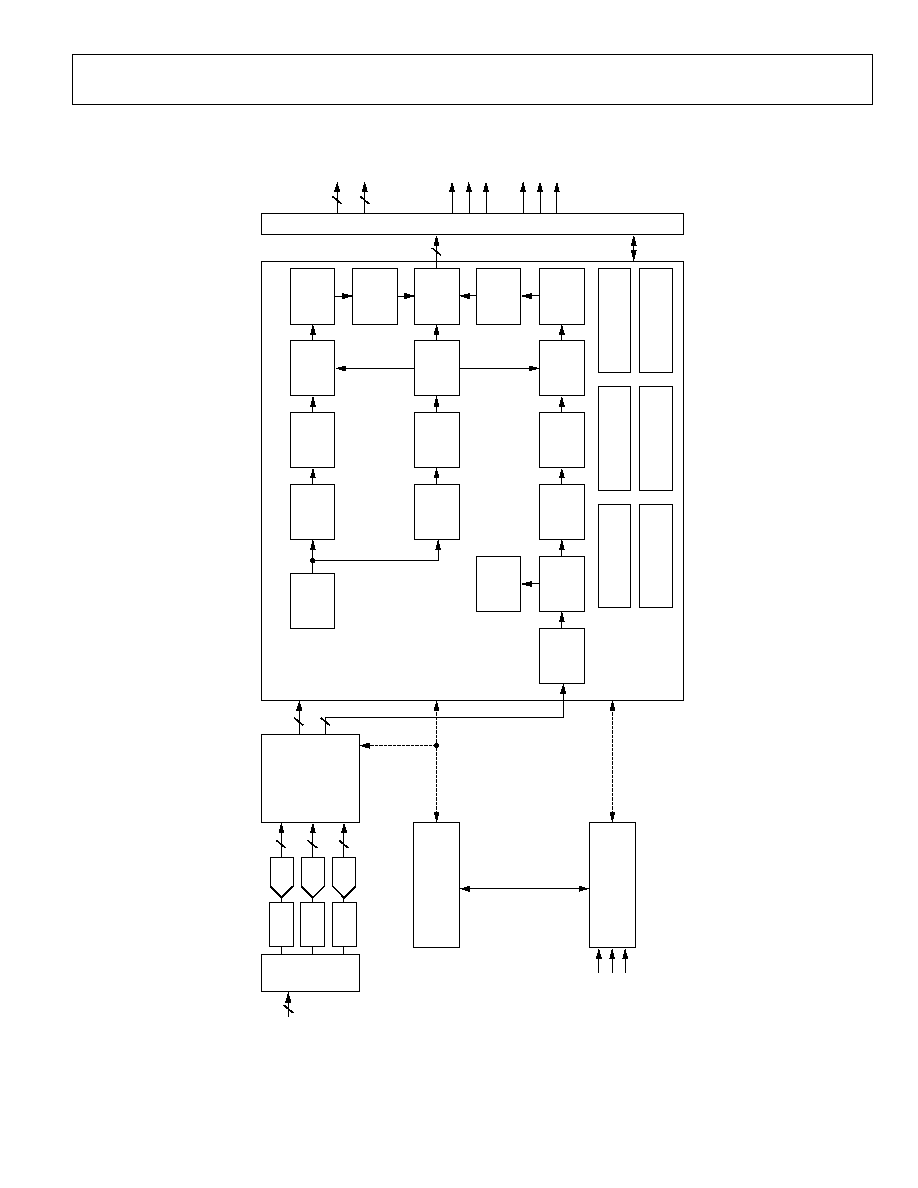
ADV7183A
Rev. A | Page 5 of 104
FUNCTIONAL BLOCK DIAGRAM
INPUT MUX
DATA
PR
EPR
OC
ESSOR
DE
CIMATION AND
DOWNS
A
MP
LING
FILTERS
STANDARD DEFINITION PROCESSOR
LUMA FILTER
LUMA DIGITAL
FINE
CLAMP
GAIN
CONTROL
LUMA
R
ESA
M
P
LE
LUMA
2D
C
O
M
B
(4
H MAX
)
CHROMA FILTER
CHROMA DE
MOD
F
SC
RE
COV
E
R
Y
CHROMA DIGITAL
FINE
CLAMP
GAIN
CONTROL
CHROMA RESA
M
P
LE
CHROMA 2D
C
O
M
B
(4
H MAX
)
L-DNR
OUTPUT FORMATTE
R
SYN
C
E
X
T
RACT
LINE
LENGTH
PR
ED
IC
TOR
R
ESA
M
P
LE
CONTROL
AV
CODE
INSERTION
CTI
C-DNR
A/D
CLAMP
10
10
10
A/D
CLAMP
10
A/D
CLAMP
10
V
B
I DATA RE
COV
E
R
Y
GLOBAL CONTROL
SYN
TH
ESIZED
LLC CONTROL
MACROV
I
S
ION
DE
TE
CTION
S
T
ANDARD
AUTODETECTION
FR
EE R
U
N
OUTP
UT CONTROL
SYN
C
PR
OC
ESSIN
G
A
N
D
CLOCK GE
NE
RATION
S
E
R
IAL INTE
RFACE
CONTROL AND V
B
I DATA
SC
LK
AIN1
AIN1
2
SD
A
ALS
B
ADV7183A
CONTROL AND DATA
S
Y
NC AND
CLK CONTROL
16
HS
8
8
PIXEL DATA
VS
FIELD
LLC1
LLC2
SFL
CV
BS
S-
VID
E
O
YPrPb
12
04821-0-001
Figure 1.

ADV7183A
Rev. A | Page 6 of 104
SPECIFICATIONS
Temperature range: T
MIN
to T
MAX
, 40°C to +85°C. The min/max specifications are guaranteed over this range.
ELECTRICAL CHARACTERISTICS
At A
VDD
= 3.15 V to 3.45 V, D
VDD
= 1.65 V to 2.0 V, D
VDDIO
= 3.0 V to 3.6 V, P
VDD
= 1.65 V to 2.0 V (operating temperature range, unless
otherwise noted).
Table 1.
Parameter Symbol
Test
Conditions
Min
Typ
Max
Unit
STATIC PERFORMANCE
Resolution (Each ADC)
N
10
Bits
Integral Nonlinearity
INL
BSL at 54 MHz
0.475/+0.6
±3
LSB
Differential Nonlinearity
DNL
BSL at 54 MHz
0.25/+0.5
0.7/+2
LSB
DIGITAL INPUTS
Input High Voltage
V
IH
2
V
Input Low Voltage
V
IL
0.8 V
Input Current
I
IN
Pins listed in Note 1
50
+50
µA
All other pins
10
+10
µA
Input Capacitance
C
IN
10 pF
DIGITAL OUTPUTS
Output High Voltage
V
OH
I
SOURCE
= 0.4 mA
2.4
V
Output Low Voltage
V
OL
I
SINK
= 3.2 mA
0.4
V
High Impedance Leakage Current
I
LEAK
Pins listed in Note 2
50
µA
All other pins
10
µA
Output Capacitance
C
OUT
20
pF
POWER REQUIREMENTS
3
Digital Core Power Supply
D
VDD
1.65
1.8
2
V
Digital I/O Power Supply
D
VDDIO
3.0
3.3
3.6
V
PLL Power Supply
P
VDD
1.65
1.8
2.0 V
Analog Power Supply
A
VDD
3.15
3.3
3.45 V
Digital Core Supply Current
I
DVDD
72
mA
Digital I/O Supply Current
I
DVDDIO
2
mA
PLL Supply Current
I
PVDD
10.5
mA
Analog Supply Current
I
AVDD
CVBS
input
4
85
mA
YPrPb
input
5
180
mA
Power-Down Current
I
PWRDN
1.5
mA
Power-Up Time
t
PWRUP
20
ms
1
Pins 36 and 79.
2
Pins 1, 2, 5, 6, 7, 8, 12, 17, 18, 19, 20, 21, 22, 23, 24, 32, 33, 34, 35, 73, 74, 75, 76, and 80.
3
Guaranteed by characterization.
4
ADC1 powered on.
5
All three ADCs powered on.

ADV7183A
Rev. A | Page 7 of 104
VIDEO SPECIFICATIONS
Guaranteed by characterization. At A
VDD
= 3.15 V to 3.45 V, D
VDD
= 1.65 V to 2.0 V, D
VDDIO
= 3.0 V to 3.6 V, P
VDD
= 1.65 V to 2.0 V
(operating temperature range, unless otherwise noted).
Table 2.
Parameter Symbol
Test
Conditions
Min
Typ
Max
Unit
NONLINEAR SPECIFICATIONS
Differential Phase
DP
CVBS I/P, modulate 5-step
0.5
0.7
°
Differential Gain
DG
CVBS I/P, modulate 5-step
0.5
0.7
%
Luma Nonlinearity
LNL
CVBS I/P, 5-step
0.5
0.7
%
NOISE SPECIFICATIONS
SNR Unweighted
Luma ramp
54
56
dB
Luma flat field
58
60
dB
Analog Front End Crosstalk
60
dB
LOCK TIME SPECIFICATIONS
Horizontal Lock Range
5
+5
%
Vertical Lock Range
40
70
Hz
Fsc Subcarrier Lock Range
±1.3
Hz
Color Lock In Time
60
Lines
Sync Depth Range
20
200
%
Color Burst Range
5
200
%
Vertical Lock Time
2
Fields
Autodetection Switch Speed
100
Lines
CHROMA SPECIFICATIONS
Hue Accuracy
HUE
1
°
Color Saturation Accuracy
CL_AC
1
%
Color AGC Range
5
400
%
Chroma Amplitude Error
0.5
%
Chroma Phase Error
0.4
°
Chroma Luma Intermodulation
0.2
%
LUMA SPECIFICATIONS
Luma Brightness Accuracy
CVBS, 1 V I/P
1
%
Luma Contrast Accuracy
CVBS, 1 V I/P
1
%

ADV7183A
Rev. A | Page 8 of 104
TIMING SPECIFICATIONS
Guaranteed by characterization. At A
VDD
= 3.15 V to 3.45 V, D
VDD
= 1.65 V to 2.0 V, D
VDDIO
= 3.0 V to 3.6 V, P
VDD
= 1.65 V to 2.0 V
(operating temperature range, unless otherwise noted).
Table 3.
Parameter Symbol
Test
Conditions
Min
Typ
Max
Unit
SYSTEM CLOCK AND CRYSTAL
Nominal Frequency
27.00
MHz
Frequency Stability
±50
ppm
I
2
C
PORT
SCLK Frequency
400
kHz
SCLK Min Pulse Width High
t
1
0.6
µs
SCLK Min Pulse Width Low
t
2
1.3
µs
Hold Time (Start Condition)
t
3
0.6
µs
Setup Time (Start Condition)
t
4
0.6
µs
SDA Setup Time
t
5
100
ns
SCLK and SDA Rise Time
t
6
300
ns
SCLK and SDA Fall Time
t
7
300
ns
Setup Time for Stop Condition
t
8
0.6
µs
RESET
FEATURE
Reset Pulse Width
5
ms
CLOCK
OUTPUTS
LLC1 Mark Space Ratio
t
9
:t
10
45:55
55:45
% Duty Cycle
LLC1 Rising to LLC2 Rising
t
11
0.5
ns
LLC1 Rising to LLC2 Falling
t
12
0.5
ns
DATA AND CONTROL OUTPUTS
Data Output Transitional Time
t
13
t
ACCESS
= t
10
t
13
6
ns
Data Output Transitional Time
t
14
t
HOLD
= t
9
+ t
14
-0.6
ns
Propagation Delay to Hi-Z
t
15
6
ns
Max Output Enable Access Time
t
16
7
ns
Min Output Enable Access Time
t
17
4
ns
ANALOG SPECIFICATIONS
Guaranteed by characterization. At A
VDD
= 3.15 V to 3.45 V, D
VDD
= 1.65 V to 2.0 V, D
VDDIO
= 3.0 V to 3.6 V, P
VDD
= 1.65 V to 2.0 V
(operating temperature range, unless otherwise noted).
Table 4.
Parameter Symbol
Test
Conditions
Min
Typ
Max
Unit
CLAMP CIRCUITRY
External Clamp Capacitor
0.1
µF
Input Impedance
Clamps switched off
10
M
Large Clamp Source Current
0.75
mA
Large Clamp Sink Current
0.75
mA
Fine Clamp Source Current
60
µA
Fine Clamp Sink Current
60
µA
THERMAL SPECIFICATIONS
Table 5.
Parameter Symbol
Test
Conditions
Min
Typ
Max
Unit
THERMAL CHARACTERISTICS
Junction-to-Case Thermal Resistance
JC
4-layer PCB with solid ground plane
7.6
°C/W
Junction-to-Ambient Thermal Resistance (Still Air)
JA
4-layer PCB with solid ground plane
38.1
°C/W
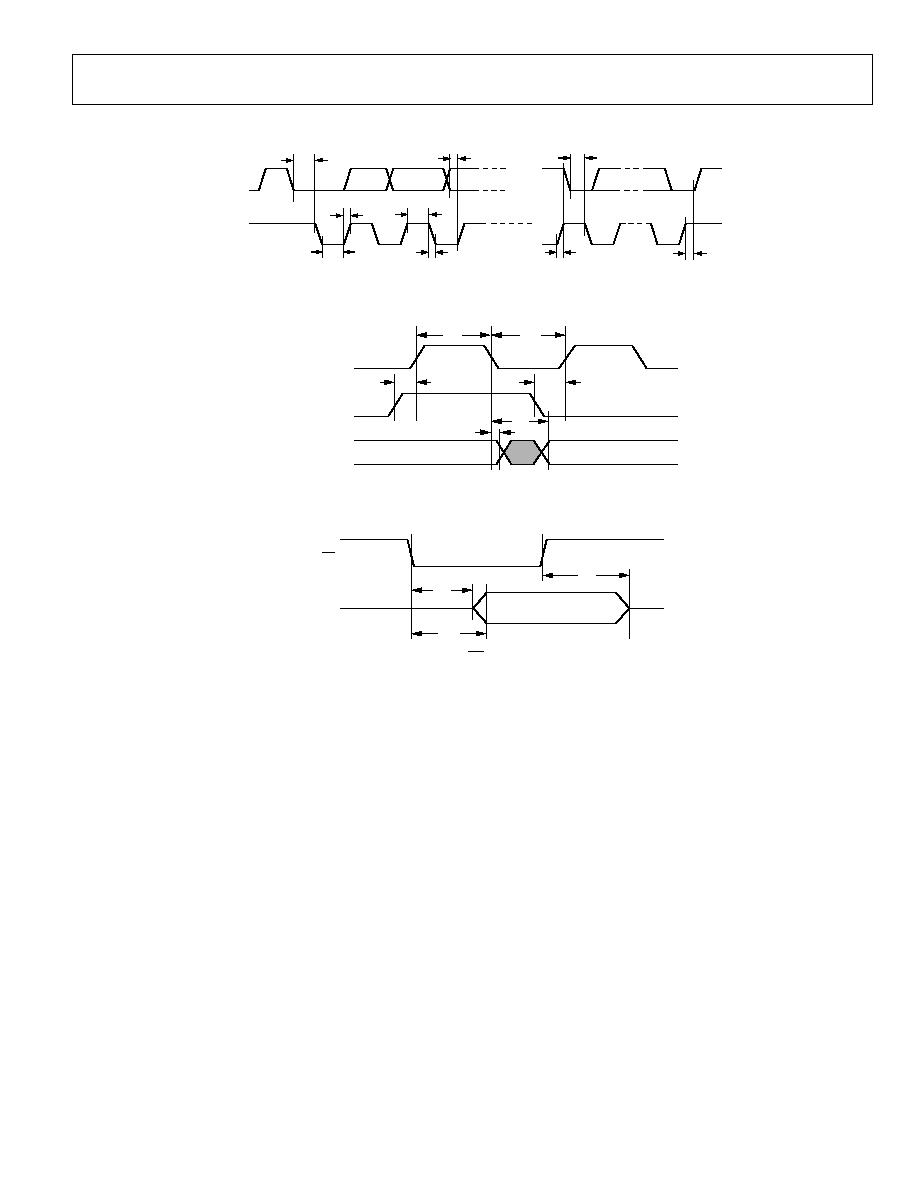
ADV7183A
Rev. A | Page 9 of 104
TIMING DIAGRAMS
04819-0-003
SDA
SCLK
t
3
t
5
t
3
t
4
t
8
t
6
t
7
t
2
t
1
Figure 2. I
2
C Timing
OUTPUT LLC1
OUTPUT LLC2
04821-0-004
OUTPUTS P0P15, VS,
HS, FIELD,
SFL/SYNC_OUT
t
9
t
10
t
11
t
12
t
13
t
14
Figure 3. Pixel Port and Control Output Timing
04821-0-005
OE
P0P15, HS,
VS, FIELD,
SFL/SYNC_OUT
t
15
t
16
t
17
Figure 4. OE Timing
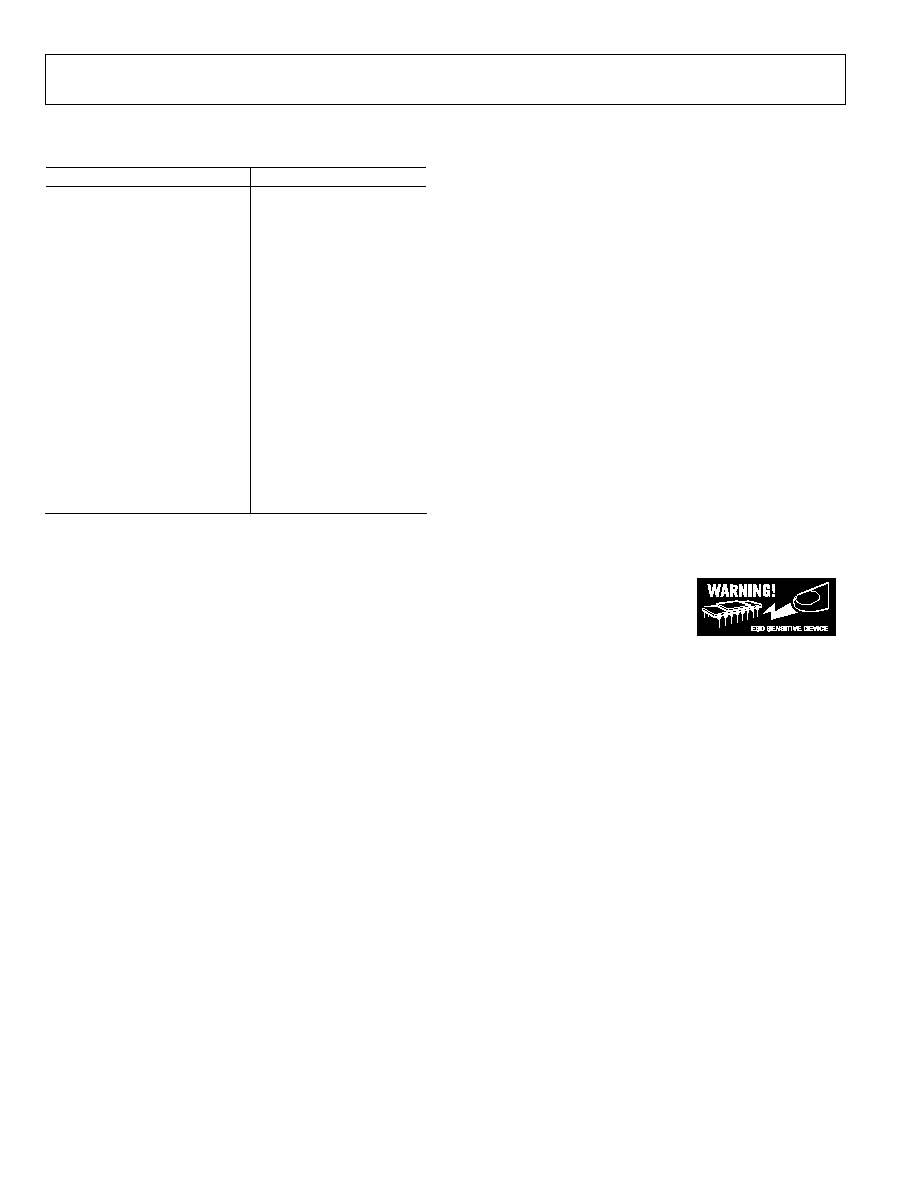
ADV7183A
Rev. A | Page 10 of 104
ABSOLUTE MAXIMUM RATINGS
Table 6.
Parameter Rating
A
VDD
to GND
4 V
A
VDD
to AGND
4 V
D
VDD
to DGND
2.2 V
P
VDD
to AGND
2.2 V
D
VDDIO
to DGND
4 V
D
VDDIO
to AVDD
0.3 V to +0.3 V
P
VDD
to D
VDD
0.3 V to +0.3 V
D
VDDIO
P
VDD
0.3V to +2 V
D
VDDIO
D
VDD
0.3V to +2 V
A
VDD
P
VDD
0.3V to +2 V
A
VDD
D
VDD
0.3V to +2 V
Digital Inputs Voltage to DGND
0.3V to D
VDDIO
+ 0.3 V
Digital Output Voltage to DGND
0.3V to D
VDDIO
+ 0.3 V
Analog Inputs to AGND
AGND 0.3 V to A
VDD
+ 0.3 V
Maximum Junction Temperature
(T
JMAX
)
150°C
Storage Temperature Range
65°C to +150°C
Infrared Reflow Soldering (20 s)
260°C
Stresses above those listed under Absolute Maximum Ratings
may cause permanent damage to the device. This is a stress
rating only; functional operation of the device at these or any
other conditions above those indicated in the operational
sections of this specification is not implied. Exposure to
absolute maximum rating conditions for extended periods may
affect device reliability.
ESD CAUTION
ESD (electrostatic discharge) sensitive device. Electrostatic charges as high as 4000 V readily accumulate on
the human body and test equipment and can discharge without detection. Although this product features
proprietary ESD protection circuitry, permanent damage may occur on devices subjected to high energy
electrostatic discharges. Therefore, proper ESD precautions are recommended to avoid performance
degradation or loss of functionality.
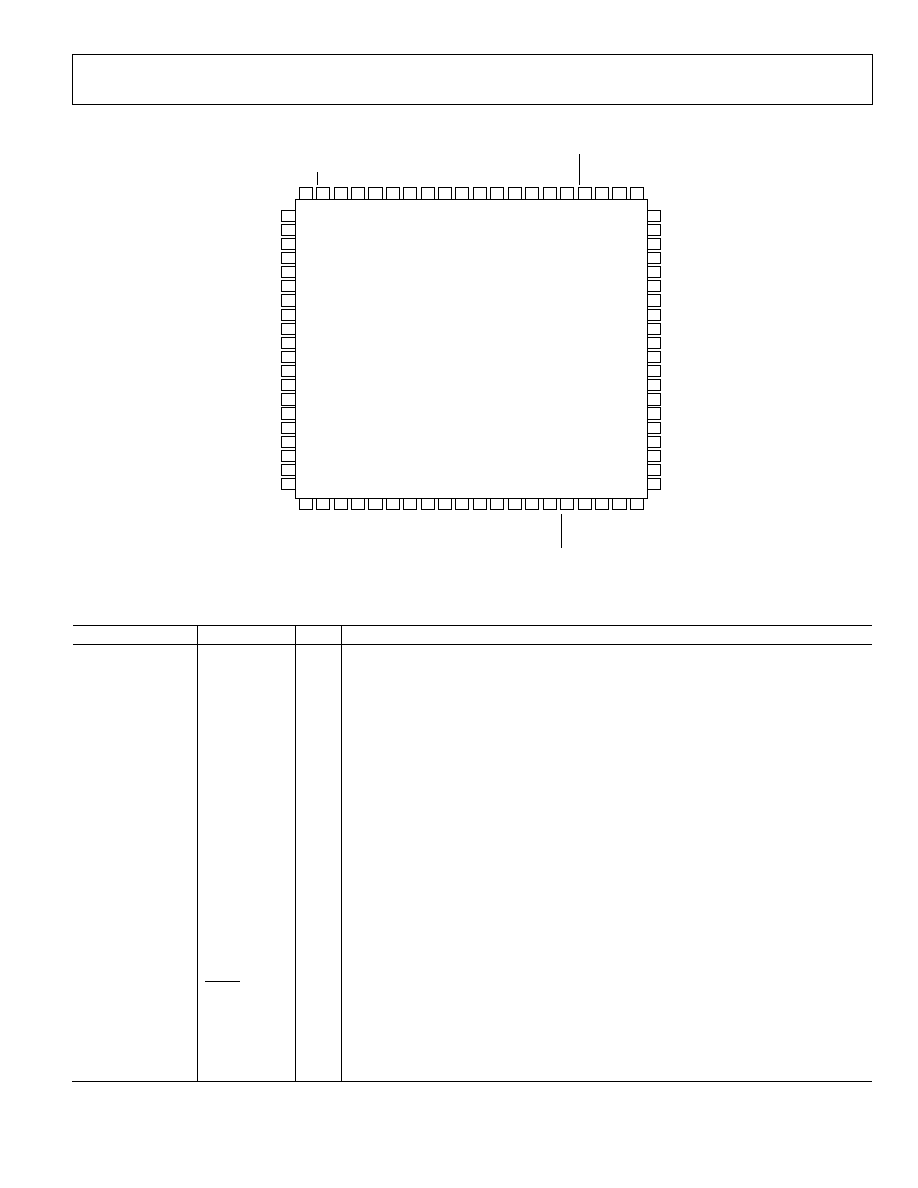
ADV7183A
Rev. A | Page 11 of 104
PIN CONFIGURATION AND FUNCTION DESCRIPTIONS
FIELD
80
OE
79
NC
78
NC
77
P16
76
P17
75
P18
74
P19
73
DV
DD
72
DGND
71
NC
70
NC
69
SC
LK
68
SD
A
67
ALS
B
66
NC
65
R
ESET
64
NC
63
AIN6
62
AIN1
2
61
VS
1
HS
2
DGND
3
DVDDIO
4
P11
5
P10
6
P9
7
P8
8
DGND
9
DVDD
10
NC
11
SFL
12
NC
13
DGND
14
DVDDIO
15
NC
16
NC
17
NC
18
P7
19
P6
20
AIN5
60
AIN11
59
AIN4
58
AIN10
57
AGND
56
CAP C2
55
CAP C1
54
AGND
53
CML
52
REFOUT
51
AVDD
50
CAP Y2
49
CAP Y1
48
AGND
47
AIN3
46
AIN9
45
AIN2
44
AIN8
43
AIN1
42
AIN7
41
P5
21
P4
22
P3
23
P2
24
NC
25
LLC2
26
LLC1
27
XTA
L
1
28
XTA
L
29
DV
DD
30
DGND
31
P1
32
P0
33
NC
34
NC
35
P
W
RDN
36
ELPF
37
PVD
D
38
AGND
39
AGND
40
ADV7183A
TOP VIEW
(Not to Scale)
NC = NO CONNECT
04821-0-002
Figure 5. 80-Lead LQFP Pin Configuration
Table 7. Pin Function Descriptions
Pin No.
Mnemonic
Type
Function
3, 9, 14, 31, 71
DGND
G
Digital Ground.
39, 40, 47, 53, 56
AGND
G
Analog Ground.
4, 15
DVDDIO
P
Digital I/O Supply Voltage (3.3 V).
10, 30, 72
DVDD
P
Digital Core Supply Voltage (1.8 V).
50
AVDD
P
Analog Supply Voltage (3.3 V).
38
PVDD
P
PLL Supply Voltage (1.8 V).
4146, 5762
AIN1AIN12
I
Analog Video Input Channels.
11, 13, 1618, 25,
34, 35, 63, 65, 69,
70, 77, 78
NC
No Connect Pins.
58, 1924,
32, 33, 7376
P0P15
O
Video Pixel Output Port.
2
HS
O
HS is a horizontal synchronization output signal.
1
VS
O
VS is a vertical synchronization output signal.
80
FIELD
O
FIELD is a field synchronization output signal.
67
SDA
I/O
I
2
C Port Serial Data Input/Output Pin.
68
SCLK
I
I
2
C Port Serial Clock Input (Max Clock Rate of 400 kHz).
66
ALSB
I
This pin selects the I
2
C address for the ADV7183A. ALSB set to Logic 0 sets the address for a
write as 0x40; for ALSB set to logic high, the address selected is 0x42.
64
RESET
I
System Reset Input, Active Low. A minimum low reset pulse width of 5 ms is required to
reset the ADV7183A circuitry.
27
LLC1
O
This is a line-locked output clock for the pixel data output by the ADV7183A. Nominally
27 MHz, but varies up or down according to video line length.
26
LLC2
O
This is a divide-by-2 version of the LLC1 output clock for the pixel data output by the
ADV7183A. Nominally 13.5 MHz, but varies up or down according to video line length.

ADV7183A
Rev. A | Page 12 of 104
Pin No.
Mnemonic
Type
Function
29
XTAL
I
This is the input pin for the 27 MHz crystal, or can be overdriven by an external 3.3 V,
27 MHz clock oscillator source. In crystal mode, the crystal must be a fundamental crystal.
28
XTAL1
O
This pin should be connected to the 27 MHz crystal or left as a no connect if an external
3.3 V, 27 MHz clock oscillator source is used to clock the ADV7183A. In crystal mode, the
crystal must be a fundamental crystal.
36
PWRDN
I
A logic low on this pin places the ADV7183A in a power-down mode. Refer to the I2C
Control Register Map for more options on power-down modes for the ADV7183A.
79
OE
I
When set to a logic low, OE enables the pixel output bus, P15P0 of the ADV7183A. A logic
high on the OE pin places Pins P15P0, HS, VS, SFL/SYNC_OUT into a high impedance state.
37
ELPF
I
The recommended external loop filter must be connected to this ELPF pin, as shown in
Figure 42.
12
SFL
O
Subcarrier Frequency Lock. This pin contains a serial output stream that can be used to lock
the subcarrier frequency when this decoder is connected to any Analog Devices, Inc. digital
video encoder.
51
REFOUT
O
Internal Voltage Reference Output. Refer to Figure 42 for a recommended capacitor
network for this pin.
52
CML
O
The CML pin is a common-mode level for the internal ADCs. Refer to Figure 42 for a
recommended capacitor network for this pin.
48, 49
CAPY1, CAPY2
I
ADC's Capacitor Network. Refer to Figure 42 for a recommended capacitor network for
this pin.
54, 55
CAPC1, CAPC2
I
ADC's Capacitor Network. Refer to Figure 42 for a recommended capacitor network for
this pin.

ADV7183A
Rev. A | Page 13 of 104
ANALOG FRONT END
ANALOG INPUT MUXING
04819-0-006
AIN1
AIN1
2
AIN7
AIN6
AIN2
AIN1
1
AIN8
AIN5
AIN3
AIN1
0
AIN9
AIN4
AIN4
AIN9
AIN10
AIN3
AIN5
AIN8
AIN11
AIN2
AIN6
AIN7
AIN12
AIN1
AIN3
AIN9
AIN4
AIN10
AIN5
AIN11
AIN6
AIN12
AIN2
AIN8
AIN5
AIN11
AIN6
AIN12
1
0
1
0
1
0
ADC_SW_MAN_EN
INSEL[3:0]
ADC0_SW[3:0]
ADC1_SW[3:0]
ADC1_SW[3:0]
INTERNAL
MAPPING
FUNCTIONS
ADC2
ADC1
ADC0
Figure 6. Internal Pin Connections
The ADV7183A has an integrated analog muxing section that
allows more than one source of video signal to be connected to
the decoder. Figure 6 outlines the overall structure of the input
muxing provided in the ADV7183A.
As can be seen in Figure 6, there are two different ways in which
the analog input muxes can be controlled:
1.
Control via functional registers (INSEL).
Using INSEL[3:0] simplifies the setup of the muxes, and
minimizes crosstalk between channels by pre-assigning the
input channels. This is referred to as ADI recommended
input muxing.
2.
Control via an I
2
C manual override
(ADC_sw_man_en, ADC0_sw, ADC1_sw, ADC2_sw).
This is provided for applications with special requirements
(e.g., number/combinations of signals) that would not be
served by the pre-assigned input connections. This is
referred to as manual input muxing.
Please refer to Figure 7 for an overview of the two methods of
controlling the ADV7183A's input muxing.
ADI Recommended Input Muxing
A maximum of 12 CVBS inputs can be connected and decoded
by the ADV7183A. As can be seen from Figure 5, this means the
sources will have to be connected to adjacent pins on the IC.
This calls for a careful design of the PCB layout (e.g., ground
shielding between all signals routed through tracks that are
physically close together).
INSEL[3:0] Input Selection, Address 0x00, [3:0]
The INSEL bits allow the user to select an input channel as well
as the input format. Depending on the PCB connections, only a
subset of the INSEL modes are valid. Please note that the
INSEL[3:0] does not only switch the analog input muxing, it
also configures the standard definition processor core to
process CVBS (Comp), S-video (Y/C), or component (YPbPr)
format.

ADV7183A
Rev. A | Page 14 of 104
04821-0-007
SET INSEL[3:0] TO
CONFIGURE ADV7183A TO
DECODE VIDEO FORMAT:
CVBS: 0000
YC: 0110
YPrPb: 1001
USE MANUAL INPUT MUXING
(ADC_SW_MAN_EN, ADC0_SW,
ADC1_SW, ADC2_SW)
SET INSEL[3:0] FOR REQUIRED
MUXING CONFIGURATION
CONNECTING
ANALOG SIGNALS
TO ADV7183A
ADI RECOMMENDED
INPUT MUXING; SEE TABLE 9
YES
NO
Figure 7. Input Muxing Overview
Table 8. Input Channel Switching Using INSEL[3:0]
Description
INSEL[3:0]
Analog Input Pins
Video Format (SDP)
0000*
CVBS1 = AIN1
Composite
0001
CVBS2 = AIN2
Composite
0010
CVBS3 = AIN3
Composite
0011
CVBS4 = AIN4
Composite
0100
CVBS5 = AIN5
Composite
0101
CVBS6 = AIN6
Composite
0110
Y1 = AIN1
YC
C1 = AIN4
YC
0111
Y2 = AIN2
YC
C2 = AIN5
YC
1000
Y3 = AIN3
YC
C3 = AIN6
YC
1001
Y1 = AIN1
YPrPb
PR1 = AIN4
YPrPb
PB1 = AIN5
YPrPb
1010
Y2 = AIN2
YPrPb
PR2 = AIN3
YPrPb
PB2 = AIN6
YPrPb
1011
CVBS7 = AIN7
Composite
1100
CVBS8 = AIN8
Composite
1101
CVBS9 = AIN9
Composite
1110
CVBS10 = AIN10
Composite
1111
CVBS11 = AIN11
Composite
*Default value.
Table 9. Input Channel Assignments
Input
Channel
Pin
No.
ADI Recommended Input Muxing Control
INSEL[3:0]
AIN7 41
CVBS7
AIN1 42
CVBS1
YC1-Y
YPrPb1-Y
AIN8 43
CVBS8
AIN2 44
CVBS2
YC2-Y
YPrPb2-Y
AIN9 45
CVBS9
AIN3 46
CVBS3
YC3-Y
YPrPb2-Pb
AIN10 57
CVBS10
AIN4 58
CVBS4
YC1-C
YPrPb1-Pb
AIN11 59
CVBS11
AIN5 60
CVBS5
YC2-C
YPrPb1-Pr
AIN12 61
Not
Available
AIN6 62
CVBS6
YC3-C
YPrPb2-Pr
ADI recommended input muxing is designed to minimize
crosstalk between signal channels and to obtain the highest
level of signal integrity. Table 9 summarizes how PCB layout
should connect analog video signals to the ADV7183A.
Notes
·
It is strongly recommended to connect any unused analog
input pins to AGND to act as a shield.
·
Inputs AIN7 to AIN11 should be connected to AGND in
cases where only six input channels are used. This will
improve the quality of the sampling due to better isolation
between the channels.
·
AIN12 is not under the control of INSEL[3:0]. It can only
be routed to ADC0/ADC1/ADC2 by manual muxing. See
Table 10 for further details.

ADV7183A
Rev. A | Page 15 of 104
Manual Input Muxing
By accessing a set of manual override muxing registers, the
analog input muxes of the ADV7183A can be controlled
directly. This is referred to as manual input muxing.
Notes
·
Manual input muxing overrides other input muxing
control bits (e.g., INSEL)
·
The manual muxing is activated by setting the
ADC_SW_MAN_EN bit. It only affects the analog
switches in front of the ADCs.
This means if the settings of INSEL and the manual input
muxing registers (ADC0/1/2_sw) contradict each other,
the ADC0/ADC1/ADC2_sw settings apply and INSEL is
ignored.
·
Manual input muxing only controls the analog input
muxes. INSEL[3:0] still has to be set so the follow-on
blocks process the video data in the correct format.
This means INSEL must still be used to tell the ADV7183A
whether the input signal is of component, YC, or CVBS
format.
There are restrictions in the channel routing imposed by the
analog signal routing inside the IC; every input pin cannot be
routed to each ADC. Please refer to Figure 6 for an overview on
the routing capabilities inside the chip. The three mux sections
can be controlled by the reserved control signal buses
ADC0/ADC1/ADC2_sw[3:0]. Table 10 explains the control
words used.
SETADC_sw_man_en, Manual Input Muxing Enable,
Address 0xC4, [7]
ADC0_sw[3:0],
ADC0 mux configuration, Address 0xC3, [3:0]
ADC1_sw[3:0],
ADC1 mux configuration, Address 0xC3, [7:4]
ADC2_sw[3:0],
ADC2 mux configuration, Address 0xC4, [3:0]
Table 10. Manual Mux Settings for All ADCs
SETADC_sw_man_en = 1
ADC0_sw[3:0]
ADC0 Connected to:
ADC1_sw[3:0]
ADC1 Connected to:
ADC2_sw[3:0]
ADC2 Connected to:
0000
No Connection
0000
No Connection
0000
No Connection
0001
AIN1
0001
No Connection
0001
No Connection
0010 AIN2
0010 No
Connection
0010 AIN2
0011 AIN3
0011 AIN3
0011 No
Connection
0100 AIN4
0100 AIN4
0100 No
Connection
0101 AIN5
0101 AIN5
0101 AIN5
0110 AIN6
0110 AIN6
0110 AIN6
0111
No Connection
0111
No Connection
0111
No Connection
1000
No Connection
1000
No Connection
1000
No Connection
1001
AIN7
1001
No Connection
1001
No Connection
1010 AIN8
1010 No
Connection
1010 AIN8
1011 AIN9
1011 AIN9
1011 No
Connection
1100 AIN10
1100 AIN10
1100 No
Connection
1101 AIN11
1101 AIN11
1101 AIN11
1110 AIN12
1110 AIN12
1110 AIN12
1111
No Connection
1111
No Connection
1111
No Connection

ADV7183A
Rev. A | Page 16 of 104
GLOBAL CONTROL REGISTERS
Register control bits listed in this section affect the whole chip.
POWER-SAVE MODES
Power-Down
PDBP, Address 0x0F, [2]
There are two ways to shut down the digital core of the
ADV7183A: a pin (PWRDN) and a bit (PWRDN see below).
The PDBP controls which of the two has the higher priority.
The default is to give the pin (PWRDN) priority. This allows the
user to have the ADV7183A powered down by default.
Table 11. PDBP Function
PDBP Description
0*
Digital core power controlled by the PWRDN pin (bit is
disregarded).
1
Bit has priority (pin is disregarded).
*Default value.
PWRDN, Address 0x0F, [5]
Setting the PWRDN bit switches the ADV7183A into a chip-
wide power-down mode. The power-down stops the clock from
entering the digital section of the chip, thereby freezing its
operation. No I
2
C bits are lost during power-down. The
PWRDN bit also affects the analog blocks and switches them
into low current modes. The I
2
C interface itself is unaffected,
and remains operational in power-down mode.
The ADV7183A leaves the power-down state if the PWRDN bit
is set to 0 (via I
2
C), or if the overall part is reset using Pin
RESET.
Note that PDBP must be set to 1 for the PWRDN bit to power
down the ADV7183A.
Table 12. PWRDN Function
PWRDN Description
0* Chip
operational.
1
ADV7183A in chip-wide power-down.
*Default value.
ADC Power-Down Control
The ADV7183A contains three 10-bit ADCs (ADC 0, ADC 1,
and ADC 2). If required, it is possible to power down each ADC
individually.
When should the ADCs be powered down?
·
CVBS mode. ADC 1 and ADC 2 should be powered down
to save on power consumption.
·
S-Video mode. ADC 2 should be powered down to save on
power consumption.
PWRDN_ADC_0, Address 0x3A, [3]
Table 13. PWRDN_ADC_0 Function
PWRDN_ADC_0 Description
0*
ADC normal operation.
1
Power down ADC 0.
*Default value.
PWRDN_ADC_1, Address 0x3A, [2]
Table 14. PWRDN_ADC_1 Function
PWRDN_ADC_1 Description
0*
ADC normal operation.
1
Power down ADC 1.
*Default value.
PWRDN_ADC_2, Address 0x3A, [1]
Table 15. PWRDN_ADC_2 Function
PWRDN_ADC_2 Description
0*
ADC normal operation.
1
Power down ADC 2.
*Default value.
RESET CONTROL
Chip Reset (RES), Address 0x0F, [7]
Setting this bit, equivalent to controlling the RESET pin on the
ADV7183A, issues a full chip reset. All I
2
C registers get reset to
their default values
6
. After the reset sequence, the part immedi-
ately starts to acquire the incoming video signal.
Notes
·
After setting the RES bit (or initiating a reset via the pin),
the part returns to the default mode of operation with
respect to its primary mode of operation. All I
2
C bits are
loaded with their default values, making this bit self-
clearing.
·
Executing a software reset takes approximately 2 ms.
However, it is recommended to wait 5 ms before any
further I
2
C writes are performed.
·
The I
2
C master controller receives a no acknowledge
condition on the ninth clock cycle when Chip Reset is
implemented. See the MPU Port Description section.
Table 16. RES Function
RES Description
0* Normal
operation.
1
Start reset sequence.
*Default value.
6
Some register bits do not have a reset value specified. They keep their last
written value. Those bits are marked as having a reset value of x in the
register table.
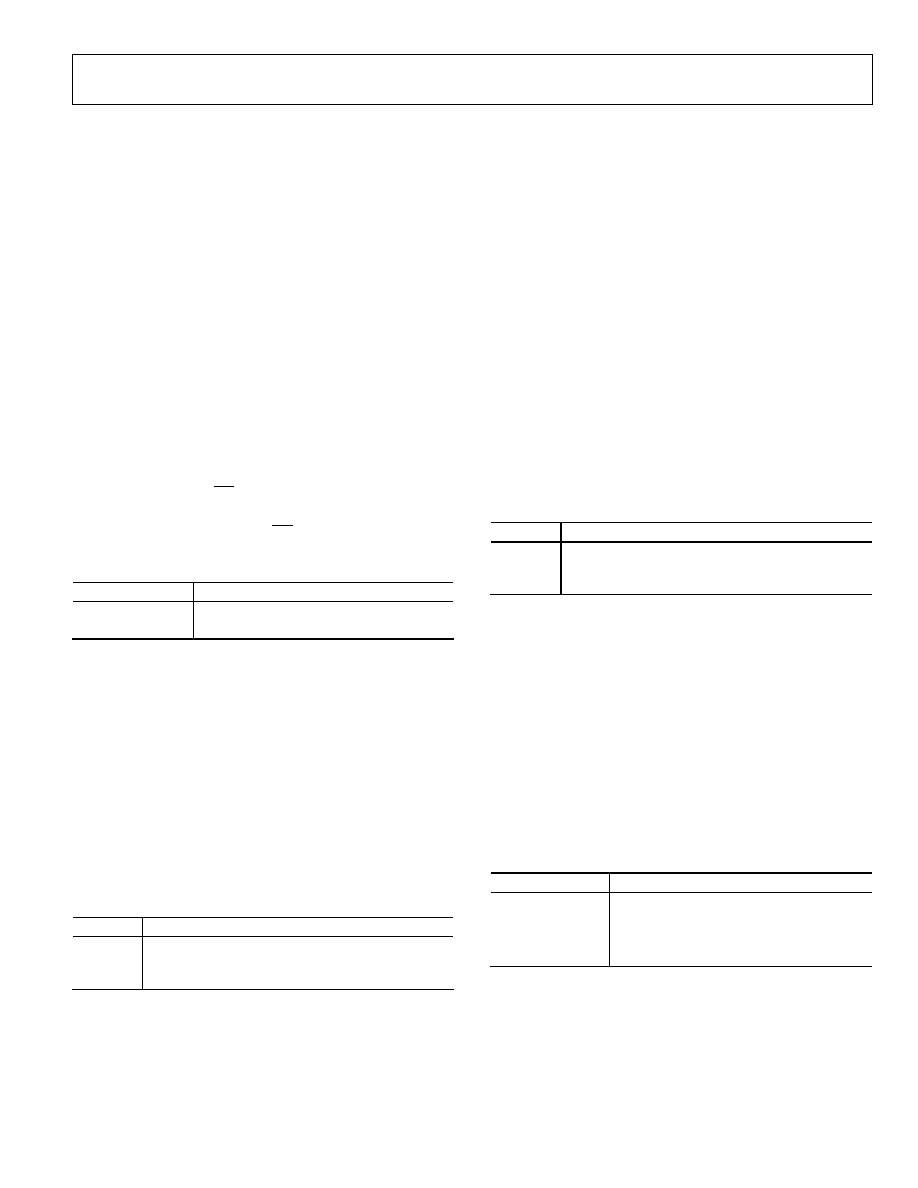
ADV7183A
Rev. A | Page 17 of 104
GLOBAL PIN CONTROL
Three-State Output Drivers
TOD, Address 0x03, [6]
This bit allows the user to three-state the output drivers of the
ADV7183A.
Upon setting the TOD bit, the P15P0, HS, VS, FIELD, and SFL
pins are three-stated.
Note that the timing pins (HS/VS/FIELD) can be forced active
via the TIM_OE bit. For more information on three-state
control, refer to the following sections:
·
Three-State LLC Driver
·
Timing Signals Output Enable
Individual drive strength controls are provided via the
DR_STR_XX bits.
Note that the ADV7183A supports three-stating via a dedicated
pin. When set high, the OE pin three-states the output drivers
for P15P0, HS, VS, FIELD, and SFL. The output drivers are
three-stated if the TOD bit or the OE pin is set high.
Table 17. TOD Function
TOD Description
0*
Output drivers enabled.
1
Output drivers three-stated.
*Default value.
Three-State LLC Driver
TRI_LLC, Address 0x0E, [6]
This bit allows the output drivers for the LLC1 and LLC2 pins
of the ADV7183A to be three-stated. For more information on
three-state control, refer to the following sections:
·
Three-State Output Drivers
·
Timing Signals Output Enable
Individual drive strength controls are provided via the
DR_STR_XX bits.
Table 18. TRI_LLC Function
TRI_LLC Description
0*
LLC pin drivers working according to the
DR_STR_C[1:0] setting (pin enabled).
1
LLC pin drivers three-stated.
*Default value.
Timing Signals Output Enable
TIM_OE, Address 0x04, [3]
The TIM_OE bit should be regarded as an addition to the TOD
bit. Setting it high forces the output drivers for HS, VS, and
FIELD into the active (i.e., driving) state even if the TOD bit is
set. If set to low, the HS, VS, and FIELD pins are three-stated
dependent on the TOD bit. This functionality is useful if the
decoder is to be used as a timing generator only. This may be
the case if only the timing signals are to be extracted from an
incoming signal, or if the part is in free-run mode where a
separate chip can output, for instance, a company logo.
For more information on three-state control, refer to the
following sections:
·
Three-State Output Drivers
·
Three-State LLC Driver
Individual drive strength controls are provided via the
DR_STR_XX bits.
Table 19. TIM_OE Function
TIM_OE Description
0*
HS, VS, FIELD three-stated according to the TOD bit.
1
HS, VS, FIELD are forced active all the time. The
DR_STR_S[1:0] setting determines drive strength.
*Default value.
Drive Strength Selection (Data)
DR_STR[1:0] Address 0x04, [5:4]
For EMC and crosstalk reasons, it may be desirable to
strengthen or weaken the drive strength of the output drivers.
The DR_STR[1:0] bits affect the P[15:0] output drivers.
For more information on three-state control, refer to the
following sections:
·
Drive Strength Selection (Clock)
·
Drive Strength Selection (Sync)
Table 20. DR_STR Function
DR_STR[1:0] Description
00
Low drive strength (1×).
01*
Medium low drive strength (2×).
10
Medium high drive strength (3×).
11
High drive strength (4×).
*Default value.
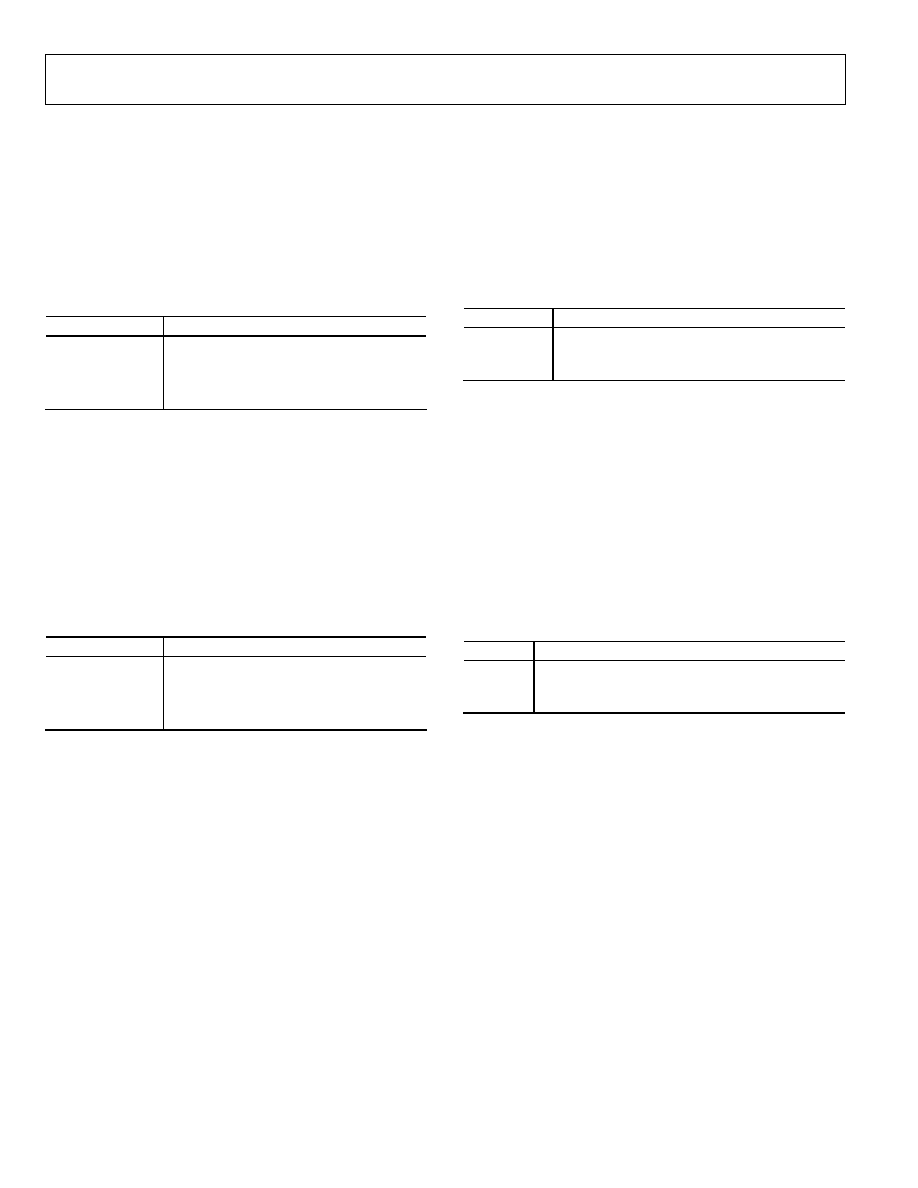
ADV7183A
Rev. A | Page 18 of 104
Drive Strength Selection (Clock)
DR_STR_C[1:0] Address 0x0E, [3:2]
The DR_STR_C[1:0] bits can be used to select the strength of
the clock signal output driver (LLC pin). For more information,
refer to the following sections:
·
Drive Strength Selection (Sync)
·
Drive Strength Selection (Data)
Table 21. DR_STR Function
DR_STR[1:0] Description
00
Low drive strength (1×).
01*
Medium low drive strength (2×).
10
Medium high drive strength (3×).
11
High drive strength (4×).
*Default value.
Drive Strength Selection (Sync)
DR_STR_S[1:0] Address 0x0E, [1:0]
The DR_STR_S[1:0] bits allow the user to select the strength of
the synchronization signals with which HS, VS, and F are
driven. For more information, refer to the following sections:
·
Drive Strength Selection (Clock)
·
Drive Strength Selection (Data)
Table 22. DR_STR Function
DR_STR[1:0] Description
00
Low drive strength (1×).
01*
Medium low drive strength (2×).
10
Medium high drive strength (3×).
11
High drive strength (4×).
*Default value.
Enable Subcarrier Frequency Lock Pin
EN_SFL_PIN Address 0x04, [1]
The subcarrier frequency lock pin (SDP, output only) has a
double function: it can also output raw sync-related information
(SogOut). The EN_SFL_PIN bit enables the output of
subcarrier lock information (also known as GenLock) from the
SDP core to an encoder in a decoder-encoder back-to-back
arrangement.
Table 23. EN_SFL_PIN
EN_SFL_PIN Description
0*
Subcarrier frequency lock output is disabled.
1
Subcarrier frequency lock information is
presented on the SFL pin.
*Default value.
Polarity LLC Pin
PCLK Address 0x37, [0]
The polarity of the clock that leaves the ADV7183A via the
LLC1 and LLC2 pins can be inverted using the PCLK bit. Note
that this inversion affects the clock for SDP.
Changing the polarity of the LLC clock output may be
necessary to meet the setup-and-hold time expectations of
follow-on chips.
Note that this bit also inverts the polarity of the LLC2 clock.
Table 24. PCLK Function
PCLK Description
0
Invert LLC output polarity.
1*
LLC output polarity normal (as per the Timing
Diagrams)
*Default value.
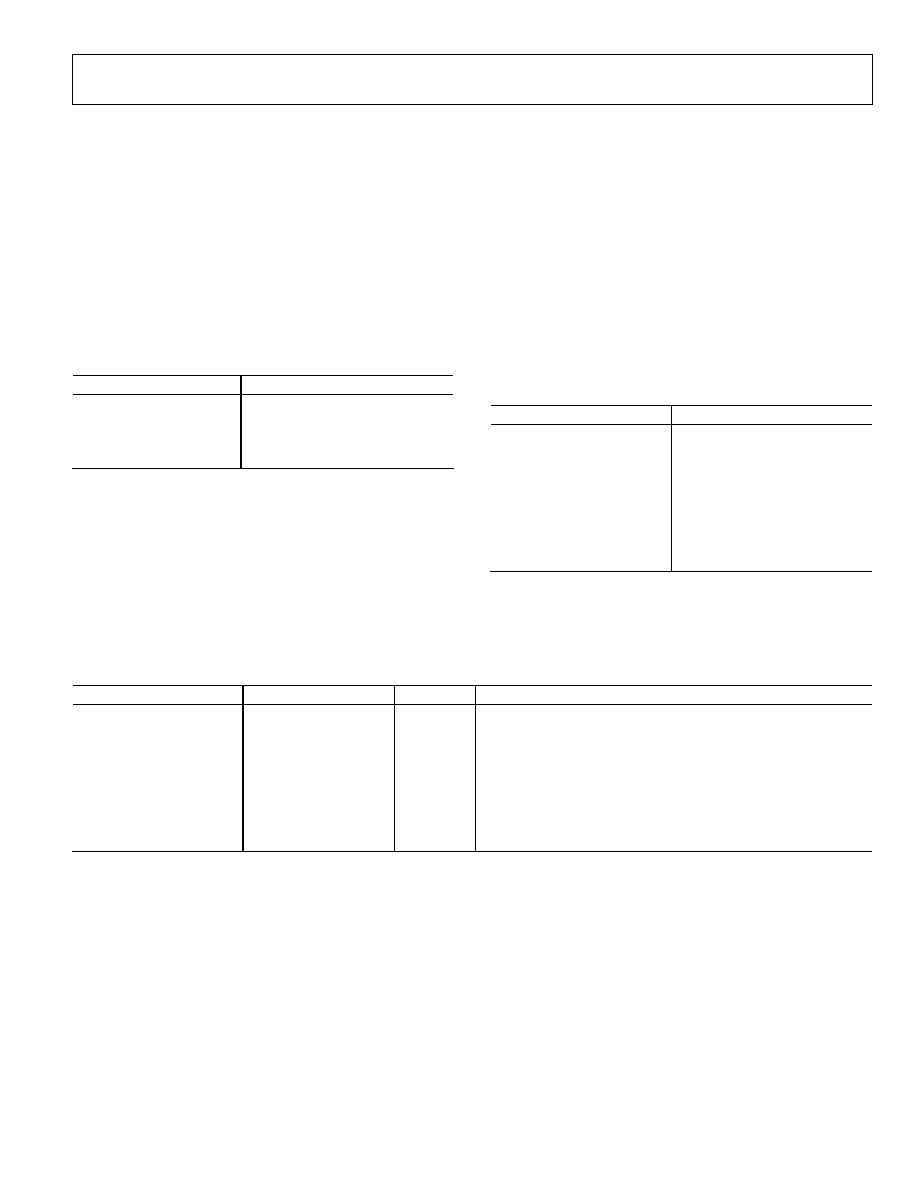
ADV7183A
Rev. A | Page 19 of 104
GLOBAL STATUS REGISTERS
There are four registers that provide summary information
about the video decoder. The IDENT register allows the user to
identify the revision code of the ADV7183A. The other three
registers contain status bits from the SDP.
IDENTIFICATION
IDENT[7:0] Address 0x11, [7:0]
Provides identification of the revision of the ADV7183A. Please
review the list of IDENT code readback values for the various
versions shown in Table 25.
Table 25. IDENT Function
IDENT[7:0] Description
0x0D ADV7183A-ES1
0x0E ADV7183A-ES2
0x0F or 0x10
ADV7183A-FT
0x11 ADV7183A
(Version
2)
STATUS 1
STATUS_1[7:0] Address 0x10, [7:0]
This read-only register provides information about the internal
status of the ADV7183A.
Please see CIL[2:0] Count Into Lock (SDP), Address 0x51, [2:0]
and COL[2:0] Count Out of Lock (SDP), Address 0x51, [5:3] for
information on the timing.
Depending on the setting of the FSCLE bit, the Status[0] and
Status[1] are based solely on horizontal timing info or on the
horizontal timing and lock status of the color subcarrier. See the
FSCLE Fsc Lock Enable (SDP), Address 0x51, [7] section.
SDP Autodetection Result
AD_RESULT[2:0] Address 0x10, [6:4]
The AD_RESULT[2:0] bits report back on the findings from the
SDP autodetection block. Consult the SDP General Setup sec-
tion for more information on enabling the autodetection block,
and the Autodetection of SDP Modes section to find out how to
configure it.
Table 26. AD_RESULT Function
AD_RESULT[2:0] Description
000 NTSM-MJ
001 NTSC-443
010 PAL-M
011 PAL-60
100 PAL-BGHID
101 SECAM
110 PAL-Combination
N
111 SECAM
525
Table 27. STATUS 1 Function
STATUS 1 [7:0]
Bit Name
Block
Description
0
IN_LOCK
SDP
In lock (right now).
1
LOST_LOCK
SDP
Lost lock (since last read of this register).
2
FSC_LOCK
SDP
Fsc locked (right now).
3 FOLLOW_PW
SDP
AGC
follows peak white algorithm.
4
AD_RESULT.0
SDP
Result of SDP autodetection.
5
AD_RESULT.1
SDP
Result of SDP autodetection.
6
AD_RESULT.2
SDP
Result of SDP autodetection.
7
COL_KILL
SDP
Color kill active.
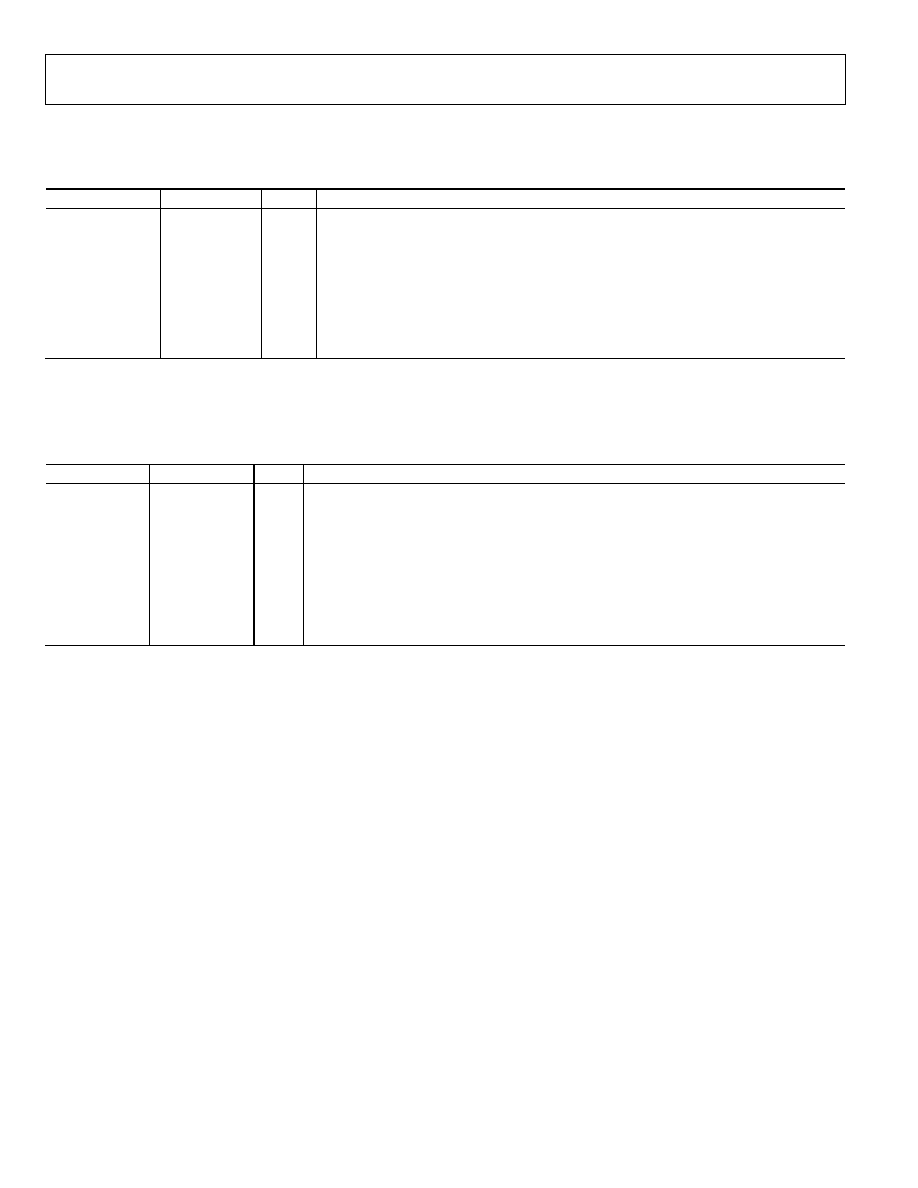
ADV7183A
Rev. A | Page 20 of 104
STATUS 2
STATUS_2[7:0], Address 0x12, [7:0]
Table 28. STATUS 2 Function
STATUS 2 [7:0]
Bit Name
Block
Description
0
MVCS DET
SDP
Detected Macrovision color striping.
1
MVCS T3
SDP
Macrovision color striping protection. Conforms to Type 3 (if high), and Type 2 (if low).
2
MV_PS DET
SDP
Detected Macrovision pseudo Sync pulses.
3
MV_AGC DET
SDP
Detected Macrovision AGC pulses.
4
LL_NSTD
SDP
Line length is nonstandard.
5
FSC_NSTD
SDP
Fsc frequency is nonstandard.
6 Reserved
7 Reserved
STATUS 3
STATUS_3[7:0], Address 0x13, [7:0]
Table 29. STATUS 3 Function
STATUS 3 [7:0]
Bit Name
Block
Description
0 INST_HLOCK
SDP
Horizontal
lock indicator (instantaneous).
1
Reserved for future use.
2
Reserved for future use.
3
Reserved for future use.
4 FREE_RUN_ACT
SDP
SDP outputs a blue screen (see theDEF_VAL_AUTO_EN Default Value Automatic Enable (SDP),
Address 0x0C, [1] section).
5
STD_FLD_LEN
SDP
Field length is correct for currently selected video standard.
6 INTERLACED
SDP
Interlaced
video
detected (field sequence found).
7
PAL_SW_LOCK
SDP
Reliable sequence of swinging bursts detected.

ADV7183A
Rev. A | Page 21 of 104
STANDARD DEFINITION PROCESSOR (SDP)
04819-0-008
DIGITIZED CVBS
DIGITIZED Y (YC)
VIDEO DATA
OUTPUT
STANDARD DEFINITION PROCESSOR
DIGITIZED CVBS
DIGITIZED C (YC)
MACROVISION
DETECTION
VBI DATA
RECOVERY
STANDARD
AUTODETECTION
LUMA
FILTER
LUMA
DIGITAL
FINE
CLAMP
GAIN
CONTROL
LUMA
RESAMPLE
LUMA
2D COMB
SLLC
CONTROL
CHROMA
FILTER
CHROMA
DEMOD
F
SC
RECOVERY
CHROMA
DIGITAL
FINE
CLAMP
GAIN
CONTROL
CHROMA
RESAMPLE
CHROMA
2D COMB
SYNC
EXTRACT
LINE
LENGTH
PREDICTOR
RESAMPLE
CONTROL
AV
CODE
INSERTION
MEASUREMENT
BLOCK (= >1
2
C)
VIDEO DATA
PROCESSING
BLOCK
Figure 8. Block Diagram of the Standard Definition Processor
A block diagram of the ADV7183A's standard definition
processor (SDP) is shown in Figure 8.
The SDP block can handle standard definition video in CVBS,
YC, and YPrPb formats. It can be divided into a luminance and
chrominance path. If the input video is of a composite type
(CVBS), both processing paths are fed with the CVBS input.
SD LUMA PATH
The input signal is processed by the following blocks:
·
Digital Fine Clamp. This block uses a high precision
algorithm to clamp the video signal.
·
Luma Filter Block. This block contains a luma decimation
filter (YAA) with a fixed response, and some shaping filters
(YSH) that have selectable responses.
·
Luma Gain Control. The automatic gain control (AGC) can
operate on a variety of different modes, including gain
based on the depth of the horizontal sync pulse, peak white
mode, and fixed manual gain.
·
Luma Resample. To correct for line-length errors as well as
dynamic line-length changes, the data is digitally
resampled.
·
Luma 2D Comb. The two-dimensional comb filter provides
YC separation.
·
AV Code Insertion. At this point, the decoded luma (Y)
signal is merged with the retrieved chroma values. AV
codes (as per ITU-R. BT-656) can be inserted.
SD CHROMA PATH
The input signal is processed by the following blocks:
·
Digital Fine Clamp. This block uses a high precision
algorithm to clamp the video signal.
·
Chroma Demodulation. This block employs a color
subcarrier (Fsc) recovery unit to regenerate the color
subcarrier for any modulated chroma scheme. The
demodulation block then performs an AM demodulation
for PAL and NTSC ,and an FM demodulation for SECAM.
·
Chroma Filter Block. This block contains a chroma
decimation filter (CAA) with a fixed response, and some
shaping filters (CSH) that have selectable responses.
·
Gain Control. Automatic gain control (AGC) can operate
on several different modes, including gain based on the
color subcarrier's amplitude, gain based on the depth of the
horizontal sync pulse on the luma channel, or fixed manual
gain.
·
Chroma Resample. The chroma data is digitally resampled
to keep it perfectly aligned with the luma data. The
resampling is done to correct for static and dynamic line-
length errors of the incoming video signal.
·
Chroma 2D Comb. The two-dimensional, 5-line,
superadaptive comb filter provides high quality YC
separation in case the input signal is CVBS.
·
AV Code Insertion. At this point, the demodulated chroma
(Cr and Cb) signal is merged with the retrieved luma
values. AV codes (as per ITU-R. BT-656) can be inserted.
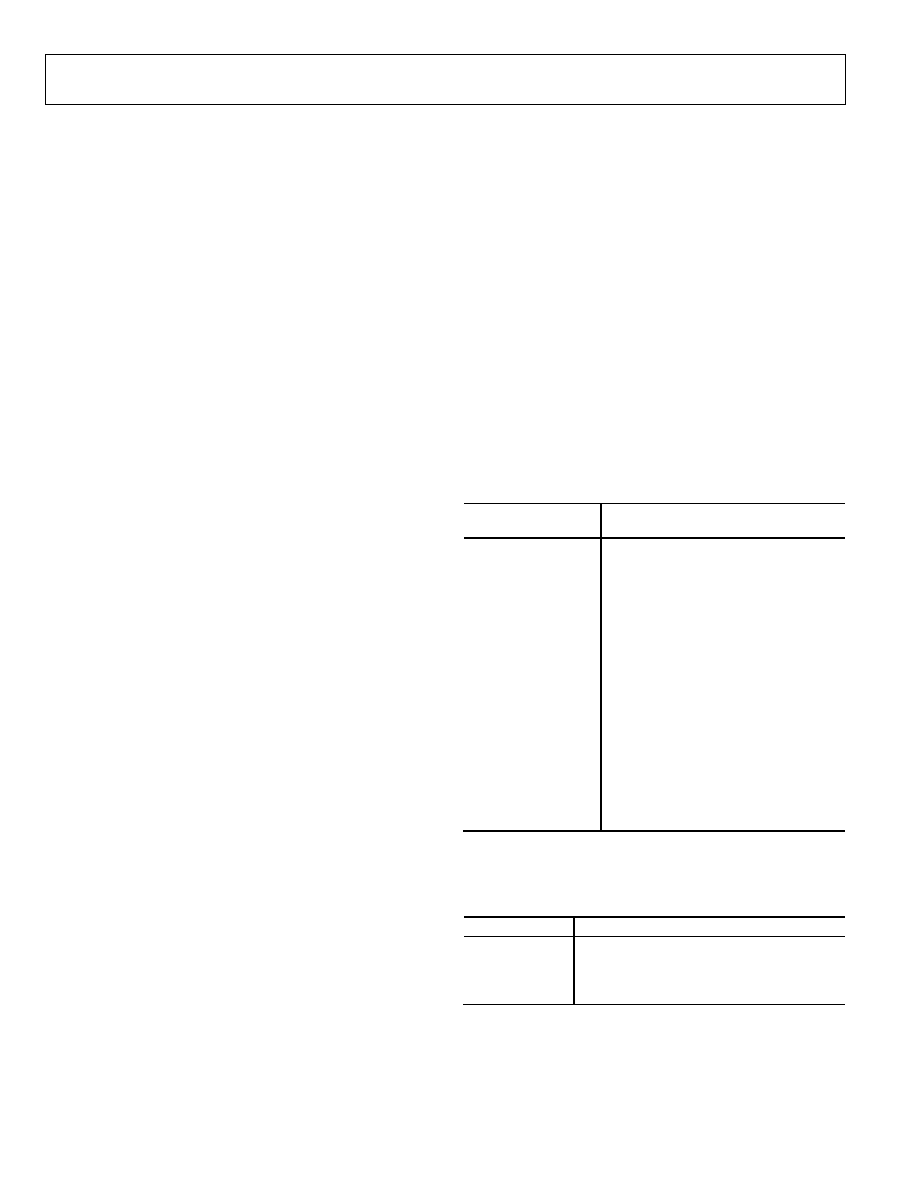
ADV7183A
Rev. A | Page 22 of 104
SDP SYNC PROCESSING
The SDP extracts syncs embedded in the video data stream.
There is currently no support for external HS/VS inputs. The
sync extraction has been optimized to support imperfect video
sources (e.g., videocassette recorders with head switches). The
actual algorithm used employs a coarse detection based on a
threshold crossing followed by a more detailed detection using
an adaptive interpolation algorithm. The raw sync information
is sent to a line-length measurement and prediction block. The
output of this is then used to drive the digital resampling
section to ensure that the SDP outputs 720 active pixels per line.
The sync processing on the ADV7183A also includes two
specialized postprocessing blocks that filter and condition the
raw sync information retrieved from the digitized analog video.
·
VSYNC Processor. This block provides extra filtering of the
detected VSYNCs to give improved vertical lock.
·
HSYNC Processor. The HSYNC processor is designed to
filter incoming HSYNCs that have been corrupted by
noise, providing much improved performance for video
signals with stable time base but poor SNR.
SDP VBI DATA RECOVERY
The SDP can retrieve the following information from the input
video:
·
Wide-screen signaling (WSS)
·
Copy generation management system (CGMS)
·
Closed caption (CC)
·
Macrovision protection presence
·
EDTV data
·
Gemstar compatible data slicing
The SDP is also capable of automatically detecting the incoming
video standard with respect to
·
Color subcarrier frequency
·
Field rate
·
Line rate
and can configure itself to support PAL-BGHID, PAL-M/N,
PAL-combination N, NTSC-M, NTSC-J, SECAM 50 Hz/60 Hz,
NTSC4.43, and PAL60.
SDP GENERAL SETUP
Video Standard Selection (SDP)
The VID_SEL[3:0] register allows the user to force the digital
core into a specific video standard. Under normal
circumstances, this should not be necessary. The VID_SEL[3:0]
bits default to an autodetection mode that supports PAL, NTSC,
SECAM, and variants thereof.
Refer to the Autodetection of SDP Modes section for more
information on the autodetection system.
Autodetection of SDP Modes
In order to guide the autodetect system of the SDP block,
individual enable bits are provided for each of the supported
video standards. Setting the relevant bit to 0 inhibits the
standard from being detected automatically. Instead, the system
picks the closest of the remaining enabled standards. The results
of SDP autodetection can be read back via the status registers.
See the Global Status Registers section for more information.
Table 30. VID_SEL Function
VID_SEL[3:0]
Address 0x00 [7:4]
Description
0000*
Autodetect (PAL BGHID) <> NTSC J.
0001
Autodetect (PAL BGHID) <> NTSC M.
0010
Autodetect (PAL N) <> NTSC J.
0011
Autodetect (PAL N) <> NTSC M.
0100
NTSC J (1)
0101
NTSC M (1).
0110 PAL
60.
0111 NTSC
4.43
(1).
1000 PAL
BGHID.
1001
PAL N ( = PAL BGHID (with pedestal)).
1010
PAL M (without pedestal).
1011 PAL
M.
1100
PAL combination N.
1101
PAL combination N (with pedestal).
1110 SECAM.
1111
SECAM (with pedestal).
*Default value.
AD_SEC525_EN Enable Autodetection of SECAM 525 line
video (SDP), Address 0x07, [7]
Table 31. AD_SEC525_EN Function
AD_SEC525_EN Description
0*
Disable the autodetection of a 525-line
system with a SECAM style, FM-modulated
color component.
1
Enable the detection.
*Default value.

ADV7183A
Rev. A | Page 23 of 104
AD_SECAM_EN Enable Autodetection of SECAM (SDP),
Address 0x07, [6]
Table 32. AD_SECAM_EN Function
AD_SECAM_EN Description
0
Disable the autodetection of SECAM.
1*
Enable the detection.
*Default value.
AD_N443_EN Enable Autodetection of NTSC 443 (SDP),
Address 0x07, [5]
Table 33. AD_N443_EN Function
AD_N443_EN Description
0
Disable the autodetection of NTSC style
systems with a 4.43 MHz color subcarrier.
1*
Enable the detection.
*Default value.
AD_P60_EN Enable Autodetection of PAL60 (SDP),
Address 0x07, [4]
Table 34. AD_P60_EN Function
AD_P60_EN Description
0
Disable the autodetection of PAL systems with a
60 Hz field rate.
1*
Enable the detection.
*Default value.
AD_PALN_EN Enable Autodetection of PAL N (SDP),
Address 0x07, [3]
Table 35. AD_PALN_EN Function
AD_PALN_EN Description
0
Disable the detection of the PAL N standard.
1*
Enable the detection.
*Default value.
AD_PALM_EN Enable Autodetection of PAL M (SDP),
Address 0x07, [2]
Table 36. AD_PALM_EN Function
AD_PALM_EN Description
0
Disable the autodetection of PAL M.
1*
Enable the detection.
*Default value.
AD_NTSC_EN Enable Autodetection of NTSC (SDP),
Address 0x07, [1]
Table 37. AD_NTSC_EN Function
AD_NTSC_EN Description
0
Disable the detection of standard NTSC.
1*
Enable the detection.
*Default value.
AD_PAL_EN Enable Autodetection of PAL (SDP),
Address 0x07, [0]
Table 38. AD_PAL_EN Function
AD_PAL_EN Description
0
Disable the detection of standard PAL.
1*
Enable the detection.
*Default value.
SFL_INV Subcarrier Frequency Lock Inversion (SDP)
This bit controls the behavior of the PAL switch bit in the SFL
(GenLock Telegram) data stream. It was implemented to solve
some compatibility issues with video encoders. It solves two
problems:
1.
The PAL switch bit is only meaningful in PAL. Some
encoders (including Analog Devices encoders) also look at
the state of this bit in NTSC.
2.
There was a design change in Analog Devices encoders
from ADV717x to ADV719x. The older versions used the
SFL (GenLock Telegram) bit directly, while the later ones
invert the bit prior to using it. The reason for this is that the
inversion compensated for the 1-line delay of an SFL
(GenLock Telegram) transmission.
As a result:
1.
ADV717x encoders need the PAL switch bit in the SFL
(GenLock Telegram) to be 1 for NTSC to work.
2.
ADV7190/ADV7191/ADV7194 encoders need the PAL
switch bit in the SFL to be 0 to work in NTSC.
If the state of the PAL switch bit is wrong, a 180°phase shift
occurs.
In a decoder/encoder back-to-back system in which SFL is used,
this bit must be set up properly for the specific encoder used.
Table 39. SFL_INV Function
SFL_INV
Address 0x41, [6]
Description
0
SFL compatible with ADV7190/ADV7191/
ADV7194 encoders.
1*
SFL compatible with ADV717x/ADV7173x
encoders.
*Default value.

ADV7183A
Rev. A | Page 24 of 104
Lock Related Controls (SDP)
Lock information is presented to the user through Bits [1:0] of
the Status 1 register. See the STATUS_1[7:0] Address 0x10, [7:0]
section. Figure 9 outlines the signal flow and the controls
available to influence the way the lock status information is
generated.
SRLS Select Raw Lock Signal (SDP), Address 0x51, [6]
Using the SRLS bit, the user can choose between two sources for
determining the lock status (per Bits [1:0] in the Status 1
register).
·
The time_win signal is based on a line-to-line evaluation of
the horizontal synchronization pulse of the incoming
video. It reacts quite quickly.
·
The free_run signal evaluates the properties of the
incoming video over several fields, and takes vertical
synchronization information into account.
Table 40. SRLS Function
SRLS Description
0*
Select the free_run signal.
1
Select the time_win signal.
*Default value.
FSCLE Fsc Lock Enable (SDP), Address 0x51, [7]
The FSCLE bit allows the user to choose whether the status of
the color subcarrier loop is taken into account when the overall
lock status is determined and presented via Bits [1:0] in Status
Register 1. This bit must be set to 0 when operating the SDP in
YPrPb component mode in order to generate a reliable HLOCK
status bit.
Table 41. FSCLE Function
FSCLE Description
0
Overall lock status only dependent on horizontal
sync lock.
1*
Overall lock status dependent on horizontal sync
lock and Fsc Lock.
*Default value.
CIL[2:0] Count Into Lock (SDP), Address 0x51, [2:0]
CIL[2:0] determines the number of consecutive lines for which
the into lock condition must be true before the system switches
into the locked state, and reports this via Status 0 [1:0].
Table 42. CIL Function
CIL[2:0]
Description (Count Value in Lines of Video)
000 1
001 2
010 5
011 10
100* 100
101 500
110 1000
111 100000
*Default value.
COL[2:0] Count Out of Lock (SDP), Address 0x51, [5:3]
COL[2:0] determines the number of consecutive lines for which
the out of lock condition must be true before the system
switches into unlocked state, and reports this via Status 0 [1:0].
Table 43. COL Function
COL[2:0]
Description (Count Value in Lines of Video)
000 1
001 2
010 5
011 10
100* 100
101 500
110 1000
111 100000
*Default value.
04819-0-009
1
0
TIME_WIN
FREE_RUN
STATUS 1 [0]
SELECT THE RAW LOCK SIGNAL
SRLS
FILTER THE RAW LOCK SIGNAL
CIL[2:0], COL[2:0]
TAKE F
SC
LOCK INTO ACCOUNT
FSCLE
STATUS 1 [1]
F
SC
LOCK
1
0
COUNTER INTO LOCK
COUNTER OUT OF LOCK
MEMORY
Figure 9. SDP Lock Related Signal Path
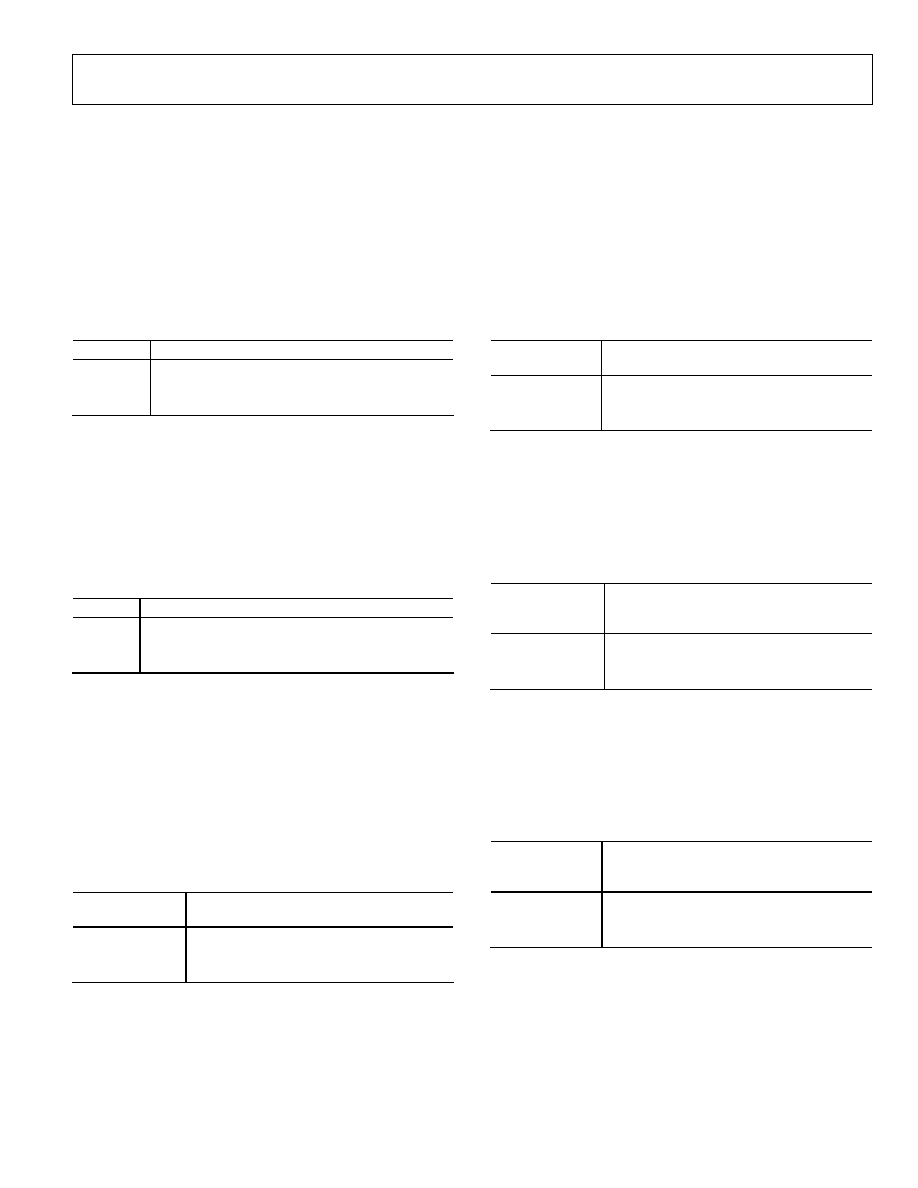
ADV7183A
Rev. A | Page 25 of 104
SDP COLOR CONTROLS
The following registers provide user control over the picture
appearance, including control of the active data in the event of
video being lost. They are independent of any other controls.
For instance, brightness control is independent from picture
clamping, although both controls affect the signal's dc level.
CON[7:0] Contrast Adjust (SDP), Address 0x08, [7:0]
This is the user control for contrast adjustment for the SDP
block only.
Table 44. CON Function
CON[7:0]
Description (Adjust Contrast of the Picture)
0x80*
Gain on luma channel = 1.
0x00
Gain on luma channel = 0.
0xFF
Gain on luma channel = 2.
*Default value.
SAT[7:0] Saturation Adjust (SDP), Address 0x09, [7:0]
The user can adjust the saturation of the color output using this
register. This registers affects the SDP core only.
ADI encourages users not to use the SAT[7:0] register, which
may be removed in future revisions of the ADV7183A. Instead,
the SD_SAT_Cb and SD_SAT_Cr registers should be used.
Table 45. SAT Function
SAT[7:0]
Description (Adjust Saturation of the Picture)
0x80*
Chroma gain = 0 dB.
0x00
Chroma gain = 42 dB.
0xFF
Chroma gain = 6 dB.
*Default value.
SD_SAT_Cb[7:0] SD Saturation Cb Channel (SDP),
Address 0xE3, [7:0]
This register allows the user to control the gain of the Cb
channel only.
For this register to be active , SAT[7:0] must be programmed
with its default value of 0x80. If SAT[7:0] is programmed with a
different value, SD_SAT_Cb[7:0] and SD_SAT_Cr[7:0] are
inactive.
Table 46. SD_SAT_Cb Function
SD_SAT_Cb[7:0]
Description
(Adjust Saturation of the Picture)
0x80*
Chroma gain = 0 dB.
0x00
0xFF
*Default value.
SD_SAT_Cr[7:0] SD Saturation Cr Channel (SDP),
Address 0xE4, [7:0]
This register allows the user to control the gain of the Cr
channel only. This register affects the SDP core only.
For this register to be active, SAT[7:0] must be programmed
with its default value of 0x80. If SAT[7:0] is programmed with a
different value, SD_SAT_Cb[7:0] and SD_SAT_Cr[7:0] are
inactive.
Table 47. SD_SAT_Cr Function
SD_SAT_Cr[7:0]
Description
(Adjust Saturation of the Picture)
0x80*
Chroma gain = 0 dB
0x00
0xFF
*Default value.
SD_OFF_Cb[7:0] SD Offset Cb Channel (SDP),
Address 0xE1, [7:0]
This register allows the user to select an offset for the Cb
channel only. This register affects the SDP core only. There is a
functional overlap with the Hue [7:0] register.
Table 48.SD_OFF_Cb Function
SD_OFF_Cb[7:0]
Description
(Adjust Hue of the Picture by Selecting an
Offset for Data on the Cb Channel)
0x80*
0x7F
0xFF
*Default value.
SD_OFF_Cr [7:0] SD Offset Cr Channel (SDP),
Address 0xE2, [7:0]
This register allows the user to select an offset for the Cr
channel only. This register affects the SDP core only. There is a
functional overlap with the Hue [7:0] register.
Table 49. SD_OFF_Cr Function
SD_OFF_Cr[7:0]
Description
(Adjust Hue of the Picture by Selecting an
Offset for Data on Cr Channel)
0x80*
0x7F
0xFF
*Default value.
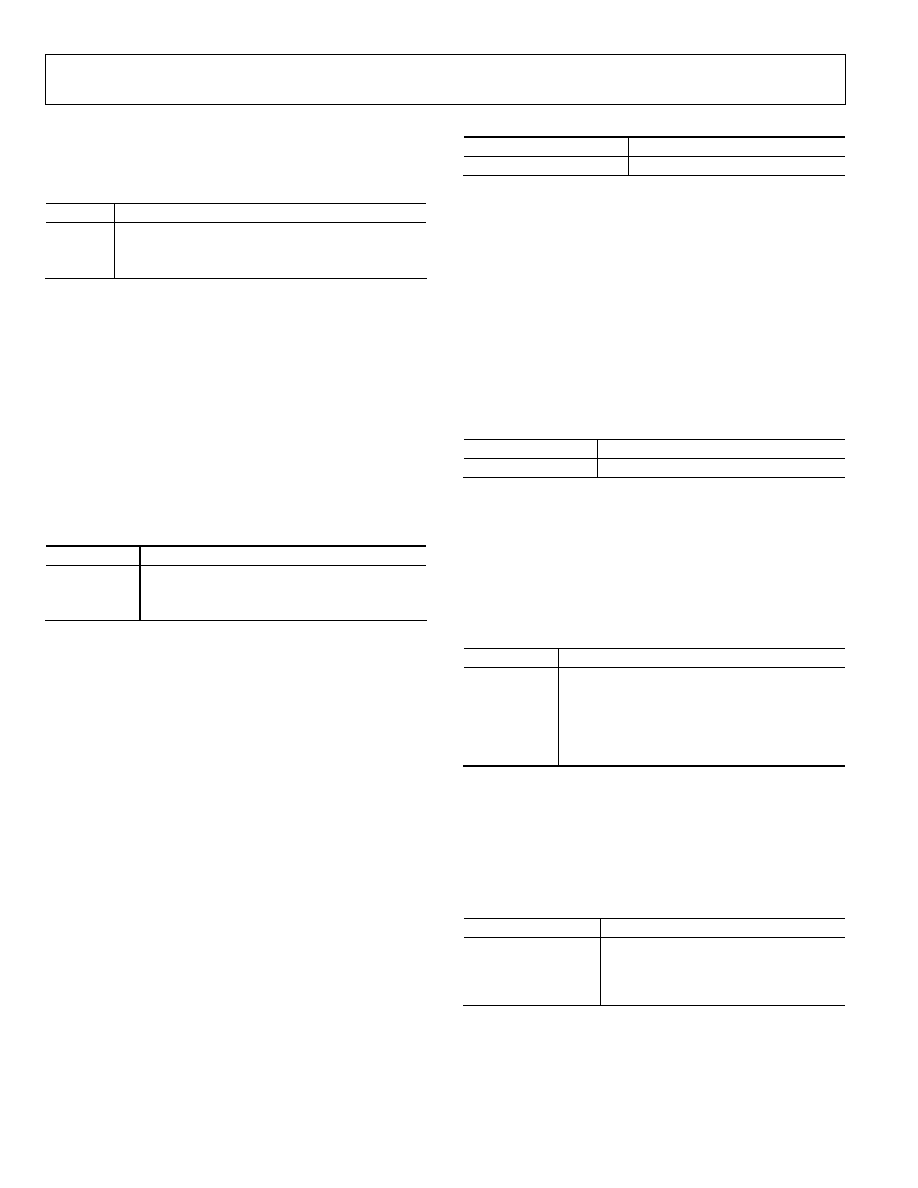
ADV7183A
Rev. A | Page 26 of 104
BRI[7:0] Brightness Adjust (SDP), Address 0x0A, [7:0]
This register controls the brightness of the video signal through
the SDP core.
Table 50. BRI Function
BRI[7:0]
Description (Adjust Brightness of the Picture)
0x00*
Offset of the luma channel = 0IRE.
0x7F
Offset of the luma channel = 100IRE.
0xFF
Offset of the luma channel = 100IRE.
*Default value.
HUE[7:0] Hue Adjust (SDP), Address 0x0B, [7:0]
This register contains the value for the color hue adjustment.
HUE[7:0] has a range of ±90°, with 0x00 equivalent to an
adjustment of 0°. The resolution of HUE[7:0] is 1 bit = 0.7°.
The hue adjustment value is fed into the AM color demodula-
tion block. Therefore, it only applies to video signals that
contain chroma information in the form of an AM modulated
carrier (CVBS or Y/C in PAL or NTSC). It does not affect
SECAM and does not work on component video inputs
(YPrPb).
Table 51. HUE Function
HUE[7:0] Description (Adjust Hue of the Picture)
0x00*
Phase of the chroma signal = 0°.
0x7F
Phase of the chroma signal = 90°.
0xFF
Phase of the chroma signal = +90°.
*Default value.
DEF_Y[5:0] Default Value Y (SDP), Address 0x0C, [7:2]
In cases where the ADV7183A loses lock on the incoming video
signal or where there is no input signal, the DEF_Y[5:0] register
allows the user to specify a default luma value to be output.
This value is used under the following conditions:
·
If DEF_VAL_AUTO_EN bit is set to high and the
ADV7183A lost lock to the input video signal. This is the
intended mode of operation (automatic mode).
·
The DEF_VAL_EN bit is set, regardless of the lock status of
the video decoder.
·
This is a forced mode that may be useful during
configuration.
The DEF_Y[5:0] values define the 6 MSBs of the output video.
The remaining LSBs are padded with 0s. For example, in 8-bit
mode, the output is Y[7:0] = {DEF_Y[5:0], 0, 0}.
Table 52. DEF_Y Function
DEF_Y[5:0] Description
0x36 (Blue)*
Default value of Y.
*Default value.
DEF_C[7:0] Default Value C (SDP), Address 0x0D, [7:0]
The DEF_C[7:0] register complements the DEF_Y[5:0] value. It
defines the 4 MSBs of Cr and Cb values to be output if
·
The DEF_VAL_AUTO_EN bit is set to high and the
ADV7183A can't lock to the input video (automatic mode).
·
DEF_VAL_EN bit is set to high (forced output).
The data that is finally output from the ADV7183A for the
chroma side is Cr[7:0] = {DEF_C[7:4], 0, 0, 0, 0}, Cb[7:0] =
{DEF_C[3:0], 0, 0, 0, 0}.
Table 53. DEF_C Function
DEF_C[7:0] Description
0x7C (blue)*
Default values for Cr and Cb.
*Default value.
DEF_VAL_EN Default Value Enable (SDP),
Address 0x0C, [0]
This bit forces the use of the default values for Y, Cr, and Cb.
Refer to the descriptions for DEF_Y and DEF_C for additional
information. The decoder also outputs a stable 27 MHz clock,
HS, and VS in this mode.
Table 54. DEF_VAL_EN Function
DEF_VAL_EN Description
0*
Don't force the use of default Y, Cr, and Cb
values. Output colors dependent on
DEF_VAL_AUTO_EN.
1
Always use default Y, Cr, and Cb values.
Override picture data even if the video decoder
is locked.
*Default value.
DEF_VAL_AUTO_EN Default Value Automatic Enable
(SDP), Address 0x0C, [1]
This bit enables the automatic usage of the default values for Y,
Cr, and Cb in cases where the ADV7183A cannot lock to the
video signal.
Table 55. DEF_VAL_AUTO_EN Function
DEF_VAL_AUTO_EN Description
0
Don't use default Y, Cr, and Cb values. If
unlocked, output noise.
1*
Use default Y, Cr, and Cb values when
decoder loses lock.
*Default value.

ADV7183A
Rev. A | Page 27 of 104
SDP CLAMP OPERATION
04819-0-010
COARSE
CURRENT
SOURCES
FINE
CURRENT
SOURCES
DATA
PRE
PROCESSOR
(DPP)
ADC
SDP
WITH DIGITAL
FINE CLAMP
CLAMP CONTROL
ANALOG
VIDEO
INPUT
Figure 10. SDP Clamping Overview
The input video is ac-coupled into the ADV7183A. Therefore,
its dc value needs to be restored. This process is referred to as
clamping the video. This section explains the general process of
clamping on the ADV7183A for the SDP, and shows the
different ways in which a user can configure its behavior.
The SDP block uses a combination of current sources and a
digital processing block for clamping, as shown in Figure 10.
The analog processing channel shown is replicated three times
inside the IC. While only one single channel (and only one
ADC) would be needed for a CVBS signal, two independent
channels are needed for YC (S-VHS) type signals, and three
independent channels are needed to allow component signals
(YPrPb) to be processed.
The clamping can be divided into two sections:
·
Clamping before the ADC (analog domain): current
sources.
·
Clamping after the ADC (digital domain): digital
processing block.
The ADCs can digitize an input signal only if it resides within
the ADC's 1.6 V input voltage range. An input signal with a dc
level that is too large or too small is clipped at the top or bottom
of the ADC range.
The primary task of the analog clamping circuits is to ensure
that the video signal stays within the valid ADC input window
so the analog-to-digital conversion can take place. It is not nec-
essary to clamp the input signal with a very high accuracy in the
analog domain as long as the video signal fits the ADC range.
After digitization, the digital fine clamp block corrects for any
remaining variations in dc level. Since the dc level of an input
video signal refers directly to the brightness of the picture
transmitted, it is important to perform a fine clamp with high
accuracy; otherwise, brightness variations may occur.
Furthermore, dynamic changes in the dc level will almost
certainly lead to visually objectionable artifacts, and must
therefore be prohibited.
The clamping scheme has to complete two tasks: it must be able
to acquire a newly connected video signal with a completely
unknown dc level, and it must maintain the dc level during
normal operation.
For a fast acquiring of an unknown video signal, the large
current clamps may be activated
7
. Control of the coarse and fine
current clamp parameters is performed automatically by the
decoder.
Standard definition video signals may have excessive noise on
them. In particular, CVBS signals transmitted by terrestrial
broadcast and demodulated using a tuner usually show very
large levels of noise (>100 mV). A voltage clamp would be
unsuitable for this type of video signal. Instead, the ADV7183A
employs a set of four current sources that can cause coarse
(>0.5 mA) and fine (<0.1 mA) currents to flow into and away
from the high impedance node that carries the video signal (see
Figure 10).
The following sections describe the I
2
C signals that can be used
to influence the behavior of SDP clamping.
Previous revisions of the ADV7183A had controls (FACL/FICL,
fast and fine clamp length) to allow configuration of the length
for which the coarse (fast) and fine current sources are switched
on. These controls were removed on the ADV7183A-FT and
replaced by an adaptive scheme.
CCLEN Current Clamp Enable (SDP), Address 0x14, [4]
The current clamp enable bit allows the user to switch off the
current sources in the analog front end altogether. This may be
useful if the incoming analog video signal is clamped externally.
Table 56. CCLEN Function
CCLEN Description
0
Current sources switched off.
1* Current
sources
enabled.
*Default value.
7
It is assumed that the amplitude of the video signal at this point is of a
nominal value.
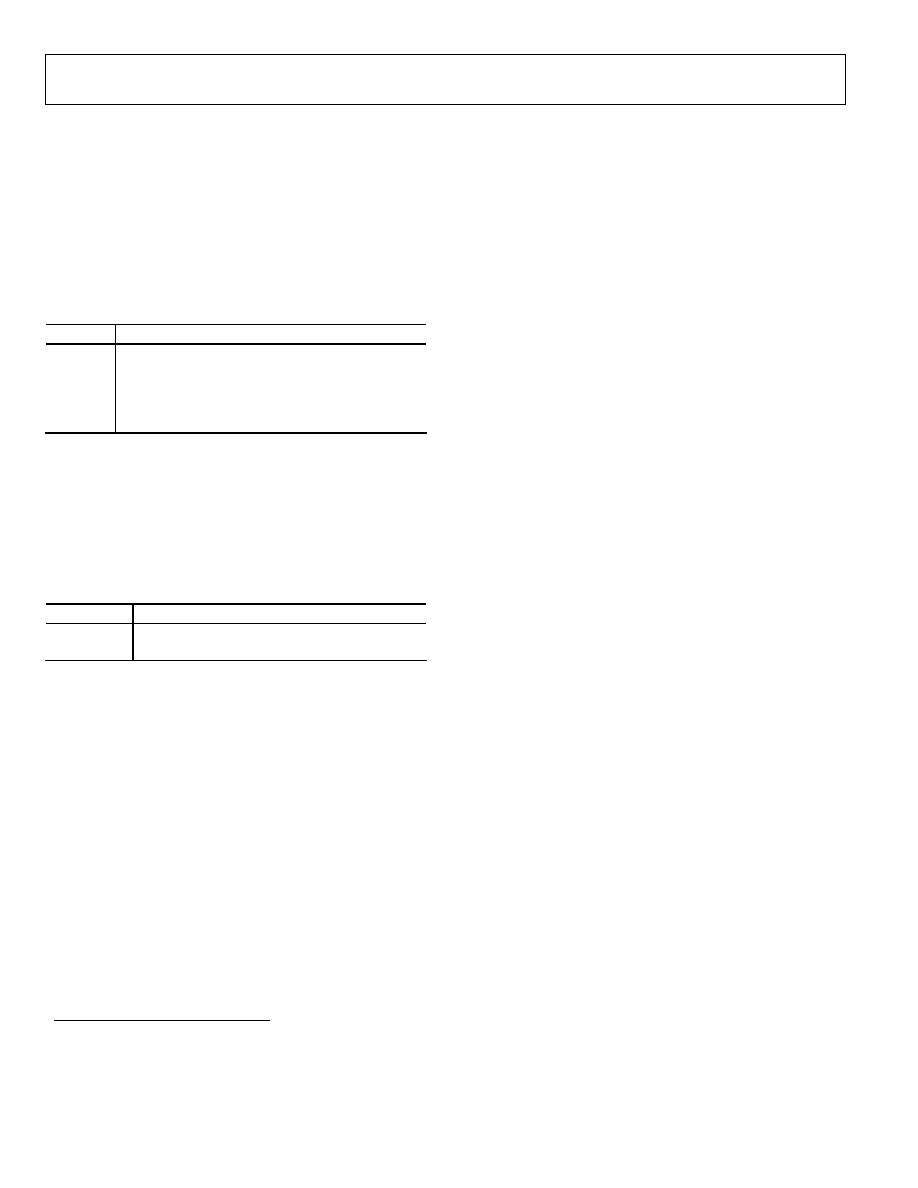
ADV7183A
Rev. A | Page 28 of 104
DCT[1:0] Digital Clamp Timing (SDP), Address 0x15, [6:5]
The Clamp Timing register determines the time constant of the
digital fine clamp circuitry. It is important to realize that the
digital fine clamp reacts very fast since it is supposed to
immediately correct any residual dc level error for the active
line. The time constant of the digital fine clamp must be much
quicker than the one from the analog blocks.
By default, the time constant of the digital fine clamp is adjusted
dynamically to suit the currently connected input signal.
Table 57. DCT Function
DCT[1:0] Description
00
Slow (TC = 1 sec).
01
Medium (TC = 0.5 sec).
10*
Fast (TC = 0.1 sec).
11
Determined by ADV7183A dependent on video
parameters.
*Default value.
DCFE Digital Clamp Freeze Enable (SDP), Address 0x15, [4]
This register bit allows the user to freeze the digital clamp loop
at any time. It is intended for users who would like to do their
own clamping. Users should disable the current sources for
analog clamping via the appropriate register bits, wait until the
digital clamp loop settles, and then freeze it via the DCFE bit.
Table 58.
DCFE Description
0* Digital
clamp
operational.
1
Digital clamp loop frozen.
*Default value.
SDP LUMA FILTER
Data
8
from the digital fine clamp block is processed by four sets
of filters:
·
Luma antialias filter (YAA). The SDP received video at a
rate of 27 MHz
9
. The ITU-R BT.601 recommends a
sampling frequency of 13.5 MHz. The luma antialias filter
decimates the oversampled video using a high quality,
linear phase, low-pass filter that preserves the luma signal
while at the same time attenuating out-of-band
components. The luma antialias filter (YAA) has a fixed
response.
·
Luma shaping filters (YSH). The shaping filter block is a
programmable low-pass filter with a wide variety of
responses. It can be used to selectively reduce the luma
video signal bandwidth (needed prior to scaling, for
example). For some video sources that contain high
8
The data format at this point is CVBS for CVBS input or luma only for Y/C and
YPrPb input formats.
9
In the case of 4× oversampled video, the ADCs sample at 54 MHz, and the
first decimation is performed inside the DPP filters. Therefore, the data rate
into the SDP core is always 27 MHz.
frequency noise, reducing the bandwidth of the luma signal
improves visual picture quality. A follow-on video
compression stage may work more efficiently if the video is
low-pass filtered.
The ADV7183A allows selection of two responses for the
shaping filter: one that is used for good quality CVBS,
component, and S-VHS type sources, and a second for
nonstandard CVBS signals.
The YSH filter responses also include a set of notches for
PAL and NTSC. However, it is recommended to use the
comb filters for YC separation.
·
Luma peaking filter. This filter can be manually enabled.
The user can select to boost or attenuate the midregion of
the Y spectrum around 3 MHz. The peaking filter may
visually improve the picture by showing more definition on
those picture details that contain frequency components
around 3 MHz. The peaking filter compensates for the
effects of a wide notch filter: Where the notch starts to fall
off, the peaking filter lifts the overall response back on.
·
Digital resampling filter. This block is used to allow
dynamic resampling of the video signal to alter parameters
such as the time base of a line of video. Fundamentally, the
resampler is a set of low-pass filters. The actual response is
chosen by the system with no requirement for user
intervention.
Figure 12 through Figure 15 show the overall response of all
filters together. Unless otherwise noted, the filters are set into a
typical wideband mode, and the peaking function is disabled.
Y Shaping Filter
For input signals in CVBS format, the luma shaping filters play
an essential role in removing the chroma component from a
composite signal. YC separation must aim for best possible
crosstalk reduction while still retaining as much bandwidth
(especially on the luma component) as possible. High quality
YC separation can be achieved by using the internal comb filters
of the ADV7183A. Comb filtering, however, relies on the
frequency relationship of the luma component (multiples of the
video line rate) and the color subcarrier (Fsc). For good quality
CVBS signals, this relationship is known; the comb filter
algorithms can be used to separate out luma and chroma with
high accuracy.
In the case of nonstandard video signals, the frequency
relationship may be disturbed and the comb filters may not be
able to remove all crosstalk artifacts in an optimum fashion
without the assistance of the shaping filter block.

ADV7183A
Rev. A | Page 29 of 104
An automatic mode is provided. Here, the ADV7183A evaluates
the quality of the incoming video signal and selects the filter
responses in accordance with the signal quality and video
standard. YFSM, WYSFMOVR, and WYSFM allow the user to
manually override the automatic decisions in part or in full.
The luma shaping filter has three control registers:
·
YSFM[4:0] allows the user to manually select a shaping
filter mode (applied to all video signals) or to enable an
automatic selection (dependent on video quality and video
standard).
·
WYSFMOVR allows the user to manually override the
WYSFM decision.
·
WYSFM[4:0] allows the user to select a different shaping
filter mode for good quality CVBS, component (YPrPb),
and S-VHS (YC) input signals.
In automatic mode, the system preserves the maximum possible
bandwidth for good CVBS sources (since they can successfully
be combed) as well as for luma components of YPrPb and YC
sources, since they need not be combed. For poor quality
signals, the system selects from a set of proprietary shaping
filter responses that complements comb filter operation in order
to reduce visual artifacts.
The decisions of the control logic are shown in Figure 11.
YSFM[4:0] Y Shaping Filter Mode (SDP), Address 0x17, [4:0]
The Y shaping filter mode bits allow the user to select from a
wide range of low-pass and notch filters. When switched in
automatic mode, the filter is selected based on other register
selections (e.g., detected video standard) as well as properties
extracted from the incoming video itself (e.g., quality, time base
stability). The automatic selection always picks the widest
possible bandwidth for the video input encountered.
·
If the YSFM settings specify a filter (i.e., YSFM is set to
values other than 00000 or 00001), the chosen filter is
applied to all video, regardless of its quality.
·
In automatic selection mode, the notch filters are only used
for bad quality video signals. For all other video signals,
wideband filters are used.
WYSFMOVR Wideband Y Shaping Filter Override (SDP),
Address 0x18,[7]
Setting the WYSFMOVR bit enables the use of the WYSFM[4:0]
settings for good quality video signals. For more information,
refer to the general discussion of the luma shaping filters in the
Y Shaping Filter section and the flowchart shown in Figure 11.
Table 59.
WYSFMOVR Description
0
Automatic selection of shaping filter for good
quality video signals.
1*
Enable manual override via WYSFM[4:0].
*Default value.
04819-0-011
AUTO SELECT LUMA
SHAPING FILTER TO
COMPLEMENT COMB
SET YSFM
YSFM IN AUTO MODE?
00000 OR 00001
VIDEO
QUALITY
BAD
GOOD
SELECT WIDEBAND
FILTER AS PER
WYSFM[4:0]
SELECT AUTOMATIC
WIDEBAND FILTER
WYSFMOVR
1
0
USE YSFM SELECTED
FILTER REGARDLESS FOR
GOOD AND BAD VIDEO
YES
NO
Figure 11. YSFM and WYSFM Control Flowchart
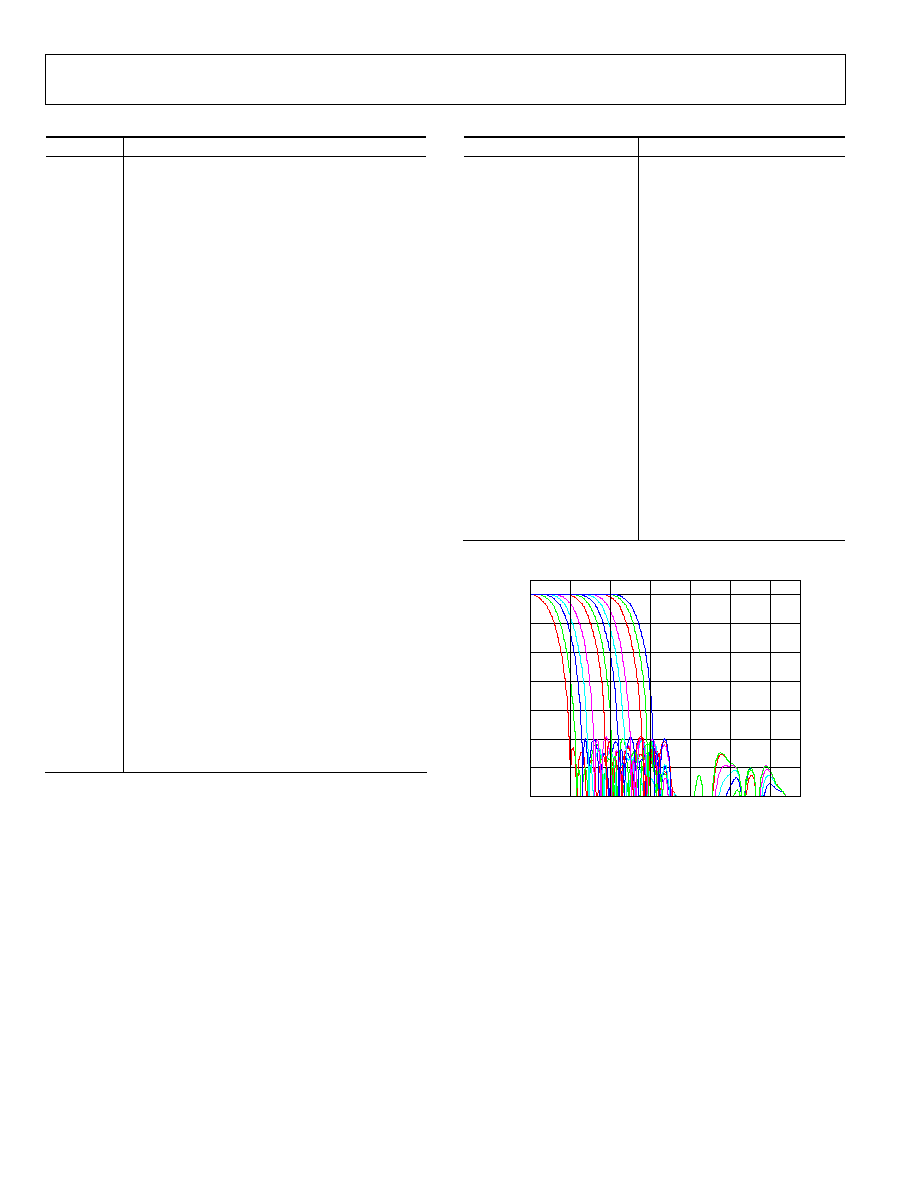
ADV7183A
Rev. A | Page 30 of 104
Table 60. YSFM Function
YSFM[4:0] Description
0'0000
Automatic selection including a wide notch
response (PAL/NTSC/SECAM)
0'0001*
Automatic selection including a narrow notch
response (PAL/NTSC/SECAM)
0'0010 SVHS
1
0'0011 SVHS
2
0'0100 SVHS
3
0'0101 SVHS
4
0'0110 SVHS
5
0'0111 SVHS
6
0'1000 SVHS
7
0'1001 SVHS
8
0'1010 SVHS
9
0'1011 SVHS
10
0'1100 SVHS
11
0'1101 SVHS
12
0'1110 SVHS
13
0'1111 SVHS
14
1'0000 SVHS
15
1'0001 SVHS
16
1'0010 SVHS
17
1'0011
SVHS 18 (CCIR 601)
1'0100
PAL NN 1
1'0101
PAL NN 2
1'0110
PAL NN 3
1'0111
PAL WN 1
1'1000
PAL WN 2
1'1001
NTSC NN 1
1'1010
NTSC NN 2
1'1011
NTSC NN 3
1'1100
NTSC WN 1
1'1101
NTSC WN 2
1'1110
NTSC WN 3
1'1111 Reserved
*Default value.
WYSFM[4:0] Wide Band Y Shaping Filter Mode (SDP),
Address 0x18, [4:0]
The WYSFM[4:0] bits allow the user to manually select a
shaping filter for good quality video signals (e.g., CVBS with
stable time base, luma component of YPrPb, luma component
of YC). The WYSFM bits are only active if the WYSFMOVR bit
is set to 1. See the general discussion of the shaping filter
settings in the Y Shaping Filter section.
Table 61. WYSFM Function
WYSFM[4:0] Description
0'0000
Do not use
0'0001
Do not use
0'0010 SVHS
1
0'0011 SVHS
2
0'0100 SVHS
3
0'0101 SVHS
4
0'0110 SVHS
5
0'0111 SVHS
6
0'1000 SVHS
7
0'1001 SVHS
8
0'1010 SVHS
9
0'1011 SVHS
10
0'1100 SVHS
11
0'1101 SVHS
12
0'1110 SVHS
13
0'1111 SVHS
14
1'0000 SVHS
15
1'0001 SVHS
16
1'0010 SVHS
17
1'0011*
SVHS 18 (CCIR 601)
1'01001'1111
Do not use
*Default value.
0
10
20
30
40
50
60
70
0
10
8
6
4
2
12
04819-0-012
FREQUENCY (MHz)
v740a COMBINED Y ANTIALIAS, S-VHS LOW-PASS FILTERS,
Y RESAMPLE
AMP
L
ITUDE
(dB)
Figure 12. SDP Y S-VHS Combined Responses
The filter plots in Figure 12 show the S-VHS 1 (narrowest) to
S-VHS 18 (widest) shaping filter settings. Figure 14 shows the
PAL notch filter responses. The NTSC compatible notches are
shown in Figure 15.
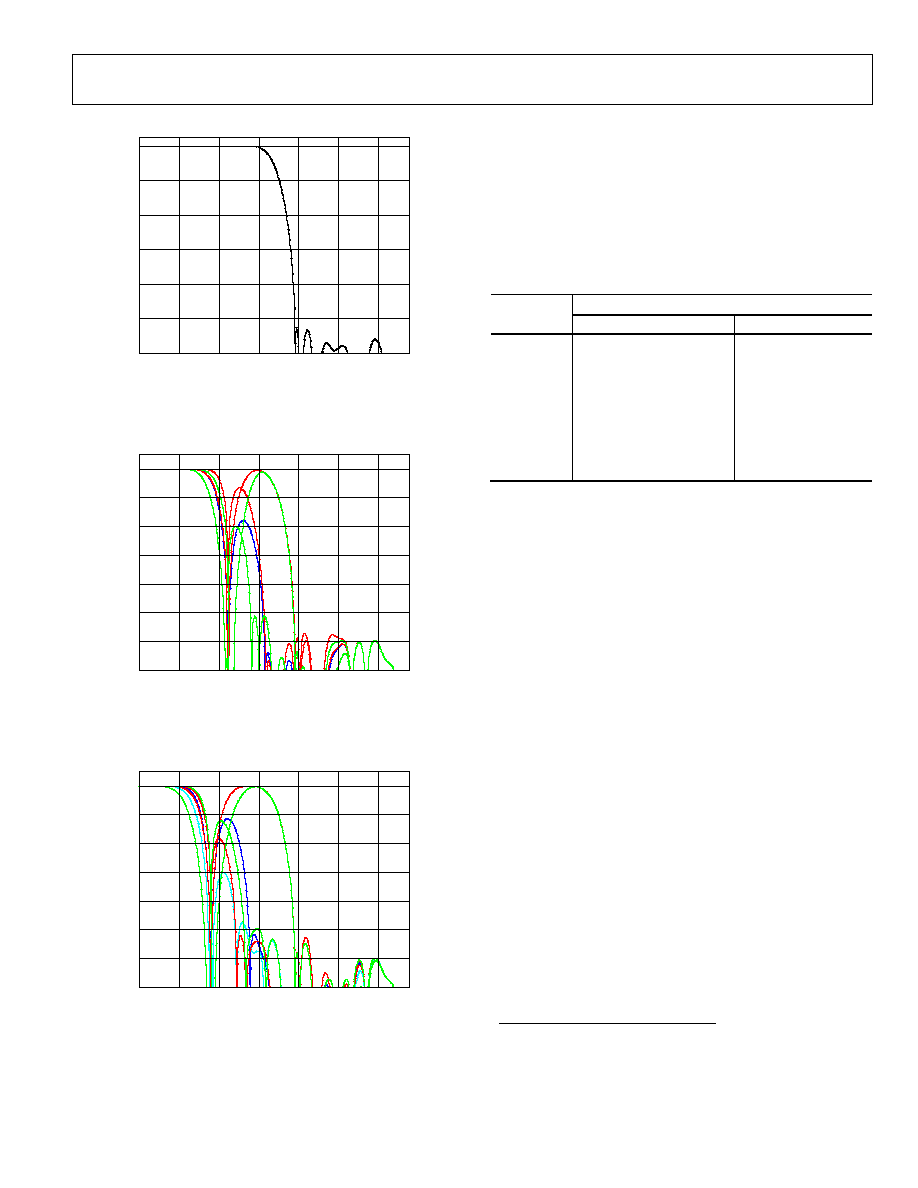
ADV7183A
Rev. A | Page 31 of 104
0
20
40
60
80
100
120
0
10
8
6
4
2
12
04819-0-013
FREQUENCY (MHz)
AMP
L
ITUDE
(dB)
v740a COMBINED Y ANTIALIAS, CCIR MODE SHAPING FILTER,
Y RESAMPLE
Figure 13. SDP Y S-VHS 18 Extra Wideband Filter (CCIR 601 Compliant)
0
10
20
30
40
50
60
70
0
10
8
6
4
2
12
04819-0-014
FREQUENCY (MHz)
v740a COMBINED Y ANTIALIAS, PAL NOTCH FILTERS,
Y RESAMPLE
AMP
L
ITUDE
(dB)
Figure 14. SDP Y S-VHS 18 Extra Wideband Filter (CCIR 601 Compliant)
0
10
20
30
40
50
60
70
0
10
8
6
4
2
12
04819-0-015
FREQUENCY (MHz)
v740a COMBINED Y ANTIALIAS, NTSC NOTCH FILTERS,
Y RESAMPLE
AMP
L
ITUDE
(dB)
Figure 15. SDP Y S-VHS 18 Extra Wideband Filter (601)
YPM[2:0] Y Peaking Filter Mode (SDP), Address 0x02, [2:0]
Allows the user to select peaking. This function allows the user
to boost/attenuate luma signals around the color subcarrier
frequency. Selecting YPM = 000,001,010,011 sharpens the
image; YPM = 101,110,111 attenuates the luma around the color
subcarrier. In cases of incomplete cancellation in the Y comb
filter, this could be used to attenuate any residual C components
(hanging dots) in the Y output at the cost of a softer image.
Table 62. YPM Function
Filter Response (Peak Position)
YPM[2:0]
Composite (2.6 MHz)
S-VHS (3.75 MHz)
000
+4.5 dB
+9.25 dB
001
+4.5 dB
+9.25 dB
010
+4.5 dB
+5.75 dB
011
+1.25 dB
+3.3 dB
100* 0
0
101
1.25 dB
3.0 dB
110
1.75 dB
8.0 dB
111
3.0 dB
8.0 dB
*Default value.
SDP CHROMA FILTER
Data
10
from the digital fine clamp block is processed by two sets
of filters:
·
Chroma Antialias Filter (CAA). The ADV7183A over-
samples the CVBS by a factor of 2 and the Chroma/PrPb
by a factor of 4. A decimating filter (CAA) is used to
preserve the active video band and remove any out-of-
band components. The CAA filter has a fixed response.
·
Chroma Shaping Filters (CSH). The shaping filter block
(CSH) can be programmed to perform a variety of low-
pass responses. It can be used to selectively reduce the
bandwidth of the chroma signal for scaling or
compression.
·
Digital Resampling Filter. This block is used to allow
dynamic resampling of the video signal to alter parameters
such as the time base of a line of video. Fundamentally, the
resampler is a set of low-pass filters. The actual response is
chosen by the system with no requirement for user
intervention.
The plots in Figure 16 show the overall response of all filters
together.
10
The data format at this point is CVBS for CVBS inputs, chroma only for Y/C,
or U/V interleaved for YPrPb input formats.
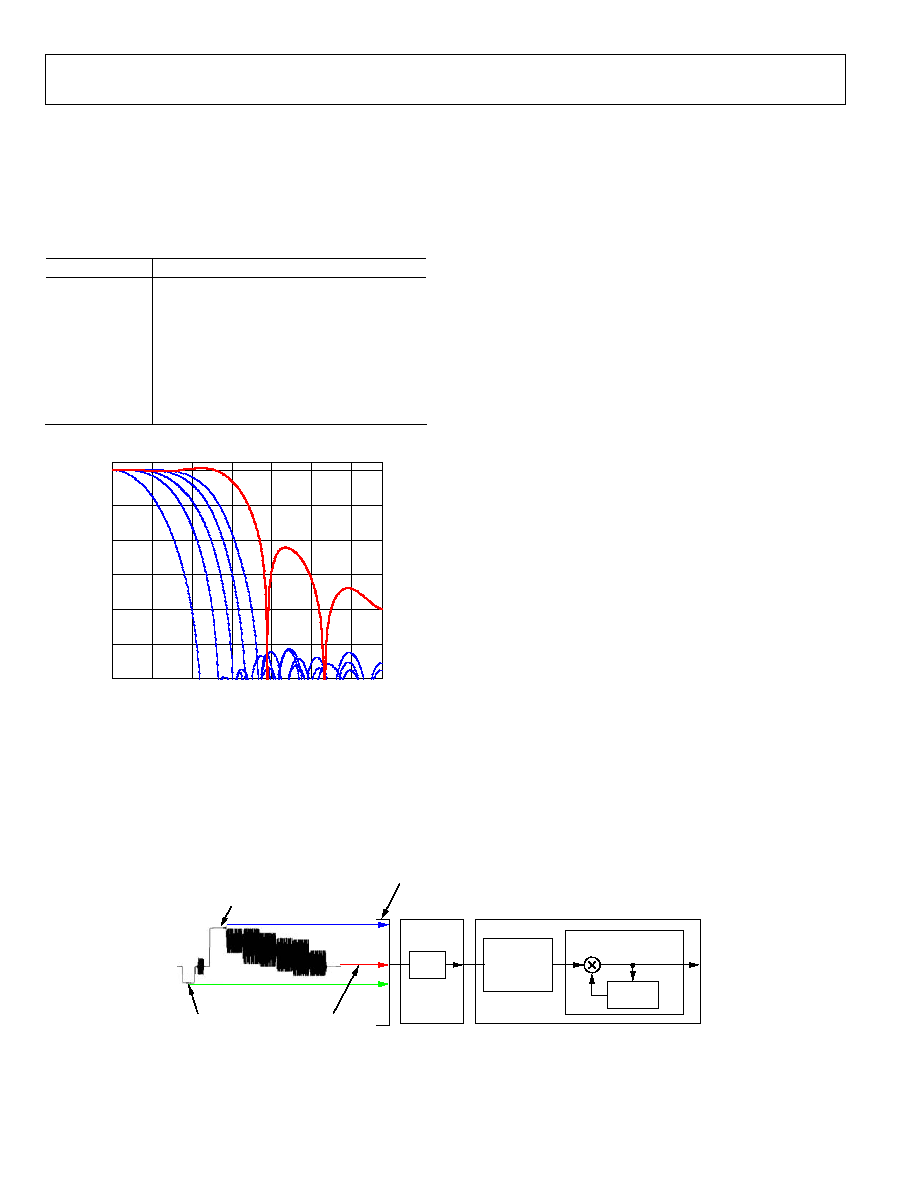
ADV7183A
Rev. A | Page 32 of 104
CSFM[2:0] C Shaping Filter Mode (SDP), Address 0x17, [7]
The C shaping filter mode bits allow the user to select from a
range of low-pass filters for the chrominance signal. When
switched in automatic mode, the widest filter is selected based
on the video standard/format and user choice (see settings 000
and 001 in Table 63).
Table 63. CSFM Function
CSFM[2:0] Description
000*
Autoselect 1.5 MHz bandwidth
001
Autoselect 2.17 MHz bandwidth
010 SH1
011 SH2
100 SH3
101 SH4
110 SH5
111 Wideband
Mode
*Default value.
0
10
20
30
40
50
60
0
5
4
3
2
1
6
04819-0-016
FREQUENCY (MHz)
v740a COMBINED C ANTIALIAS, C SHAPING FILTER,
C RESAMPLER
ATTE
NUATION (dB)
Figure 16. SDP Chroma Shaping Filter Responses
Figure 16 shows the responses of SH1 (narrowest) to SH5
(widest) in addition to the wideband mode (in red).
SDP GAIN OPERATION
The gain control within the ADV7183A is done on a purely
digital basis. The input ADCs support a 10-bit range, mapped
into a 1.6 V analog voltage range. Gain correction takes place
after the digitization in the form of a digital multiplier.
There are several advantages of this architecture over the
commonly used PGA (programmable gain amplifier) before the
ADCs; among them is the fact that the gain is now completely
independent of supply, temperature, and process variations.
As shown in Figure 17, the ADV7183A can decode a video
signal as long as it fits into the ADC window. There are two
components to this: the amplitude of the input signal and the dc
level it resides on. The dc level is set by the clamping circuitry
(see the SDP Clamp Operation section).
If the amplitude of the analog video signal is too high, clipping
may occur, resulting in visual artifacts. The analog input range
of the ADC, together with the clamp level, determines the
maximum supported amplitude of the video signal.
The minimum supported amplitude of the input video is
determined by the SDP core's ability to retrieve horizontal and
vertical timing and to lock to the color burst (if present).
There are two gain control units, one each for luma and chroma
data. Both can operate independently of each other. The chroma
unit, however, can also take its gain value from the luma path.
Several AGC modes are possible; Table 64 summarizes them.
It is possible to freeze the automatic gain control loops. This will
cause the loops to stop updating and the AGC determined gain
at the time of the freeze stays active until the loop is either
unfrozen or the gain mode of operation is changed.
The currently active gain from any of the modes can be read
back. Please refer to the description of the dual function manual
gain registers, LG[11:0] Luma Gain and CG[11:0] Chroma
Gain, in the SDP Luma Gain and SDP Chroma Gain sections.
04821-0-017
ANALOG VOLTAGE
RANGE SUPPORTED BY ADC (1.6V RANGE FOR ADV7183A)
DATA
PRE
PROCESSOR
(DPP)
ADC
SDP
(GAIN SELECTION ONLY)
MAXIMUM
VOLTAGE
MINIMUM
VOLTAGE
CLAMP
LEVEL
GAIN
CONTROL
Figure 17. SDP Gain Control Overview
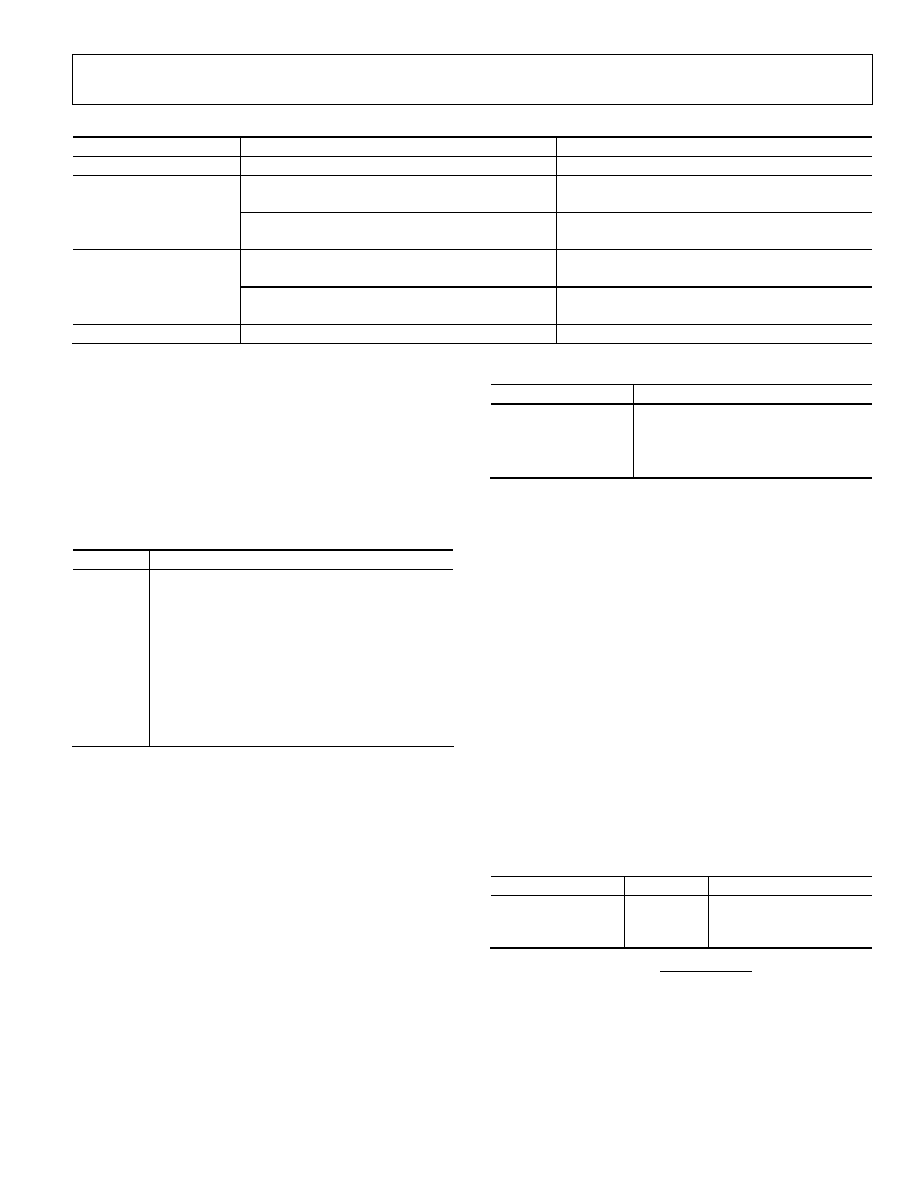
ADV7183A
Rev. A | Page 33 of 104
Table 64. SDP AGC Modes
Input Video Type
Luma Gain
Chroma Gain
Any
Manual gain luma.
Manual gain chroma.
Dependent on color burst amplitude.
Dependent on horizontal sync depth.
Taken from luma path.
Dependent on color burst amplitude.
CVBS
Peak White
Taken from luma path.
Dependent on color burst amplitude.
Dependent on horizontal sync depth.
Taken from luma path.
Dependent on color burst amplitude.
Y/C
Peak White.
Taken from luma path.
YPrPb
Dependent on horizontal sync depth.
Taken from luma path.
SDP Luma Gain
LAGC[2:0] Luma Automatic Gain Control (SDP), Address
0x30, [7:0]
The luma automatic gain control mode bits select the mode of
operation for the gain control in the luma path.
There are ADI internal parameters to customize the peak white
gain control. Contact ADI for more information.
Table 65. LAGC Function
LAGC[2:0] Description
000
Manual fixed gain (use LMG[11:0]).
001
AGC (blank level to sync tip). No override through
white peak.
010*
AGC (blank level to sync tip). Automatic override
through white peak.
011 Reserved.
100 Reserved.
101 Reserved.
110 Reserved.
111 Freeze
gain.
*Default value.
LAGT[1:0] Luma Automatic Gain Timing (SDP),
Address 0x2F, [7:6]
The luma automatic gain timing register allows the user to
influence the tracking speed of the luminance automatic gain
control. Please note that this register only has an effect if the
LAGC[2:0] register is set to 001, 010, 011, or 100 (automatic
gain control modes).
If peak white AGC is enabled and active (see the
STATUS_1[7:0] Address 0x10, [7:0] section), the actual gain
update speed is dictated by the peak white AGC loop and, as a
result, the LAGT settings have no effect. As soon as the part
leaves peak white AGC, LAGT becomes relevant again.
The update speed for the peak white algorithm can be
customized by the use of internal parameters. Please contact
ADI for more information.
Table 66. LAGT Function
LAGT[1:0] Description
00
Slow (TC = 2 sec)
01
Medium (TC = 1 sec)
10
Fast (TC = 0.2 sec)
11* Adaptive
*Default value.
LG[11:0] Luma Gain (SDP), Address 0x2F, [3:0];
Address 0x30, [7:0]; LMG[11:0] Luma Manual Gain (SDP),
Address 0x2F, [3:0]; Address 0x30, [7:0]
Luma gain [11:0] is a dual function register:
·
If written to, a desired manual luma gain can be
programmed. This gain becomes active if the LAGC[2:0]
mode is switched to manual fixed gain.
·
Equation 1 shows how to calculate a desired gain.
·
If read back, this register returns the current gain value.
Depending on the setting in the ALCM[2:0] bits, this is one
of the following values:
o
Luma manual gain value (ALCM[2:0] set to luma
manual gain mode)
o
Luma automatic gain value (ALCM[2:0] set to any of
the automatic modes)
Table 67. LG/LMG Function
LG[11:0]/LMG[11:0] Read/Write Description
LMG[11:0] = X
Write
Manual gain for luma
path.
LG[11:0]
Read
Actually used gain.
(
)
2
...
0
2048
4095
0
_
=
<
=
LG
Gain
Luma
Equation 1. SDP Luma Gain Formula
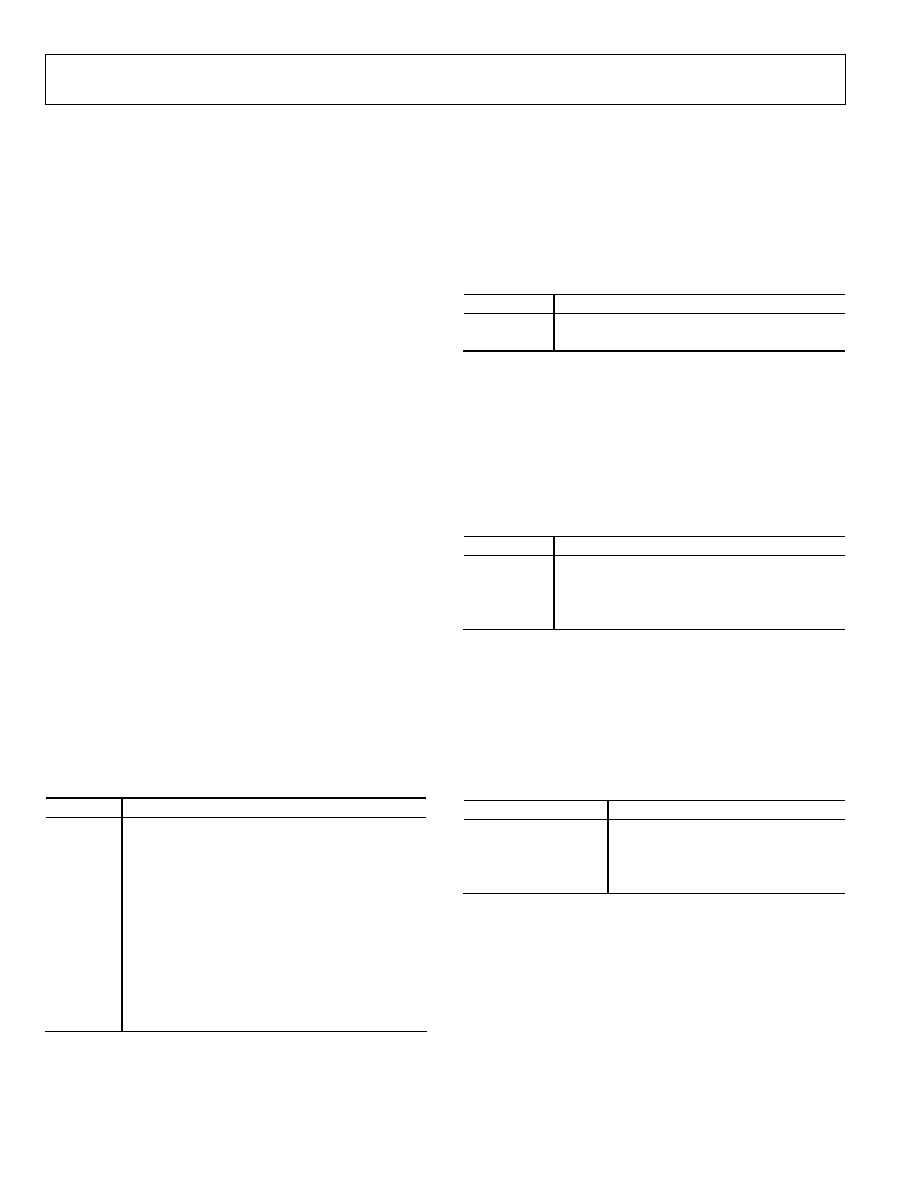
ADV7183A
Rev. A | Page 34 of 104
Example
Program the ADV7183A into manual fixed gain mode with a
desired gain of 0.89:
·
Use Equation 1 to convert the gain:
0.89 × 2048 = 1822.72
·
Truncate to integer value:
1822.72 = 1822
·
Convert to hexadecimal:
1822
d
= 0x71E
·
Split into two registers and program:
Luma Gain Control 1 [3:0] = 0x7
Luma Gain Control 2 [7:0] = 0x1E
·
Enable Manual Fixed Gain Mode:
Set LAGC[2:0] to 000
BETACAM Enable Betacam Levels (SDP), Address 0x01, [5]
If YPrPb data is routed through the SDP core, the automatic
gain control modes can target different video input levels, as
outlined in Table 72. Please note that the BETACAM bit is valid
only if the input mode is YPrPb (component) and if the data is
routed through the SDP core. The BETACAM bit basically sets
the target value for AGC operation.
A review of the following sections is useful:
·
INSEL[3:0] Input Selection, Address 0x00, [3:0] to find how
component video (YPrPb) can be routed through the SDP
core.
·
Video Standard Selection (SDP) to select the various
standards (e.g., with and without pedestal)
The automatic gain control (AGC) algorithms adjust the levels
based on the setting of the BETACAM bit(see Table 68.).
Table 68. BETACAM Function
BETACAM Description
0*
Assuming YPrPb is selected as input format.
Selecting PAL with pedestal selects MII.
Selecting PAL without pedestal selects SMPTE.
Selecting NTSC with pedestal selects MII.
Selecting NTSC without pedestal selects SMPTE.
1
Assuming YPrPb is selected as input format.
Selecting PAL with pedestal selects BETACAM.
Selecting PAL without pedestal selects BETACAM
variant.
Selecting NTSC with pedestal selects BETACAM.
Selecting NTSC without pedestal selects BETACAM
variant.
*Default value.
PW_UPD Peak White Update (SDP), Address 0x2B, [0]
The peak white and average video algorithms determine the
gain based on measurements taken from the active video. The
PW_UPD bit determines the rate of gain change. Please note
that the LAGC[2:0] must be set to the appropriate mode to
enable the peak white or average video mode in the first place.
For more information, refer to the LAGC[2:0] Luma Automatic
Gain Control (SDP), Address 0x30, [7:0] section.
Table 69. PW_UPD Function
PW_UPD Description
0
Update gain once per video line.
1
Update gain once per field.
*Default value.
SDP Chroma Gain
CAGC[1:0] Chroma Automatic Gain Control (SDP),
Address 0x2C, [1:0]
The two bits of Color Automatic Gain Control mode select the
basic mode of operation for automatic gain control in the
chroma path.
Table 70. CAGC Function
CAGC[1:0] Description
00
Manual fixed gain (use CMG[11:0]).
01
Use luma gain for chroma.
10*
Automatic gain (based on color burst).
11 Freeze
chroma
gain.
*Default value.
CAGT[1:0] Chroma Automatic Gain Timing (SDP),
Address 0x2D, [7:6]
The Chroma Automatic Gain Timing register allows the user to
influence the tracking speed of the chroma automatic gain
control. This register only has an effect if the CAGC[1:0]
register is set to 10 (automatic gain).
Table 71. CAGT Function
CAGT[1:0] Description
00
Slow (TC = 2 sec)
01
Medium (TC = 1 sec)
10
Fast (TC = 0.2 sec)
11* Adaptive
*Default value.
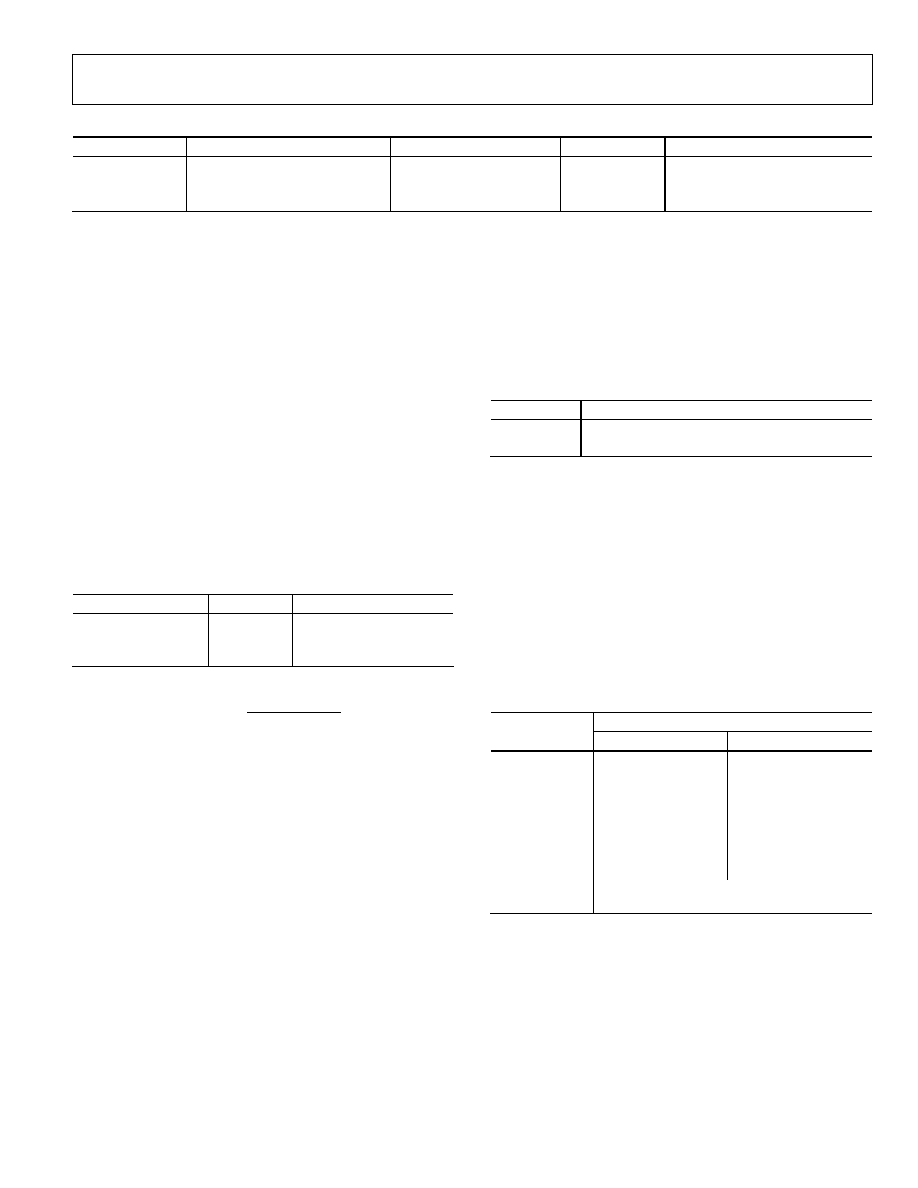
ADV7183A
Rev. A | Page 35 of 104
Table 72. Betacam Levels
Name
Betacam (mV)
Betacam Variant (mV)
SMPTE (mV)
MII (mV)
Y Range
0 to 714 (incl. 7.5% pedestal)
0 to 714
0 to 700
0 to 700 (incl. 7.5% pedestal)
Pb and Pr Range
467 to +467
505 to +505
350 to +350
324 to +324
Sync Depth
286
286
300
300
CG[11:0] Chroma Gain (SDP), Address 0x2D, [3:0];
Address 0x2E, [7:0] CMG[11:0] Chroma Manual Gain (SDP),
Address 0x2D, [3:0]; Address 0x2E, [7:0]
Chroma gain [11:0] is a dual function register:
·
If written to, a desired manual chroma gain can be
programmed. This gain becomes active if the CAGC[1:0]
mode is switched to manual fixed gain.
·
Refer to Equation 2 for calculating a desired gain.
·
If read back, this register returns the current gain value.
Depending on the setting in the CAGC[1:0] bits, this will
be one of the following values:
o
Chroma manual gain value (CAGC[1:0] set to chroma
manual gain mode).
o
Chroma automatic gain value (CAGC[1:0] set to any
of the automatic modes).
Table 73. CG/CMG Function
CG[11:0]/CMG[11:0] Read/Write Description
CMG[11:0] Write
Manual gain for chroma
path.
CG[11:0]
Read
Currently active gain.
(
)
4
...
0
1024
4095
0
_
=
<
=
CG
Gain
Chroma
Equation 2. SDP Chroma Gain Formula
Example
Freezing the automatic gain loop and reading back the
CG[11:0] register results in a value of
·
Convert the read back value to decimal:
0x47A = 1146
d
·
Apply Equation 2 to convert the readback value:
1146/1024 = 1.12
CKE Color Kill Enable (SDP), Address 0x2B, [6]
The Color Kill Enable bit allows the optional color kill function
to be switched on or off.
For QAM based video standards (PAL and NTSC) as well as FM
based systems (SECAM), the threshold for the color kill
decision is selectable via the CKILLTHR[2:0] bits.
If color kill is enabled, and if the color carrier of the incoming
video signal is less than the threshold for 128 consecutive video
lines, color processing is switched off (black and white output).
To switch the color processing back on, another 128 consecutive
lines with a color burst greater than the threshold are required.
The color kill option only works for input signals with a
modulated chroma part. For component input (YPrPb), there is
no color kill.
Table 74. CKE Function
CKE Description
0
Color kill disabled.
1*
Color kill enabled.
*Default value.
CKILLTHR[2:0] Color Kill Threshold (SDP),
Address 0x3D, [6:4]
The CKILLTHR[2:0] bits allow the user to select a threshold for
the color kill function. The threshold only applies to QAM
based (NTSC and PAL) or FM modulated (SECAM) video
standards.
To enable the color kill function, the CKE bit must be set. For
settings 000, 001, 010, and 011, chroma demodulation inside the
ADV7183A may not work satisfactorily for poor input video
signals.
Table 75. CKILLTHR Function
Description
CKILLTHR[2:0]
SECAM NTSC,
PAL
000
No color kill
Kill at < 0.5%
001
Kill at < 5%
Kill at < 1.5%
010
Kill at < 7%
Kill at < 2.5%
011
Kill at < 8%
Kill at < 4.0%
100*
Kill at < 9.5%
Kill at < 8.5%
101
Kill at < 15%
Kill at < 16.0%
110
Kill at < 32%
Kill at < 32.0%
111
Reserved for ADI internal use only. Do not
select.
*Default value.
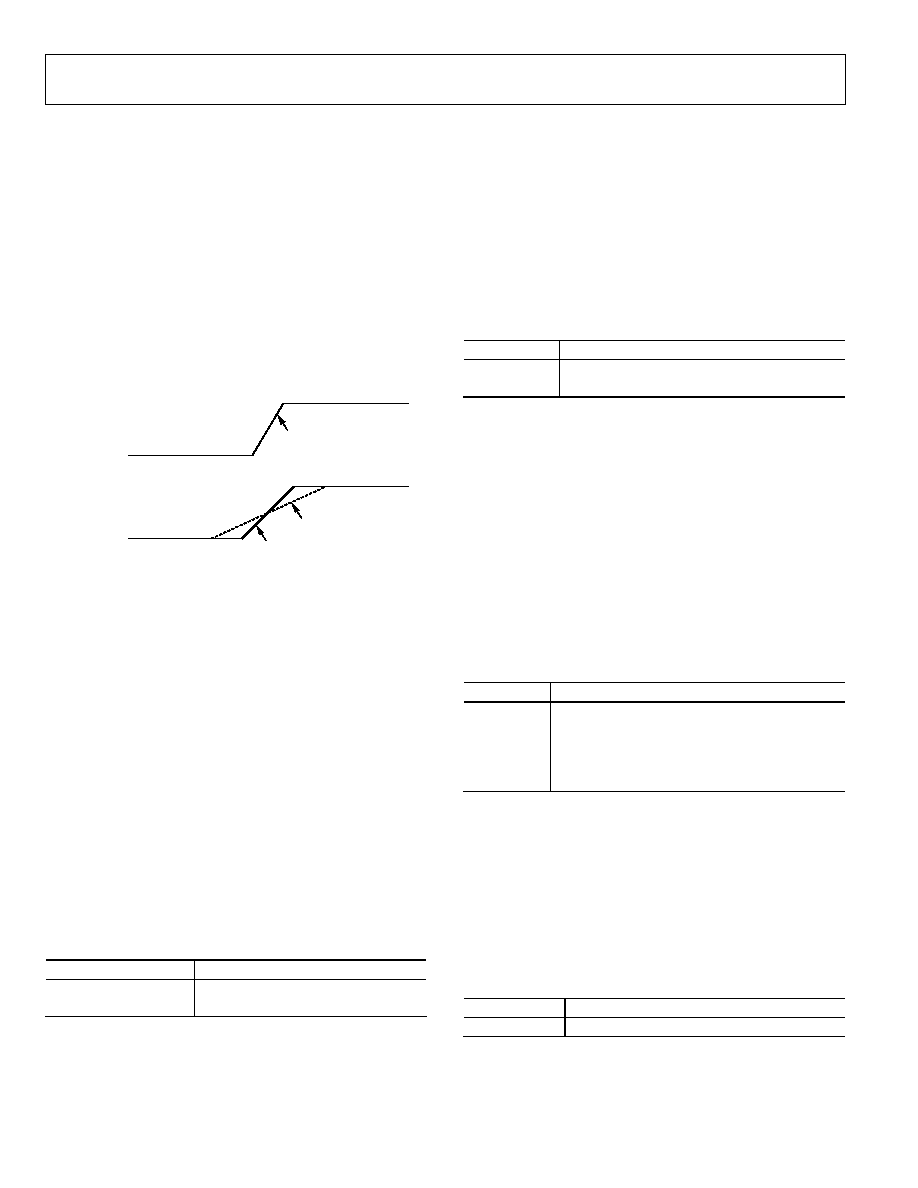
ADV7183A
Rev. A | Page 36 of 104
SDP CHROMA TRANSIENT IMPROVEMENT (CTI)
The signal bandwidth allocated for chroma is typically much
smaller than that of luminance. In the past, this was a valid way
to fit a color video signal into a given overall bandwidth because
the human eye is less sensitive to chrominance than to
luminance.
The uneven bandwidth, however, may lead to some visual
artifact when it comes to sharp color transitions. At the border
of two bars of color, both components (luma and chroma)
change at the same time (see Figure 18). Due to the higher
bandwidth, the signal transition of the luma component is
usually a lot sharper than that of the chroma component. The
color edge is not sharp but blurred, in the worst case, over
several pixels.
04819-0-018
LUMA
SIGNAL
DEMODULATED
CHROMA
SIGNAL
LUMA SIGNAL WITH A
TRANSITION, ACCOMPANIED
BY A CHROMA TRANSITION
ORIGINAL, "SLOW" CHROMA
TRANSITION PRIOR TO CTI
SHARPENED CHROMA
TRANSITION AT THE
OUTPUT OF CTI
Figure 18. CTI Luma/Chroma Transition
The chroma transient improvement block examines the input
video data. It detects transitions of chroma, and can be
programmed to "steepen" the chroma edges in an attempt to
artificially restore lost color bandwidth. The CTI block,
however, only operates on edges above a certain threshold to
ensure that noise is not emphasized. Care has also been taken to
ensure that edge ringing and undesirable saturation or hue
distortion are avoided.
Chroma transient improvements are needed primarily for
signals that experienced severe chroma bandwidth limitations.
For those types of signals, it is strongly recommended to enable
the CTI block via CTI_EN.
CTI_EN Chroma Transient Improvement Enable (SDP),
Address 0x4D, [0]
The CTI_EN bit enables the CTI function. If set to 0, the CTI
block is inactive and the chroma transients are left untouched.
Table 76. CTI_EN Function
CTI_EN Description
0* Disable
CTI.
1
Enable CTI block.
*Default value.
CTI_AB_EN Chroma Transient Improvement Alpha Blend
Enable (SDP), Address 0x4D, [1]
The CTI_AB_EN bit enables an alpha-blend function within
the CTI block. If set to 1, the alpha blender mixes the transient
improved chroma with the original signal. The sharpness of the
alpha blending can be configured via the CTI_AB[1:0] bits.
For the alpha blender to be active, the CTI block must be
enabled via the CTI_EN bit.
Table 77. CTI_AB_EN
CTI_AB_EN Description
0
Disable CTI alpha blender.
1*
Enable CTI alpha-blend mixing function.
*Default value.
CTI_AB[1:0] Chroma Transient Improvement Alpha Blend
(SDP), Address 0x4D, [3:2]
The CTI_AB[1:0] controls the behavior of alpha-blend circuitry
that mixes the sharpened chroma signal with the original one. It
thereby controls the visual impact of CTI on the output data.
For CTI_AB[1:0] to become effective, the CTI block must be
enabled via the CTI_EN bit, and the alpha blender must be
switched on via CTI_AB_EN.
Sharp blending maximizes the effect of CTI on the picture, but
may also increase the visual impact of small amplitude, high
frequency chroma noise.
Table 78. CTI_AB Function
CTI_AB[1:0] Description
00
Sharpest mixing between sharpened and original
chroma signal.
01 Sharp
mixing.
10 Smooth
mixing.
11*
Smoothest alpha blend function.
*Default value.
CTI_C_TH[7:0] CTI Chroma Threshold (SDP),
Address 0x4E, [7:0]
The CTI_C_TH[7:0] value is an unsigned, 8-bit number speci-
fying how big the amplitude step in a chroma transition has to
be in order to be steepened by the CTI block. Programming a
small value into this register causes even smaller edges to be
steepened by the CTI block. Making CTI_C_TH[7:0] a large
value causes the block to improve large transitions only.
Table 79. CTI_C_TH Function
CTI_C_TH[7:0] Description
0x08*
Threshold for chroma edges prior to CTI.
*Default value.
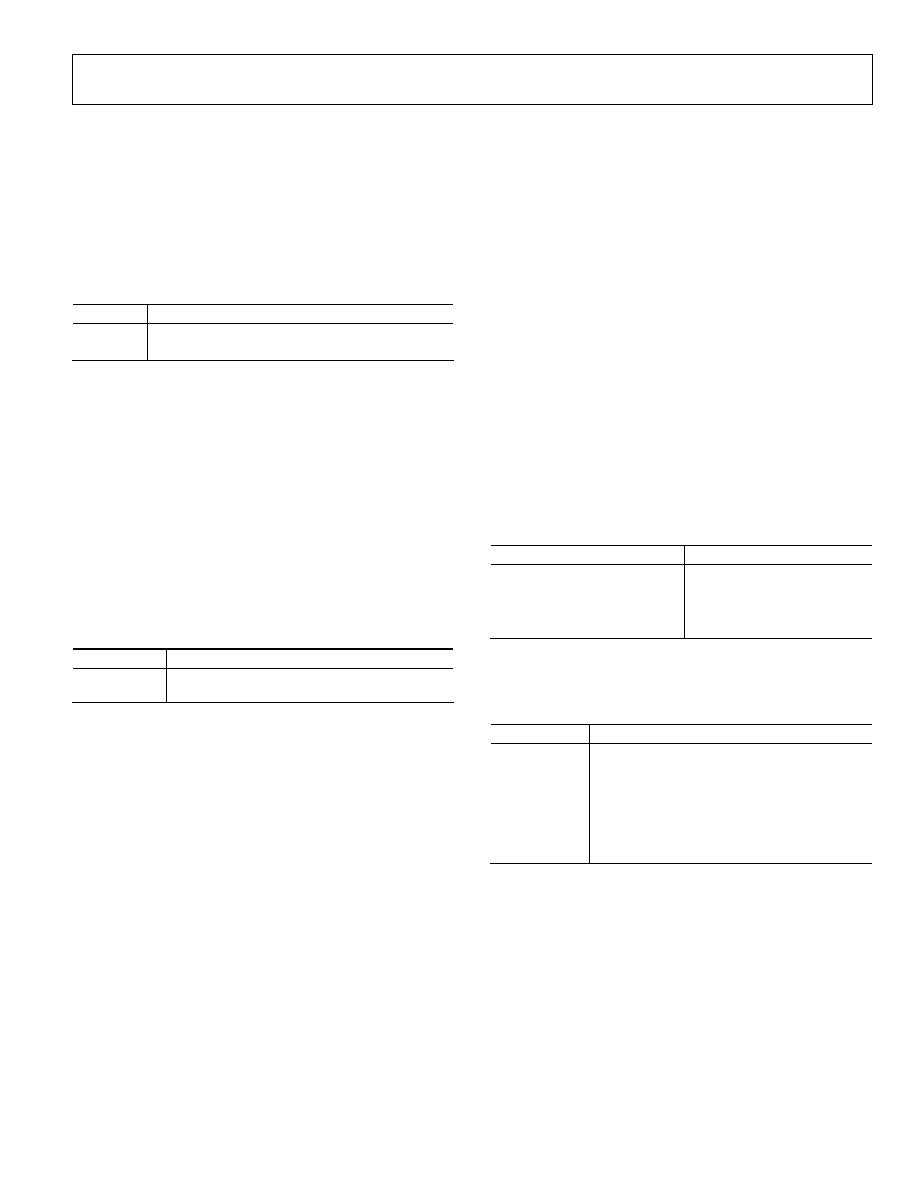
ADV7183A
Rev. A | Page 37 of 104
SDP DIGITAL NOISE REDUCTION (DNR)
Digital noise reduction is based on the assumption that high
frequency signals with low amplitude are probably noise, and
that their removal therefore improves picture quality.
DNR_EN Digital Noise Reduction Enable (SDP),
Address 0x4D, [5]
The DNR_EN bit enables the DNR block or bypasses it.
Table 80. DNR_EN Function
DNR_EN Description
0
Bypass DNR (disable).
1*
Enable digital noise reduction on the luma data.
DNR_TH[7:0] DNR Noise Threshold, Address 0x50, [7:0]
The DNR_TH[7:0] value is an unsigned 8-bit number used to
determine the maximum edge that will be interpreted as noise
and therefore blanked from the luma data. Programming a large
value into DNR_TH[7:0] causes the DNR block to interpret
even large transients as noise and remove them. The effect on
the video data will therefore be more visible.
Programming a small value causes only small transients to be
seen as noise and to be removed.
It should be noted that the recommended DNR_TH[7:0] setting
for A/V inputs is 0x04, and the recommended DNR_TH[7:0]
setting for tuner inputs is 0x0A.
Table 81. DNR_TH Function
DNR_TH[7:0] Description
0x08*
Threshold for maximum luma edges to be
interpreted as noise.
*Default value.
SDP COMB FILTERS
The comb filters of the ADV7183A have been greatly improved
to automatically handle video of all types, standards, and levels
of quality. Two user registers are available to customize comb
filter operation.
Depending on whichever video standard has been detected (by
autodetection) or selected (by manual programming), the
NTSC or PAL configuration registers are used. In addition to
the bits listed in this section, there are some further ADI
internal controls; please contact ADI for more information.
NTSC Comb Filter Settings
Used for NTSC-M/J CVBS inputs.
NSFSEL[1:0] Split Filter Selection NTSC (SDP),
Address 0x19, [3:2]
The NSFSEL[1:0] control selects how much of the overall signal
bandwidth is fed to the combs. A narrow split filter selection
gives better performance on diagonal lines, but leaves more dot
crawl in the final output image. The opposite is true for
selecting a wide bandwidth split filter.
Table 82.NSFSEL Function
NSFSEL[1:0] Description
00* Narrow
01 Medium
10
Medium
11 Wide
*Default value.
CTAPSN[1:0] Chroma Comb Taps NTSC (SDP),
Address 0x38, [7:6]
Table 83. CTAPSN Function
CTAPSN[1:0] Description
00
Do not use.
01
NTSC chroma comb adapts 3 lines (3 taps) to
2 lines (2 taps).
10*
NTSC chroma comb adapts 5 lines (5 taps) to
3 lines (3 taps).
11
NTSC chroma comb adapts 5 lines (5 taps) to
4 lines (4 taps).
*Default value.

ADV7183A
Rev. A | Page 38 of 104
CCMN[2:0] Chroma Comb Mode NTSC (SDP), Address 0x38, [5:3]
Table 84. CCMN Function
CCMN[2:0]
Description
Adaptive 3-line chroma comb for CTAPSN = 01.
Adaptive 4-line chroma comb for CTAPSN = 10.
0xx* Adaptive
comb
mode.
Adaptive 5-line chroma comb for CTAPSN = 11.
100
Disable chroma comb.
Fixed 2-line chroma comb for CTAPSN = 01.
Fixed 3-line chroma comb for CTAPSN = 10.
101
Fixed chroma comb (top lines of line memory).
Fixed 4-line chroma comb for CTAPSN = 11.
Fixed 3-line chroma comb for CTAPSN = 01.
Fixed 4-line chroma comb for CTAPSN = 10.
110
Fixed chroma comb (all lines of line memory).
Fixed 5-line chroma comb for CTAPSN = 11.
Fixed 2-line chroma comb for CTAPSN = 01.
Fixed 3-line chroma comb for CTAPSN = 10.
111
Fixed chroma comb (bottom lines of line memory).
Fixed 4-line chroma comb for CTAPSN = 11.
*Default value.
YCMN[2:0] Luma Comb Mode NTSC (SDP), Address 0x38, [2:0]
Table 85.YCMN Function
YCMN[2:0] Description
0xx*
Adaptive comb mode.
Adaptive 3-line (3 taps) luma comb.
100
Disable luma comb.
Use low-pass/notch filter; see the Y Shaping Filter section.
101
Fixed luma comb (top lines of line memory).
Fixed 2-line (2 taps) luma comb.
110
Fixed luma comb (all lines of line memory).
Fixed 3-line (3 taps) luma comb.
111
Fixed luma comb (bottom lines of line memory).
Fixed 2-line (2 taps) luma comb.
*Default value.
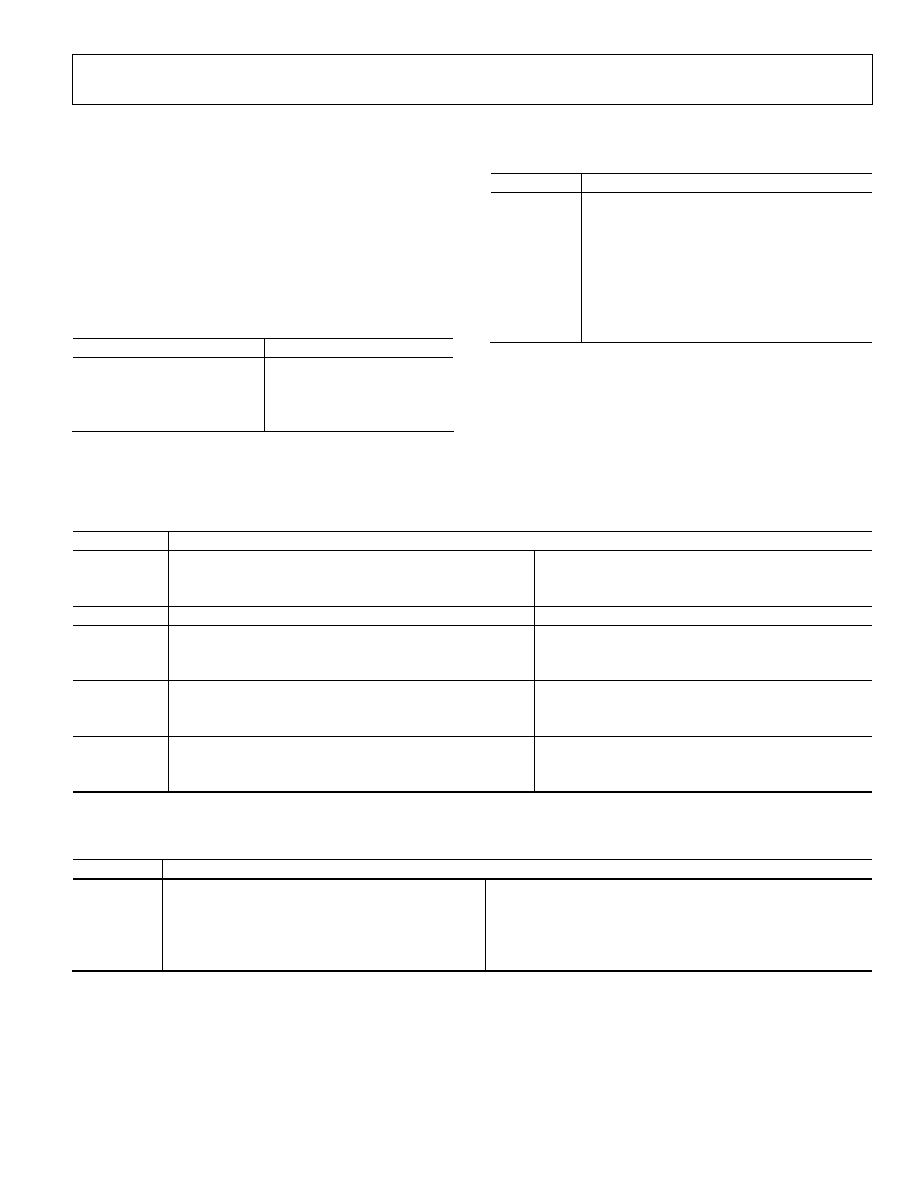
ADV7183A
Rev. A | Page 39 of 104
PAL Comb Filter Settings
Used for PAL-B/G/H/I/D, PAL-M, PAL-Combinational N, PAL-
60 and NTSC443 CVBS inputs.
PSFSEL[1:0] Split Filter Selection PAL (SDP),
Address 0x19, [1:0]
The NSFSEL[1:0] control selects how much of the overall signal
bandwidth is fed to the combs. A wide split filter selection
eliminates dot crawl, but shows imperfections on diagonal lines.
The opposite is true for selecting a narrow bandwidth split filter.
Table 86. PSFSEL Function
PSFSEL[1:0] Description
00
Narrow
01* Medium
10
Wide
11 Widest
*Default value.
CTAPSP[1:0] Chroma Comb Taps PAL (SDP),
Address 0x39, [7:6]
Table 87. CTAPSP Function
CTAPSP[1:0] Description
00
Do not use.
01
PAL chroma comb adapts 5 lines (3 taps) to
3 lines (2 taps); cancels cross luma only.
10
PAL chroma comb adapts 5 lines (5 taps) to
3 lines (3 taps); cancels cross luma and hue error
less well.
11*
PAL chroma comb adapts 5 lines (5 taps) to
4 lines (4 taps); cancels cross luma and hue error
well.
*Default value.
CCMP[2:0] Chroma Comb Mode PAL (SDP), Address 0x39, [5:3]
Table 88. CCMP Function
CCMP[2:0] Description
Adaptive 3-line chroma comb for CTAPSP = 01.
Adaptive 4-line chroma comb for CTAPSP = 10.
0xx*
Adaptive comb mode.
Adaptive 5-line chroma comb for CTAPSP = 11.
100
Disable chroma comb.
Fixed 2-line chroma comb for CTAPSP = 01.
Fixed 3-line chroma comb for CTAPSP = 10.
101
Fixed chroma comb (top lines of line memory).
Fixed 4-line chroma comb for CTAPSP = 11.
Fixed 3-line chroma comb for CTAPSP = 01.
Fixed 4-line chroma comb for CTAPSP = 10.
110
Fixed chroma comb (all lines of line memory).
Fixed 5-line chroma comb for CTAPSP = 11.
Fixed 2-line chroma comb for CTAPSP = 01.
Fixed 3-line chroma comb for CTAPSP = 10.
111
Fixed chroma comb (bottom lines of line memory).
Fixed 4-line chroma comb for CTAPSP = 11.
*Default value.
YCMP[2:0] Luma Comb Mode PAL (SDP), Address 0x39, [2:0]
Table 89. YCMP Function
YCMP[2:0] Description
0xx*
Adaptive comb mode .
Adaptive 5 lines (3 taps) luma comb.
100
Disable luma comb.
Use low-pass/notch filter; see the Y Shaping Filter section.
101
Fixed luma comb (top lines of line memory).
Fixed 3 lines (2 taps) luma comb.
110
Fixed luma comb (all lines of line memory).
Fixed 5 lines (3 taps) luma comb.
111
Fixed luma comb (bottom lines of line memory).
Fixed 3 lines (2 taps) luma comb.
*Default value.
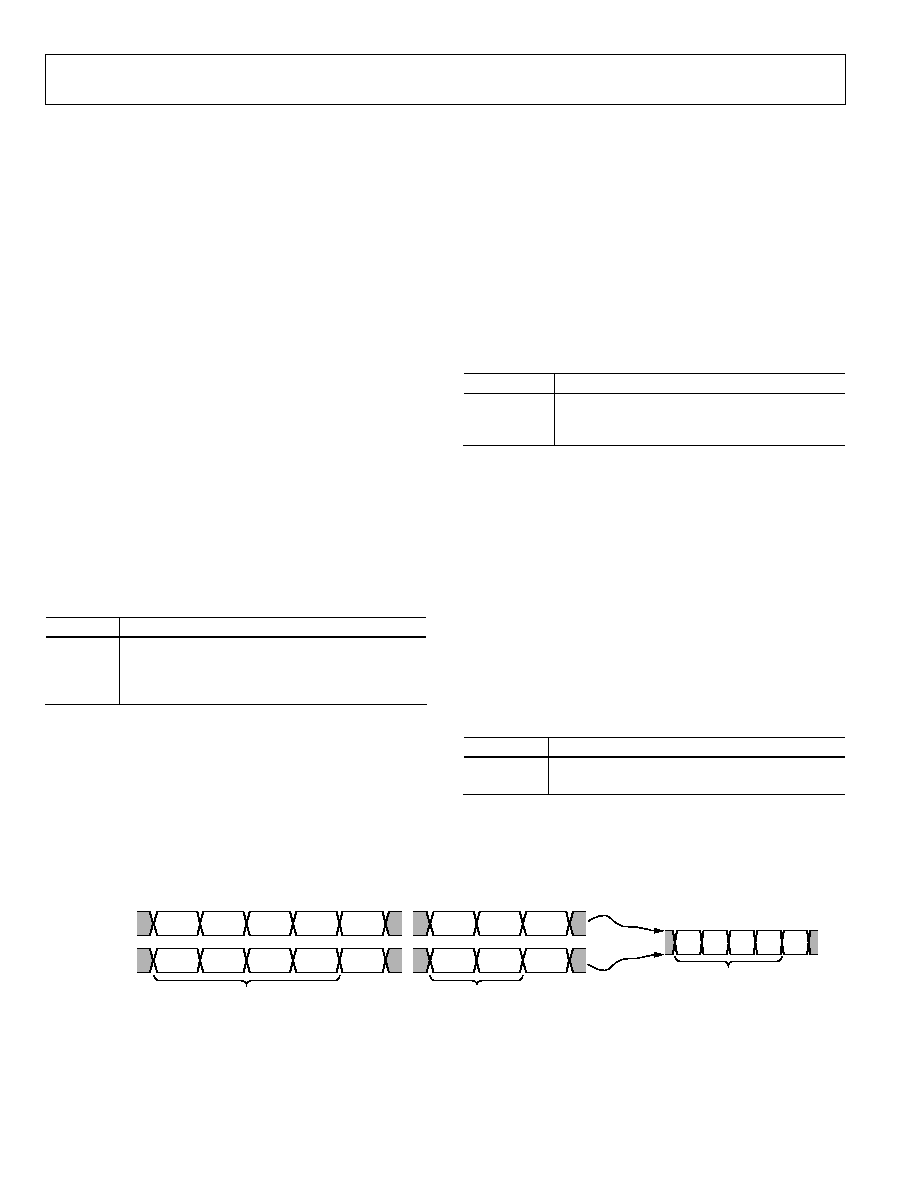
ADV7183A
Rev. A | Page 40 of 104
SDP AV CODE INSERTION AND CONTROLS
This section describes the I
2
C based controls that affect
·
Insertion of AV codes into the data stream
·
Data blanking during the vertical blank interval (VBI)
·
The range of data values permitted in the output data
stream
·
The relative delay of luma versus chroma signals
Please note that some of the decoded VBI data is being inserted
during the horizontal blanking interval. See the Gemstar Data
Recovery section for more information.
BT656-4 ITU Standard BT-R.656-4 Enable (SDP),
Address 0x04, [7]
The ITU has changed the position for toggling of the V bit
within the SAV EAV codes for NTSC between revisions 3 and 4.
The BT656-4 standard bit allows the user to select an output
mode that is compliant with either the previous or the new
standard. For further information, please review the standard at
http://www.itu.int.
Please note that the standard change affects NTSC only and has
no bearing on PAL.
Table 90. BT656-4 Function
BT656-4 Description
0*
BT656-3 Spec: V bit goes low at EAV of lines 10
and 273.
1
BT656-4 Spec: V bit goes low at EAV of lines 20
and 283.
*Default value.
SD_DUP_AV SDP Duplicate AV codes (SDP),
Address 0x03, [0]
Depending on the output interface width, it may be necessary to
duplicate the AV codes from the luma path into the chroma
path.
In an 8-bit-wide output interface (Cb/Y/Cr/Y interleaved data),
the AV codes are defined as FF/00/00/AV, with AV being the
transmitted word that contains information about H/V/F.
In this output interface mode, the following assignment takes
place: Cb = FF, Y = 00, Cr = 00, and Y = AV.
In a 16-bit output interface where Y and Cr/Cb are delivered via
separate data buses, the AV code is over the whole 16 bits. The
SD_DUP_AV bit allows the user to double up the AV codes, so
the full sequence can be found on the Y bus as well as
(= duplicated) the Cr/Cb bus. See Figure 19.
Table 91. SD_DUP_AV Function
SD_DUP_AV Description
0
AV codes in single fashion (to suit 8-bit
interleaved data output).
1
AV codes duplicated (for 16-bit interfaces).
*Default value.
VBI_EN Vertical Blanking Interval Data Enable (SDP),
Address 0x03, [7]
The VBI enable bit allows data such as intercast and closed
caption data to be passed through the luma channel of the SDP
decoder with only a minimal amount of filtering. All data for
lines 1 to 21 is passed through and available at the output port.
The ADV7183A does not blank the luma data, and
automatically switches all filters along the luma data path into
their widest bandwidth. For active video, the filter settings for
YSH and YPK are restored.
Refer to the BL_C_VBI Blank Chroma during VBI section for
information on the chroma path.
Table 92.
VBI_EN Description
0*
All video lines are filtered/scaled.
1
Only active video region is filtered/scaled.
*Default value.
04821-0-019
Y DATA BUS
00
AV
Y
FF
00
00
AV
Y
FF
Cr/Cb DATA BUS
00
00
AV
Cb
FF
00
Cb
AV CODE SECTION
AV CODE SECTION
FF
00
00
AV
Cb
AV CODE SECTION
Cb/Y/Cr/Y
INTERLEAVED
8-BIT INTERFACE
16-BIT INTERFACE
16-BIT INTERFACE
SD_DUP_AV = 1
SD_DUP_AV = 0
Figure 19. SDP AV Code Duplication Control
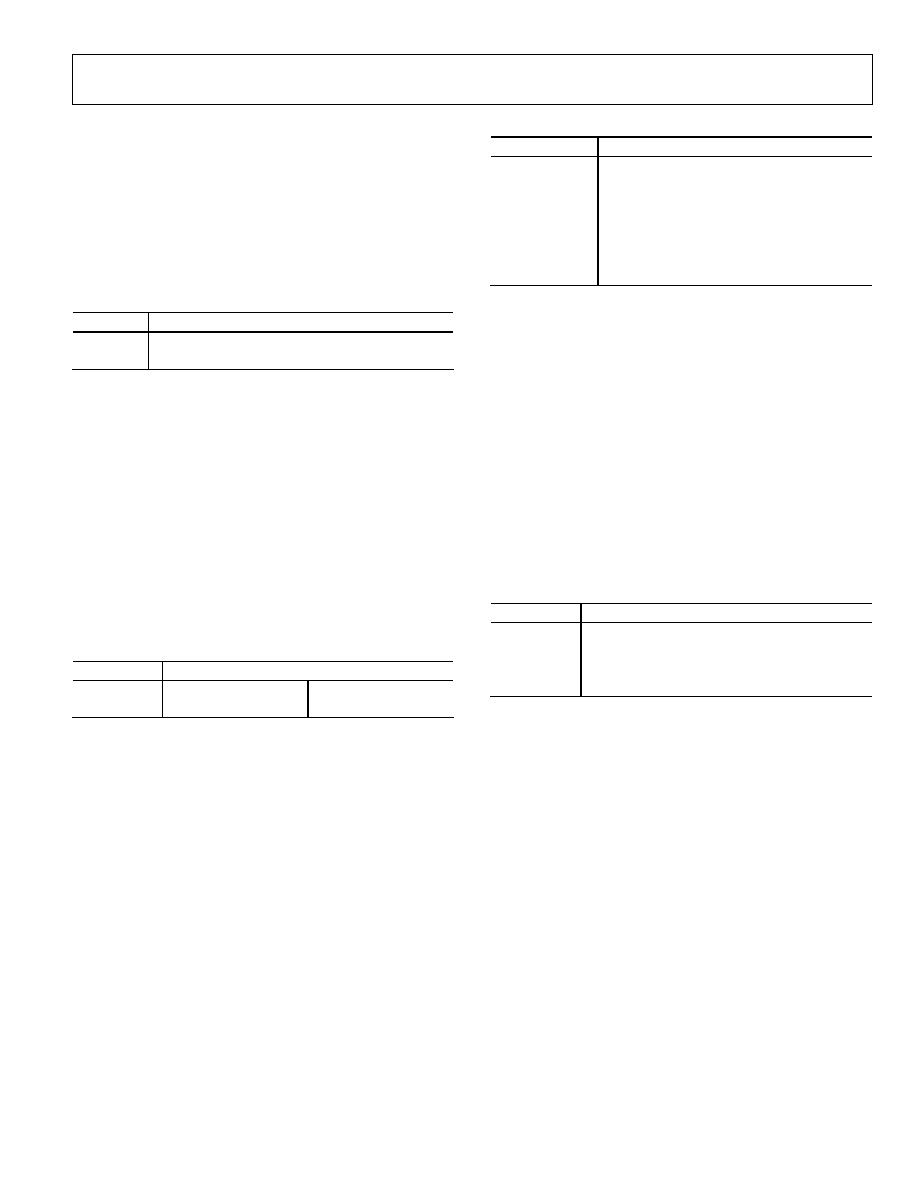
ADV7183A
Rev. A | Page 41 of 104
BL_C_VBI Blank Chroma during VBI (SDP),
Address 0x04, [2]
Setting BL_C_VBI high, the Cr and Cb values of all VBI lines
get blanked. This is done so any data that may come during VBI
is not decoded as color and output through Cr and Cb. As a
result, it should be possible to send VBI lines into the decoder,
then output them through an encoder again, undistorted.
Without this blanking, any wrongly decoded color gets encoded
by the video encoder; therefore, the VBI lines are distorted.
Table 93. BL_C_VBI Function
BL_C_VBI Description
0
Decode and output color during VBI.
1*
Blank Cr and Cb values during VBI (no color, 0x80).
*Default value.
RANGE Range Selection (SDP), Address 0x04, [0]
AV codes (as per ITU-R BT-656, formerly known as CCIR-656)
consist of a fixed header made up of 0xFF and 0x00 values.
These two values are reserved and therefore are not to be used
for active video. Additionally, the ITU also specifies that the
nominal range for video should be restricted to values between
16 and 235 for luma and 16 to 240 for chroma.
The RANGE bit allows the user to limit the range of values
output by the ADV7183A to the recommended value range. In
any case, it is ensured that the reserved values of 255
d
(0xFF)
and 00
d
(0x00) are not presented on the output pins unless they
are part of an AV code header.
Table 94. RANGE Function
RANGE Description
0
16 Y 235
16 C/P 240
1*
1 Y 254
1 C/P 254
*Default value.
AUTO_PDC_EN Automatic Programmed Delay Control
(SDP), Address 0x27, [6]
Enabling the AUTO_PDC_EN function activates a function
within the ADV7183A that automatically programs the
LTA[1:0] and CTA[2:0] to have the chroma and luma data
match delays for all modes of operation. If set, manual registers
LTA[1:0] and CTA[2:0] are not used by the SDP. If the
automatic mode is disabled (via setting the AUTO_PDC_EN bit
to 0), the values programmed into LTA[1:0] and CTA[2:0]
registers take effect.
Table 95. AUTO_PDC_EN Function
AUTO_PDC_EN Description
0
Use LTA[1:0] and CTA[2:0] values for delaying
luma and chroma samples. Refer to the
LTA[1:0] Luma Timing Adjust (SDP), Address
0x27, [1:0] and CTA[2:0] Chroma Timing
Adjust (SDP), Address 0x27, [5:3] sections.
1*
The ADV7183A automatically determines the
LTA and CTA values to have luma and chroma
aligned at the output.
*Default value.
LTA[1:0] Luma Timing Adjust (SDP), Address 0x27, [1:0]
The Luma Timing Adjust register allows the user to specify a
timing difference between chroma and luma samples.
Please note the following:
·
There is a certain functionality overlap with the CTA[2:0]
register.
·
For manual programming, use the following defaults:
o
CVBS input LTA[1:0] = 00.
o
YC input LTA[1:0] = 01.
o
YPrPb input LTA[1:0] =01.
Table 96. LTA Function
LTA[1:0] Description
00* No
delay.
01
Luma 1 clk (37 ns) delayed.
10
Luma 2clk (74 ns) early.
11
Luma 1 clk (37 ns) early.
*Default value.

ADV7183A
Rev. A | Page 42 of 104
CTA[2:0] Chroma Timing Adjust (SDP), Address 0x27, [5:3]
The Chroma Timing Adjust register allows the user to specify a
timing difference between chroma and luma samples. This may
be used to compensate for external filter group delay differences
in the luma versus chroma path, and to allow for a different
number of pipeline delays while processing the video down-
stream. Please review this functionality together with the
LTA[1:0] register.
Note that the chroma can only be delayed/advanced in chroma
pixel steps. One chroma pixel step is equal to two luma pixels.
The programmable delay occurs after demodulation, where one
can no longer delay by luma pixel steps.
For manual programming use the following defaults:
·
CVBS input CTA[2:0] = 011.
·
YC input CTA[2:0] = 101.
·
YPrPb input CTA[2:0] =110.
Table 97. CTA Function
CTA[2:0] Description
000
Not used.
001
Chroma + 2 chroma pixel (early).
010
Chroma + 1 chroma pixel (early).
011* No
delay.
100
Chroma 1 chroma pixel (late).
101
Chroma 2 chroma pixel (late).
110
Chroma 3 chroma pixel (late).
111 Not
used.
*Default value.
SDP SYNCHRONIZATION OUTPUT SIGNALS
HS Configuration
The following controls allow the user to configure the behavior
of the HS output pin only:
·
Beginning of HS signal via HSB[10:0]
·
End of HS signal via HSE[10:0]
·
Polarity of HS using PHS
HSB[10:0] HS Begin, Address 0x34, [6:4], Address 0x35, [7:0]
The HS Begin and HS End registers allow the user to freely
position the HS output (pin) within the video line. The values in
HSB[10:0] and HSE[10:0] are measured in pixel units from the
falling edge of HS. Using both values, the user can program
both the position and length of the HS output signal.
The position of this edge is controlled by placing a binary
number into HSB[10:0]. The number applied offsets the edge
with respect to an internal counter that is reset to 0 immediately
after EAV code FF,00,00,XY (see Figure 20). HSB is set to
00000000010b, which is 2 LLC1 clock cycles from count[0].
Table 98. HSB Function
HSB[10:0] Description
0x002
The HS pulse starts after the HSB[10:0] pixel after
the falling edge of HS.
*Default value.
HSE[10:0] HS End, Address 0x34, [2:0], Address 0x36, [7:0]
The HS Begin and HS End registers allow the user to freely
position the HS output (pin) within the video line. The values in
HSB[10:0] and HSE[10:0] are measured in pixel units from the
falling edge of HS. Using both values, the user can program
both the position and length of the HS output signal.
The position of this edge is controlled by placing a binary
number into HSE[10:0]. The number applied offsets the edge
with respect to an internal counter that is reset to 0 immediately
after EAV code FF,00,00,XY (see Figure 20). HSE is set to
00000000000b, which is 0 LLC1 clock cycles from count[0].
Table 99. HSE Function
HSE[9:0] Description
000*
HS pulse ends after HSE[10:0] pixel after falling edge
of HS.
*Default value.
Example
1.
To shift the HS towards active video by 20 LLC1s, add 20
LLC1s to both HSB and HSE. i.e., HSB[10:0] =
[00000010110], HSE[10:0] = [00000010100]
2.
To shift the HS away from active video by 20 LLC1s, add
1696
11
LLC1s to both HSB and HSE (for NTSC).i.e.,
HSB[10:0] = [11000000100], HSE[10:0] = [11000000110]
To move 20 LLC1s away from active video is equal to
subtracting 20 from 1716 and adding the result in binary to
both HSB[10:0] and HSE[10:0].
PHS Polarity HS (SDP), Address 0x37, [7]
The polarity of the HS pin as it comes from the SDP block can
be inverted using the PHS bit.
Table 100. PHS Function
PHS Description
0*
HS active high.
1
HS active low.
11
1696 is derived from the NTSC total number of pixels = 1716
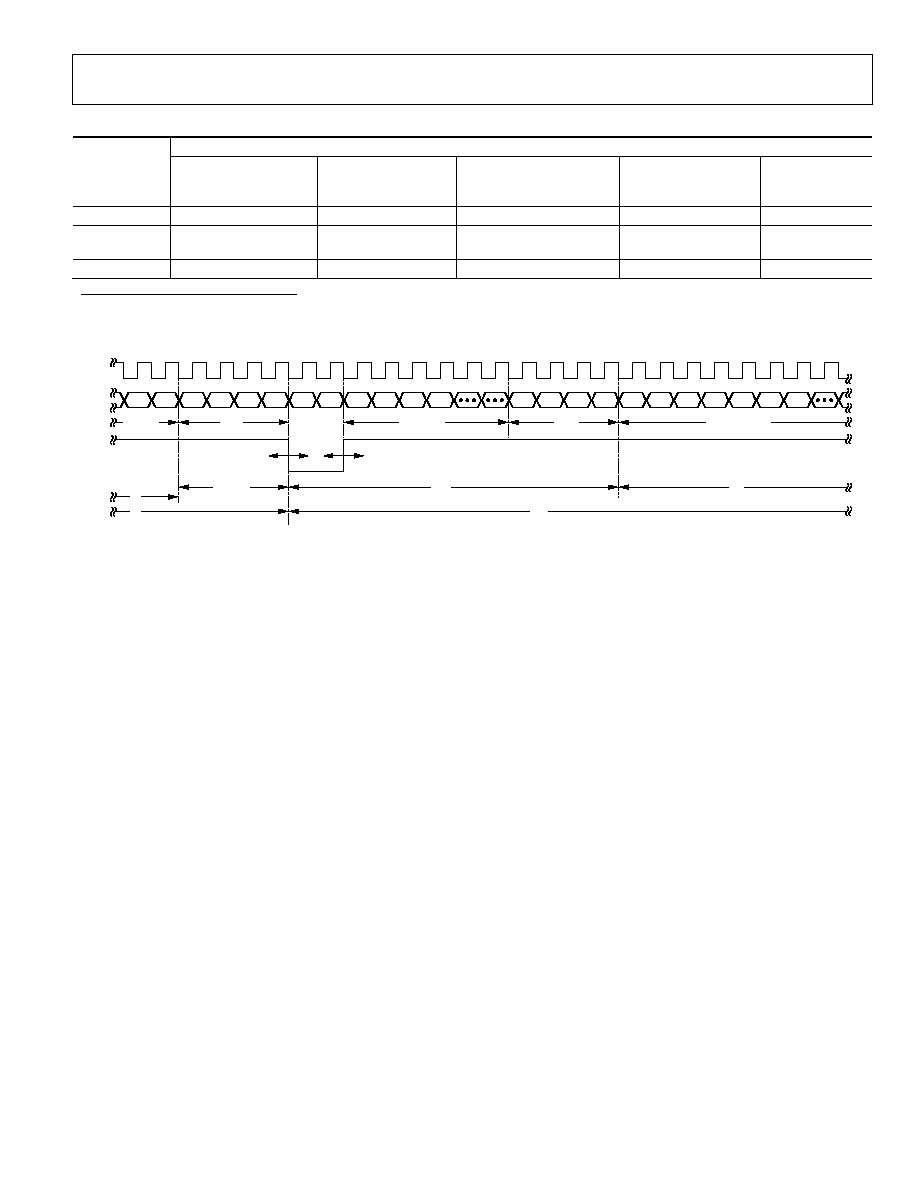
ADV7183A
Rev. A | Page 43 of 104
Table 101. HS Timing Parameters (see Figure 20)
Characteristic
Standard
HS Begin Adjust
(HSB[10:0])
1
HS End Adjust
(HSE[10:0])
1
HS to Active Video
(LLC1 Clock Cycles)
(C in Figure 20)
1
Active Video
Samples/Line
(D in Figure 20)
Total LLC1
Clock Cycles
(E in Figure 20)
NTSC
00000000010b
00000000000b
272
720Y + 720C = 1440
1716
NTSC Square
Pixel
00000000010b
00000000000b
276
640Y + 640C = 1280
1560
PAL
00000000010b
00000000000b
284
720Y + 720C = 1440
1728
1
Default.
04819-0-020
E
ACTIVE
VIDEO
LLC1
PIXEL
BUS
HS
Cr
Y
FF
00
00
XY
80
10
80
10
80
10
FF
00
00
XY
Cb
Y
Cr
Y
Cb
Y
Cr
4 LLC1
D
HSB[10:0]
HSE[10:0]
C
E
D
SAV
ACTIVE VIDEO
H BLANK
EAV
Figure 20. HS Timing (SDP)

ADV7183A
Rev. A | Page 44 of 104
VS and FIELD Configuration
The following controls allow the user to configure the behavior
of the VS and FIELD output pins, as well as the generation of
embedded AV codes:
·
ADV encoder compatible signals via NEWAVMODE
·
PVS, PF
·
HVSTIM
·
VSBHO, VSBHE
·
VSEHO, VSEHE
·
For NTSC control:
o
NVBEGDELO, NVBEGDELE, NVBEGSIGN,
NVBEG[4:0]
o
NVENDDELO, NVENDDELE, NVENDSIGN,
NVEND[4:0]
o
NFTOGDELO, NFTOGDELE, NFTOGSIGN,
NFTOG[4:0]
·
For PAL control:
o
PVBEGDELO, PVBEGDELE, PVBEGSIGN,
PVBEG[4:0]
o
PVENDDELO, PVENDDELE, PVENDSIGN,
PVEND[4:0]
o
PFTOGDELO, PFTOGDELE, PFTOGSIGN,
PFTOG[4:0]
NEWAVMODE New AV Mode, Address 0x31, [4]
Table 102. NEWAVMODE Function
NEWAVMODE Description
0
EAV/SAV codes generated to suit ADI
encoders. No adjustments possible.
1*
Enable Manual Position of VSYNC, Field, and
AV codes using 0x34 to 0x37 and 0xE5 to 0xEA.
Default register settings are CCIR656
compliant; see Figure 21 for NTSC and
Figure 26 for PAL. For recommended manual
user settings, see Table 110 and Figure 22 for
NTSC; see Table 123 and Figure 27 for PAL.
*Default value.
HVSTIM Horizontal VS Timing (SDP), Address 0x31, [3]
The HVSTIM bit allows the user to select where the VS signal is
being asserted within a line of video. Some interface circuitry
may require VS to go low while HS is low.
Table 103. HVSTIM Function
HVSTIM Description
0*
Start of line relative to HSE.
1
Start of line relative to HSB.
*Default value.
VSBHO VS Begin Horizontal Position Odd (SDP),
Address 0x32, [7]
The VSBHO and VSBHE bits select the position within a line at
which the VS pin (not the bit in the AV code) goes active. Some
follow-on chips require the VS pin to only change state when
HS is high/low.
Table 104. VSBHO Function
VSBHO Description
0*
VS pin goes high at the middle of a line of video
(odd field).
1
VS pin changes state at the start of a line (odd
field).
*Default value.
VSBHE VS Begin Horizontal Position Even (SDP),
Address 0x32, [6]
The VSBHO and VSBHE bits select the position within a line at
which the VS pin (not the bit in the AV code) goes active. Some
follow-on chips require the VS pin to only change state when
HS is high/low.
Table 105. VSBHE Function
VSBHE Description
0*
VS pin goes high at the middle of a line of video
(even field).
1
VS pin changes state at the start of a line (even field).
*Default value.
VSEHO VS End Horizontal Position Odd (SDP),
Address 0x33, [7]
The VSEHO and VSEHE bits select the position within a line at
which the VS pin (not the bit in the AV code) goes active. Some
follow-on chips require the VS pin to only change state when
HS is high/low.
Table 106. VSEHO Function
VSEHO Description
0*
VS pin goes low (inactive) at the middle of a line of
video (odd field).
1
VS pin changes state at the start of a line (odd field).
*Default value.
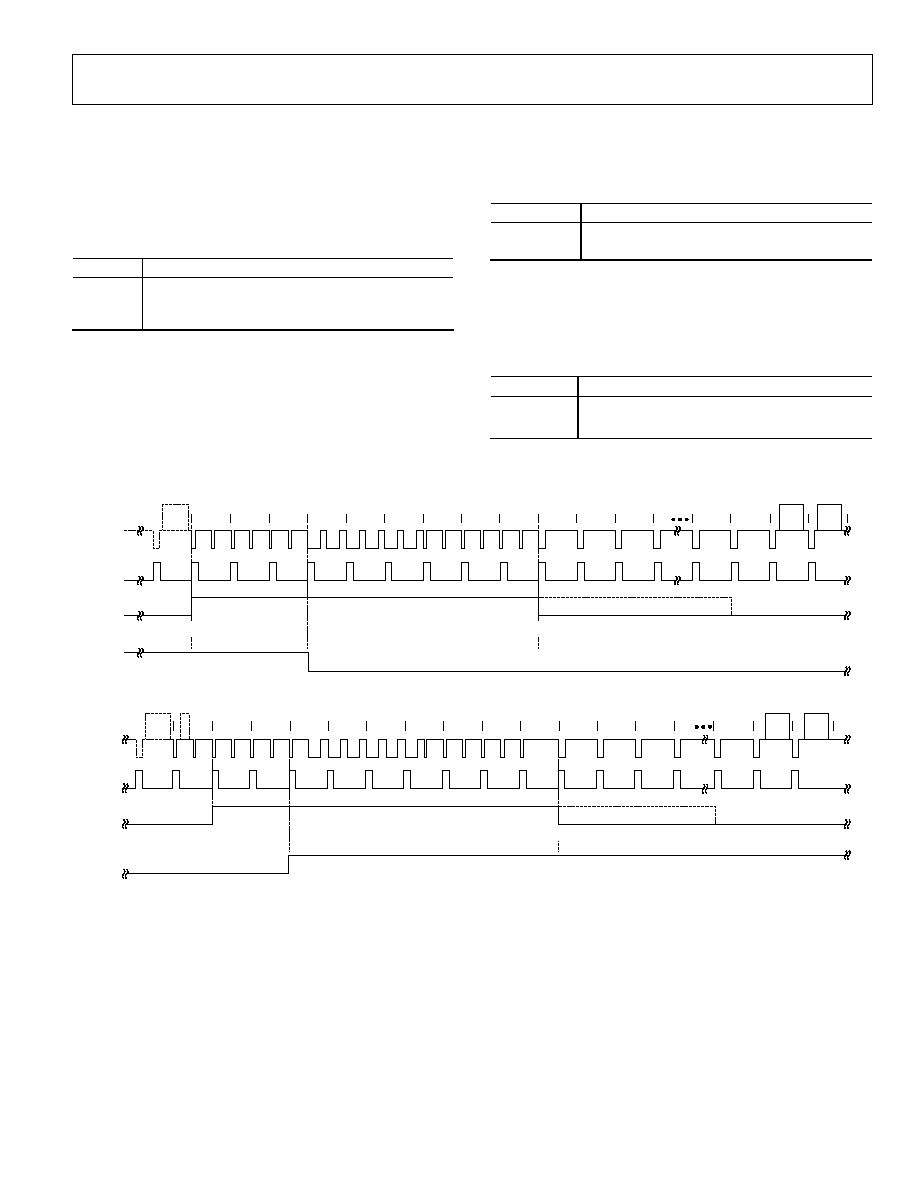
ADV7183A
Rev. A | Page 45 of 104
VSEHE VS End Horizontal Position Even (SDP),
Address 0x33, [6]
The VSEHO and VSEHE bits select the position within a line at
which the VS pin (not the bit in the AV code) goes active. Some
follow-on chips require the VS pin to only change state when
HS is high/low.
Table 107. VSEHE Function
VSEHE Description
0*
VS pin goes low (inactive) at the middle of a line of
video (even field).
1
VS pin changes state at the start of a line (even field).
*Default value.
PVS Polarity VS (SDP), Address 0x37, [5]
The polarity of the VS pin as it comes from the SDP block can
be inverted using the PVS bit.
Table 108. PVS Function
PVS Description
0*
VS active high.
1
VS active low.
*Default value.
PF Polarity FIELD (SDP), Address 0x37, [3]
The polarity of the FIELD pin as it comes from the SDP block
can be inverted using the PF bit.
Table 109. PF Function
PF Description
0*
FIELD active high.
1
FIELD active low.
*Default value.
04819-0-021
OUTPUT
VIDEO
FIELD 1
FIELD 2
H
V
F
OUTPUT
VIDEO
H
V
F
525
1
2
3
4
5
6
7
8
9
10
11
12
13
19
20
21
22
NVBEG[4:0] = 5h
NVBEG[4:0] = 5h
NVEND[4:0] = 4h
NVEND[4:0] = 4h
NFTOG[4:0] = 3h
NFTOG[4:0] = 3h
*BT.656-4
REG 04h. BIT 7 = 1
*BT.656-4
REG 04h. BIT 7 = 1
*APPLIES IF NEMAVMODE = 0
MUST BE MANUALLY SHIFTED IF NEWAVMODE = 1.
262
263
264
265
266
267
268
269
270
271
272
273
274
275
276
283
284
285
Figure 21. NTSC Default (BT.656). The polarity of H, V, and F is embedded in the data.

ADV7183A
Rev. A | Page 46 of 104
NVBEG[4:0] = 0h
NVEND[4:0] = 3h
04819-0-022
FIELD 1
OUTPUT
VIDEO
FIELD
OUTPUT
HS
OUTPUT
NFTOG[4:0] = 5h
VS
OUTPUT
525
1
2
3
4
5
6
7
8
9
10
11
12
13
14
15
21
22
FIELD 2
OUTPUT
VIDEO
FIELD
OUTPUT
HS
OUTPUT
VS
OUTPUT
262
263
264
265
266
267
268
269
270
271
272
273
274
275
276
277
284
285
NVBEG[4:0] = 0h
NVEND[4:0] = 3h
NFTOG[4:0] = 5h
Figure 22. NTSC Typical VSync/Field Positions Using Register Writes in Table 110
Table 110. Recommended User Settings for NTSC (See Figure 22)
Register Register
Name
Write
0x31
VSync Field Control 1
0x12
0x32
VSync Field Control 2
0x81
0x33
VSync Field Control 3
0x84
0x37 Polarity
0x29
0xE5 NTSV_V_Bit_Beg
0x0
0xE6 NTSC_V_Bit_End
0x3
0xE7 NTSC_F_Bit_Tog
0x85
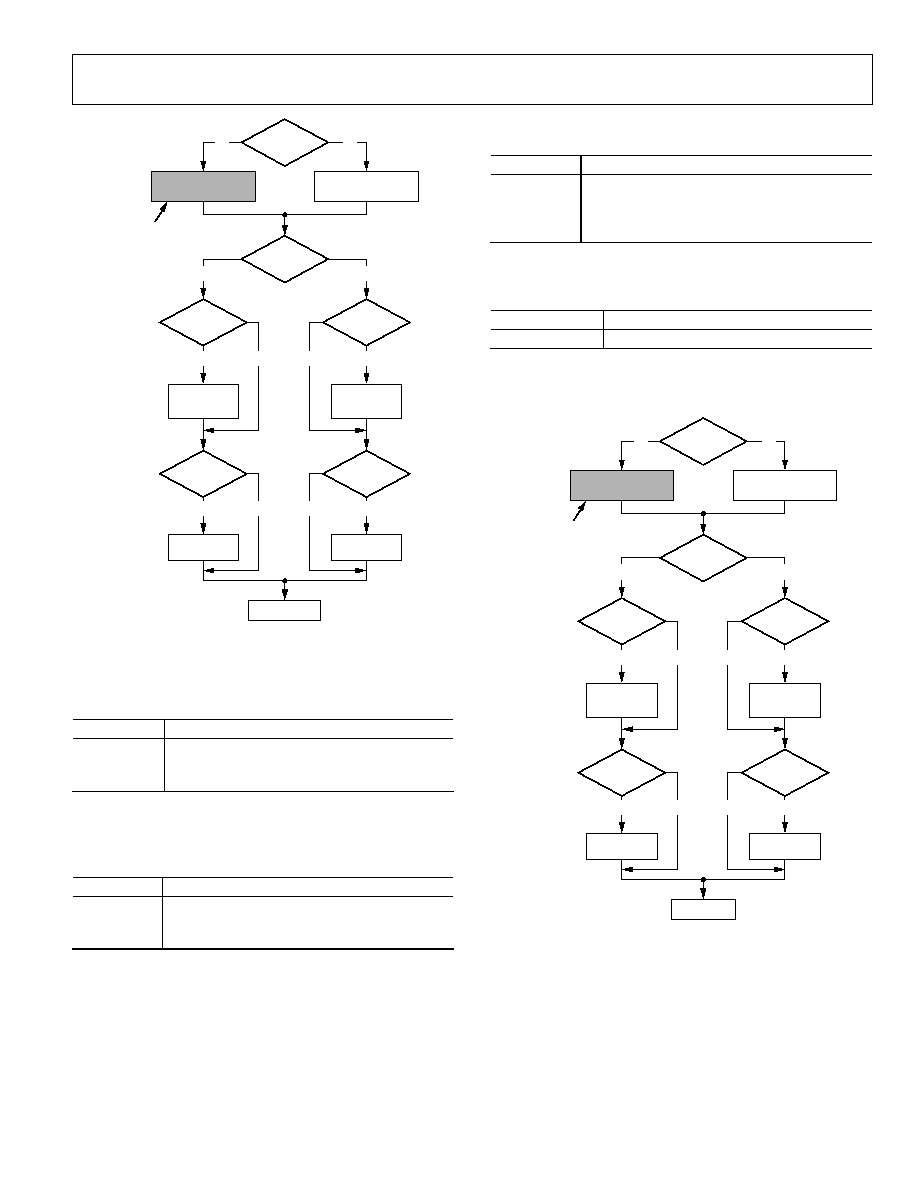
ADV7183A
Rev. A | Page 47 of 104
04819-0-023
ADVANCE BEGIN OF
VSYNC BY NVBEG[4:0]
DELAY BEGIN OF
VSYNC BY NVBEG[4:0]
VSYNC BEGIN
NVBEGSIGN
ODD FIELD?
0
1
NO
YES
NVBEGDELO
VSBHO
ADDITIONAL
DELAY BY
1 LINE
ADVANCE BY
0.5 LINE
1
0
1
0
NVBEGDELE
VSBHE
ADDITIONAL
DELAY BY
1 LINE
ADVANCE BY
0.5 LINE
1
0
1
0
NOT VALID FOR USER
PROGRAMMING
Figure 23. NTSC VSync Begin
NVBEGDELO NTSC VSync Begin Delay on Odd Field,
Address 0xE5, [7]
Table 111. NVBEGDELO Function
NVBEGDELO Description
0* No
Delay.
1
Delay VSync going high on an odd field by a line
relative to NVBEG.
*Default value.
NVBEGDELE NTSC Vsync Begin Delay on Even Field,
Address 0xE5, [6]
Table 112. NVBEGDELE Function
NVBEGDELE Description
0* No
Delay.
1
Delay VSync going high on an even field by a
line relative to NVBEG.
*Default value.
NVBEGSIGN NTSC VSync Begin Sign, Address 0xE5, [5]
Table 113. NVBEGSIGN Function
NVBEGSIGN Description
0
Delay start of VSync. Set for user manual
programming.
1*
Advance start of VSync. Not recommended for
user programming.
*Default value.
NVBEG[4:0] NTSC VSync Begin, Address 0xE5, [4:0]
Table 114. NVBEG Function
NVBEG Description
00101*
NTSC VSync begin position.
*Default value.
Note: For all NTSC/PAL VSync timing controls, both the V bit
in the AV code and the VSync on the VS pin are modified.
04819-0-024
ADVANCE END OF
VSYNC BY NVEND[4:0]
DELAY END OF VSYNC
BY NVEND[4:0]
VSYNC END
NVENDSIGN
ODD FIELD?
0
1
NO
YES
NVENDDELO
VSEHO
ADDITIONAL
DELAY BY
1 LINE
ADVANCE BY
0.5 LINE
1
0
1
0
NVENDDELE
VSEHE
ADDITIONAL
DELAY BY
1 LINE
ADVANCE BY
0.5 LINE
1
0
1
0
NOT VALID FOR USER
PROGRAMMING
Figure 24. NTSC VSync End
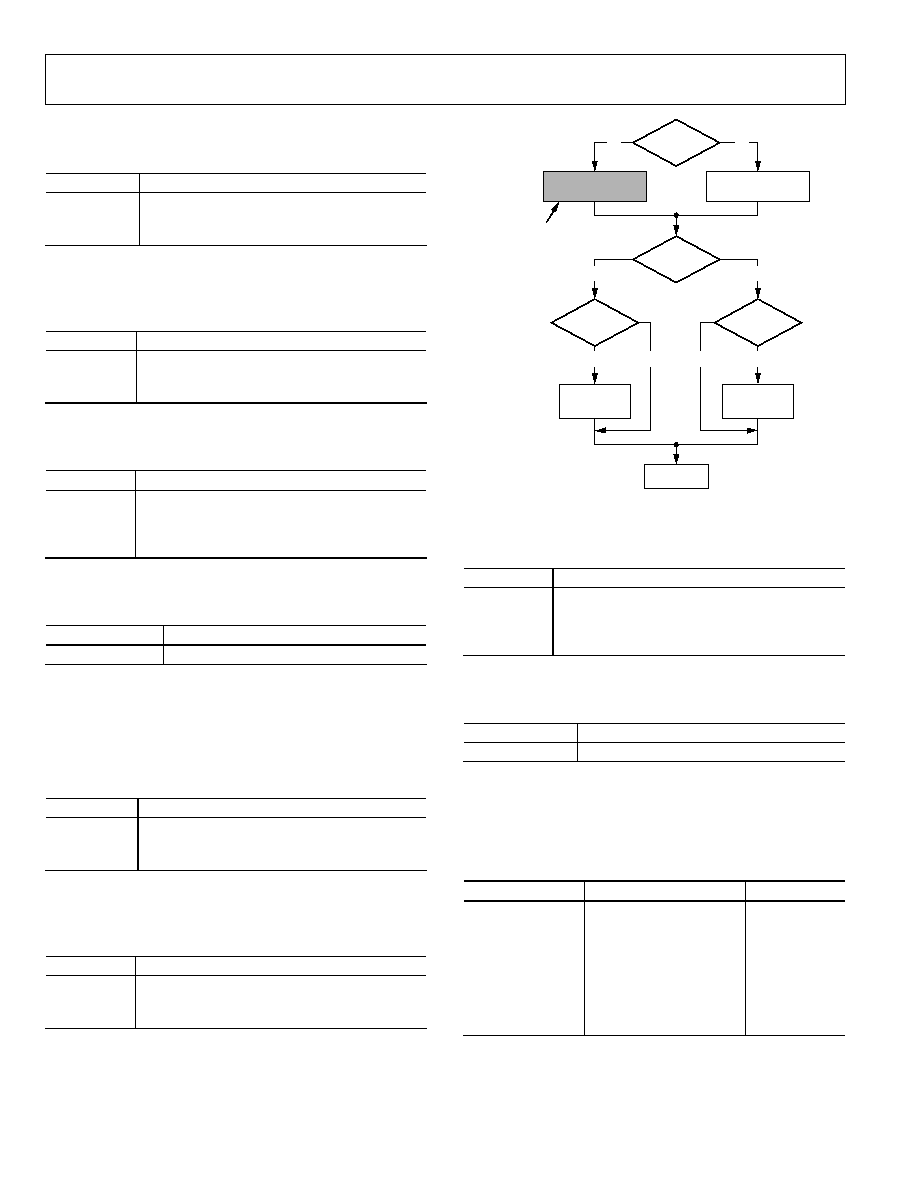
ADV7183A
Rev. A | Page 48 of 104
NVENDDELO NTSC VSync End Delay on Odd Field,
Address 0xE6, [7]
Table 115. NVENDDELO Function
NVENDDELO Description
0* No
Delay.
1
Delay VSync going low on an odd field by a line
relative to NVEND.
*Default value.
NVENDDELE NTSC VSync End Delay on Even Field,
Address 0xE6, [6]
Table 116. NVENDDELE Function
NVENDDELE Description
0* No
Delay.
1
Delay VSync going low on an even field by a line
relative to NVEND
*Default value.
NVENDSIGN NTSC VSync End Sign, Address 0xE6, [5]
Table 117. NVENDSIGN Function
NVENDSIGN Description
0*
Delay start of VSync. Set for user manual
programming.
1
Advance start of VSync. Not recommended for
user programming.
*Default value.
NVEND NTSC[4:0] VSync End, Address 0xE6, [4:0]
Table 118. NVEND Function
NVEND Description
00100*
NTSC VSync end position.
*Default value.
Note: For all NTSC/PAL VSync timing controls, both the V bit
in the AV code and the VSync on the VS pin are modified.
NFTOGDELO NTSC Field Toggle Delay on Odd Field,
Address 0xE7, [7]
Table 119. NFTOGDELO Function
NFTOGDELO Description
0* No
delay.
1
Delay Field toggle/transition on an odd field by
a line relative to NFTOG.
*Default value.
NFTOGDELE NTSC Field Toggle Delay on Even Field,
Address 0xE7, [6]
Table 120. NFTOGDELE Function
NFTOGDELE Description
0
No Delay
1*
Delay Field toggle/transition on an even field by
a line relative to NFTOG.
*Default value.
04819-0-025
ADVANCE TOGGLE OF
FIELD BY NFTOG[4:0]
DELAY TOGGLE OF
FIELD BY NFTOG[4:0]
NFTOGSIGN
ODD FIELD?
0
1
NO
YES
NFTOGDELE
ADDITIONAL
DELAY BY
1 LINE
1
0
NFTOGDELO
ADDITIONAL
DELAY BY
1 LINE
1
0
FIELD
TOGGLE
NOT VALID FOR USER
PROGRAMMING
Figure 25. NTSC FIELD Toggle
NFTOGSIGN NTSC Field Toggle Sign, Address 0xE7, [5]
Table 121. NFTOGSIGN Function
NFTOGSIGN Description
0
Delay field transition. Set for user manual
programming.
1*
Advance field transition. Not recommended for
user programming.
*Default value.
NFTOG[4:0] NTSC Field Toggle, Address 0xE7, [4:0]
Table 122. NFTOG Function
NFTOG Description
00011*
NTSC Field toggle position.
*Default value.
Note: For all NTSC/PAL Field timing controls, both the F bit in
the AV code and the Field signal on the FIELD/DE pin are
modified.
Table 123. Recommended User Settings for PAL
(see Figure 27)
Register Register
Name Write
0x31
VSync Field Control 1
0x12
0x32
VSync Field Control 2
0x81
0x33
VSync Field Control 3
0x84
0x37 Polarity
0x29
0xE8 PAL_V_Bit_Beg
0x1
0xE9 PAL_V_Bit_End
0x4
0xEA PAL_F_Bit_Tog
0x6
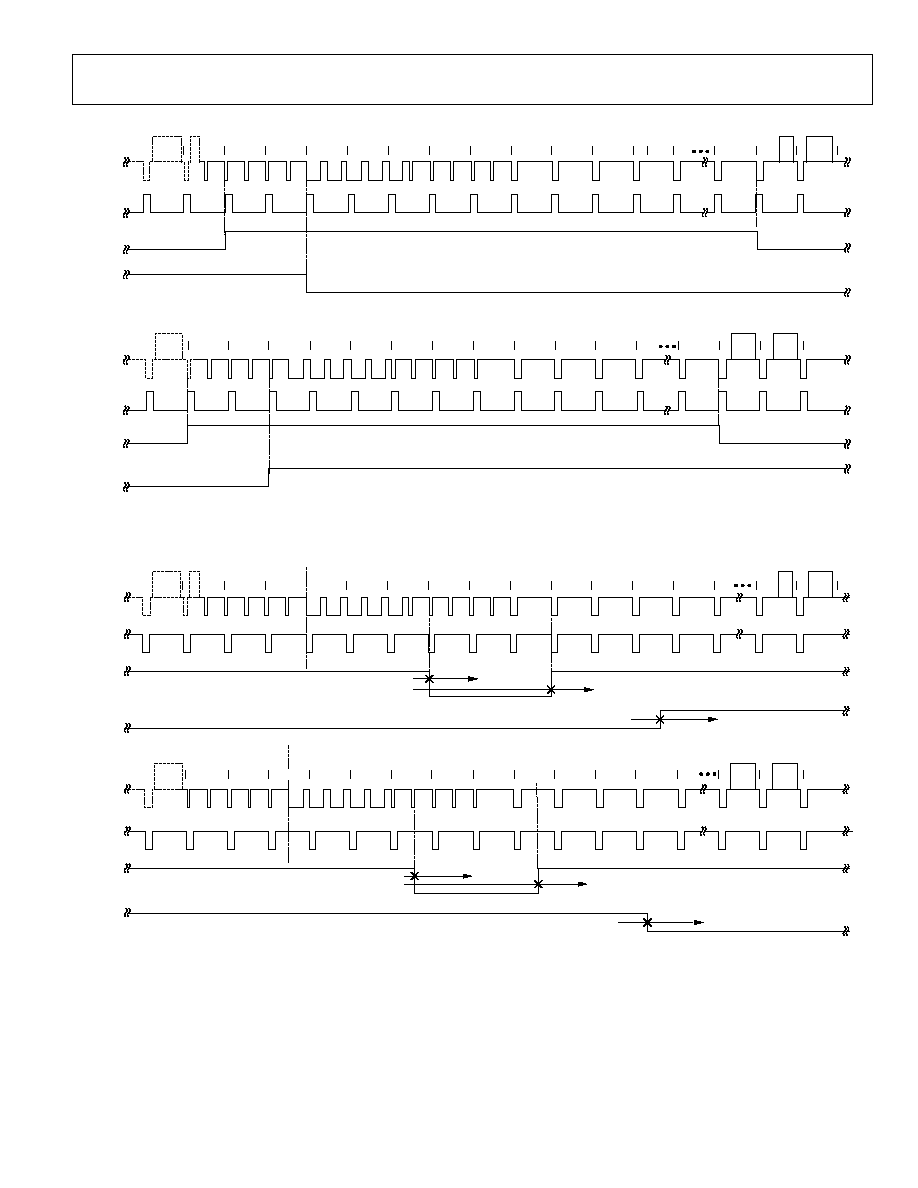
ADV7183A
Rev. A | Page 49 of 104
04819-0-026
FIELD 1
OUTPUT
VIDEO
H
V
F
622
623
624
625
1
2
3
4
5
6
7
8
9
10
22
23
24
PVBEG[4:0] = 5
PVEND[4:0] = 4
PFTOG[4:0] = 3
FIELD 2
OUTPUT
VIDEO
H
V
F
PVBEG[4:0] = 5
PVEND[4:0] = 4
PFTOG[4:0] = 3
310
311
312
313
314
315
316
317
318
319
320
321
322
335
336
337
Figure 26. PAL Default (BT.656). The polarity of H, V, and F is embedded in the data.
04819-0-027
FIELD 1
622
623
624
625
1
2
3
4
5
6
7
8
9
10
11
23
24
310
311
312
313
314
315
316
317
318
319
320
321
322
323
336
337
PVBEG[4:0] = 1h
PVEND[4:0] = 4h
PFTOG[4:0] = 6h
FIELD 2
OUTPUT
VIDEO
FIELD
OUTPUT
HS
OUTPUT
VS
OUTPUT
OUTPUT
VIDEO
FIELD
OUTPUT
HS
OUTPUT
VS
OUTPUT
PVBEG[4:0] = 1h
PVEND[4:0] = 4h
PFTOG[4:0] = 6h
Figure 27. PAL Typical VSync/Field Positions Using Register Writes in Table 123
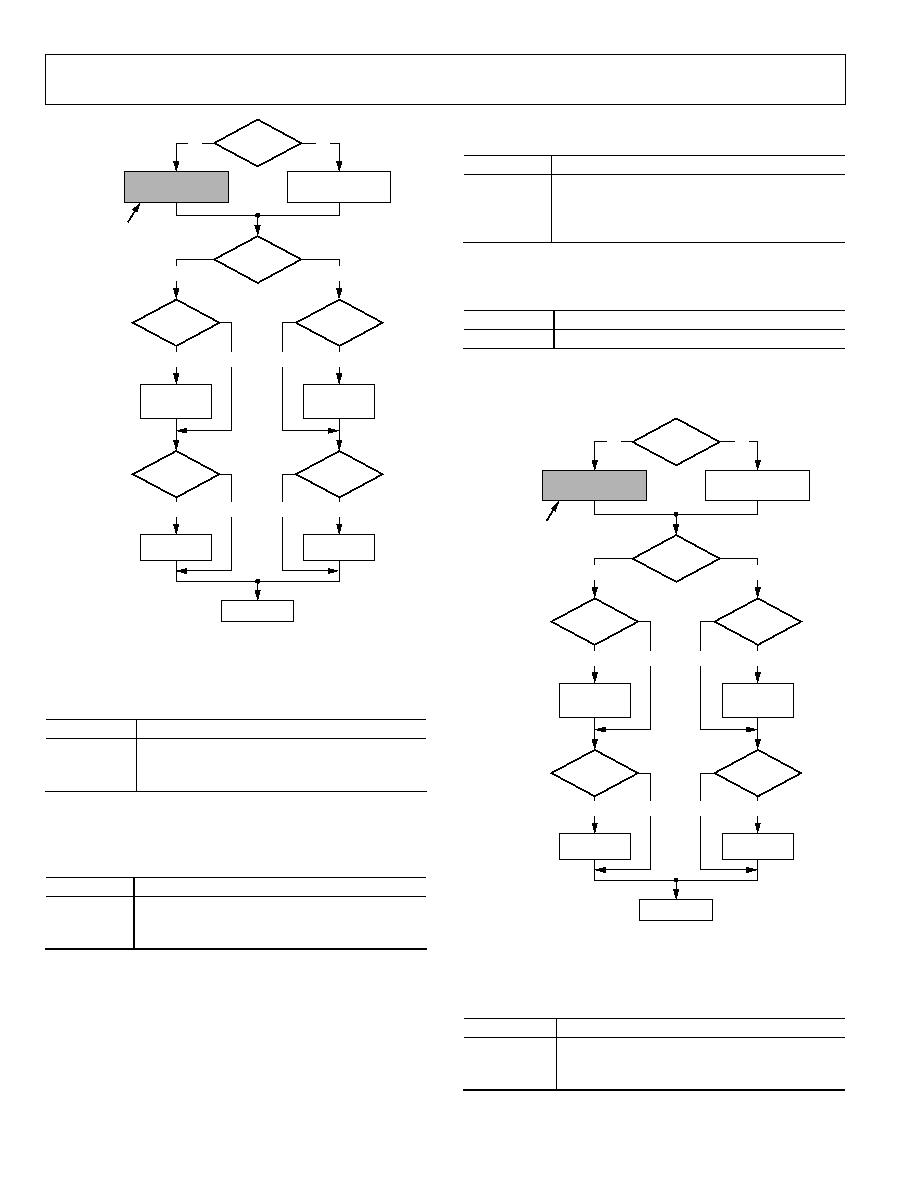
ADV7183A
Rev. A | Page 50 of 104
04819-0-028
ADVANCE BEGIN OF
VSYNC BY PVBEG[4:0]
DELAY BEGIN OF
VSYNC BY PVBEG[4:0]
VSYNC BEGIN
PVBEGSIGN
ODD FIELD?
0
1
NO
YES
PVBEGDELO
VSBHO
ADDITIONAL
DELAY BY
1 LINE
ADVANCE BY
0.5 LINE
1
0
1
0
PVBEGDELE
VSBHE
ADDITIONAL
DELAY BY
1 LINE
ADVANCE BY
0.5 LINE
1
0
1
0
NOT VALID FOR USER
PROGRAMMING
Figure 28. PAL VSync Begin
PVBEGDELO PAL VSync Begin Delay on Odd Field,
Address 0xE8, [7]
Table 124. PVBEGDELO Function
PVBEGDELO Description
0* No
delay.
1
Delay VSync going high on an odd field by a line
relative to PVBEG.
*Default value.
PVBEGDELE PAL VSync Begin Delay on Even Field,
Address 0xE8, [6]
Table 125. PVBEGDELE Function
PVBEGDELE Description
0
No delay.
1*
Delay VSync going high on an even field by a line
relative to PVBEG.
*Default value.
PVBEGSIGN PAL VSync Begin Sign, Address 0xE8, [5]
Table 126. PVBEGSIGN Function
PVBEGSIGN Description
0
Delay begin of VSync. Set for user manual
programming.
1*
Advance begin of VSync. Not recommended for
user programming.
*Default value.
PVBEG[4:0] PAL VSync Begin, Address 0xE8, [4:0]
Table 127. PVBEG Function
PVBEG Description
00101*
PAL VSync begin position.
*Default value.
For all NTSC/PAL VSync timing controls, both the V bit in the
AV code and the VSync on the VS pin are modified.
04819-0-029
ADVANCE END OF
VSYNC BY PVEND[4:0]
DELAY END OF VSYNC
BY PVEND[4:0]
VSYNC END
PVENDSIGN
ODD FIELD?
0
1
NO
YES
PVENDDELO
VSEHO
ADDITIONAL
DELAY BY
1 LINE
ADVANCE BY
0.5 LINE
1
0
1
0
PVENDDELE
VSEHE
ADDITIONAL
DELAY BY
1 LINE
ADVANCE BY
0.5 LINE
1
0
1
0
NOT VALID FOR USER
PROGRAMMING
Figure 29. PAL VSync End
PVENDDELO PAL VSync End Delay on Odd Field,
Address 0xE9,[7]
Table 128. PVENDDELO Function
PVENDDELO Description
0* No
delay.
1
Delay VSync going low on an odd field by a line
relative to PVEND.
*Default value.
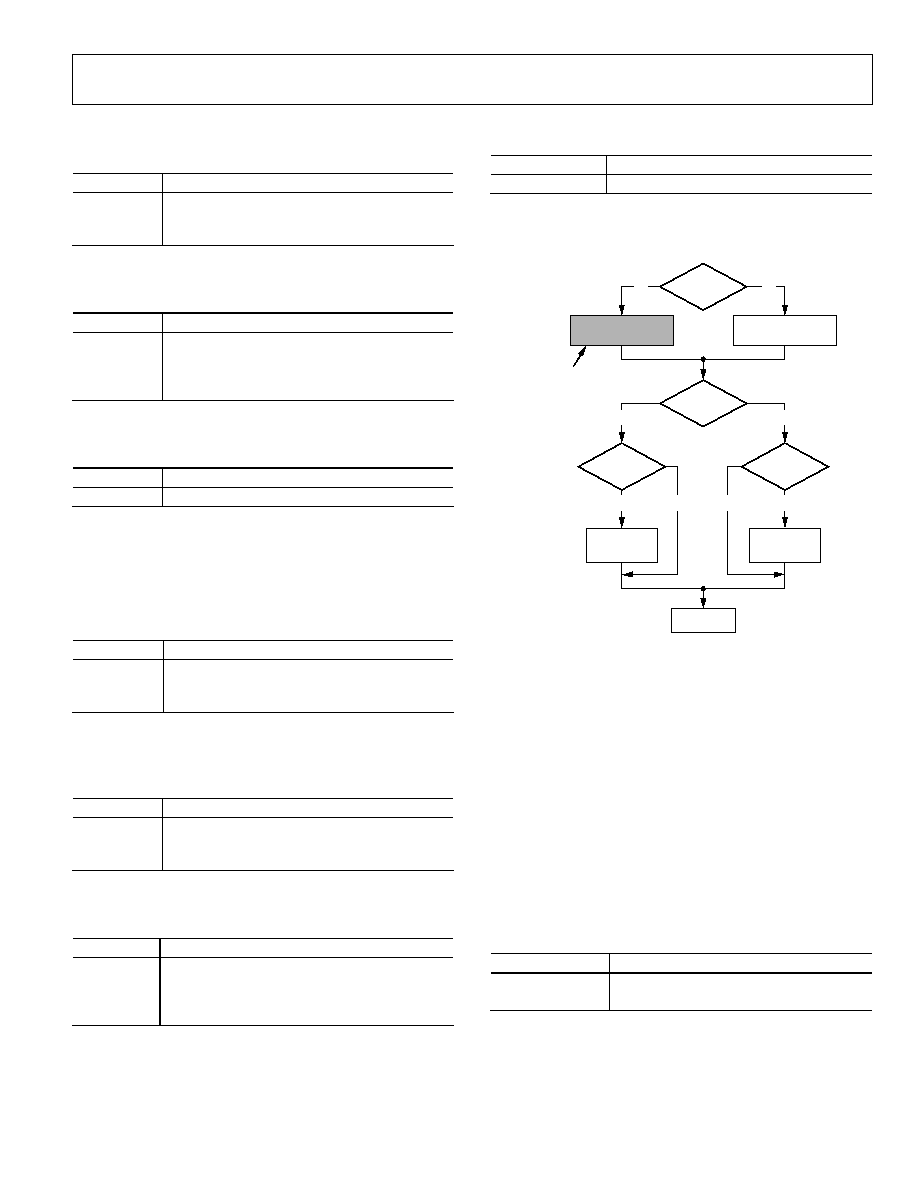
ADV7183A
Rev. A | Page 51 of 104
PVENDDELE PAL VSync End Delay on Even Field,
Address 0xE9,[6]
Table 129. PVENDDELE Function
PVENDDELE Description
0* No
delay.
1
Delay VSync going low on an even field by a line
relative to PVEND.
*Default value.
PVENDSIGN PAL VSync End Sign, Address 0xE9, [5]
Table 130. PVENDSIGN Function
PVENDSIGN Description
0*
Delay end of VSync. Set for user manual
programming.
1
Advance end of VSync. Not recommended for
user programming.
*Default value.
PVEND[4:0] PAL Vsync End, Address 0xE9,[4:0]
Table 131. PVEND Function
PVEND Description
10100*
PAL VSync end position.
*Default value.
Note: For all NTSC/PAL VSync timing controls, both the V bit
in the AV code and the VSync on the VS pin are modified.
PFTOGDELO PAL Field Toggle Delay on Odd Field,
Address 0xEA, [7]
Table 132. PFTOGDELO Function
PFTOGDELO Description
0* No
delay.
1
Delay F toggle/transition on an odd field by a
line relative to PFTOG.
*Default value.
PFTOGDELE PAL Field Toggle Delay on Even Field,
Address 0xEA [6]
Table 133. PFTOGDELE Function
PFTOGDELE Description
0
No delay.
1*
Delay F toggle/transition on an even field by a
line relative to PFTOG.
*Default value.
PFTOGSIGN PAL Field Toggle Sign, Address 0xEA, [5]
Table 134. PFTOGSIGN Function
PFTOGSIGN Description
0
Delay Field transition. Set for user manual
programming.
1*
Advance Field transition. Not recommended for
user programming.
*Default value.
PFTOG PAL Field Toggle, Address 0xEA [4:0]
Table 135. PFTOG Function
PFTOG Description
00011*
PAL Field toggle position.
*Default value.
For all NTSC/PAL Field timing controls, the F bit in the AV
code and the Field signal on the FIELD/DE pin are modified.
04819-0-030
ADVANCE TOGGLE OF
FIELD BY PTOG[4:0]
DELAY TOGGLE OF
FIELD BY PFTOG[4:0]
PFTOGSIGN
ODD FIELD?
0
1
NO
YES
PFTOGDELE
ADDITIONAL
DELAY BY
1 LINE
1
0
PFTOGDELO
ADDITIONAL
DELAY BY
1 LINE
1
0
FIELD
TOGGLE
NOT VALID FOR USER
PROGRAMMING
Figure 30. PAL F Toggle
SDP SYNC PROCESSING
The ADV7183A has two additional sync processing blocks that
postprocess the raw synchronization information extracted
from the digitized input video. If desired, the blocks can be
disabled via the following two I
2
C bits.
ENHSPLL Enable HSync Processor (SDP), Address 0x01, [6]
The HSYNC processor is designed to filter incoming HSyncs
that have been corrupted by noise, providing improved per-
formance for video signals with stable time bases but poor SNR.
For CVBS PAL/NTSC, YC PAL/NTSC enable the HSync
processor. For SECAM disable the HSync Processor. For YPrPb
through SDP, disable HSYNC Processor.
Table 136. ENHSPLL Function
ENHSPLL Description
0
Disable the HSync processor.
1*
Enable the HSync processor.
*Default value.
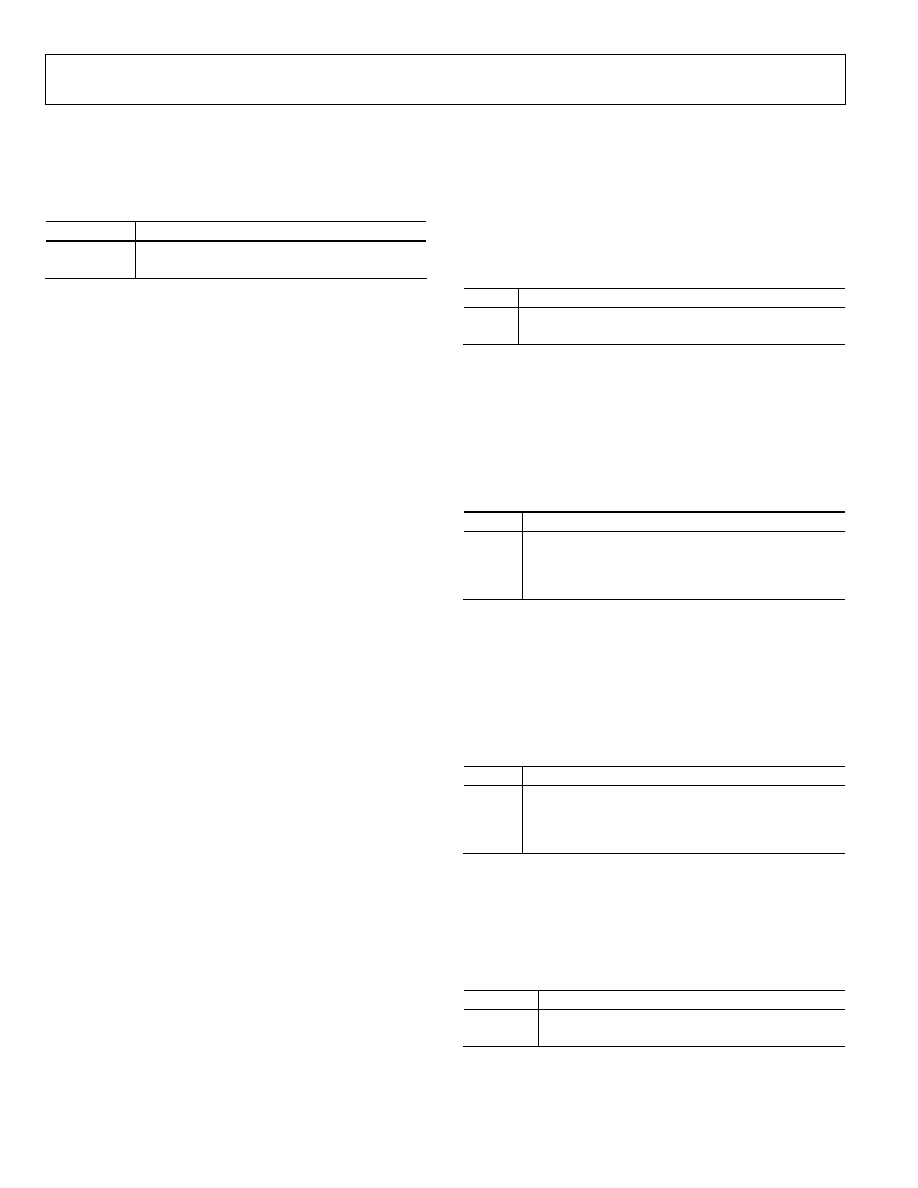
ADV7183A
Rev. A | Page 52 of 104
ENVSPROC Enable VSync Processor (SDP),
Address 0x01, [3]
This block provides extra filtering of the detected VSyncs to
give improved vertical lock.
Table 137. ENVSPROC Function
ENVSPROC Description
0
Disable VSync processor.
1*
Enable VSync processor.
*Default value.
SDP VBI DATA DECODE
The following low data rate VBI signals can be decoded by the
ADV7183A:
·
Wide screen signaling (WSS)
·
Copy generation management systems (CGMS)
·
Closed captioning (CCAP)
·
EDTV
·
Gemstar 1× and 2× compatible data recovery
The presence of any of the above signals is detected and, if
applicable, a parity check is performed. The result of this testing
is contained in a confidence bit in the VBI Info[7:0] register.
Users are encouraged to first examine the VBI Info register
before reading the corresponding data registers. All VBI data
decode bits are read-only.
All VBI data registers are double-buffered with the field signals.
This means that data is extracted from the video lines and
appears in the appropriate I
2
C registers with the next field
transition. They are then static until the next field.
The user should start an I
2
C read sequence with VS by first
examining the VBI Info register. Then, depending on what data
was detected, the appropriate data registers should be read.
Note that the data registers are filled with decoded VBI data
even if their corresponding detection bits are low; it is likely
that bits within the decoded data stream are wrong.
Notes
·
The closed captioning data (CCAP) is available in the I
2
C
registers, and is also inserted into the output video data
stream during horizontal blanking.
·
The Gemstar compatible data is not available in the I
2
C
registers, and is inserted into the data stream only during
horizontal blanking.
WSSD Wide Screen Signaling Detected (SDP),
Address 0x90, [0]
Logic 1 for this bit indicates that the data in the WSS1 and
WSS2 registers is valid.
The WSSD bit goes high if the rising edge of the start bit is
detected within a time window, and if the polarity of the parity
bit matches the data transmitted.
Table 138. WSSD Function
WSSD Description
0
No WSS detected. Confidence in decoded data is low.
1
WSS detected. Confidence in decoded data is high.
CCAPD Closed Caption Detected (SDP), Address 0x90, [1]
A Logic 1 for this bit indicates that the data in the CCAP1 and
CCAP2 registers is valid.
The CCAPD bit goes high if the rising edge of the start bit is
detected within a time window, and if the polarity of the parity
bit matches the data transmitted.
Table 139. CCAPD Function
CCAPD Description
0
No CCAP signals detected. Confidence in decoded
data is low.
1
CCAP sequence detected. Confidence in decoded data
is high.
EDTVD EDTV Sequence Detected (SDP), Address 0x90, [2]
A Logic 1 for this bit indicates that the data in the EDTV1, 2, 3
registers is valid.
The EDTVD bit goes high if the rising edge of the start bit is
detected within a time window, and if the polarity of the parity
bit matches the data transmitted.
Table 140. EDTVD Function
EDTVD Description
0
No EDTV sequence detected. Confidence in decoded
data is low.
1
EDTV sequence detected. Confidence in decoded data
is high.
CGMSD CGMS-A Sequence Detected (SDP),
Address 0x90, [3]
Logic 1 for this bit indicates that the data in the CGMS1, 2, 3
registers is valid. The CGMSD bit goes high if a valid CRC
checksum has been calculated from a received CGMS packet.
Table 141. CGMSD Function
CGMSD Description
0
No CGMS transmission detected. Confidence low.
1
CGMS sequence decoded. Confidence high.
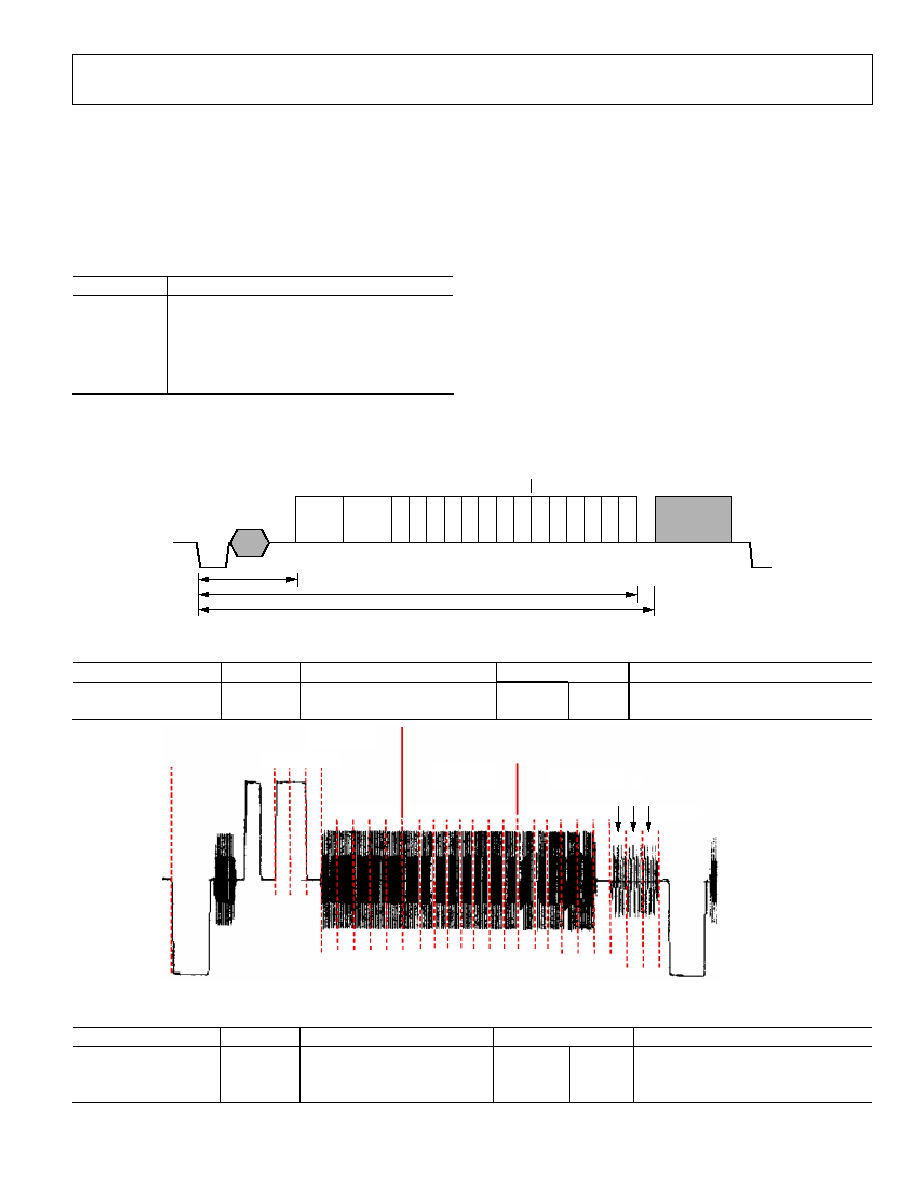
ADV7183A
Rev. A | Page 53 of 104
CRC_ENABLE CRC CGMS-A Sequence (SDP),
Address 0xB2, [2]
For certain video sources, the CRC data bits may have an
invalid format. In such circumstances, the CRC checksum
validation procedure can be disabled. The CGMSD bit goes
high if the rising edge of the start bit is detected within a time
window.
Table 142. CRC_ENABLE Function
CRC_ENABLE Description
0
No CRC check performed. The CGMSD bit goes
high if the rising edge of the start bit is detected
within a time window.
1*
Use CRC checksum to validate the CGMS-A
sequence. The CGMSD bit goes high for a valid
checksum. ADI recommended setting.
*Default value.
Wide Screen Signaling Data
WSS1[7:0] (SDP), Address 0x91, [7:0], WSS2[7:0] (SDP),
Address 0x92, [7:0]
Figure 31 shows the bit correspondence between the analog
video waveform and the WSS1/WSS2 registers. Please note that
WSS2[7:6] are undetermined and should be masked out by
software.
EDTV Data Registers
EDTV1[7:0] (SDP), Address 0x93, [7:0], EDTV2[7:0] (SDP),
Address 0x94, [7:0], EDTV3[7:0] (SDP), Address 0x95, [7:0]
Figure 32 shows the bit correspondence between the analog
video waveform and the EDTV1/EDTV2/EDTV3 registers.
Note that EDTV3[7:6] are undetermined and should be masked
out by software. EDTV3[5] is reserved for future use and, for
now, will contain 0. The three LSBs of the EDTV waveform are
currently not supported.
04819-0-031
ACTIVE
VIDEO
WSS2[5:0]
WSS1[7:0]
RUN-IN
SEQUENCE
START
CODE
0
1
2
3
4
5
6
7
0
1
2
3
4
5
11.0
µ
s
38.4
µ
s
42.5
µ
s
Figure 31. SDP WSS Data Extraction
Table 143. SDP WSS Access Information
Signal Name
Block
Register Location
Address
Register Default Value
WSS1 [7:0]
SDP
WSS 1 [7:0]
145d
91h
Readback Only
WSS2 [5:0]
SDP
WSS 2 [5:0]
146d
92h
Readback Only
EDTV1[7:0]
EDTV2[7:0]
EDTV3[5:0]
NOT SUPPORTED
0
1
3
4
5
6
7
0
1 2 3 4 5
6 7
0 1 2 3
4
5
2
04819-0-032
Figure 32. SDP EDTV Data Extraction
Table 144. SDP EDTV Access Information
Signal Name
Block
Register Location
Address
Register Default Value
EDTV1[7:0]
SDP
EDTV 1 [7:0]
147d
93h
Readback Only
EDTV2[7:0]
SDP
EDTV 2 [7:0]
148d
94h
Readback Only
EDTV3[7:0]
SDP
EDTV 3 [7:0]
149d
95h
Readback Only
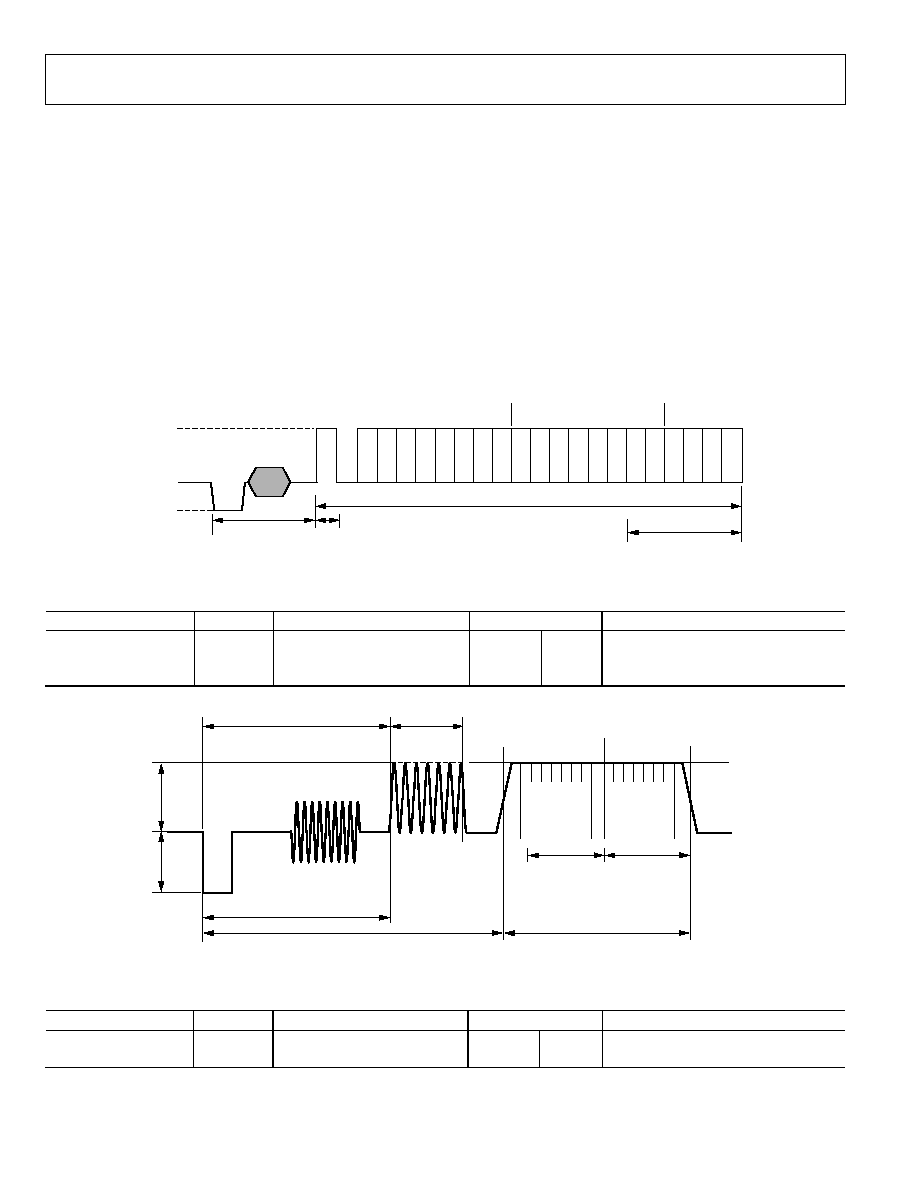
ADV7183A
Rev. A | Page 54 of 104
CGMS Data Registers
CGMS1[7:0] (SDP), Address 0x96, [7:0], CGMS2[7:0] (SDP),
Address 0x97, [7:0], CGMS3[7:0] (SDP), Address 0x98, [7:0]
Figure 33 shows the bit correspondence between the analog
video waveform and the CGMS1/CGMS2/CGMS3 registers.
CGMS3[7:4] are undetermined and should be masked out by
software.
Closed Caption Data Registers
CCAP1[7:0] (SDP), Address 0x99, [7:0], CCAP2[7:0] (SDP),
Address 0x9A, [7:0]
Figure 34 shows the bit correspondence between the analog
video waveform and the CCAP1/CCAP2 registers.
Notes
·
CCAP1[7] contains the parity bit from the first word.
CCAP2[7] contains the parity bit from the second word.
·
Refer to the GDECAD Gemstar Decode Ancillary Data
Format (SDP), Address 0x4C, [0] section.
04819-0-033
0
1
2
3
4
5
6
7
0
1
2
3
4
5
6
7
0
1
2
3
CGMS2[7:0]
CGMS3[3:0]
CGMS1[7:0]
REF
+100 IRE
+70 IRE
0 IRE
40 IRE
11.2
µ
s
49.1
µ
s
±
0.5
µ
s
CRC SEQUENCE
2.235
µ
s
±
20ns
Figure 33. SDP CGMS Data Extraction
Table 145. SDP CGMS Access Information
Signal Name
Block
Register Location
Address
Register Default Value
CGMS1[7:0]
SDP
CGMS 1 [7:0]
150d
96h
Readback Only
CGMS2[7:0]
SDP
CGMS 2 [7:0]
151d
97h
Readback Only
CGMS3[3:0]
SDP
CGMS 3 [3:0]
152d
98h
Readback Only
0
REFERENCE COLOR BURST
(9 CYCLES)
FREQUENCY = F
SC
= 3.579545MHz
AMPLITUDE = 40 IRE
1
CCAP1[7:0]
7 CYCLES
OF 0.5035MHz
(CLOCK RUN-IN)
CCAP2[7:0]
2 3 4 5 6 7 0 1 2 3 4 5 6 7
P
A
R
I
T
Y
S
T
A
R
T
P
A
R
I
T
Y
BYTE 1
BYTE 0
33.764
µ
s
10.003
µ
s
10.5
±
0.25
µ
s
12.91
µ
s
27.382
µ
s
50 IRE
40 IRE
04819-0-034
Figure 34. SDP Closed Caption Data Extraction
Table 146. SDP CCAP Access Information
Signal Name
Block
Register Location
Address
Register Default Value
CCAP1[7:0]
SDP
CCAP 1 [7:0]
153d
99h
Readback Only
CCAP2[7:0]
SDP
CCAP 2 [7:0]
154d
9Ah
Readback Only

ADV7183A
Rev. A | Page 55 of 104
Letterbox Detection
Incoming video signals may conform to different aspect ratios
(16:9 wide screen of 4:3 standard). For certain transmissions in
the wide screen format, a digital sequence (WSS) is transmitted
with the video signal. If a WSS sequence is provided, the aspect
ratio of the video can be derived from the digitally decoded bits
WSS contains.
In the absence of a WSS sequence, letterbox detection may be
used to find wide screen signals. The detection algorithm
examines the active video content of lines at the start and end of
a field. If black lines are detected, this may serve as an indication
that the currently shown picture is in wide screen format.
The active video content (luminance magnitude) over a line of
video is summed together. At the end of a line, this accumulated
value is compared with a threshold, and a decision is made as to
whether or not a particular line is black. The threshold value
needed may depend on the type of input signal; some control is
provided via LB_TH[4:0].
Detection at the Start of a Field
The ADV7183A expects a section of at least six consecutive
black lines of video at the top of a field. Once those lines have
been detected, Register LB_LCT[7:0] reports back the number
of black lines that were actually found. By default, the
ADV7183A starts looking for those black lines in sync with the
beginning of active video (e.g., straight after the last VBI video
line). LB_SL[3:0] allows the user to set the start of letterbox
detection from the beginning of a frame on a line-by-line basis.
The detection window closes in the middle of the field.
Detection at the End of a Field
The ADV7183A expects at least six continuous lines of black
video at the bottom of a field before reporting back the number
of lines actually found via the LB_LCB[7:0] value. The activity
window for letterbox detection (end of field) starts in the mid-
dle of an active field. Its end is programmable via LB_EL[3:0].
Detection at the Midrange
Some transmissions of wide screen video include subtitles
within the lower black box. If the ADV7183A finds at least two
black lines followed by some more nonblack video (e.g.,. the
subtitle) and finally followed by the remainder of the bottom
black block, it reports back a midcount via LB_LCM[7:0]. In
cases where no subtitles are found, LB_LCM[7:0] reports the
same number as LB_LCB[7:0].
Notes
·
There is a 2-field delay in the reporting of any line count
parameters.
·
There is no "letterbox detected" bit. The user is asked to
read the LB_LCT[7:0] and LB_LCB[7:0] register values and
to come to a conclusion about the presence of letterbox
type video in software.
LB_LCT[7:0] Letterbox Line Count Top (SDP), Address
0x9B, [7:0]; LB_LCM[7:0] Letterbox Line Count Mid (SDP),
Address 0x9C, [7:0]; LB_LCB[7:0] Letterbox Line Count
Bottom (SDP), Address 0x9D, [7:0]
Table 147. LB_LCx Access Information
Signal Name
Block
Address
Register Default Value
LB_LCT[7:0] SDP 0x9B Readback
only
LB_LCM[7:0] SDP 0x9C
Readback
only
LB_LCB[7:0] SDP 0x9D Readback
only
LB_TH[4:0] Letterbox Threshold Control (SDP),
Address 0xDC, [4:0]
Table 148.LB_TH Function
LB_TH[4:0] Description
01100*
Default threshold for detection of black lines.
01101 to
10000
Increase threshold (need larger active video
content before identifying nonblack lines).
00000 to
01011
Decrease threshold (even small noise levels can
cause the detection of nonblack lines).
*Default value.
LB_SL[3:0] Letterbox Start Line (SDP), Address 0xDD, [7:4]
Table 149. LB_SL Function
LB_SL[3:0] Description
0100*
Letterbox detection is aligned with active video.
Window starts after the EDTV VBI data line. For
example, 0100 = 23/286 (NTSC).
0001, 0010
For example, 0101 = 24/287 (NTSC).
*Default value.
LB_EL[3:0] Letterbox End Line (SDP), Address 0xDD, [3:0]
Table 150. LB_EL Function
LB_EL[3:0] Description
1101*
Letterbox detection ends with the last active line
of video on a field. For example, 1101 = 262/ 525
(NTSC).
0001,0010
For example, 1100 = 261/524 (NTSC).
*Default value.
Gemstar Data Recovery
The Gemstar compatible data recovery block (GSCD) supports
1× and 2× data transmissions. In addition, it can serve as a
closed caption decoder. Gemstar compatible data transmissions
can occur only in NTSC. Closed caption data can be decoded in
both PAL and NTSC.
The block is configured via I
2
C in the following ways:
·
GDECEL[15:0] allow data recovery on selected video lines
on even fields to be enabled and disabled.
·
GDECOL[15:0] enable the data recovery on selected lines
for odd fields.

ADV7183A
Rev. A | Page 56 of 104
·
GDECAD configures the way in which data is embedded
in the video data stream.
The recovered data is not available through I
2
C, but is being
inserted into the horizontal blanking period of an ITU-R BT656
compatible data stream. The data format is intended to comply
with the recommendation by the International
Telecommunications Union, ITU-R BT.1364
2
. See Figure 35.
The format of the data packet depends on the following criteria:
·
Transmission is 1× or 2×
·
Data is output in 8-bit or 4-bit format (see the description
of the GDECAD Gemstar Decode Ancillary Data Format
(SDP), Address 0x4C, [0] bit)
·
Data is Closed Caption (CCAP) or Gemstar compatible
Data packets are output if the corresponding enable bit is set
(see the GDECEL and GDECOL descriptions), and if the
decoder detects the presence of data. This means that for video
lines where no data has been decoded, no data packet is output
even if the corresponding line enable bit is set.
Each data packet starts immediately after the EAV code of the
preceding line. See Figure 35 and Table 151, which show the
overall structure of the data packet.
Entries within the packet are as follows:
·
Fixed preamble sequence of 0x00, 0xFF, 0xFF.
·
Data identification word (DID). The value for the DID
marking a Gemstar or CCAP data packet is 0x140 (10-bit
value).
·
Secondary data identification word (SDID), which contains
information about the video line from which data was
retrieved, whether the Gemstar transmission was of 1× or
2× format, and whether it was retrieved from an even or
odd field.
·
Data count byte, giving the number of user data-words that
follow.
·
User data section.
·
Optional padding to ensure that the length of the user
data-word section of a packet is a multiple of four bytes.
3
·
Checksum byte.
Table 151 lists the values within a generic data packet that is
output by the ADV7183A in 8-bit format.
4
2
For more information, see the ITU website at www.itu.ch.
3
Requirement as set in ITU-R BT.1364.
4
In 8-bit systems, Bits D1 and D0 in the data packets are disregarded.
04819-0-035
00
FF
FF
DID
SDID
DATA
COUNT
USER DATA
OPTIONAL PADDING
BYTES
CHECK
SUM
SECONDARY DATA IDENTIFICATION
PREAMBLE FOR ANCILLARY DATA
DATA IDENTIFICATION
USER DATA (4 OR 8 WORDS)
Figure 35. Gemstar and CCAP Embedded Data Packet (Generic)
Table 151. Generic Data Output Packet
Byte D[9] D[8] D[7] D[6] D[5] D[4] D[3] D[2] D[1] D[0] Description
0 0 0 0 0 0 0 0 0 0 0 Fixed
preamble
1 1 1 1 1 1 1 1 1 1 1 Fixed
preamble
2 1 1 1 1 1 1 1 1 1 1 Fixed
preamble
3 0 1 0 1 0 0 0 0 0 0 DID
4 !EP EP EF 2X
line[3:0]
0 0 SDID
5 !EP EP
0 0 0 0 DC[1]
DC[0]
0 0 Data
count
(DC)
6 !EP EP 0 0
word1[7:4]
0 0 User
data-words
7 !EP EP 0 0
word1[3:0]
0 0 User
data-words
8 !EP EP 0 0
word2[7:4]
0 0 User
data-words
9 !EP EP 0 0
word2[3:0]
0 0 User
data-words
10 !EP EP 0 0
word3[7:4]
0 0 User
data-words
11 !EP EP 0 0
word3[3:0]
0 0 User
data-words
12 !EP EP 0 0
word4[7:4]
0 0 User
data-words
13 !EP EP 0 0
word4[3:0]
0 0 User
data-words
14
!CS[8] CS[8] CS[7] CS[6] CS[5] CS[4] CS[3] CS[2] 0
0
Checksum

ADV7183A
Rev. A | Page 57 of 104
Table 152. Data Byte Allocation
2×
Raw Information Bytes
Retrieved from the Video Line
GDECAD
User Data-Words
(Including Padding)
Padding Bytes
DC[1:0]
1 4
0
8
0
10
1 4
1
4
0
01
0 2
0
4
0
01
0 2
1
4
2
01
Notes
·
DID. The data identification value is 140h (10-bit value).
Care has been taken that in 8-bit systems, the 2 LSBs do
not carry vital information.
·
EP and !EP. The EP bit is set to ensure even parity on the
data-word D[8:0]. Even parity means there will always be
an even number of 1s within the D[8:0] bit arrangement.
This includes the EP bit. !EP describes the logic inverse of
EP and is output on D[9]. The !EP is output to ensure that
the reserved codes of 00 and FF cannot happen.
·
EF. Even field identifier. EF = 1 indicates that the data was
recovered from a video line on an even field.
·
2X. This bit indicates whether the data sliced was in
Gemstar 1× or 2× format. A high indicates 2× format.
·
line[3:0]. This entry provides a code that is unique for each
of the possible 16 source lines of video from which
Gemstar data may have been retrieved. Please refer to Table
164 and Table 165.
·
DC[1:0]. Data count value. The number of User Data
Words in the packet divided by 4. The number of user data
words (UDW) in any packet must be an integral number of
4. Padding is required at the end, if necessary
12
. See to Table
152.
·
The 2X bit determines whether the raw information
retrieved from the video line was 2 or 4 bytes. The state of
the GDECAD bit affects whether the bytes are transmitted
12
Requirement as set in ITU-R BT.1364.
straight (i.e., two bytes transmitted as two bytes) or
whether they are split into nibbles (i.e., two bytes
transmitted as four half bytes). Padding bytes are then
added where necessary.
·
CS[8:2]. The checksum is provided to determine the
integrity of the ancillary data packet. It is calculated by
summing up D[8:2] of DID, SDID, the Data Count byte,
and all UDWs, and ignoring any overflow during the
summation. Since all data bytes that are used to calculate
the checksum have their 2 LSBs set to 0, the CS[1:0] bits are
also always 0.
!CS[8] describes the logic inversion of CS[8]. The value
!CS[8] is included in the checksum entry of the data packet
to ensure that the reserved values of 0x00 and 0xFF do not
occur.
Table 153 to Table 156 outline the possible data packages.
Gemstar 2× Format, Half-Byte Output Mode
Half-byte output mode is selected by setting CDECAD = 0; full-
byte output mode is selected by setting CDECAD = 1. See the
GDECAD Gemstar Decode Ancillary Data Format (SDP),
Address 0x4C, [0] section.
Gemstar 1× Format
Half-byte output mode is selected by setting CDECAD = 0, full-
byte output mode is selected by setting CDECAD = 1. See the
GDECAD Gemstar Decode Ancillary Data Format (SDP),
Address 0x4C, [0] section.
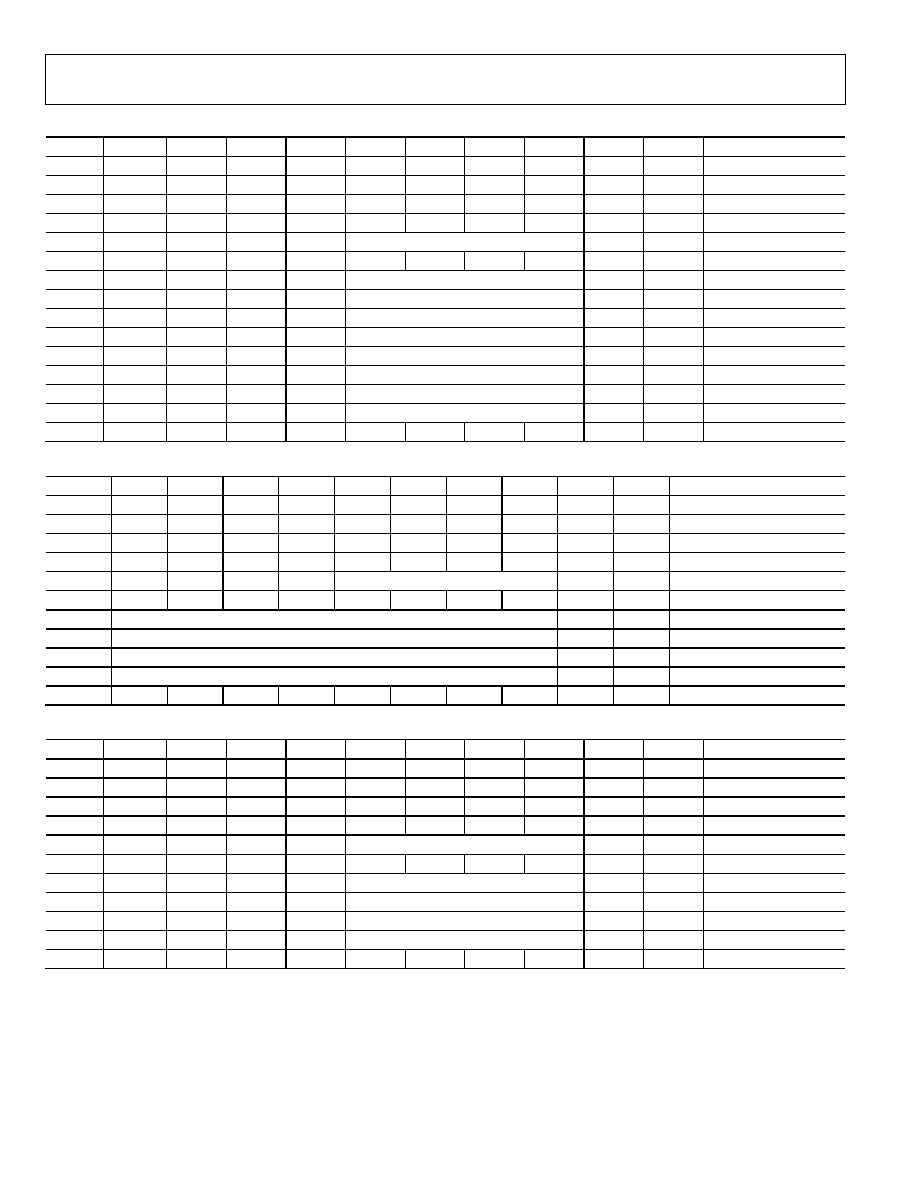
ADV7183A
Rev. A | Page 58 of 104
Table 153. Gemstar 2× Data, Half-Byte Mode
Byte D[9] D[8] D[7] D[6] D[5] D[4] D[3] D[2] D[1] D[0] Description
0 0 0 0 0 0 0 0 0 0 0 Fixed
preamble
1 1 1 1 1 1 1 1 1 1 1 Fixed
preamble
2 1 1 1 1 1 1 1 1 1 1 Fixed
preamble
3 0 1 0 1 0 0 0 0 0 0 DID
4 !EP EP EF 1
line[3:0]
0 0 SDID
5 !EP EP
0 0 0 0 1 0 0 0 Data
count
6 !EP EP 0 0
Gemstar
word1[7:4] 0
0
User
data-words
7 !EP EP 0 0
Gemstar
word1[3:0] 0
0
User
data-words
8 !EP EP 0 0
Gemstar
word2[7:4] 0
0
User
data-words
9 !EP EP 0 0
Gemstar
word2[3:0] 0
0
User
data-words
10 !EP EP 0 0
Gemstar
word3[7:4] 0
0
User
data-words
11 !EP EP 0 0
Gemstar
word3[3:0] 0
0
User
data-words
12 !EP EP 0 0
Gemstar
word4[7:4] 0
0
User
data-words
13 !EP EP 0 0
Gemstar
word4[3:0] 0
0
User
data-words
14
!CS[8] CS[8] CS[7] CS[6] CS[5] CS[4] CS[3] CS[2] CS[1] CS[0] Checksum
Table 154. Gemstar 2× Data, Full-Byte Mode
Byte D[9] D[8] D[7] D[6] D[5] D[4] D[3] D[2] D[1] D[0] Description
0 0 0 0 0 0 0 0 0 0 0 Fixed
preamble
1 1 1 1 1 1 1 1 1 1 1 Fixed
preamble
2 1 1 1 1 1 1 1 1 1 1 Fixed
preamble
3 0 1 0 1 0 0 0 0 0 0 DID
4 !EP
EP
EF
1
line[3:0]
0 0 SDID
5 !EP
EP
0 0 0 0 0 1 0 0 Data
count
6
Gemstar
word1[7:0]
0 0 User
data-words
7
Gemstar
word2[7:0]
0 0 User
data-words
8
Gemstar
word3[7:0]
0 0 User
data-words
9
Gemstar
word4[7:0]
0 0 User
data-words
10
!CS[8] CS[8] CS[7] CS[6] CS[5] CS[4] CS[3] CS[2] CS[1] CS[0] Checksum
Table 155. Gemstar 1× Data, Half-Byte Mode
Byte D[9] D[8] D[7] D[6] D[5] D[4] D[3] D[2] D[1] D[0] Description
0 0 0 0 0 0 0 0 0 0 0 Fixed
preamble
1 1 1 1 1 1 1 1 1 1 1 Fixed
preamble
2 1 1 1 1 1 1 1 1 1 1 Fixed
preamble
3 0 1 0 1 0 0 0 0 0 0 DID
4 !EP EP EF 0
line[3:0]
0 0 SDID
5 !EP EP
0 0 0 0 0 1 0 0 Data
count
6 !EP EP 0 0
Gemstar
word1[7:4] 0
0
User
data-words
7 !EP EP 0 0
Gemstar
word1[3:0] 0
0
User
data-words
8 !EP EP 0 0
Gemstar
word2[7:4] 0
0
User
data-words
9 !EP EP 0 0
Gemstar
word2[3:0] 0
0
User
data-words
10
!CS[8] CS[8] CS[7] CS[6] CS[5] CS[4] CS[3] CS[2] CS[1] CS[0] Checksum

ADV7183A
Rev. A | Page 59 of 104
Table 156. Gemstar 1× Data, Full-Byte Mode
Byte D[9] D[8] D[7] D[6] D[5] D[4] D[3] D[2] D[1] D[0] Description
0 0 0 0 0 0 0 0 0 0 0 Fixed
preamble
1 1 1 1 1 1 1 1 1 1 1 Fixed
preamble
2 1 1 1 1 1 1 1 1 1 1 Fixed
preamble
3 0 1 0 1 0 0 0 0 0 0 DID
4 !EP EP EF 0
line[3:0]
0 0 SDID
5 !EP EP
0 0 0 0 0 1 0 0 Data
count
6
Gemstar
word1[7:0]
0 0 User
data-words
7
Gemstar
word2[7:0]
0 0 User
data-words
8 1 0 0 0 0 0 0 0 0 0 UDW
padding
200h
9 1 0 0 0 0 0 0 0 0 0 UDW
padding
200h
10
!CS[8] CS[8] CS[7] CS[6] CS[5] CS[4] CS[3] CS[2] CS[1] CS[0] Checksum
Table 157. NTSC CCAP Data, Half-Byte Mode
Byte D[9] D[8] D[7] D[6] D[5] D[4] D[3] D[2] D[1] D[0] Description
0 0 0 0 0 0 0 0 0 0 0 Fixed
preamble
1 1 1 1 1 1 1 1 1 1 1 Fixed
preamble
2 1 1 1 1 1 1 1 1 1 1 Fixed
preamble
3 0 1 0 1 0 0 0 0 0 0 DID
4 !EP EP EF 0 1 0 1 1 0 0 SDID
5 !EP EP
0 0 0 0 0 1 0 0 Data
count
6 !EP EP
0 0
CCAP
word1[7:4]
0 0 User
data-words
7 !EP EP
0 0
CCAP
word1[3:0]
0 0 User
data-words
8 !EP EP
0 0
CCAP
word2[7:4]
0 0 User
data-words
9 !EP EP
0 0
CCAP
word2[3:0]
0 0 User
data-words
10
!CS[8] CS[8] CS[7] CS[6] CS[5] CS[4] CS[3] CS[2] CS[1] CS[0] Checksum
Table 158. NTSC CCAP Data, Full-Byte Mode
Byte
D[9] D[8] D[7] D[6] D[5] D[4] D[3] D[2] D[1] D[0] Description
0 0 0 0 0 0 0 0 0 0 0 Fixed
preamble
1 1 1 1 1 1 1 1 1 1 1 Fixed
preamble
2 1 1 1 1 1 1 1 1 1 1 Fixed
preamble
3 0 1 0 1 0 0 0 0 0 0 DID
4 !EP EP EF 0 1 0 1 1 0 0 SDID
5 !EP EP
0 0 0 0 0 1 0 0 Data
count
6
CCAP word1[7:0]
0
0
User data-words
7
CCAP word2[7:0]
0
0
User data-words
8 1 0 0 0 0 0 0 0 0 0 UDW
padding
200h
9 1 0 0 0 0 0 0 0 0 0 UDW
padding
200h
10 !CS[8] CS[8] CS[7] CS[6] CS[5] CS[4] CS[3] CS[2] CS[1] CS[0] Checksum
NTSC CCAP Data
Half-byte output mode is selected by setting CDECAD = 0, the
full-byte mode is enabled by CDECAD = 1. See the GDECAD
Gemstar Decode Ancillary Data Format (SDP), Address 0x4C,
[0]. The data packet formats are shown in Table 157 and
Table 158.
Notes
·
Only closed caption data from the SDP core can be
embedded in the output data stream.
·
NTSC closed caption data is sliced on line 21
d
on even and
odd fields. The corresponding enable bit has to be set high.
See the GDECEL[15:0] Gemstar Decoding Even Lines
(SDP), Address 0x48, [7:0]; Address 0x49, [7:0] and
GDECOL[15:0] Gemstar Decoding Odd Lines (SDP),
Address 0x4A, [7:0]; Address 0x4B, [7:0] sections.

ADV7183A
Rev. A | Page 60 of 104
PAL CCAP Data
Half-Byte output mode is selected by setting CDECAD = 0, full-
byte output mode is selected by setting CDECAD = 1. See the
GDECAD Gemstar Decode Ancillary Data Format (SDP),
Address 0x4C, [0] section. Table 159 and Table 160 list the bytes
of the data packet.
Notes
·
Only closed caption data from the SDP core can be
embedded in the output data stream. PAL closed caption
data is sliced from lines 22 and 335. The corresponding
enable bits have to be set.
·
See the GDECEL[15:0] Gemstar Decoding Even Lines
(SDP), Address 0x48, [7:0]; Address 0x49, [7:0] and
GDECOL[15:0] Gemstar Decoding Odd Lines (SDP),
Address 0x4A, [7:0]; Address 0x4B, [7:0] sections.
Table 159. PAL CCAP Data, Half-Byte Mode
Byte D[9] D[8] D[7] D[6] D[5] D[4] D[3] D[2] D[1] D[0] Description
0 0 0 0 0 0 0 0 0 0 0 Fixed
preamble
1 1 1 1 1 1 1 1 1 1 1 Fixed
preamble
2 1 1 1 1 1 1 1 1 1 1 Fixed
preamble
3 0 1 0 1 0 0 0 0 0 0 DID
4 !EP EP EF 0 1 0 1 0 0 0 SDID
5 !EP EP
0 0 0 0 0 1 0 0 Data
count
6 !EP EP
0 0
CCAP
word1[7:4]
0 0 User
data-words
7 !EP EP
0 0
CCAP
word1[3:0]
0 0 User
data-words
8 !EP EP
0 0
CCAP
word2[7:4]
0 0 User
data-words
9 !EP EP
0 0
CCAP
word2[3:0]
0 0 User
data-words
10
!CS[8] CS[8] CS[7] CS[6] CS[5] CS[4] CS[3] CS[2] CS[1] CS[0] Checksum
Table 160. PAL CCAP Data, Full-Byte Mode
Byte D[9] D[8] D[7] D[6] D[5] D[4] D[3] D[2] D[1] D[0] Description
0 0 0 0 0 0 0 0 0 0 0 Fixed
preamble
1 1 1 1 1 1 1 1 1 1 1 Fixed
preamble
2 1 1 1 1 1 1 1 1 1 1 Fixed
preamble
3 0 1 0 1 0 0 0 0 0 0 DID
4 !EP
EP
EF
0 1 0 1 0 0 0 SDID
5 !EP
EP
0 0 0 0 0 1 0 0 Data
Count
6
CCAP
word1[7:0]
0 0 User
data-words
7
CCAP
word2[7:0]
0 0 User
data-words
8 1 0 0 0 0 0 0 0 0 0 UDW
padding
200h
9 1 0 0 0 0 0 0 0 0 0 UDW
padding
200h
10
!CS[8] CS[8] CS[7] CS[6] CS[5] CS[4] CS[3] CS[2] CS[1] CS[0] Checksum
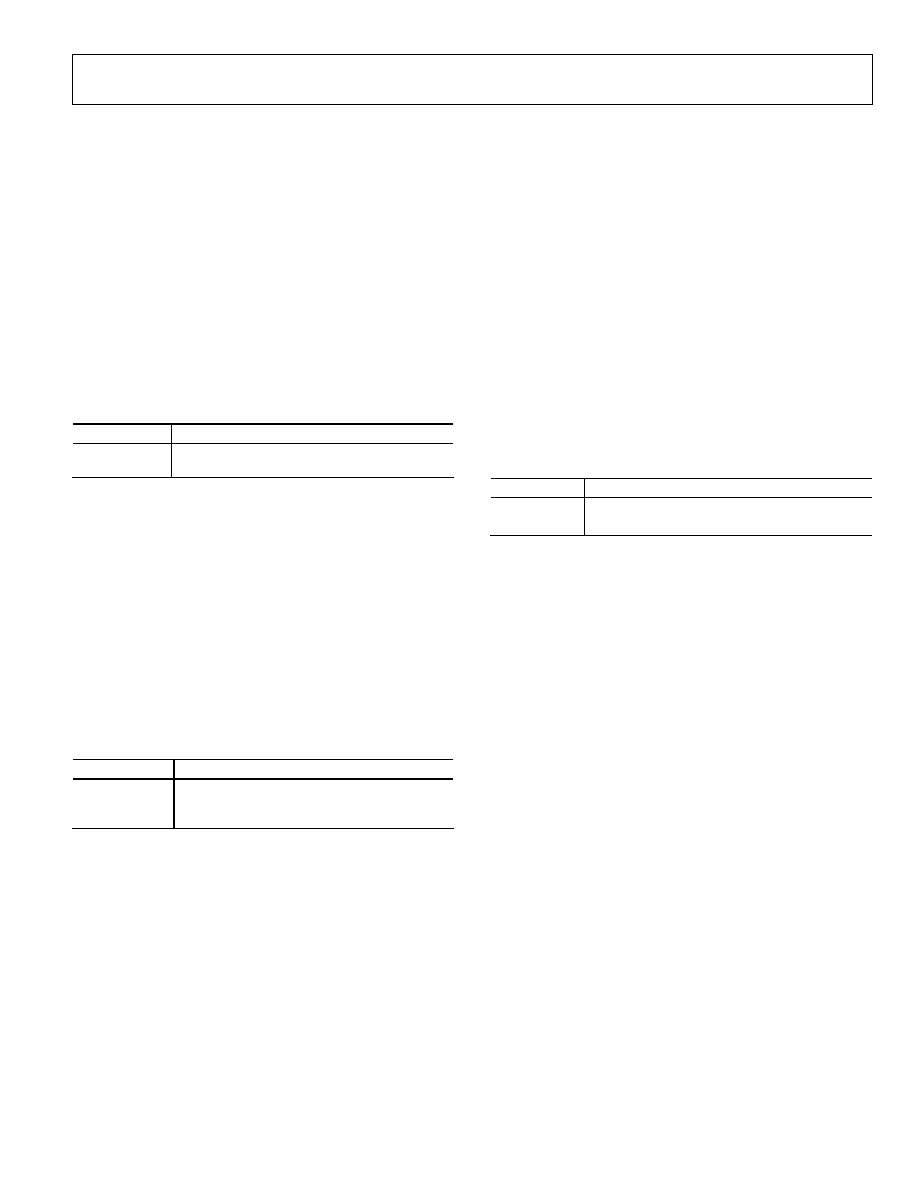
ADV7183A
Rev. A | Page 61 of 104
GDECEL[15:0] Gemstar Decoding Even Lines (SDP),
Address 0x48, [7:0]; Address 0x49, [7:0]
The 16 bits of the GDECEL[15:0] are interpreted as a collection
of 16 individual line decode enable signals. Each bit refers to a
line of video in an even field. Setting the bit enables the decoder
block trying to find Gemstar or closed caption compatible data
on that particular line. Setting the bit to 0 prevents the decoder
from trying to retrieve data. See Table 164 and Table 165.
Notes
·
To retrieve closed caption data services on NTSC (line
284), GDECEL[11] must be set.
·
To retrieve closed caption data services on PAL (line 335),
GDECEL[14] must be set.
Table 161. GDECEL Function
GDECEL[15:0] Description
0x0000*
Do not attempt to decode Gemstar compatible
data or CCAP on any line (even field).
*Default value.
GDECOL[15:0] Gemstar Decoding Odd Lines (SDP),
Address 0x4A, [7:0]; Address 0x4B, [7:0]
The 16 bits of the GDECOL[15:0] form a collection of 16
individual line decode enable signals. See Table 164 and
Table 165.
Notes
·
To retrieve closed caption data services on NTSC (line 21),
GDECOL[11] must be set.
·
To retrieve closed caption data services on PAL (line 22),
GDECOL[14] must be set.
Table 162. GDECOL Function
GDECOL[15:0] Description
0x0000*
Do not attempt to decode Gemstar
compatible data or CCAP on any line (odd
field).
*Default value.
GDECAD Gemstar Decode Ancillary Data Format (SDP),
Address 0x4C, [0]
The decoded data from Gemstar compatible transmissions or
closed caption is inserted into the horizontal blanking period of
the respective line of video. There is a potential problem if the
retrieved data bytes have the value 0x00 or 0xFF. In an ITU-R
BT.656 compatible data stream, those values are reserved and
used only to form a fixed preamble.
The GDECAD bit allows the data to be inserted into the
horizontal blanking period in two ways:
·
Insert all data straight into the data stream, even the
reserved values of 0x00 and 0xFF, if they occur. This may
violate the output data format specification ITU-R
BT.1364.
·
Split all data into nibbles and insert the half-bytes over
double the number of cycles in a 4-bit format.
Table 163. GDECAD Function
GDECAD Description
0*
Split data into half-bytes and insert.
1
Output data straight in 8-bit format.
*Default value.
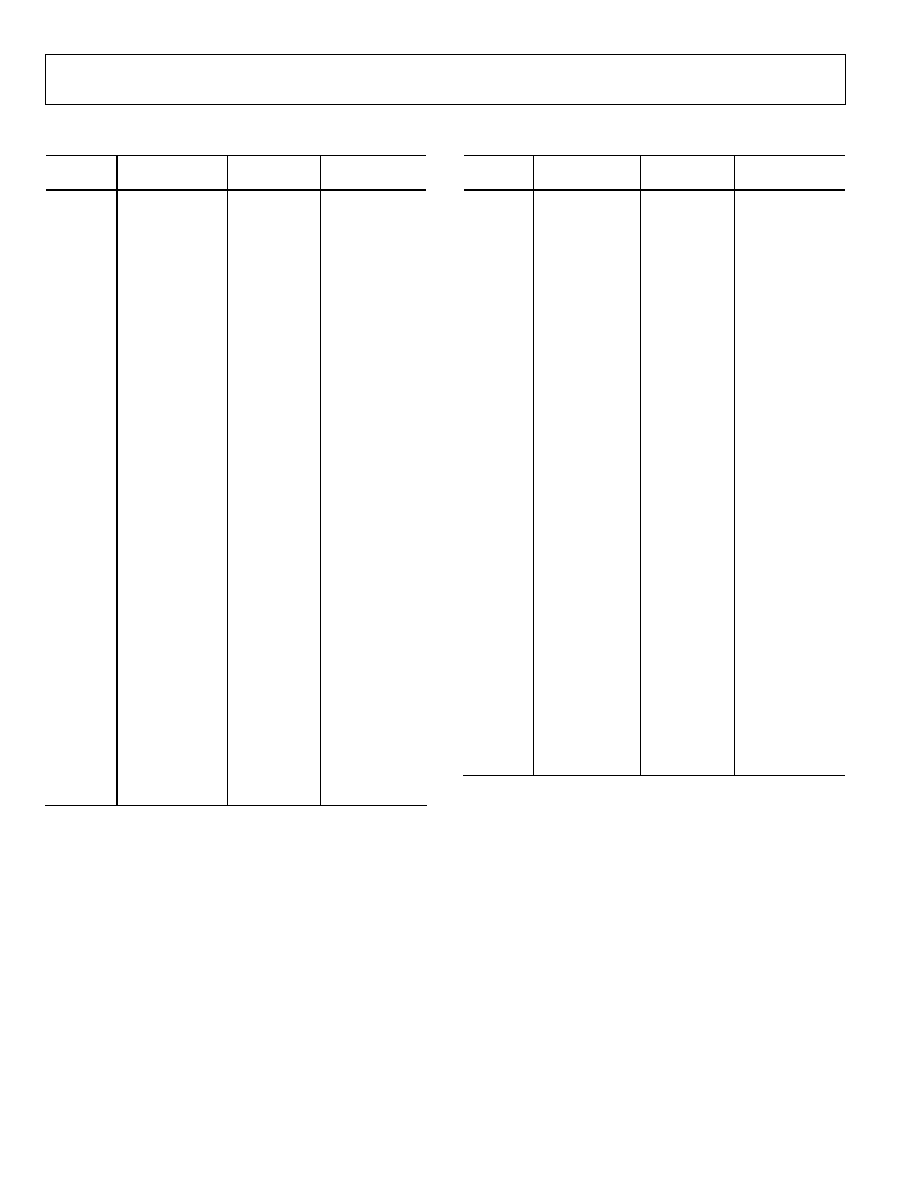
ADV7183A
Rev. A | Page 62 of 104
Table 164. NTSC Line Enable Bits and Corresponding Line
Numbering
line[3:0]
Line Number
(ITU-R BT.470)
Enable Bit
Comment
0 10
GDECOL[0]
Gemstar
1 11
GDECOL[1]
Gemstar
2 12
GDECOL[2]
Gemstar
3 13
GDECOL[3]
Gemstar
4 14
GDECOL[4]
Gemstar
5 15
GDECOL[5]
Gemstar
6 16
GDECOL[6]
Gemstar
7 17
GDECOL[7]
Gemstar
8 18
GDECOL[8]
Gemstar
9 19
GDECOL[9]
Gemstar
10 20
GDECOL[10]
Gemstar
11 21
GDECOL[11]
Gemstar or
closed caption
12 22
GDECOL[12]
Gemstar
13 23
GDECOL[13]
Gemstar
14 24
GDECOL[14]
Gemstar
15 25
GDECOL[15]
Gemstar
0 273
(10) GDECEL[0]
Gemstar
1 274
(11) GDECEL[1]
Gemstar
2 275
(12) GDECEL[2]
Gemstar
3 276
(13) GDECEL[3]
Gemstar
4 277
(14) GDECEL[4]
Gemstar
5 278
(15) GDECEL[5]
Gemstar
6 279
(16) GDECEL[6]
Gemstar
7 280
(17) GDECEL[7]
Gemstar
8 281
(18) GDECEL[8]
Gemstar
9 282
(19) GDECEL[9]
Gemstar
10 283
(20) GDECEL[10]
Gemstar
11 284
(21) GDECEL[11]
Gemstar or
closed caption
12 285
(22) GDECEL[12]
Gemstar
13 286
(23) GDECEL[13]
Gemstar
14 287
(24) GDECEL[14]
Gemstar
15 288
(25) GDECEL[15]
Gemstar
Table 165. PAL Line Enable Bits and Corresponding Line
Numbering
line[3:0]
Line Number
(ITU-R BT.470)
Enable Bit
Comment
12 8
GDECOL[0]
Not
valid
13 9
GDECOL[1]
Not
valid
14 10
GDECOL[2]
Not
valid
15 11
GDECOL[3]
Not
valid
0 12
GDECOL[4]
Not
valid
1 13
GDECOL[5]
Not
valid
2 14
GDECOL[6]
Not
valid
3 15
GDECOL[7]
Not
valid
4 16
GDECOL[8]
Not
valid
5 17
GDECOL[9]
Not
valid
6 18
GDECOL[10]
Not
valid
7 19
GDECOL[11]
Not
valid
8 20
GDECOL[12]
Not
valid
9 21
GDECOL[13]
Not
valid
10 22
GDECOL[14]
Closed
caption
11 23
GDECOL[15]
Not
valid
12
321 (8)
GDECEL[0]
Not valid
13
322 (9)
GDECEL[1]
Not valid
14
323 (10)
GDECEL[2]
Not valid
15
324 (11)
GDECEL[3]
Not valid
0
325 (12)
GDECEL[4]
Not valid
1
326 (13)
GDECEL[5]
Not valid
2
327 (14)
GDECEL[6]
Not valid
3
328 (15)
GDECEL[7]
Not valid
4
329 (16)
GDECEL[8]
Not valid
5
330 (17)
GDECEL[9]
Not valid
6
331 (18)
GDECEL[10]
Not valid
7
332 (19)
GDECEL[11]
Not valid
8
333 (20)
GDECEL[12]
Not valid
9
334 (21)
GDECEL[13]
Not valid
10
335 (22)
GDECEL[14]
Closed caption
11
336 (23)
GDECEL[15]
Not valid
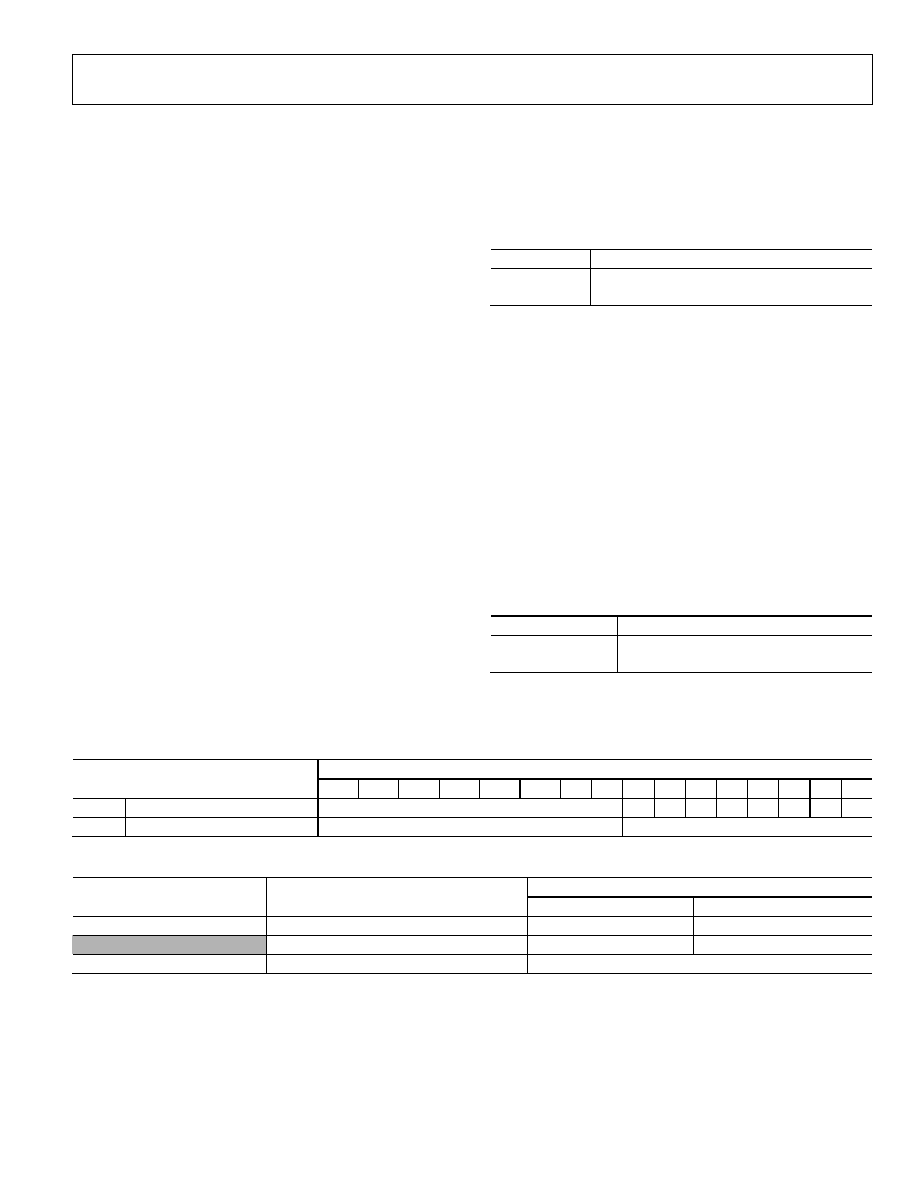
ADV7183A
Rev. A | Page 63 of 104
PIXEL PORT CONFIGURATION
The ADV7183A has a very flexible pixel port that can be
config-ured in a variety of formats to accommodate
downstream ICs. Table 168 and Table 169 summarize the
various functions that the ADV7183A's pins can have in
different modes of operation.
The ordering of components (e.g., Cr versus Cb, CHA/B/C) can
be changed. Refer to the SWPC Swap Pixel Cr/Cb (SDP),
Address 0x27, [7] section. Table 168 indicates the default
positions for the Cr/Cb components.
OF_SEL[3:0] Output Format Selection, Address 0x03, [5:2]
There are several modes in which the ADV7183A pixel port can
be configured. These modes are under the control of
OF_SEL[3:0]. See Table 169 for details.
The default LLC frequency output on the LLC1 pin is approxi-
mately 27 MHz. For modes that operate with a nominal data
rate of 13.5 MHz (0001, 0010), the clock frequency on the LLC1
pin stays at the higher rate of 27 MHz. For information on
outputting the nominal 13.5 MHz clock on the LLC1 pin, see
the LLC1 Output Selection, LLC_PAD_SEL[2:0] (SDP),
Address 0x8F, [6:4] section.
SWPC Swap Pixel Cr/Cb (SDP), Address 0x27, [7]
This bit allows Cr and Cb samples of the SDP block to be
swapped.
Table 166. SWPC Function
SWPC Description
0* No
swapping.
1
Swap Cr and Cb values.
*Default value.
LLC1 Output Selection, LLC_PAD_SEL[2:0] (SDP),
Address 0x8F, [6:4]
The following I
2
C write allows the user to select between the
LLC1 (nominally at 27 MHz) and LLC2 (nominally at
13.5 MHz).
The LLC2 signal is useful for LLC2 compatible wide bus
(16-bit) output modes. See OF_SEL[3:0] Output Format
Selection, Address 0x03, [5:2] for additional information. The
LLC2 signal and data on the data bus are synchronized. By
default, the rising edge of LLC1/LLC2 is aligned with the Y data;
the falling edge occurs when the data bus holds C data. The
polarity of the clock, and therefore the Y/C assignments to the
clock edges, can be altered by using the Polarity LLC pin.
Table 167. LLC_PAD_SEL Function
LLC_PAD_SEL[2:0] Description
000*
Output nominal 27 MHz LLC on LLC1 pin
101
Output nominal 13.5 MHz LLC on LLC1 pin
*Default value.
Table 168. P15P0 Output/Input Pin Mapping
Data Port Pins P[15:0]
Processor, Format, and Mode
15
14 13 12 11 10 9 8 7 6 5 4 3 2 1 0
SDP Video
Out,
8-Bit,
4:2:2
YCrCb[7:0]OUT
SDP
Video Out, 16-Bit, 4:2:2
Y[7:0]OUT
CrCb[7:0] OUT
Table 169. Standard Definition Pixel Port Modes
P[15:
0]
OF_SEL[3:0]
Format
P[15:8] P[7:
0]
0010
16-Bit @LLC2 4:2:2
Y[7:0]
CrCb[7:0]
0011*
8-Bit @LLC1 4:2:2
YCrCb[7:0]
Three-State
0110-1111
Reserved
Reserved. Do not use.
*Default value.

ADV7183A
Rev. A | Page 64 of 104
MPU PORT DESCRIPTION
The ADV7183A supports a 2-wire (I
2
C compatible) serial inter-
face. Four inputs, serial data (SDA1 and SDA2) and serial clock
(SCLK1 and SCLK2), carry information between the
ADV7183A and the system I
2
C master controller. Each slave
device is recognized by a unique address. The ADV7183A has
two ports: the control port, which allows the user to set up and
configure the decoder; and the VBI data readback port, which
allows the user to read back captured VBI data. Both the control
and VBI ports have four possible slave addresses for both read
and write operations, depending on the logic level on the ALSB
pin. These four unique addresses are shown in Table 170. The
ADV7183A's ALSB pin controls Bit 1 of the slave address. By
altering the ALSB, it is possible to control two ADV7183As in
an application without having a conflict with the same slave
address. The LSB (Bit 0) sets either a read or write operation.
Logic 1 corresponds to a read operation; Logic 0 corresponds to
a write operation.
Table 170. I
2
C Address for ADV7183A
ALSB R/W
Slave Address
Control Port
Slave Address
VBI Port
0 0
0x40
0x20
0 1
0x41
0x21
1 0
0x42
0x22
1 1
0x43
0x23
To control the device on the bus, a specific protocol must be
followed. First, the master initiates a data transfer by establish-
ing a Start condition, which is defined by a high-to-low
transition on SDA1/SDA2 while SCLK1/SCLK2 remains high.
This indicates that an address/data stream will follow. All per-
ipherals respond to the Start condition and shift the next eight
bits (7-bit address + R/W bit). The bits are transferred from
MSB down to LSB. The peripheral that recognizes the trans-
mitted address responds by pulling the data line low during the
ninth clock pulse; this is known as an acknowledge bit. All other
devices withdraw from the bus at this point and maintain an
idle condition. The idle condition is where the device monitors
the SDA1/SDA2 and SCLK1/SCLK2 lines, waiting for the Start
condition and the correct transmitted address. The R/W bit
determines the direction of the data. Logic 0 on the LSB of the
first byte means the master will write information to the
peripheral. Logic 1 on the LSB of the first byte means the master
will read information from the peripheral.
The ADV7183A acts as a standard slave device on the bus. The
data on the SDA pin is eight bits long, supporting the 7-bit
addresses plus the R/W bit. The ADV7183A has 196 subad-
dresses to enable access to the internal registers. It therefore
interprets the first byte as the device address and the second
byte as the starting subaddress. The subaddresses auto-
increment, allowing data to be written to or read from the
starting subaddress. A data transfer is always terminated by a
Stop condition. The user can also access any unique subaddress
register on a one-by-one basis without updating all the registers.
Stop and Start conditions can be detected at any stage during
the data transfer. If these conditions are asserted out of
sequence with normal read and write operations, they cause an
immediate jump to the idle condition. During a given SCLK
high period, the user should only issue one Start condition, one
Stop condition, or a single Stop condition followed by a single
Start condition. If an invalid subaddress is issued by the user,
the ADV7183A will not issue an acknowledge and will return to
the idle condition.
If in auto-increment mode the user exceeds the highest
subaddress, the following action is taken:
1.
In read mode, the highest subaddress register contents
continue to be output until the master device issues a no-
acknowledge. This indicates the end of a read. A no-
acknowledge condition is where the SDA line is not pulled
low on the ninth pulse.
2.
In write mode, the data for the invalid byte is not loaded
into any subaddress register, a no acknowledge is issued by
the ADV7183A, and the part returns to the idle condition.
04819-0-036
SDATA
SCLOCK
START ADDR
ACK
ACK
DATA
ACK
STOP
SUBADDRESS
17
17
8
9
8
9
17
8
9
S
P
R/W
Figure 36. Bus Data Transfer
04819-0-037
S
WRITE
SEQUENCE
SLAVE ADDR A(S)
SUB ADDR
A(S)
DATA
A(S)
DATA
A(S) P
S
READ
SEQUENCE
SLAVE ADDR
SLAVE ADDR
A(S)
SUB ADDR
A(S) S
A(S)
DATA
A(M)
DATA
A(M) P
S = START BIT
P = STOP BIT
A(S) = ACKNOWLEDGE BY SLAVE
A(M) = ACKNOWLEDGE BY MASTER
A(S) = NO-ACKNOWLEDGE BY SLAVE
A(M) = NO-ACKNOWLEDGE BY MASTER
LSB = 1
LSB = 0
Figure 37: Read and Write Sequence

ADV7183A
Rev. A | Page 65 of 104
REGISTER ACCESSES
The MPU can write to or read from all of the ADV7183A's
registers, except the Subaddress register, which is write-only.
The Subaddress register determines which register the next read
or write operation accesses. All communications with the part
through the bus start with an access to the Subaddress register.
Then, a read/write operation is performed from/to the target
address, which then increments to the next address until a Stop
command on the bus is performed.
REGISTER PROGRAMMING
The following section describe each register in terms of its
configuration. The Communications register is an 8-bit, write-
only register. After the part has been accessed over the bus and a
read/write operation is selected, the subaddress is set up. The
Subaddress register determines to/from which register the
operation takes place. Table 172 lists the various operations
under the control of the Subaddress register for the control port.
Table 173 lists the various readback registers under the control
of the Subaddress register for the VBI port.
Register Select (SR7-SR0)
These bits are set up to point to the required starting address.
I
2
C SEQUENCER
An I
2
C sequencer is employed in cases where a parameter
exceeds eight bits, and is therefore distributed over two or more
I
2
C registers (e.g., HSB [11:0]).
When such a parameter is changed using two or more I
2
C write
operations, the parameter may hold an invalid value for the
time between the first I
2
C finishing and the last I
2
C being
completed. In other words, the top bits of the parameter may
already hold the new value while the remaining bits of the
parameter still hold the previous value.
To avoid this problem, the I
2
C sequencer holds the already
updated bits of the parameter in local memory; all bits of the
parameter are updated together once the last register write
operation has completed.
The correct operation of the I
2
C sequencer relies on the
following:
·
All I
2
C registers for the parameter in question must be
written to in order of ascending addresses. (e.g., for
HSB[10:0], write to Address 0x34 first, followed by 0x35).
·
No other I
2
C taking place between the two (or more) I
2
C
writes for the sequence (e.g., for HSB[10:0], write to
Address 0x34 first, immediately followed by 0x35).
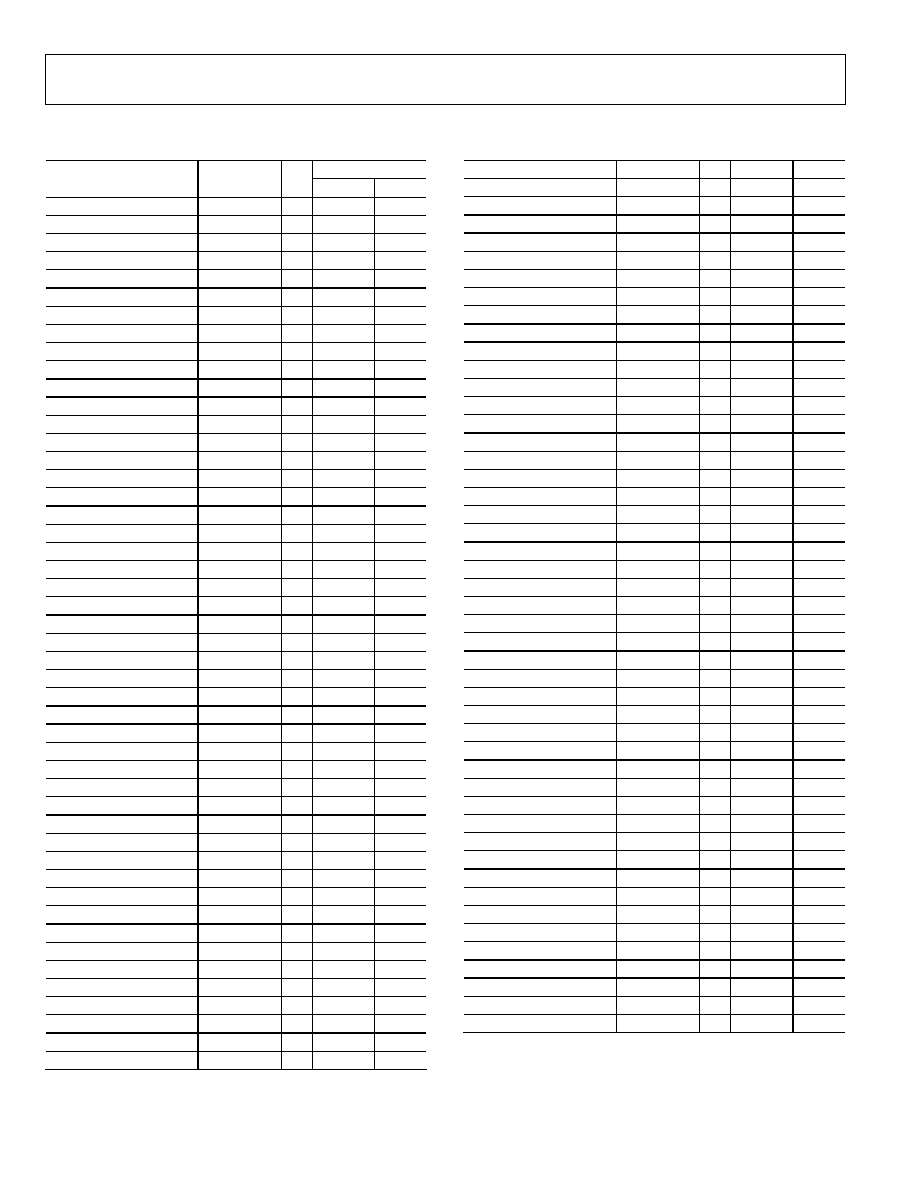
ADV7183A
Rev. A | Page 66 of 104
I
2
C CONTROL REGISTER MAP
Table 171. Control Port Register Map Details
Subaddress
Register Name
Reset Value
rw
Hex
Input Control
0000 0000
rw
0
00
Video Selection
1100 1000
rw
1
01
Video Selection 2
0000 0100
rw
2
02
Output Control
0000 1100
rw
3
03
Extended Output Control
0101 0101
rw
4
04
Reserved 0000
0000
rw
5
05
Reserved 0000
0010
rw
6
06
Autodetect Enable
0111 1111
rw
7
07
Contrast 1000
0000
rw
8
08
Reserved 1000
0000
rw
9
09
Brightness 0000
0000
rw
10
0A
Hue 0000
0000
rw
11
0B
Default Value Y
0011 0110
rw
12
0C
Default Value C
0111 1100
rw
13
0D
ADI Control
0000 0101
rw
14
0E
Power Management
0000 0000
rw
15
0F
Status 1
xxxx xxxx
r
16
10
Ident
xxxx xxxx
r
17
11
Status 2
xxxx xxxx
r
18
12
Status 3
xxxx xxxx
r
19
13
Analog Clamp Control
0001 0010
rw
20
14
Digital Clamp Control 1
0100 xxxx
rw
21
15
Reserved xxxx
xxxx
rw
22
16
Shaping Filter Control
0000 0001
rw
23
17
Shaping Filter Control 2
1001 0011
rw
24
18
Comb Filter Control
1111 0001
rw
25
19
Reserved xxxx
xxxx
rw
2638
1A26
Pixel Delay Control
0101 1000
rw
39
27
Reserved xxxx
xxxx
rw
40
282A
Misc Gain Control
1110 0011
rw
43
2B
AGC Mode Control
1010 1110
rw
44
2C
Chroma Gain Control 1
1111 0100
rw
45
2D
Chroma Gain Control 2
0000 0000
rw
46
2E
Luma Gain Control 1
1111 xxxx
rw
47
2F
Luma Gain Control 2
xxxx xxxx
rw
48
30
VSync Field Control 1
0001 0010
rw
49
31
VSync Field Control 2
0100 0001
rw
50
32
VSync Field Control 3
1000 0100
51
33
HSync Position Control 1
0000 0000
rw
52
34
HSync Position Control 2
0000 0010
rw
53
35
HSync Position Control 3
0000 0000
rw
54
36
Polarity 0000
0001
rw
55
37
NTSC Comb Control
1000 0000
rw
56
38
PAL Comb Control
1100 0000
rw
57
39
ADC Control
0001 0000
rw
58
3A
Reserved xxxx
xxxx
rw
5960
3B3C
Manual Window Control
0100 0011
rw
61
3D
Reserved 0101
0000
rw
6270
3E47
Gemstar Ctrl 1
00000000
rw
72
48
Gemstar Ctrl 2
0000 0000
rw
73
49
Gemstar Ctrl 3
0000 0000
rw
74
4A
Gemstar Ctrl 4
0000 0000
rw
75
4B
GemStar Ctrl 5
xxxx xxx0
rw
76
4C
CTI DNR Ctrl 1
1110 1111
rw
77
4D
CTI DNR Ctrl 2
0000 1000
rw
78
4E
Reserved xxxx
xxxx
rw
79
4F
CTI DNR Ctrl 4
0000 1000
rw
80
50
Lock Count
1010 0100
rw
81
51
Reserved xxxx
xxxx
rw
82142
528E
Free Run Line Length 1
0000 0000
w
143
8F
Free Run Line Length 2
0000 0000
w
144
90
VBI Info
xxxx xxxx
r
144
90
WSS 1
xxxx xxxx
r
145
91
WSS 2
xxxx xxxx
r
146
92
EDTV 1
xxxx xxxx
r
147
93
EDTV 2
xxxx xxxx
r
148
94
EDTV 3
xxxx xxxx
r
149
95
CGMS 1
xxxx xxxx
r
150
96
CGMS 2
xxxx xxxx
r
151
97
CGMS 3
xxxx xxxx
r
152
98
CCAP 1
xxxx xxxx
r
153
99
CCAP 2
xxxx xxxx
r
154
9A
Letterbox 1
xxxx xxxx
r
155
9B
Letterbox 2
xxxx xxxx
r
156
9C
Letterbox 3
xxxx xxxx
r
157
9D
Reserved
xxxx xxxx
rw
158-177
9EB1
CRC Enable
0001 1100
w
178
B2
Reserved xxxx
xxxx
rw
179194
B2C2
ADC Switch 1
xxxx xxxx
rw
195
C3
ADC Switch 2
0xxx xxxx
rw
196
C4
Reserved xxxx
xxxx
rw
197219
C5DB
Letterbox Control 1
1010 1100
rw
220
DC
Letterbox Control 2
0100 1100
rw
221
DD
Reserved 0000
0000
rw
222
DE
Reserved 0000
0000
rw
223
DF
Reserved 0001
0100
rw
224
E0
SD Offset Cb
1000 0000
rw
225
E1
SD Offset Cr
1000 0000
rw
226
E2
SD Saturation Cb
1000 0000
rw
227
E3
SD Saturation Cr
1000 0000
rw
228
E4
NTSC V Bit Begin
0010 0101
rw
225
E5
NTSC V Bit End
0000 0100
rw
226
E6
NTSC F Bit Toggle
0110 0011
rw
227
E7
PAL V Bit Begin
0110 0101
rw
225
E8
PAL V Bit End
0001 0100
rw
226
E9
PAL F Bit Toggle
0110 0011
rw
227
EA

ADV7183A
Rev. A | Page 67 of 104
Table 172. Control Port Register Map Bit Details
Register Name
Bit 7
Bit 6
Bit 5
Bit 4
Bit 3
Bit 2
Bit 1
Bit 0
Input
Control VID_SEL.3 VID_SEL.2 VID_SEL.1 VID_SEL.0 INSEL.3
INSEL.2
INSEL.1
INSEL.0
Video Selection
ENHSPLL
BETACAM
ENVSPROC
Video Selection 2
YPM.2
YPM.1
YPM.0
Output Control
VBI_EN
TOD
OF_SEL.3
OF_SEL.2
OF_SEL.1
OF_SEL.0
SD_DUP_AV
Extended Output
Control
BT656-4
DR_STR.1
DR_STR.0
TIM_OE
BL_C_VBI
EN_SFL_PI
RANGE
Reserved
Reserved
Autodetect Enable
AD_SEC525_EN
AD_SECAM_EN
AD_N443_EN
AD_P60_EN AD_PALN_EN AD_PALM_EN AD_NTSC_EN
AD_PAL_EN
Contrast CON.7
CON.6
CON.5
CON.4 CON.3 CON.2 CON.1
CON.0
Reserved
Brightness
BRI.7
BRI.6
BRI.5
BRI.4
BRI.3
BRI.2
BRI.1
BRI.0
Hue
HUE.7
HUE.6
HUE.5
HUE.4
HUE.3
HUE.2
HUE.1
HUE.0
Default Value Y
DEF_Y.5
DEF_Y.4
DEF_Y.3
DEF_Y.2
DEF_Y.1
DEF_Y.0
DEF_VAL_AUTO_EN DEF_VAL_EN
Default Value C
DEF_C.7
DEF_C.6
DEF_C.5
DEF_C.4
DEF_C.3
DEF_C.2
DEF_C.1
DEF_C.0
ADI Control
TRI_LLC
DR_STR_C.1 DR_STR_C.0 DR_STR_S.1
DR_STR_S.0
Power
Management
PWRDN
PDBP
Status 1
COL_KILL
AD_RESULT.2
AD_RESULT.1 AD_RESULT.0 FOLLOW_PW FSC_LOCK
LOST_LOCK
IN_LOCK
Ident
IDENT.7 IDENT.6 IDENT.5 IDENT.4 IDENT.3 IDENT.2 IDENT.1
IDENT.0
Status 2
FSC NSTD
LL NSTD
MV AGC DET
MV PS DET
MVCS T3
MVCS DET
Status 3
PAL SW LOCK
INTERLACE
STD FLD LEN
FREE_RUN_ACT
INST_HLOCK
Analog Clamp
Control
CCLEN
Digital Clamp
Control 1
DCT.1
DCT.0
Reserved
Shaping Filter
Control
CSFM.2 CSFM.1 CSFM.0 YSFM.4 YSFM.3 YSFM.2 YSFM.1
YSFM.0
Shaping Filter
Control 2
WYSFMOVR
WYSFM.4
WYSFM.3 WYSFM.2 WYSFM.1
WYSFM.0
Comb
Filter
Control
NSFSEL.1 NSFSEL.0 PSFSEL.1
PSFSEL.0
Reserved
Pixel Delay Control
SWPC
AUTO_PDC_EN
CTA.2
CTA.1
CTA.0
LTA.1
LTA.0
Reserved
Misc Gain Control
CKE
PW_UPD
AGC Mode Control
LAGC.2
LAGC.1
LAGC.0
CAGC.1
CAGC.0
Chroma Gain
Control 1
CAGT.1 CAGT.0
CMG.11 CMG.10 CMG.9
CMG.8
Chroma Gain
Control 2
CMG.7 CMG.6 CMG.5 CMG.4 CMG.3 CMG.2 CMG.1
CMG.0
Luma Gain
Control 1
LAGT.1 LGAT.0
LMG.11 LMG.10 LMG.9
LMG.8
Luma Gain
Control 2
LMG.7 LMG.6 LMG.5 LMG.4 LMG.3 LMG.2 LMG.1
LMG.0
VSync Field
Control 1
NEWAVMODE
HVSTIM
VSync Field
Control 2
VSBHO VSBHE
VSync Field
Control 3
VSEHO VSEHE
HSync Position
Control 1
HSB.10
HSB.9
HSB.8
HSE.10
HSE.9
HSE.8
HSync Position
Control 2
HSB.7 HSB.6 HSB.5 HSB.4 HSB.3 HSB.2 HSB.1
HSB.0
HSync Position
Control 3
HSE.7 HSE.6 HSE.5 HSE.4 HSE.3 HSE.2 HSE.1
HSE.0
Polarity
PHS
PVS
PF
PCLK
NTSC Comb Control
CTAPSN.1
CTAPSN.0
CCMN.2
CCMN.1
CCMN.0
YCMN.2
YCMN.1
YCMN.0
PAL Comb Control
CTAPSP.1
CTAPSP.0
CCMP.2 CCMP.1 CCMP.0 YCMP.2 YCMP.1
YCMP.0
ADC Control
PWRDN_AD C_0
PWRDN_AD C_1
PWRDN_ADC_2
Reserved
Manual Window
Control
CKILLTHR.2 CKILLTHR.1 CKILLTHR.0
Reserved

ADV7183A
Rev. A | Page 68 of 104
Register Name
Bit 7
Bit 6
Bit 5
Bit 4
Bit 3
Bit 2
Bit 1
Bit 0
Gemstar Ctrl 1
GDECEL.15
GDECEL.14
GDECEL.13
GDECEL.12
GDECEL.11
GDECEL.10
GDECEL.9
GDECEL.8
Gemstar Ctrl 2
GDECEL.7
GDECEL.6
GDECEL.5
GDECEL.4
GDECEL.3
GDECEL.2
GDECEL.1
GDECEL.0
Gemstar Ctrl 3
GDECOL.15
GDECOL.14
GDECOL.13
GDECOL.12 GDECOL.11 GDECOL.10 GDECOL.9
GDECOL.8
Gemstar Ctrl 4
GDECOL.7
GDECOL.6
GDECOL.5
GDECOL.4
GDECOL.3
GDECOL.2
GDECOL.1
GDECOL.0
Gemstar Ctrl 5
GDECAD
CTI DNR Ctrl 1
DNR_EN
CTI_AB.1 CTI_AB.0 CTI_AB_EN CTI_EN
CTI DNR Ctrl 2
CTI_C_TH.7
CTI_C_TH.6
CTI_C_TH.5
CTI_C_TH.4 CTI_C_TH.3 CTI_C_TH.2 CTI_C_TH.1
CTI_C_TH.0
Reserved
CTI DNR Ctrl 4
DNR_TH.7
DNR_TH.6
DNR_TH.5
DNR_TH.4 DNR_TH.3 DNR_TH.2 DNR_TH.1
DNR_TH.0
Lock Count
FSCLE
SRLS
COL.2
COL.1
COL.0
CIL.2
CIL.1
CIL.0
Reserved
Free Run Line
Length 1
LLC_PAD_SEL.2
LLC_PAD_SEL.1 LLC_PAD_SEL.0
Free Run Line
Length 2
VBI
Info
CGMSD
EDTVD
CCAPD
WSSD
WSS
1
WSS1.7 WSS1.6 WSS1.5 WSS1.4 WSS1.3 WSS1.2 WSS1.1
WSS1.0
WSS
2
WSS2.7 WSS2.6 WSS2.5 WSS2.4 WSS2.3 WSS2.2 WSS2.1
WSS2.0
EDTV 1
EDTV1.7
EDTV1.6
EDTV1.5
EDTV1.4 EDTV1.3 EDTV1.2 EDTV1.1
EDTV1.0
EDTV 2
EDTV2.7
EDTV2.6
EDTV2.5
EDTV2.4 EDTV2.3 EDTV2.2 EDTV2.1
EDTV2.0
EDTV 3
EDTV3.7
EDTV3.6
EDTV3.5
EDTV3.4 EDTV3.3 EDTV3.2 EDTV3.1
EDTV3.0
CGMS 1
CGMS1.7
CGMS1.6
CGMS1.5
CGMS1.4 CGMS1.3 CGMS1.2 CGMS1.1
CGMS1.0
CGMS 2
CGMS2.7
CGMS2.6
CGMS2.5
CGMS2.4 CGMS2.3 CGMS2.2 CGMS2.1
CGMS2.0
CGMS 3
CGMS3.7
CGMS3.6
CGMS3.5
CGMS3.4 CGMS3.3 CGMS3.2 CGMS3.1
CGMS3.0
CCAP 1
CCAP1.7
CCAP1.6
CCAP1.5
CCAP1.4 CCAP1.3 CCAP1.2 CCAP1.1
CCAP1.0
CCAP 2
CCAP2.7
CCAP2.6
CCAP2.5
CCAP2.4
CCAP2.3
CCAP2.2
CCAP2.1
CCAP2.0
Letterbox 1
LB_LCT.7
LB_LCT.6
LB_LCT.5
LB_LCT.4
LB_LCT.3
LB_LCT.2
LB_LCT.1
LB_LCT.0
Letterbox 2
LB_LCM.7
LB_LCM.6
LB_LCM.5
LB_LCM.4
LB_LCM.3
LB_LCM.2
LB_LCM.1
LB_LCM.0
Letterbox 3
LB_LCB.7
LB_LCB.6
LB_LCB.5
LB_LCB.4
LB_LCB.3
LB_LCB.2
LB_LCB.1
LB_LCB.0
Reserved
CRC
Enable
CRC_ENABLE
Reserved
ADC
Switch
1
ADC1_SW.3 ADC1_SW.2 ADC1_SW.1 ADC1_SW.0 ADC0_SW.3 ADC0_SW.2 ADC0_SW.1
ADC0_SW.0
ADC Switch 2
ADC_SW_M AN
ADC2_SW.3
ADC2_SW.2
ADC2_SW.1
ADC2_SW.0
Reserved
Letterbox Control 1
LB_TH.4
LB_TH.3
LB_TH.2
LB_TH.1
LB_TH.0
Letterbox Control 2
LB_SL.3
LB_SL.2
LB_SL.1 LB_SL.0 LB_EL.3 LB_EL.2 LB_EL.1
LB_EL.0
Reserved
Reserved
Reserved
SD Offset Cb
SD_OFF_CB.7
SD_OFF_CB.6
SD_OFF_CB.5
SD_OFF_CB.4 SD_OFF_CB.3 SD_OFF_CB.2 SD_OFF_CB.1
SD_OFF_CB.0
SD Offset Cr
SD_OFF_CR.7
SD_OFF_CR.6
SD_OFF_CR.5
SD_OFF_CR.4 SD_OFF_CR.3 SD_OFF_CR.2 SD_OFF_CR
.1
SD_OFF_CR.0
SD Saturation Cb
SD_SAT_CB.7
SD_SAT_CB.6
SD_SAT_CB.5
SD_SAT_CB.4
SD_SAT_CB.3
SD_SAT_CB.2
SD_SAT_CB.1
SD_SAT_CB.0
SD Saturation Cr
SD_SAT_CR.7
SD_SAT_CR.6
SD_SAT_CR.5
SD_SAT_CR.4 SD_SAT_CR.3 SD_SAT_CR.2 SD_SAT_CR.1
SD_SAT_CR.0
NTSC V Bit Begin
NVBEGDEL O
NVBEGDEL E
NVBEGSIGN NVBEG.4
NVBEG.3
NVBEG.2 NVBEG.1
NVBEG.0
NTSC V Bit End
NVENDDEL O
NVENDDEL E
NVENDSIGN NVEND.4
NVEND.3
NVEND.2 NVEND.1
NVEND.0
NTSC F Bit Toggle
NFTOGDEL O
NFTOGDEL E
NFTOGSIGN NFTOG.4
NFTOG.3
NFTOG.2
NFTOG.1
NFTOG.0
PAL V Bit Begin
PVBEGDEL O
PVBEGDEL E
PVBEGSIGN
PVBEG.4
PVBEG.3
PVBEG.2
PVBEG.1
PVBEG.0
PAL V Bit End
PVENDDEL O
PVENDDEL E
PVENDSIGN
PVEND.4
PVEND.3
PVEND.2
PVEND.1
PVEND.0
PAL F Bit Toggle
PFTOGDEL O
PFTOGDEL E
PFTOGSIGN
PFTOG.4
PFTOG.3
PFTOG.2
PFTOG.1
PFTOG.0
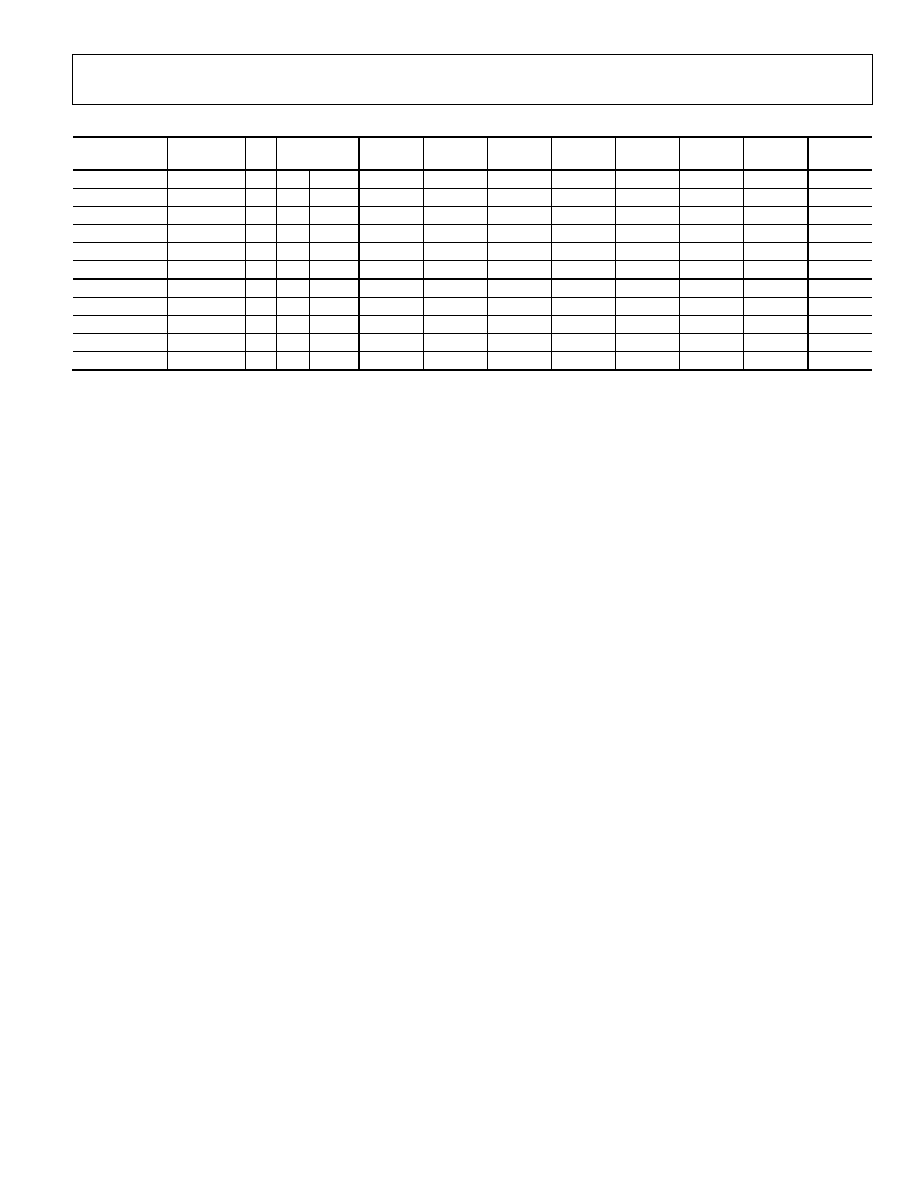
ADV7183A
Rev. A | Page 69 of 104
Table 173. VBI Port Register Map Details
Register
Name
Reset
Value
rw
Subaddress
7
6
5
4
3
2
1
0
VBI Info
xxxx xxxx
r
0
0x00
CGMSD
EDTVD
CCAPD
WSSD
WSS
1
xxxx
xxxx r
1 0x01 WSS1.7 WSS1.6 WSS1.5 WSS1.4 WSS1.3 WSS1.2 WSS1.1 WSS1.0
WSS
2
xxxx
xxxx r 2 0x02 WSS2.7 WSS2.6 WSS2.5 WSS2.4 WSS2.3 WSS2.2 WSS2.1 WSS2.0
EDTV 1
xxxx xxxx
r
3
0x03
EDTV1.7
EDTV1.6
EDTV1.5 EDTV1.4 EDTV1.3 EDTV1.2 EDTV1.1 EDTV1.0
EDTV 2
xxxx xxxx
r
4
0x04
EDTV2.7
EDTV2.6
EDTV2.5 EDTV2.4 EDTV2.3 EDTV2.2 EDTV2.1 EDTV2.0
EDTV 3
xxxx xxxx
r
5
0x05
EDTV3.7
EDTV3.6
EDTV3.5 EDTV3.4 EDTV3.3 EDTV3.2 EDTV3.1 EDTV3.0
CGMS 1
xxxx xxxx
r
6
0x06
CGMS1.7
CGMS1.6
CGMS1.5 CGMS1.4 CGMS1.3 CGMS1.2 CGMS1.1 CGMS1.0
CGMS 2
xxxx xxxx
r
7
0x07
CGMS2.7
CGMS2.6
CGMS2.5 CGMS2.4 CGMS2.3 CGMS2.2 CGMS2.1 CGMS2.0
CGMS 3
xxxx xxxx
r
8
0x08
CGMS3.7
CGMS3.6
CGMS3.5 CGMS3.4 CGMS3.3 CGMS3.2 CGMS3.1 CGMS3.0
CCAP 1
xxxx xxxx
r
9
0x09
CCAP1.7
CCAP1.6
CCAP1.5 CCAP1.4 CCAP1.3 CCAP1.2 CCAP1.1 CCAP1.0
CCAP 2
xxxx xxxx
r
10
0x0A
CCAP2.7
CCAP2.6
CCAP2.5 CCAP2.4 CCAP2.3 CCAP2.2 CCAP2.1 CCAP2.0

ADV7183A
Rev. A | Page 70 of 104
I
2
C REGISTER MAP DETAILS
Table 174. Register 0x00
Bit
Subaddress
Register
Bit Description
7 6 5 4 3 2 1 0 Register Setting
Comments
0
0
0
0
CVBS in on AIN1
0
0
0
1
CVBS
in
on
AIN2
0
0
1
0
CVBS
in
on
AIN3
0
0
1
1
CVBS
in
on
AIN4
0
1
0
0
CVBS
in
on
AIN5
0
1
0
1
CVBS
in
on
AIN6
Composite
0
1
1
0
Y
on
AIN1,
C
on
AIN4
0
1
1
1
Y
on
AIN2,
C
on
AIN5
1
0
0
0
Y
on
AIN3,
C
on
AIN6
S-Video
1
0
0
1
Y on AIN1, Pr on AIN4, Pb on
AIN5
1
0
1
0
Y on AIN2, Pr on AIN3, Pb on
AIN6
YPbPr
1
0
1
1
CVBS
in
on
AIN7
1
1
0
0
CVBS
in
on
AIN8
1
1
0
1
CVBS
in
on
AIN9
1
1
1
0
CVBS
in
on
AIN10
INSEL [3:0]. The INSEL bits allow the
user to select an input channel as
well as the input format.
1
1
1
1
CVBS
in
on
AIN11
Composite
0
0
0
0
Auto-detect
PAL
(BGHID),
NTSC (without pedestal)
0 0 0 1 Auto-detect
PAL
(BGHID),
NTSC (M) (with pedestal)
0 0 1 0 Auto-detect
PAL
(N),
NTSC
(M) (without pedestal)
0 0 1 1 Auto-detect
PAL
(N),
NTSC
(M) (with pedestal)
0 1 0 0 NTSC(J)
0 1 0 1 NTSC(M)
0 1 1 0 PAL
60
0 1 1 1 NTSC
4.43
1 0 0 0 PAL
BGHID
1 0 0 1 PAL
N
(BGHID
without
pedestal)
1 0 1 0 PAL
M
(without
pedestal)
1 0 1 1 PAL
M
1 1 0 0 PAL
combination
N
1 1 0 1 PAL
combination
N
1 1 1 0 SECAM
(with
pedestal)
0x00
Input
Control
VID_SEL [3:0]. The VID_SEL bits
allow the user to select the input
video standard.
1 1 1 1 SECAM
(with
pedestal)
Note: Grayed out sections mark the reset value of the register

ADV7183A
Rev. A | Page 71 of 104
Table 175. Register 0x01
Bit
Subaddress Register Bit
Description 7 6 5 4 3 2 1 0 Register Setting
Comments
Reserved
0
0
0
Set to default
0
Disable VSync processor
ENVSPROC
1
Enable
VSync
processor
Reserved
0
Set
to
default
0
Standard
video
input
BETACAM
1
Betacam input enable
0
Disable
HSync
processor
SECAM
standard.
YPrPb
through
SDP.
ENHSPLL
1
Enable HSync processor
0x01 Video
Selection
Reserved
1
Set
to
default
Table 176. Register 0x02
Bit
Subaddress Register
Bit Description
7 6 5 4 3 2 1 0
Register
Setting
Comments
Used
to
enhance
the
picture and improve
contrast
0
0
0
C
=
+4.5
dB,
S = +9.25 dB
0
0
1
C
=
+4.5
dB,
S = +9.25 dB
0
1
0
C
=
+4.5
dB,
S = +5.75 dB
0
1
1
C
=
+1.25
dB,
S = +3.3 dB
1
0
0 No
Change.
C = +0 dB,
S = +0 dB
1
0
1
C
=
1.25
dB,
S = 3 dB
1
1
0
C
=
1.75
dB,
S = 8 dB
YPM [2:0]. Y Peaking Filter
mode. This function allows the
user to boost/ attenuate luma
signals around the color
subcarrier frequency.
1
1
1
C
=
3.0
dB,
S = 8 dB
C = Composite (2.6 MHz),
S = S-Video (3.75 MHz)
0x02 Video
Enhancement
Control
Reserved
0
0
0
0
0
Set
to
default
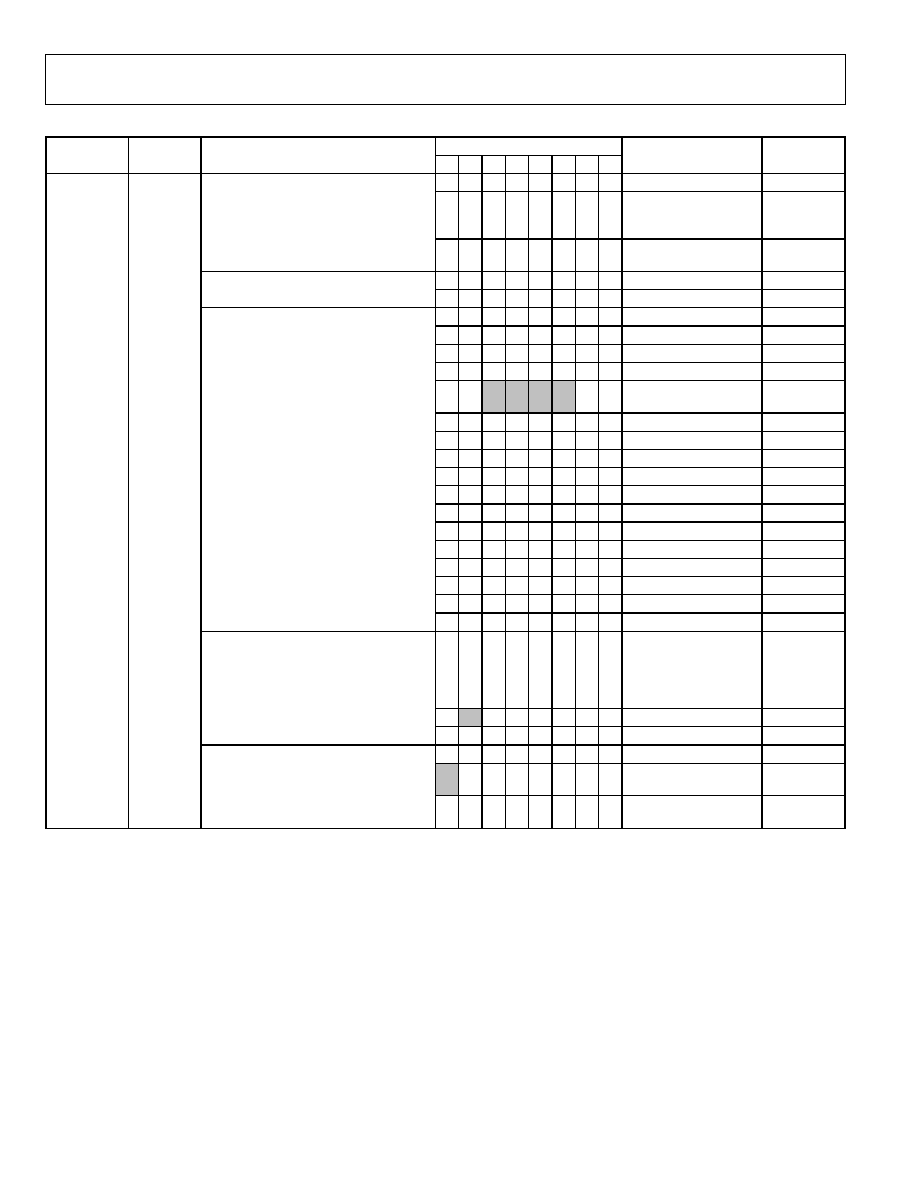
ADV7183A
Rev. A | Page 72 of 104
Table 177. Register 0x03
Bit
Subaddress Register Bit
Description
7 6 5 4 3 2 1 0 Register Setting
Comments
0
AV codes to suit 8-bit
interleaved data
output
SD_DUP_AV. Duplicates the AV codes
from the Luma into the chroma path.
1
AV codes duplicated
(for 16-bit interfaces)
0
Set as default
Reserved
0
0
0
0
Reserved
0
0
0
1
Reserved
0
1
1
0
16-bit
@
LLC1
4:2:2
0
0
1
1
8-bit
@
LLC1
4:2:2
ITU-R BT.656
0
1
0
0
Not
used
0
1
0
1
Not
used
0
1
1
0
Not
used
0
1
1
1
Not
used
1
0
0
0
Not
used
1
0
0
1
Not
used
1
0
1
0
Not
used
1
0
1
1
Not
used
1
1
0
0
Not
used
1
1
0
1
Not
used
1
1
1
0
Not
used
OF_SEL [3:0]. Allows the user to choose
from a set of output formats.
1
1
1
1
Not
used
See also
TIM_OE
(
Table 178
);
TRI_LLC
(
Table 180
)
0
Output pins enabled
TOD. Three-State Output Drivers. This bit
allows the user to three-state the output
drivers: P[19:0], HS, VS, FIELD, and SFL.
1
Drivers
three-stated
0
All
lines
filtered
and
scaled
0x03 Output
Control
VBI_EN. Allows VBI data (Lines 1 to 21)
to be passed through with only a
minimum amount of filtering performed.
1
Only active video
region filtered
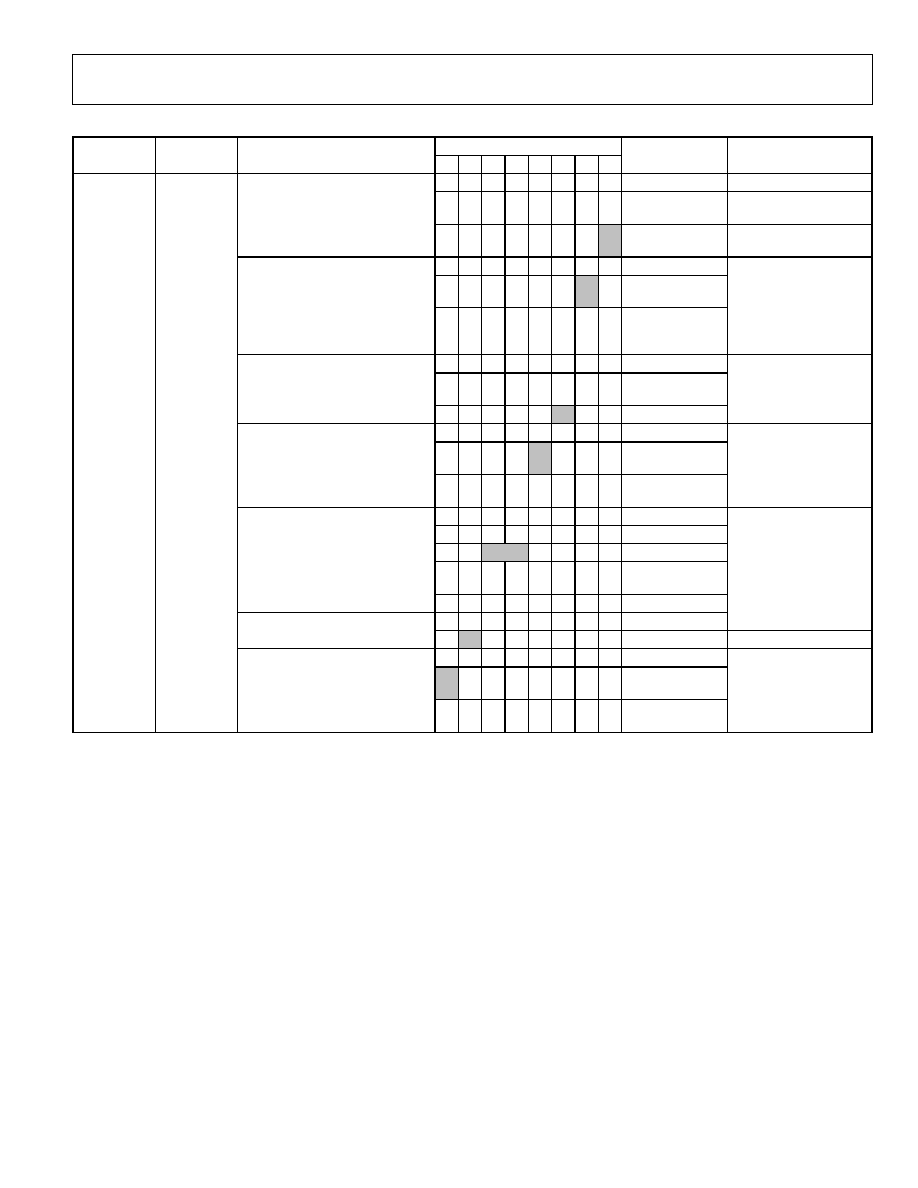
ADV7183A
Rev. A | Page 73 of 104
Table 178. Register 0x04
Bit
Subaddress Register
Bit
Description
7 6 5 4 3 2 1 0
Register
Setting
Comments
0
16
<
Y
<
235,
16 < C < 240
ITU-R BT.656
RANGE. Allows the user to select
the range of output values. Can
be BT656 compliant, or can fill the
whole accessible number range.
1
1 < Y < 254,
1 < C < 254
Extended Range
0
SFL output is
disabled
EN_SFL_PIN
1
SFL information
output on the
SFL pin
SFL output enables
encoder and decoder to
be connected directly.
0
Decode and
output color
BL_C_VBI. Blank Chroma during
VBI. If set, enables data in the VBI
region to be passed through the
decoder undistorted.
1
Blank Cr and Cb
During VBI
0
HS, VS, F three-
stated
TIM_OE. Timing signals output
enable.
1
HS, VS, F forced
active
Controlled by TOD
0
0
Low
drive,
1×
0
1
Medium-low, 2×
1
0
Medium-high,
3×
DR_STR[1:0]. Drive strength of
output drivers can be increased or
decreased for EMC or crosstalk
reasons.
1
1
High
drive,
4×
Recommended
Reserved
1
Set
to
default
0
BT656-3
compatible
0x04 Extended
Output
Control
BT656-4. Allows the user to select
an output mode compatible with
ITU- R BT656-3/4.
1
BT656-4
compatible
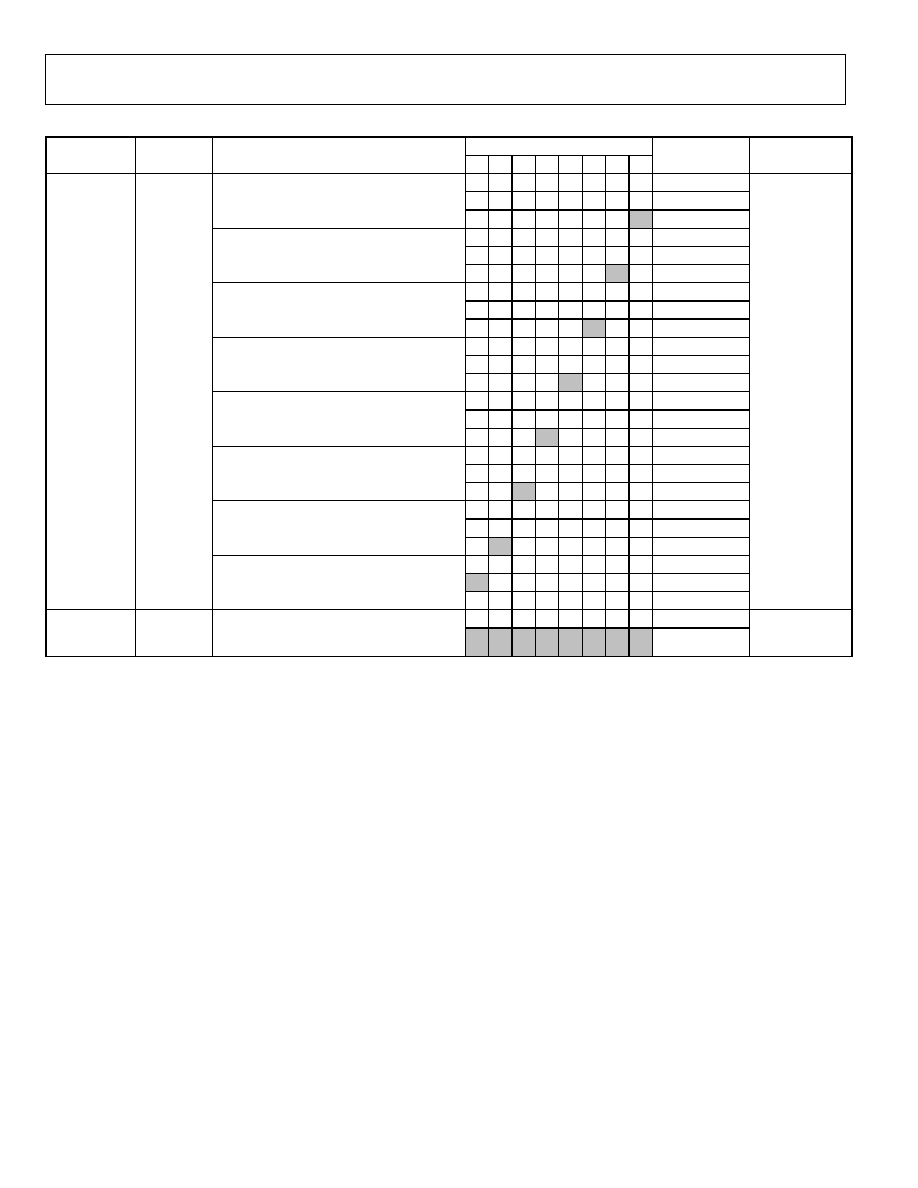
ADV7183A
Rev. A | Page 74 of 104
Table 179. Register 0x07 and 0x08
Bit
Subaddress Register Bit
Description
7 6 5 4 3 2 1 0
Register
Setting
Comments
0
Disable
AD_PAL_EN. PAL B/G/I/H autodetect
enable.
1 Enable
0
Disable
AD_NTSC_EN. NTSC autodetect enable.
1 Enable
0
Disable
AD_PALM_EN. PAL M autodetect enable.
1
Enable
0
Disable
AD_PALN_EN. PAL N autodetect enable.
1
Enable
0
Disable
AD_P60_EN. PAL 60 autodetect enable.
1
Enable
0
Disable
AD_N443_EN. NTSC443 autodetect enable.
1
Enable
0
Disable
AD_SECAM_EN. SECAM autodetect enable.
1
Enable
0
Disable
0x07 Autodetect
Enable
AD_SEC525_EN. SECAM 525 autodetect
enable.
1
Enable
0x08 Contrast
Register
CON[7:0]. Contrast adjust. This is the user
control for contrast adjustment.
1
0
0
0
0
0
0
0
Luma gain = 1
0x00 Gain = 0;
0x80 Gain = 1;
0xFF Gain = 2

ADV7183A
Rev. A | Page 75 of 104
Table 180. Register 0x09 to 0x0E
Bit
Subaddress Register
Bit
Description
7 6 5 4 3 2 1 0 Register
Setting
Comments
0x09
Reserved
(Saturation)
Reserved
1
0
0
0
0
0
0
0
0x0A
Brightness
Register
BRI[7:0]. This register controls
the brightness of the video
signal.
0
0
0
0
0
0
0
0
0x00 = 0IRE;
0x7F = 100IRE;
0xFF = 100IRE
0x0B
Hue Register
HUE[7:0]. This register
contains the value for the color
hue adjustment.
0
0
0
0
0
0
0
0
Hue range =
90° to +90°
0x0C
Default Value Y
0
Free Run mode
dependent on
DEF_VAL_AUTO_EN
DEF_VAL_EN. Default value
enable.
1
Force SDP Free Run
mode on and output
blue screen
0
Disable SDP Free Run
mode
DEF_VAL_AUTO_EN. Default
value.
1 Enable
Automatic
Free
Run mode (blue
screen)
When lock is lost,
Free Run mode
can be enabled
to output stable
timing, clock,
and a set color.
DEF_Y[5:0]. Default value Y.
This register holds the Y
default value.
0
0
1
1
0
1
Y[7:0]
=
{DEF_Y[5:0],
0, 0, 0, 0}
Default Y value
output in free-
run mode.
0x0D
Default
Value
C
Cr[7:0]
=
{DEF_C[7:4],
0, 0, 0, 0, 0, 0}
Cb[7:0] = {DEF_C[3:0],
0, 0, 0, 0, 0, 0}
DEF_C[7:0]. Default value C. Cr
and Cb default values are
defined in this register.
0
1
1
1
1
1
0
0
Default Cb/Cr
value output in
Free Run mode.
Default values
give blue screen
output.
0x0E
ADI Control
0
0
Low drive strength
(1×)
0
1 Medium-low
(2×)
1
0
Medium-high (3×)
DR_STR_S[1:0]. Select the
drive strength of the sync
signals. HS, VS, and F can be
increased or decreased for
EMC or crosstalk reasons.
1
1
High drive strength
(4×)
0
0
Low drive strength
(1×)
0
1
Medium-low
(2×)
1
0
Medium-high (3×)
DR_STR_C[1:0]. Select the
strength of the clock signal
output driver. Can be
increased or decreased for
EMC or crosstalk reasons.
1
1
High drive strength
(4×)
Reserved
0
0
Set as default
0
LLC pin active
TRI_LLC. Enables the LLC pin
to be three-stated.
1
LLC pin drivers three-
stated
See TOD
(
Table 177
);
TIM_OE
(
Table 178
).
Reserved
0
Set
as
default

ADV7183A
Rev. A | Page 76 of 104
Table 181. Register 0x0F to 0x11
Bit
Subaddress Register
Bit
Description
7 6 5 4 3 2 1 0 Register
Setting
Comments
0x0F
Reserved
Power
Management
0
0
Set to default
0
Chip
power-down
controlled by pin
PDBP. Power-down bit
priority selects between
PWRDN bit or PIN.
1
Bit has priority (pin
disregarded)
Reserved
0
0
Set
to
default
0
System
functional
PWRDN. Power-down places
the decoder in a full power-
down mode.
1
Powered down
See PDBP, 0x0F
Bit 2.
Reserved
0
Set
to
default
RES. Chip Reset will load all
I
2
C bits with default values.
0
Normal
operation
1
Start reset sequence
Executing reset
takes approx. 2 ms.
This bit is self-
clearing.
0x10
STATUS_1[7:0]. Provides
information about the
internal status of the
decoder.
x
In lock (right now) = 1
Status Register
Read-Only
x
Lost
lock
(since
last
read)
x
Fsc lock (right now) = 1
STATUS_1[3:0]
x
Peak white AGC mode
active = 1
0
0
0
NTSM-MJ
0
0
1
NTSC-443
0
1
0
PAL-M
0
1
1
PAL-60
1
0
0
PAL-BGHID
1
0
1
SECAM
1
1
0
PAL
combination
N
STATUS_1[6:4]
AD_RESULT[2:0].
Autodetection result reports
the findings.
1
1
1
SECAM
525
Detected standard.
STATUS_1[7] COL_KILL.
Color Kill.
x
Color kill is active = 1
0x11
Info Register
Read-Only
IDENT[7:0] Provides
identification on the revision
of the part.
x x x x x x x x

ADV7183A
Rev. A | Page 77 of 104
Table 182. Register 0x12 to 0x13
Bit
Subaddress Register
Bit
Description
7 6 5 4 3 2 1 0 Register
Setting Comments
0x12
STATUS_2[7:0]. Provides
information about the internal status
of the decoder.
STATUS_2[5:0]
x
MV color striping
detected
1 = Detected
x
MV color striping
type
0 = Type 2,
1 = Type 3
x
MV pseudosync
detected
1 = Detected
x
MV AGC pulses
detected
1 = Detected
x
Nonstandard line
length
1 = Detected
x
Fsc frequency
nonstandard
1 = Detected
Status Register 2.
Read-Only.
Reserved
x
x
0x13
x
1 = horizontal
lock achieved
Unfiltered
x x
x
1
=
Reserved
bits No
function
x
1 = Free Run
mode active
Blue screen
output
x
1 = Field length
standard
Status Register 3.
Read-Only.
STATUS_3[7:0]. Provides
information about the internal status
of the decoder.
x
1 = Swinging
burst detected
Reliable
sequence
Table 183. Register 0x14
Bit
Subaddress Register
Bit
Description
7 6 5 4 3 2 1 0 Register
Setting
0x14
Reserved
0
0
1
0
Reserved. Set to default.
0
I
sources
switched
off
CCLEN. Current clamp enable allows the user to
switch off the current sources in the analog front.
1
I
sources
enabled
Reserved
0
Reserved
set
to
default
Analog Clamp
Control
Reserved
0
0
Reserved
set
to
default
Table 184. Register 0x15
Bit
Subaddress Register
Bit
Description
7 6 5 4 3 2 1 0 Register
Setting
Reserved
x x x x x Set
to
default
0
0
Slow
(TC
=
1
s)
0
1
Medium
(TC
=
0.5
s)
1
0
Fast
(TC
=
0.1
s)
DCT[1:0]. Digital clamp timing determines the
time constant of the digital fine clamp circuitry.
1
1
TC dependant on video
Reserved
0x15h Digital
Clamp
Control 1
0
Set
to
default
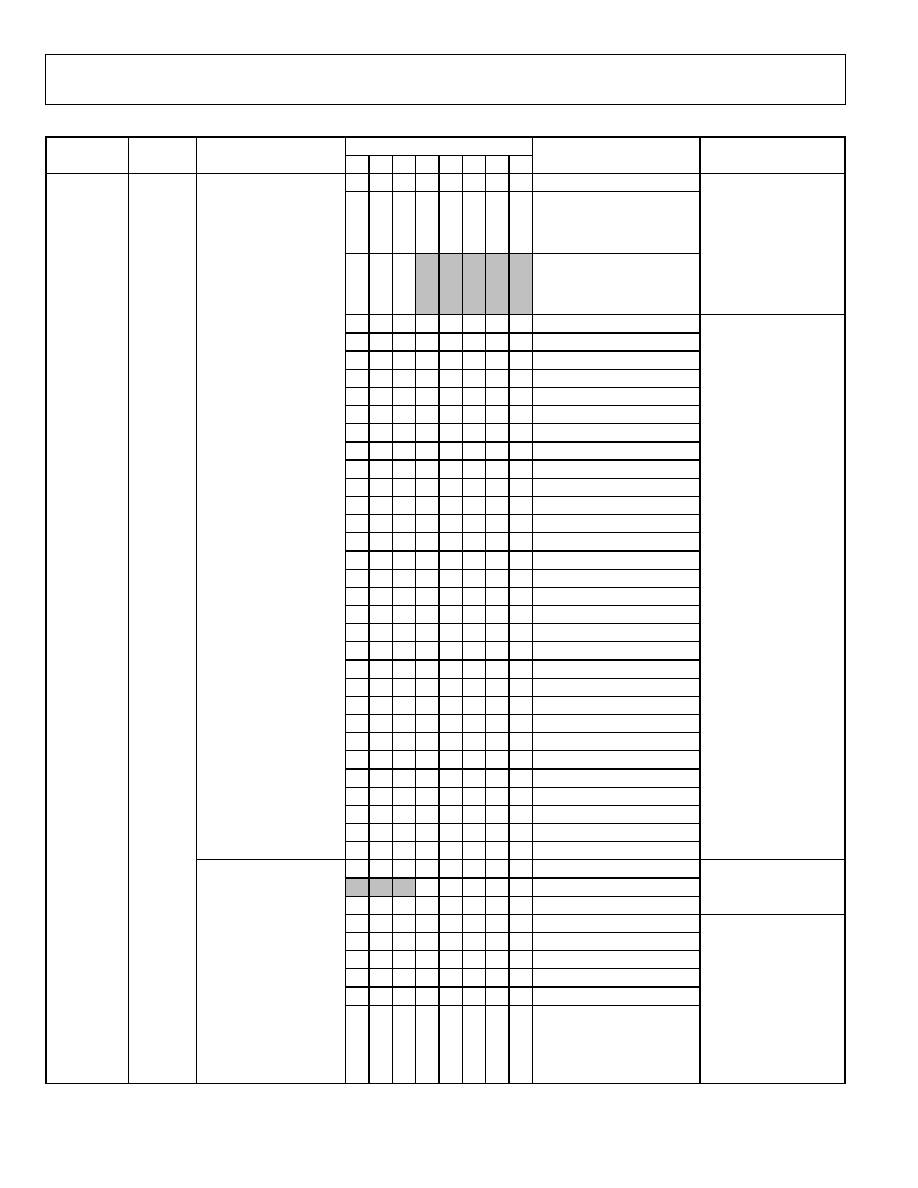
ADV7183A
Rev. A | Page 78 of 104
Table 185. Register 0x17
Bit
Subaddress Register Bit
Description
7 6 5 4 3 2 1 0 Register Setting
Comments
0x17
0 0 0 0 0 Auto
wide
notch
for
poor
quality sources or wide-
band filter with Comb for
good quality input
0
0
0
0
1
Auto narrow notch for poor
quality sources or wideband
filter with comb for good
quality input
Decoder selects
optimum Y shaping
filter depending on
CVBS quality.
Shaping
Filter
Control
0 0 0 1 0 SVHS
1
0 0 0 1 1 SVHS
2
0 0 1 0 0 SVHS
3
0 0 1 0 1 SVHS
4
0 0 1 1 0 SVHS
5
0 0 1 1 1 SVHS
6
0 1 0 0 0 SVHS
7
0 1 0 0 1 SVHS
8
0 1 0 1 0 SVHS
9
0 1 0 1 1 SVHS
10
0 1 1 0 0 SVHS
11
0 1 1 0 1 SVHS
12
0 1 1 1 0 SVHS
13
0 1 1 1 1 SVHS
14
1 0 0 0 0 SVHS
15
1 0 0 0 1 SVHS
16
1 0 0 1 0 SVHS
17
1 0 0 1 1 SVHS
18
(CCIR601)
1 0 1 0 0 PAL
NN1
1 0 1 0 1 PAL
NN2
1 0 1 1 0 PAL
NN3
1 0 1 1 1 PAL
WN
1
1 1 0 0 0 PAL
WN
2
1 1 0 0 1 NTSC
NN1
1 1 0 1 0 NTSC
NN2
1 1 0 1 1 NTSC
NN3
1 1 1 0 0 NTSC
WN1
1 1 1 0 1 NTSC
WN2
1 1 1 1 0 NTSC
WN3
YSFM[4:0]. Selects Y
Shaping Filter mode
when in CVBS only
mode. Allows the user to
select a wide range of
low-pass and notch
filters.
If either auto mode is
selected, the decoder
selects the optimum Y
filter depending on the
CVBS video source
quality (good vs. bad).
1 1 1 1 1 Reserved
If one of these modes is
selected. The decoder
does not change filter
modes depending on
video quality, a fixed
filter response (the one
selected) is used for
good and bad quality
video.
0
0
0
Auto selection 15. MHz
0
0
1
Auto
selection
2.17
MHz
Automatically selects a
C filter based on video
standard and quality.
0
1
0
SH1
0
1
1
SH2
1
0
0
SH3
1
0
1
SH4
1
1
0
SH5
CSFM[2:0]. C Shaping
Filter mode allows the
selection from a range of
low-pass chrominance
filters.
If either auto mode is
selected, the decoder
selects the optimum C
filter depending on the
CVBS video source
quality (good vs. bad).
Non auto settings force a
C filter for all standards
and quality of CVBS
video.
1
1
1
Wideband
mode
Selects a C filter for all
video standards and for
good and bad video.
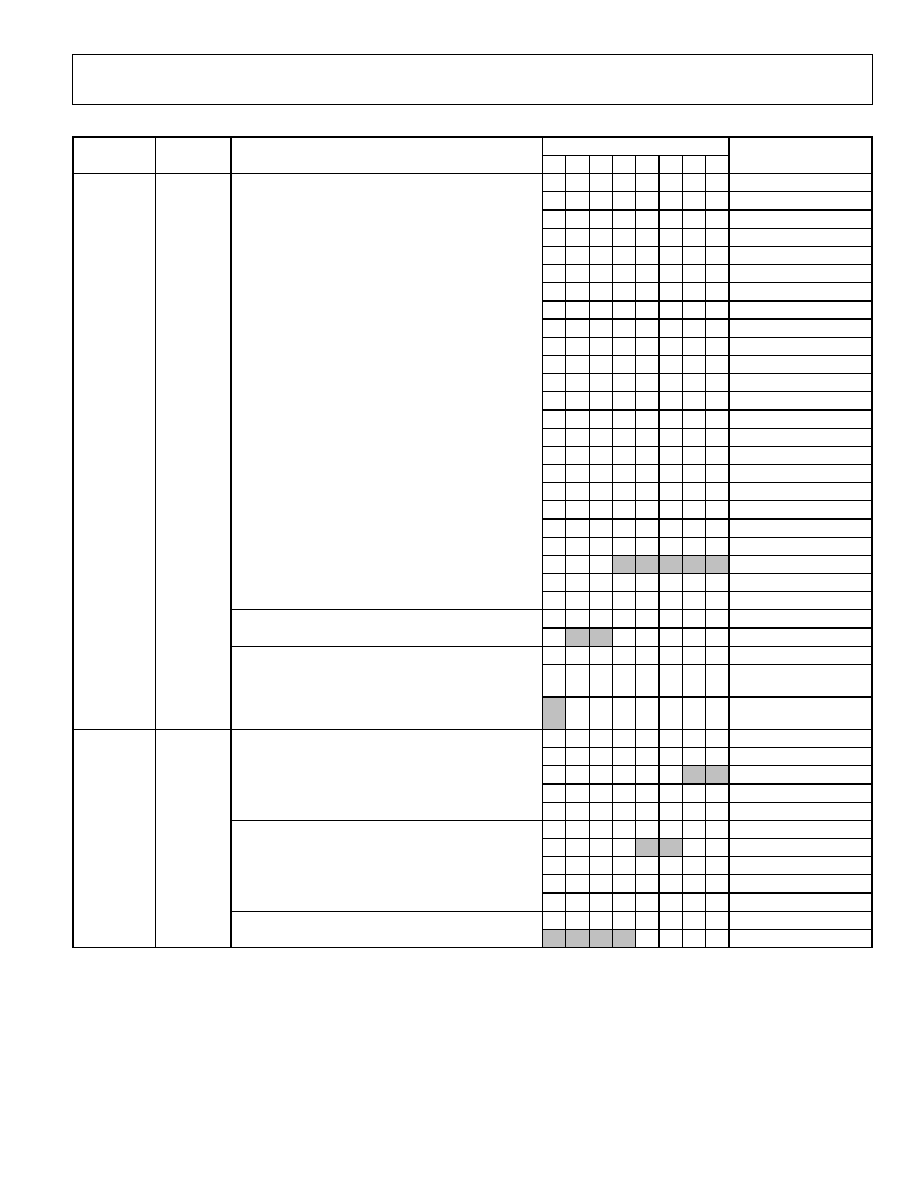
ADV7183A
Rev. A | Page 79 of 104
Table 186. Register 0x18 to 0x19
Bit
Subaddress Register Bit
Description
7 6 5 4 3 2 1 0 Comments
0x18
0 0 0 0 0 Reserved.
Do
not
use.
Shaping
Filter
Control 2
0 0 0 0 1 Reserved.
Do
not
use.
0 0 0 1 0 SVHS
1
0 0 0 1 1 SVHS
2
0 0 1 0 0 SVHS
3
0
0
1
0
1
SVHS
4
0 0 1 1 0 SVHS
5
0 0 1 1 1 SVHS
6
0 1 0 0 0 SVHS
7
0 1 0 0 1 SVHS
8
0 1 0 1 0 SVHS
9
0 1 0 1 1 SVHS
10
0 1 1 0 0 SVHS
11
0 1 1 0 1 SVHS
12
0 1 1 1 0 SVHS
13
0 1 1 1 1 SVHS
14
1 0 0 0 0 SVHS
15
1 0 0 0 1 SVHS
16
1 0 0 1 0 SVHS
17
1 0 0 1 1 SVHS
18
(CCIR
601)
1
0
1
0
0
Reserved. Do not use.
Reserved. Do not use.
WYSFM[4:0]. Wideband Y Shaping Filter mode allows
the user to select which Y shaping filter is used for the Y
component of Y/C, YPbPr, B/W input signals; it is also
used when a good quality input CVBS signal is
detected. For all other inputs, the Y shaping filter
chosen is controlled by YSFM[4:0].
1 1 1 1 1 Reserved.
Do
not
use.
Reserved
0
0
Set
to
default
0
Manual select filter
using WYSFM[4:0]
WYSFMOVR. Enables the use of automatic WYSFN
filter.
1
Auto selection of best
filter
0x19
0
0
Narrow
Comb
Filter
Control
0
1 Medium
1
0
Wide
PSFSEL[1:0]. Controls the signal bandwidth that is fed
to the comb filters (PAL).
1
1
Widest
0
0
Narrow
0
1
Medium
1
0
Medium
NSFSEL[1:0]. Controls the signal bandwidth that is fed
to the comb filters (NTSC).
1
1
Wide
Reserved
1
1
1
1
Set
as
default

ADV7183A
Rev. A | Page 80 of 104
Table 187. Register 0x27 to 0x2A
Bit
Subaddress Register Bit
Description
7 6 5 4 3 2 1 0 Comments
Notes
0x27
0
0
No Delay
0
1
Luma 1 clk (37 ns) delayed
Pixel
Delay
Control
1
0
Luma 2 clk (72 ns) early
LTA[1:0]. Luma timing adjust
allows the user to specify a
timing difference between
chroma and luma samples.
0
1
Luma 1 clk (37 ns) early
CVBS mode
LTA[1:0] = 00b;
S-Video mode
LTA[1:0]= 01b,
YPrPb mode
LTA[1:0] = 01b
Reserved
0
Set to 0
0
0
0
Not
a
valid
setting
0
0
1
Chroma
+
2
pixels
(early)
0
1
0
Chroma
+
1
pixel
(early)
0
1
1
No Delay
1
0
0
Chroma
1
pixel
(late)
1
0
1
Chroma
2
pixels
(late)
1
1
0
Chroma
3
pixels
(late)
CTA[2:0]. Chroma timing
adjust allows a specified
timing difference between
the luma and chroma
samples.
1
1
1
Not
a
valid
setting
CVBS mode
CTA[2:0] = 011b,
S-Video mode
CTA[2:0] = 101b,
YPrPb mode
CTA[2:0] = 110b
0
Use values in LTA[1:0] and
CTA[2:0] for delaying
luma/chroma
AUTO_PDC_EN.
Automatically programs the
LTA/CTA values so that luma
and chroma are aligned at the
output for all modes of
operation.
1
LTA and CTA values
determined automatically
0
No swapping
SWPC. Allows the Cr and Cb
samples to be swapped.
1
Swap the Cr and Cb
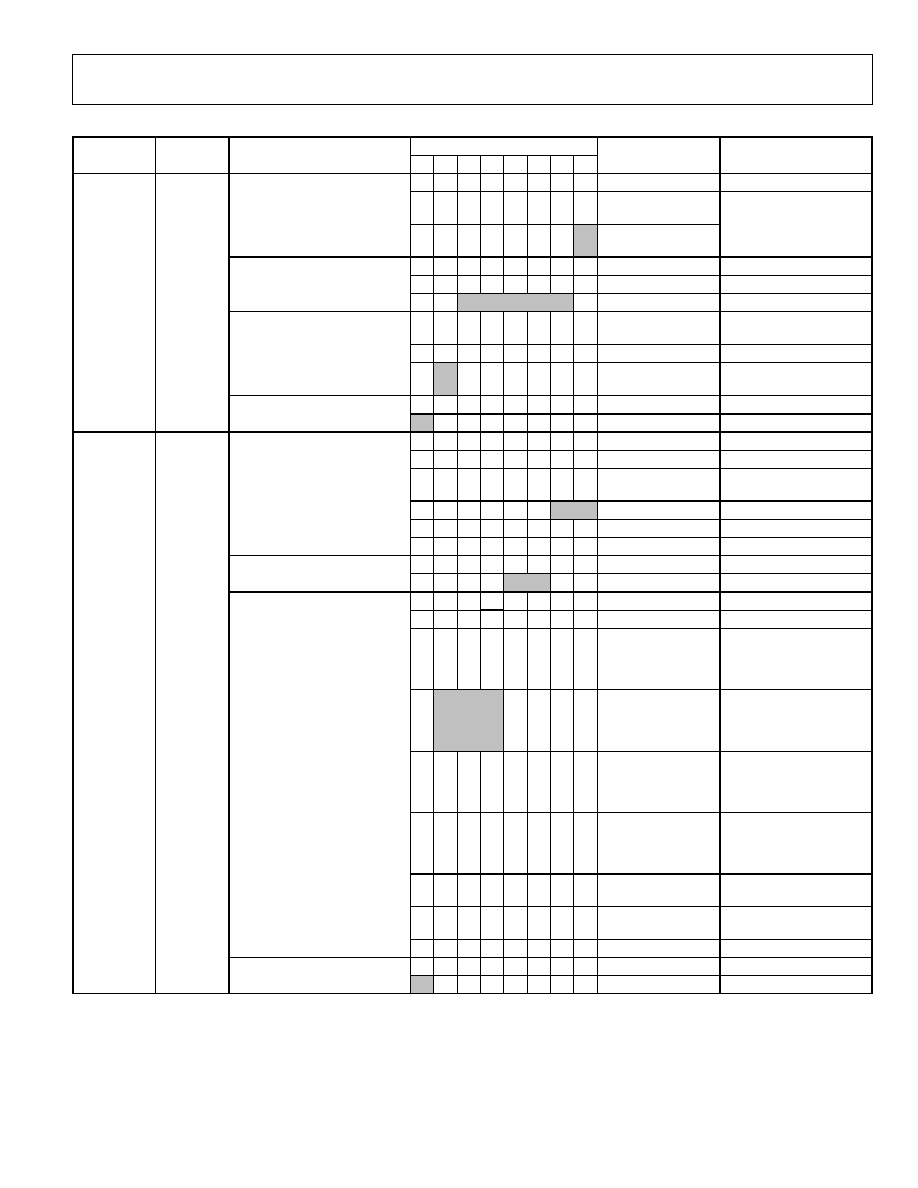
ADV7183A
Rev. A | Page 81 of 104
Table 188. Register 0x2B to 0x2C
Bit
Subaddress Register Bit
Description
7 6 5 4 3 2 1 0 Comments
Notes
0x2B
0
Update once per
video line
PW_UPD. Peak white update
determines the rate of gain.
1
Update once per
field
Peak white must be
enabled. See LAGC[2:0]
0
Reserved
1
0
0
0
1
Set to default
For SECAM color kill,
threshold is set at 8%
0
Color kill disabled
CKE. Color kill enable allows
the color kill function to be
switched on and off.
1
Color
kill
enabled See
CKILLTHR[2:0]
(
Table 196
)
Misc Gain
Control
Reserved
1
1
1
Set
to
default
0x2C
0
0
Manual
fixed
gain Use
CMG[11:0]
0
1
Use luma gain for
chroma
1
0
Automatic gain
Based on color burst
1
1
Freeze chroma gain
CAGC[1:0]. Chroma automatic
gain control selects the basic
mode of operation for the AGC
in the chroma path.
Reserved
1
1
Set
to
1
0
0
0
Manual
fixed
gain Use
LMG[11:0]
0
0
1
AGC
no
override
through white
peak. Man IRE
control.
Blank level to sync tip
0
1
0
AGC
auto-override
through white
peak. Man IRE
control.
Blank level to sync tip
0
1
1
AGC
no
override
through white
peak. Auto IRE
control.
Blank level to sync tip
1
0
0
AGC
auto-override
through white
peak. Auto IRE
control.
Blank level to sync tip
1
0
1
AGC
active
video
with white peak
1
1
0
AGC
active
video
with average video
LAGC[2:0]. Luma automatic
gain control selects the mode
of operation for the gain
control in the luma path.
1
1
1
Freeze
gain
AGC Mode
Control
Reserved
1
Set
to
1
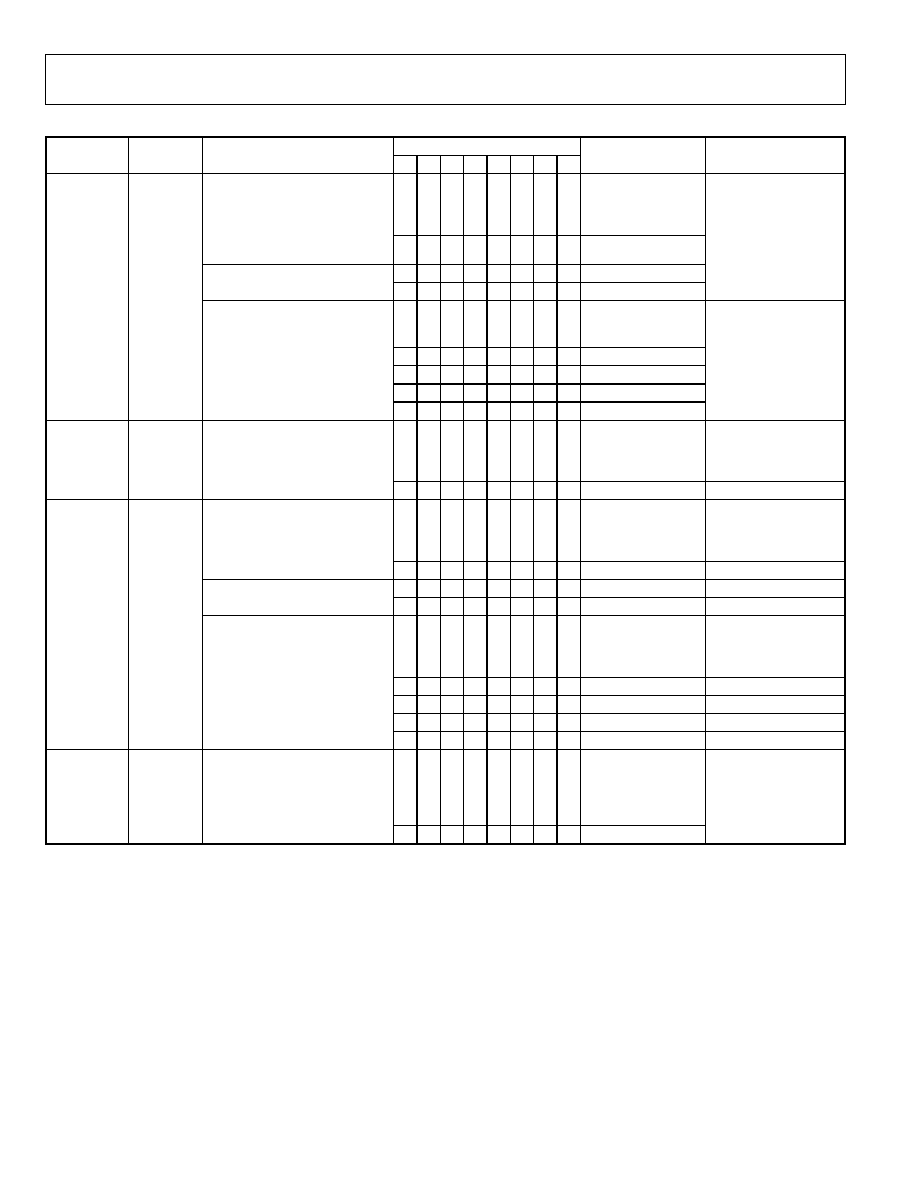
ADV7183A
Rev. A | Page 82 of 104
Table 189. Register 0x2D to 0x30
Bit
Subaddress Register Bit
Description
7 6 5 4 3 2 1 0 Comments
Notes
CAGC[1:0] settings
decide in which
mode CMG[11:0]
operates
CMG[11:8]. Chroma manual
gain can be used to program a
desired manual chroma gain.
Reading back from this register
in AGC mode gives the current
gain.
0
1
0
0
Reserved
1
1
Set
to
1
Has an effect only if
CAGC[1:0] is set to
auto gain (10)
0
0
Slow
(TC
=
2
s)
0
1
Medium
(TC
=
1
s)
1
0
Fast
(TC
=
0.2
s)
0x2D Chroma
Gain
Control 1
CAGT[1:0]. Chroma automatic
gain timing allows adjustment of
the chroma AGC tracking speed.
1
1
Adaptive
CMG[11:0] = 750d;
gain is 1 in NTSC
CMG[11:0] = 741d;
gain is 1 in PAL
Min value is 0dec
(G = 60 dB)
Max value is 3750
(Gain = 5)
0x2E Chroma
Gain
Control 2
CMG[7:0]. Chroma manual gain
lower 8 bits. See CMG[11:8] for
description.
0 0 0 0 0 0 0 0
LAGC[1:0] settings
decide in which
mode LMG[11:0]
operates
LMG[11:8]. Luma manual gain
can be used program a desired
manual chroma gain, or to read
back the actual gain value used.
x
x
x
x
Reserved
1
1
Set
to
1
Only has an effect if
AGC[1:0] is set to
auto gain (001, 010,
011,or 100)
0
0
Slow
(TC
=
2
s)
0
1
Medium
(TC
=
1
s)
1
0
Fast
(TC
=
0.2
s)
0x2F Luma
Gain
Control 1
LAGT[1:0]. Luma automatic gain
timing allows adjustment of the
luma AGC tracking speed.
1
1
Adaptive
LMG[11:0] =
1234dec; gain is 1 in
NTSC LMG[11:0] =
1266dec; gain is 1 in
PAL
0x30 Luma
Gain
Control 2
LMG[7:0]. Luma manual gain
can be used to program a
desired manual chroma gain or
read back the actual used gain
value.
x x x x x x x x
Min value
NTSC 1024 (G = 0.85)
PAL (G = 0.81)
Max value
NTSC 2468 (G = 2),
PAL = 2532 (G = 2)
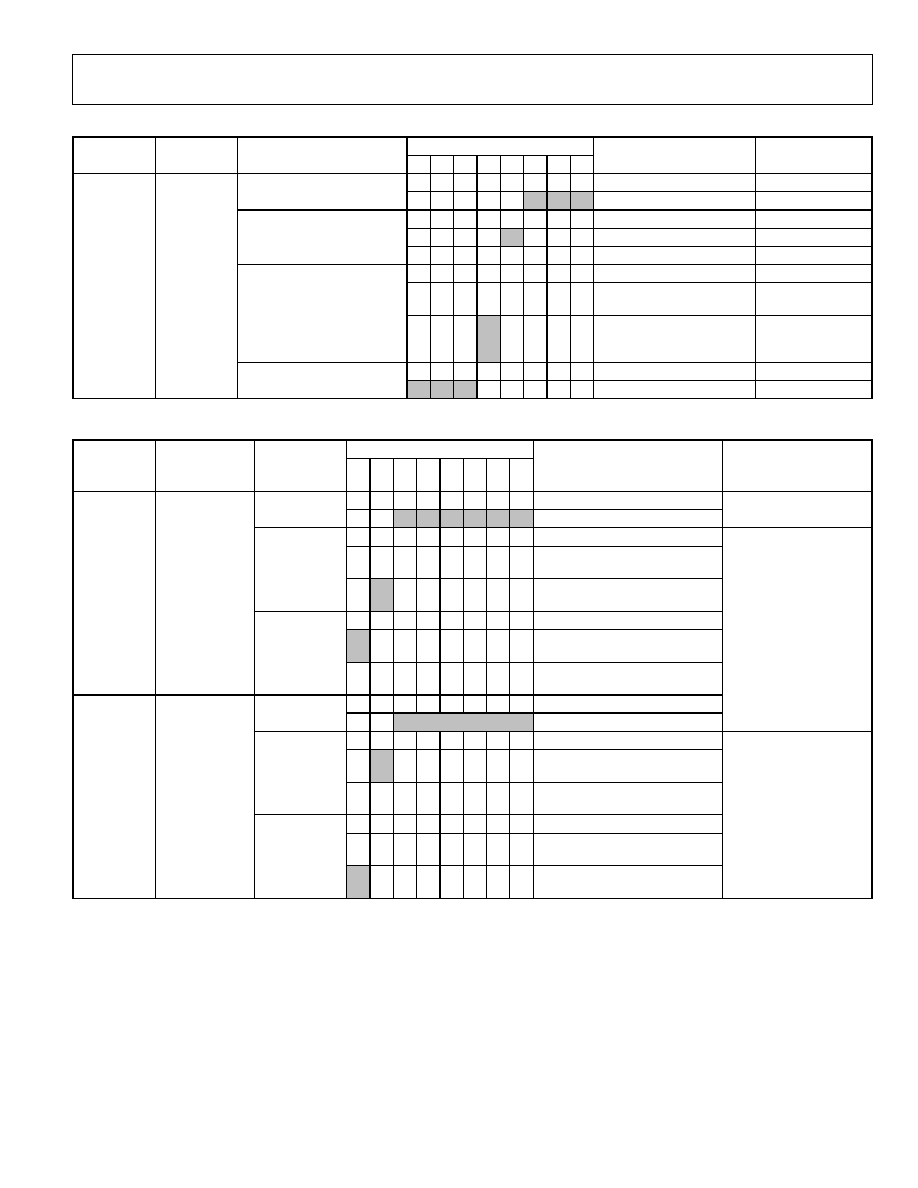
ADV7183A
Rev. A | Page 83 of 104
Table 190. Register 0x31
Bit
Subaddress Register
Bit
Description
7 6 5 4 3 2 1 0 Comments
Notes
0x31
Reserved
0
1
0
Set to default
0
Start of line relative to HSE
HSE = Hsync end
HVSTIM. Selects where
within a line of video the VS
signal is asserted.
1
Start of line relative to HSB
HSB = Hsync begin
0
EAV/SAV codes generated
to suit ADI encoders
NEWAVMODE. Sets the
EAV/SAV mode.
1
Manual
VS/Field
position
controlled by registers
0x32, 0x33, and 0xE50xEA
VS and
FIELD
Control 1
Reserved
0
0
0
Set
to
default
Table 191. Register 0x32 to 0x33
Bit
Subaddress Register
Bit
Description
7 6 5 4 3 2 1 0
Comments Notes
0x32
Reserved
0
0
0
0
0
1
Set to default
VSBHE
0
VS goes high in the middle of
the line (even field)
1
VS
changes
state
at
the
start
of
the line (even field)
VSBHO
0
VS goes high in the middle of
the line (odd field)
VSync Field
Control 2
1
VS
changes
state
at
the
start
of
the line (odd field)
0x33
Reserved
0
0
0
1
0
0
Set to default
NEWAVMODE bit must
be set high
VSEHE
0
VS goes low in the middle of the
line (even field)
1
VS
changes
state
at
the
start
of
the line (even field)
VSEHO
0
VS goes low in the middle of the
line (odd field)
VSync Field
Control 3
1
VS
changes
state
at
the
start
of
the line odd field
NEWAVMODE bit must
be set high
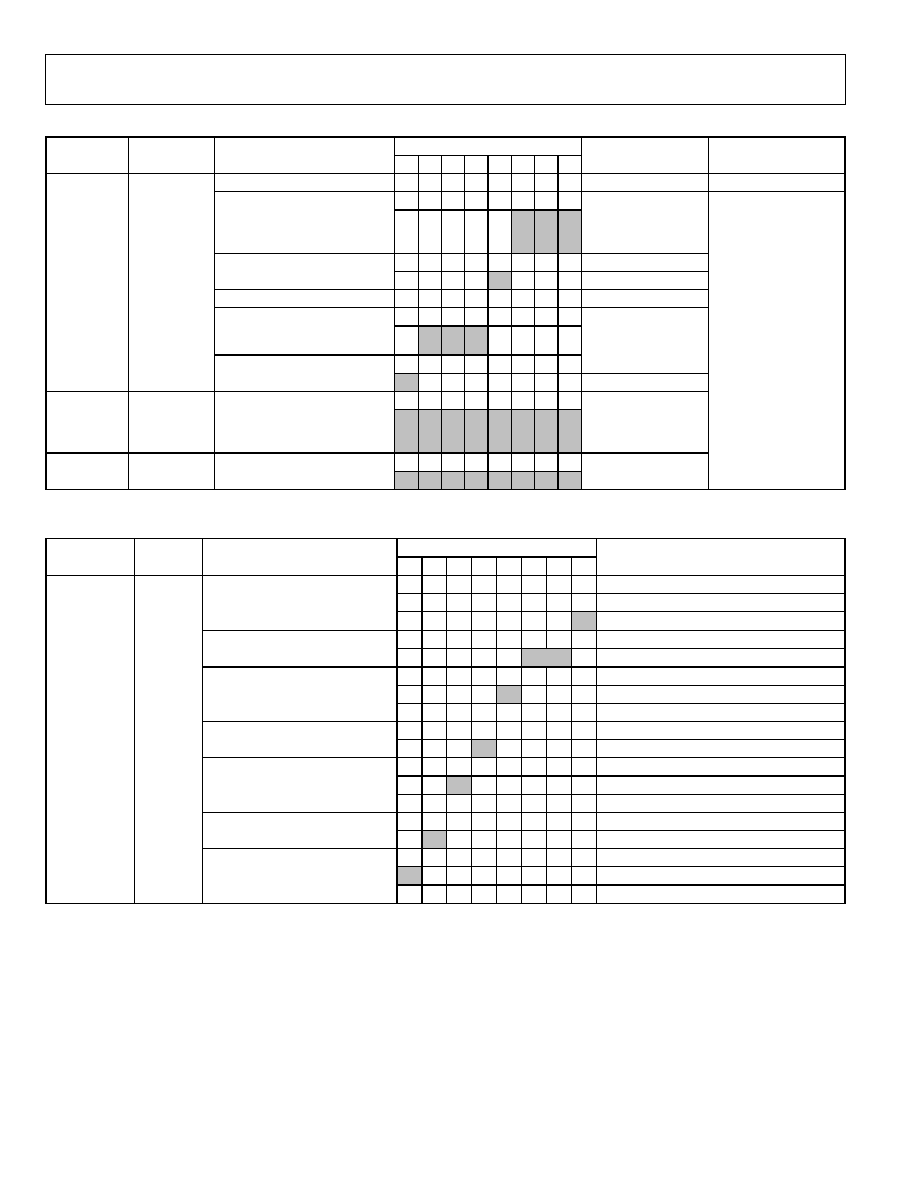
ADV7183A
Rev. A | Page 84 of 104
Table 192. Register 0x34 to 0x36
Bit
Subaddress Register
Bit
Description
7 6 5 4 3 2 1 0 Comments
Notes
0x34
HS Position
Control 1
HSE[10:8]. HS end allows the
positioning of the HS output
within the video line.
0
0
0
HS output ends
HSE[10:0] pixels
after the falling edge
of HSync
Reserved
0
Set
to
0
HSB[10:8]. HS begin allows
the positioning of the HS
output within the video line.
0
0
0
HS output starts
HSB[10:0] pixels
after the falling edge
of HSync
Reserved
0
Set to 0
0x35
HS Position
Control 2
HSB[7:0] See above, using
HSB[9:0] and HSE[9:0], the user
can program the position and
length of HS output signal
0
0
0
0
0
0
1
0
0x36
HS Position
Control 3
HSE[7:0] See above.
0
0
0
0
0
0
0
0
Using HSB and HSE
the user can program
the position and
length of the output
HSync
Table 193. Register 0x37
Bit
Subaddress Register Bit
Description
7 6 5 4 3 2 1 0 Comment
0x37
Polarity
0
Invert
polarity
PCLK. Sets the polarity of LLC1.
1
Normal polarity as per
Timing Diagrams
Reserved
0
0
Set to 0
0
Active
high
PF. Sets the FIELD polarity.
1
Active low
Reserved
0
Set
to
0
0
Active high
PVS. Sets the VS Polarity.
1
Active
low
Reserved
0
Set
to
0
0
Active high
PHS. Sets HS Polarity.
1
Active low
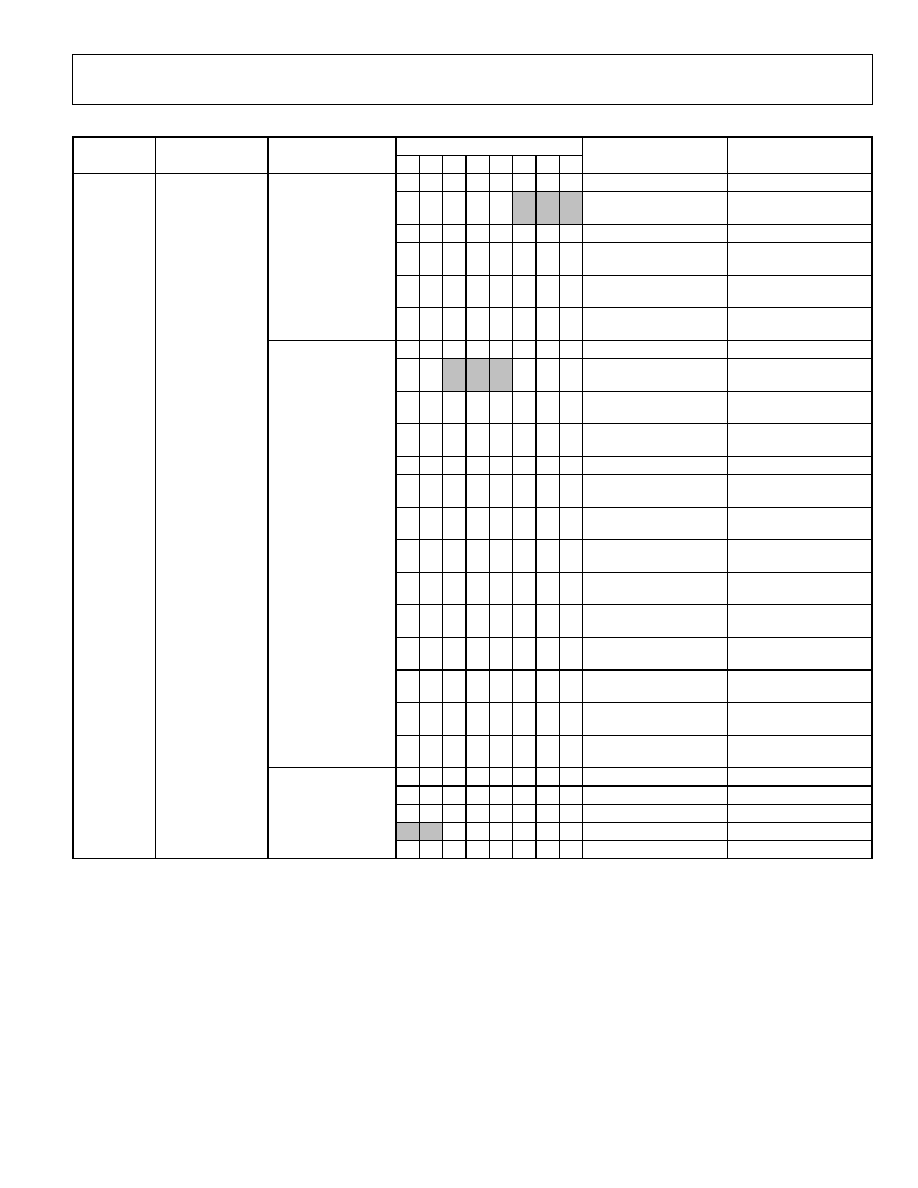
ADV7183A
Rev. A | Page 85 of 104
Table 194. Register 0x38
Bit
Subaddress Register
Bit
Description
7 6 5 4 3 2 1 0 Comments
Notes
0x38
NTSC Comb
Control
0
0
0 Adaptive
3-line,
3-tap
luma
1
0
0
Use
low-pass
notch
1
0
1
Fixed
luma
comb
(2-line)
Top lines of memory
1
1
0
Fixed
luma
comb
(3-Line)
All lines of memory
YCMN[2:0]. Luma
Comb Mode, NTSC.
1
1
1
Fixed
luma
comb
(2-line)
Bottom lines of memory
0
0
0
3-line
adaptive
for
CTAPSN = 01
4-line adaptive for
CTAPSN = 10
5-line adaptive for
CTAPSN = 11
1
0
0
Disable
chroma
comb
1
0
1
Fixed
2-line
for
CTAPSN = 01
Top lines of memory
Fixed 3-line for
CTAPSN = 10
Fixed 4-line for
CTAPSN = 11
1
1
0
Fixed
3-line
for
CTAPSN = 01
All lines of memory
Fixed 4-line for
CTAPSN = 10
Fixed 5-line for
CTAPSN = 11
1
1
1
Fixed
2-line
for
CTAPSN = 01
Bottom lines of memory
Fixed 3-line for
CTAPSN = 10
CCMN[2:0]. Chroma
Comb Mode, NTSC.
Fixed 4-line for
CTAPSN = 11
0
0
Adapts
3
lines
2
lines
0
1
Not used
1
0
Adapts
5
lines
3
lines
CTAPSN[1:0].
Chroma
Comb Taps, NTSC.
1
1
Adapts
5
lines
4
lines

ADV7183A
Rev. A | Page 86 of 104
Table 195. Register 0x39 to 0x3A
Bit
Subaddress Register
Bit
Description
7 6 5 4 3 2 1 0 Comments
Notes
0x39
0
0
0
Adaptive 5-line, 3-tap luma comb
1
0
0
Use
low-pass
notch
1
1
0
Fixed
luma
comb
Top
lines
of
memory
1
1
0
Fixed
luma
comb
(5-line)
All
lines
of
memory
YCMP[2:0]. Luma Comb
mode, PAL.
1
1
1
Fixed
luma
comb
(3-line)
Bottom
lines
of memory
0
0
0
3-line adaptive for CTAPSN = 01
4-line adaptive for CTAPSN = 10
5-line adaptive for CTAPSN = 11
1
0
0
Disable
chroma
comb
1
0
1
Fixed 2-line for CTAPSN = 01
Top lines of
memory
Fixed 3-line for CTAPSN = 10
Fixed 4-line for CTAPSN = 11
1
1
0
Fixed 3-line for CTAPSN = 01
All lines of
memory
Fixed 4-line for CTAPSN = 10
Fixed 5-line for CTAPSN = 11
1
1
1
Fixed 2-line for CTAPSN = 01
Bottom lines
of memory
Fixed 3-line for CTAPSN = 10
CCMP[2:0]. Chroma
Comb mode, PAL.
Fixed 4-line for CTAPSN = 11
0
0
Adapts
5-lines
2
lines
(2
taps)
0
1
Not used
1
0
Adapts 5 lines 3 lines (3 taps)
PAL Comb
Control
CTAPSP[1:0]. Chroma
comb taps, PAL.
1
1
Adapts 5 lines 4 lines (4 taps)
0x3A
Reserved
0
Set as default
0
ADC2 normal operation
PWRDN_ADC_2. Enables
power-down of ADC2.
1
Power down ADC2
0
ADC1
normal
operation
PWRDN_ADC_1. Enables
power-down of ADC1.
1
Power down ADC1
0
ADC0
normal
operation
PWRDN_ADC_0. Enables
power-down of ADC0.
1
Power down ADC0
Reserved
0
0
0
1
Set
as
default
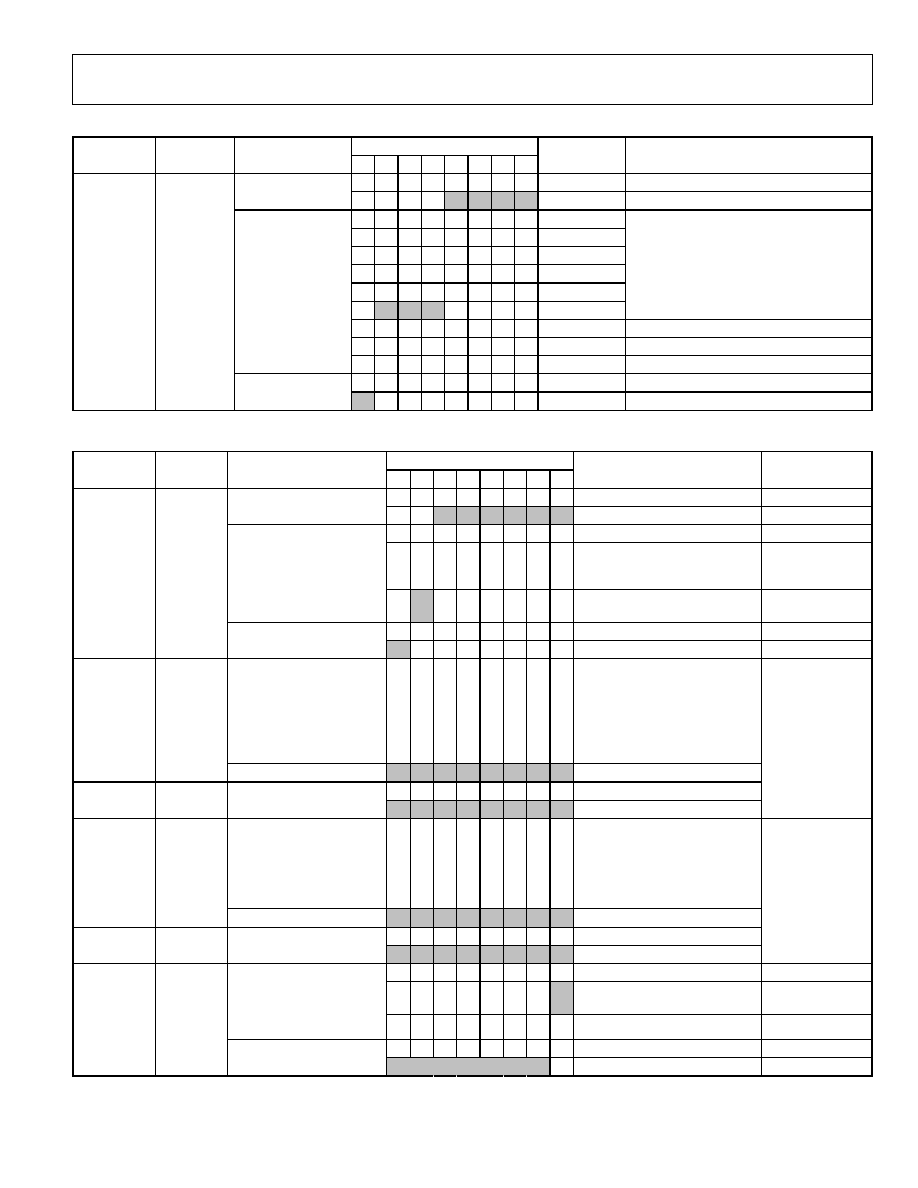
ADV7183A
Rev. A | Page 87 of 104
Table 196. Register 0x3D
Bit
Subaddress Register
Bit
Description
7 6 5 4 3 2 1 0 Comments Notes
Reserved
0
0
1
1
Set to default
CKILLTHR[2:0].
0
0
0
Kill
at
0.5%
0
0
1
Kill
at
1.5%
0
1
0
Kill
at
2.5%
0
1
1
Kill
at
4%
1
0
0
Kill
at
8.5%
CKE = 1 enables the color kill function and
must be enabled for CKILLTHR[2:0] to take
effect.
1
0
1
Kill
at
16%
1
1
0
Kill
at
32%
1
1
1
Reserved
Reserved
0x3D Manual
Window
0
Set
to
default
Table 197. Registers 0x41 to 0x4C
Bit
Subaddress Register Bit
Description
7 6 5 4 3 2 1 0 Comments
Notes
Reserved
0
1
0
0
0
0
Set to default
0
SFL compatible with
ADV7190/ADV7191/ADV7194
encoders
SFL_INV. Controls the
behavior of the PAL switch
bit.
1
SFL compatible with
ADV717x/ADV7173x encoders
0x41 Resample
Control
Reserved
0
Set
to
default
GDECEL[15:0]. 16
individual enable bits that
select the lines of video
(even field lines 1025)
that the decoder checks
for Gemstar compatible
data.
0x48 Gemstar
Control 1
GDECEL[15:8]. See above.
0
0
0
0
0
0
0
0
0x49 Gemstar
Control 2
GDECEL[7:0]. See above.
0
0
0
0
0
0
0
0
LSB = Line 10,
MSB = Line 25,
Default = Do not
check for
Gemstar
compatible data
on any lines [10
25] in even fields
GDECOL[15:0]. 16
individual enable bits that
select the lines of video
(odd field lines 1025) that
the decoder checks for
Gemstar compatible data.
0x4A Gemstar
Control 3
GDECOL[15:8]. See above.
0
0
0
0
0
0
0
0
0x4B Gemstar
Control 4
GDECOL[7:0]. See above.
0
0
0
0
0
0
0
0
LSB = Line 10,
MSB = Line 25,
Default = Do not
check for
Gemstar
compatible data
on any lines [10
25] in odd fields
0
Split data into half byte
To avoid 00/FF
code.
GDECAD. Controls the
manner in which decoded
Gemstar data is inserted
into the horizontal
blanking period.
1
Output
in
straight
8-bit
format
0x4C Gemstar
Control 5
Reserved
x
x
x
x
x
x
x Undefined
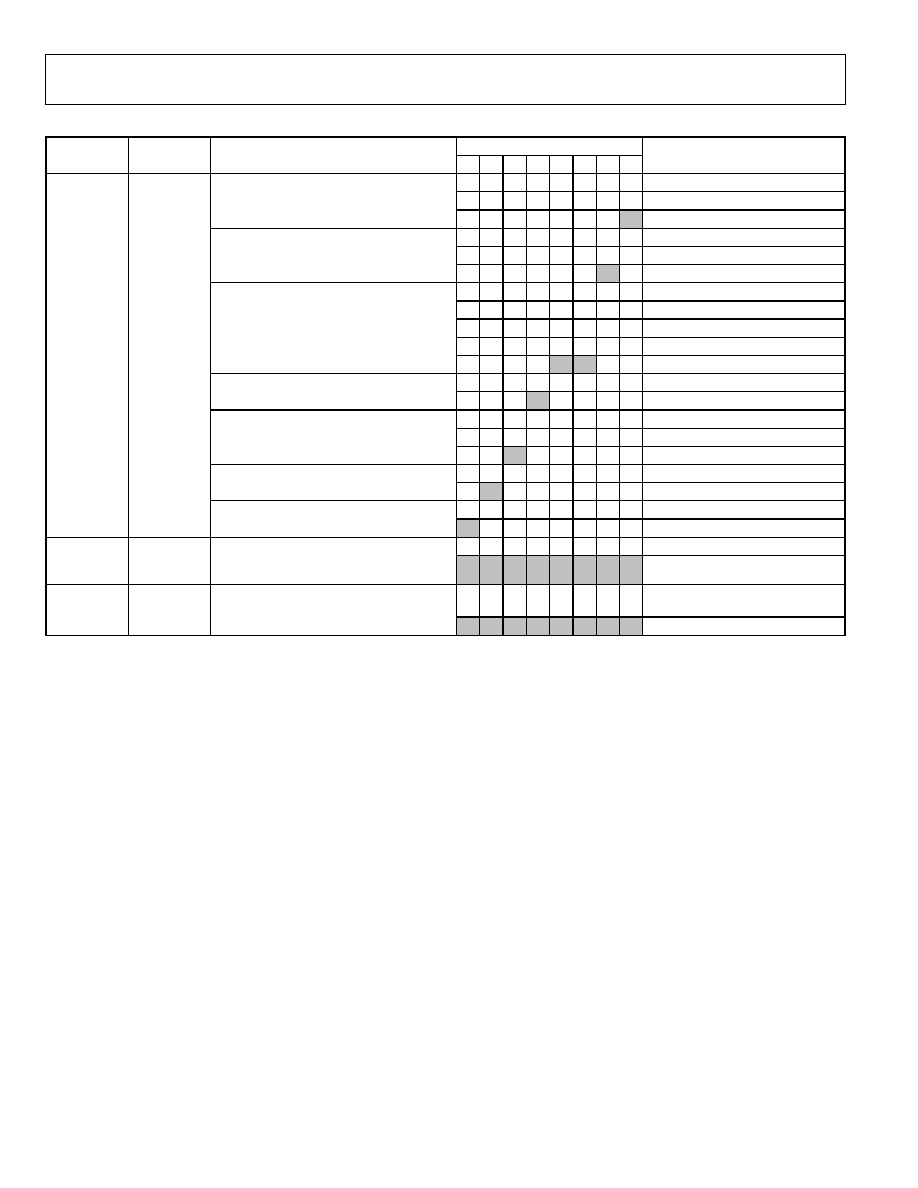
ADV7183A
Rev. A | Page 88 of 104
Table 198. Registers 0x4D to 0x50
Bit
Subaddress Register
Bit
Description
7 6 5 4 3 2 1 0 Comments
0
Disable CTI
CTI_EN. CTI enable
1 Enable
CTI
0
Disable CTI alpha blender
CTI_AB_EN. Enables the mixing of the
transient improved chroma with the
original signal.
1
Enable CTI alpha blender
0
0
Sharpest mixing
0
1
Sharp mixing
1
0
Smooth
CTI_AB[1:0]. Controls the behavior of the
alpha-blend circuitry.
1
1
Smoothest
Reserved
0
Set
to
default
0
Bypass the DNR block
DNR_EN. Enable or bypass the DNR block.
1
Enable the DNR block
Reserved
1
Set
to
default
0x4D CTI
DNR
Control 1
Reserved
1
Set
to
default
0x4E CTI
DNR
Control 2
CTI_CTH[7:0]. Specifies how big the
amplitude step must be to be steepened
by the CTI block.
0
0
0
0
1
0
0
0
Set
to
0x04
for
A/V
input;
set
to
0x0A for tuner input
0x50 CTI
DNR
Control 4
DNR_TH[7:0]. Specifies the maximum
edge that is interpreted as noise and is
therefore blanked.
0
0
0
0
1
0
0
0

ADV7183A
Rev. A | Page 89 of 104
Table 199. Register 0x51
Bit
Subaddress Register Bit
Description
7 6 5 4 3 2 1 0 Comments
Notes
0
0
0
1
line
of
video
0
0
1
2
lines
of
video
0
1
0
5
lines
of
video
0
1
1
10
lines
of
video
1
0
0
100 lines of video
1
0
1
500
lines
of
video
1
1
0
1000
lines
of
video
CIL[2:0]. Count-into-lock
determines the number of lines
the system must remain in lock
before showing a locked status.
1
1
1
100000
lines
of
video
0
0
0
1 line of video
0
0
1
2 lines of video
0
1
0
5 lines of video
0 1 1 10
lines
of
video
1
0
0
100 lines of video
1 0 1 500
lines
of
video
1 1 0 1000
lines
of
video
COL[2:0]. Count-out-of-lock
determines the number of lines
the system must remain out-of-
lock before showing a lost-
locked status.
1 1 1 100000
lines
of
video
0
Over field with vertical
info
SRLS. Select raw lock signal.
Selects the determination of
the lock. Status.
1
Line-to-line evaluation
Operational only for
SDP modes.
FSCLE must be set to
0 in YPrPb mode if a
reliable LOST_LOCK
bit is set to 0.
0
Lock status set only by
horizontal lock
0x51 Lock
Count
FSCLE. Fsc Lock Enable.
1
Lock status set by
horizontal lock and
subcarrier lock.
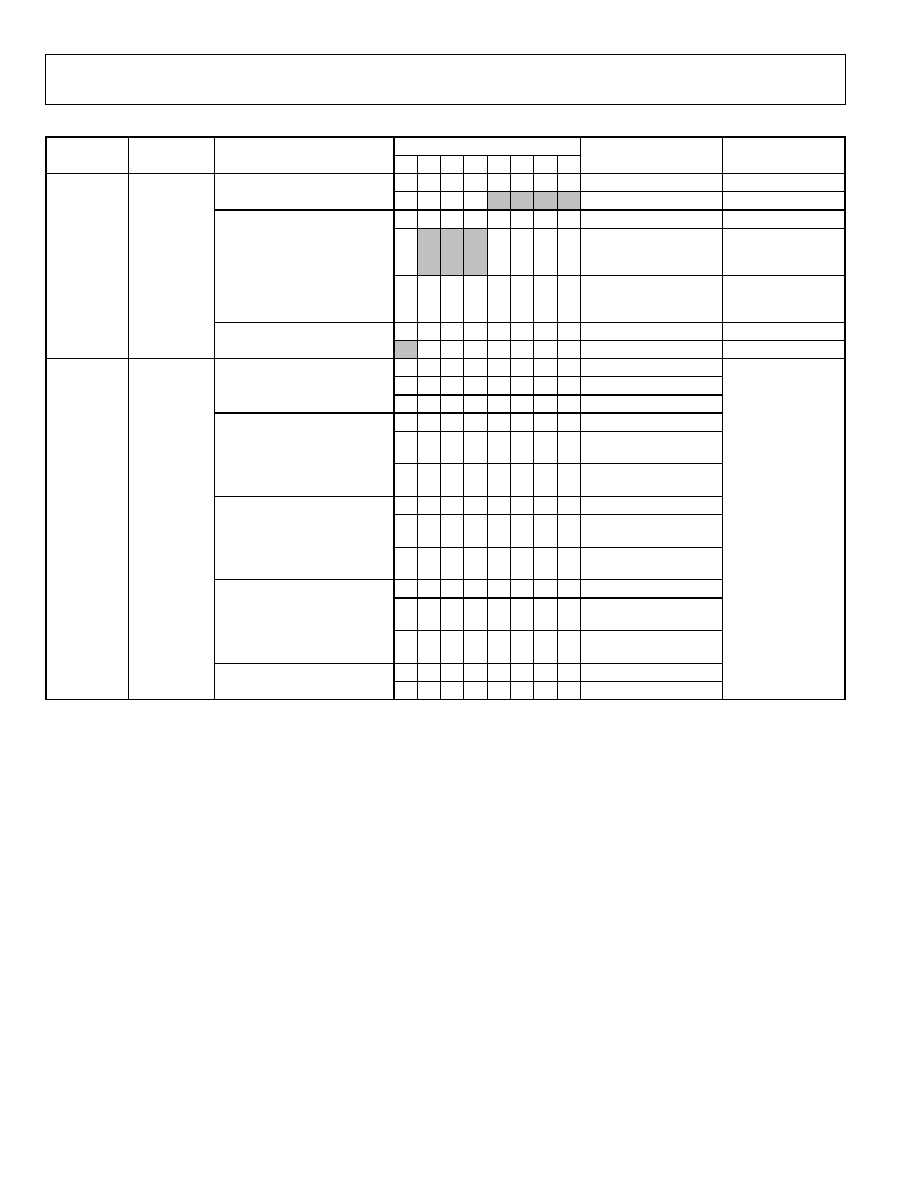
ADV7183A
Rev. A | Page 90 of 104
Table 200. Registers 0x8F to 0x90
Bit
Subaddress Register
Bit
Description
7 6 5 4 3 2 1 0 Comments
Notes
Reserved
0
0
0
0
Set to default
0
0
0
LLC1
(nominal
27
MHz)
selected out on LLC1
pin
LLC_PAD_SEL [2:0]. Enables
manual selection of clock for
LLC1 pin.
1
0
1
LLC2
(nominally
13.5 MHz) selected out
on LLC1 pin
For 16-bit 4:2:2 out,
OF_SEL[3:0] = 0010
0x8F Free
Run
Line
Length 1
Reserved
0
Set
to
default
0
No WSS detected
WSSD. Screen signaling
detected.
1
WSS detected
0
No CCAP signals
detected
CCAPD. Closed caption data.
1
CCAP sequence
detected
0
No EDTV sequence
detected
EDTVD. EDTV sequence.
1
EDTV sequence
detected
0
No CGMS transition
detected
CGMSD. CGMS sequence.
1
CGMS sequence
decoded
0x90 VBI
Info
Read Mode
Details
Reserved
x x x x
Ready-only status
bits
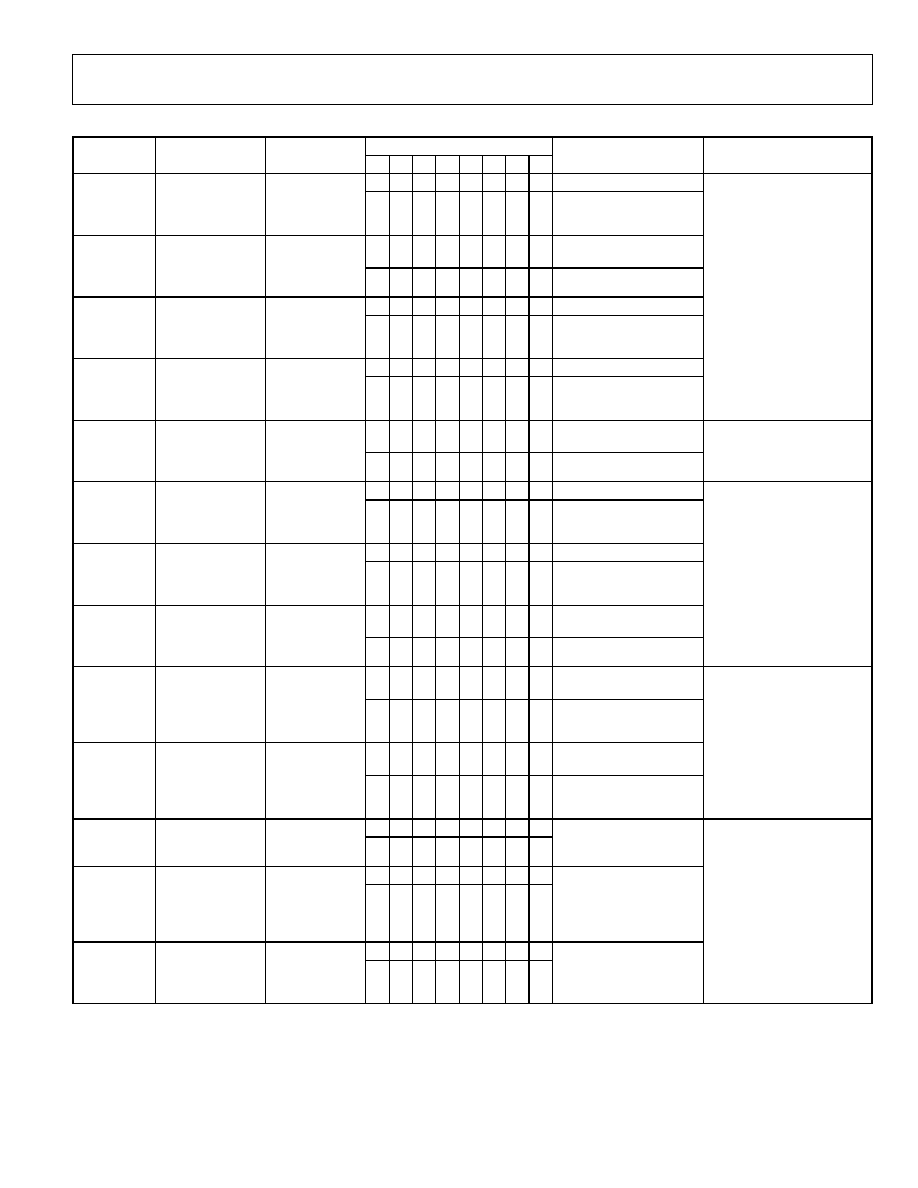
ADV7183A
Rev. A | Page 91 of 104
Table 201. Registers 0x91 to 0x9D
Bit
Subaddress Register
Bit
Description 7 6 5 4 3 2 1 0 Comments
Notes
0x91
WSS1[7:0]. Wide
screen signaling
data. Read-only
register.
WSS1[7:0]
x x x x x x x x
WSS2[7:6] are
undetermined
0x92
WSS1[7:0]. Wide
screen signaling
data. Read-only
register
WSS2[7:0]
x x x x x x x x
0x93
EDTV1[7:0].
EDTV data
register. Read-
only register.
EDTV1[7:0]
x x x x x x x x
0x94
EDTV2[7:0].
EDTV data
register. Read-
only register.
EDTV2[7:0]
x x x x x x x x
EDTV3[7:6] are
undetermined
0x95
EDTV3[7:0]
EDTV data
register. Read-
only register.
EDTV3[7:0]
x x x x x x x x
EDTV3[5] is reserved for
future use
0x96
CGMS1[7:0].
CGMS data
register. Read-
only register.
CGMS1[7:0]
x x x x x x x x
0x97
CGMS2[7:0].
CGMS data
register. Read-
only register.
CGMS2[7:0]
x x x x x x x x
CGMS3[7:4] are
undetermined
0x98
CGMS3[7:0].
CGMS data
register. Read-
only register.
CGMS3[7:0]
x x x x x x x x
CCAP1[7]contains parity
bit for byte 0
0x99
CCAP1[7:0].
Closed caption
data register.
Read-only
register.
CCAP1[7:0]
x x x x x x x x
CCAP2[7]contains parity
bit for byte 0
0x9A
CCAP2[7:0].
Closed caption
data register.
Read-only
register.
CCAP2[7:0]
x x x x x x x x
0x9B
Letterbox 1.
Read-only
register.
LB_LCT[7:0]
x x x x x x x x
Reports the number of
black lines detected at
the top of active video.
0x9C
Letterbox 2.
Read-only
register.
LB_LCM[7:0]
x x x x x x x x
Reports the number of
black lines detected in
the bottom half of active
video if subtitles are
detected.
0x9D
Letterbox 3.
Read-only
register.
LB_LCB[7:0]
x x x x x x x x
Reports the number of
black lines detected at
the bottom of active
video.
This feature examines the
active video at the start and
at the end of each field. It
enables format detection
even if the video is not
accompanied by a CGMS or
WSS sequence.
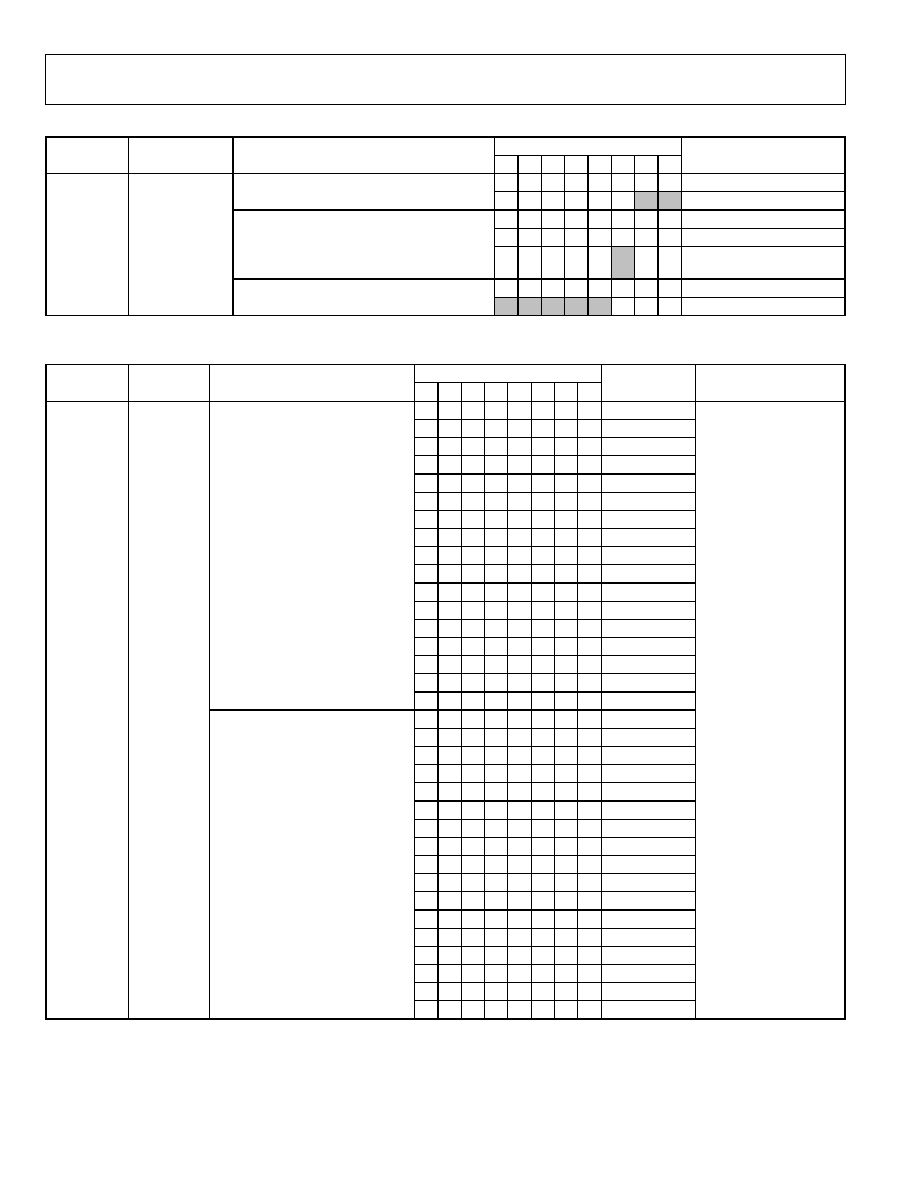
ADV7183A
Rev. A | Page 92 of 104
Table 202. Register 0xB2
Bit
Subaddress Register
Bit
Description
7 6 5 4 3 2 1 0 Comments
Reserved
0
0
Set as default
0
Turn off CRC check
CRC_ENABLE. Enable CRC checksum
decoded from CGMS packet to validate
CGMSD.
1
CGMSD
goes
high
with
valid checksum
0xB2 CRC
Enable
Write Register
Reserved
0
0
0
1
1
Set
as
default
Table 203. Register 0xC3
Bit
Subaddress Register
Bit
Description
7 6 5 4 3 2 1 0 Comments
Notes
SETADC_sw_man_en = 1
0
0
0
0
No
connection
0
0
0
1
AIN1
0
0
1
0
AIN2
0
0
1
1
AIN3
0
1
0
0
AIN4
0
1
0
1
AIN5
0
1
1
0
AIN6
0
1
1
1
No
connection
1
0
0
0
No
connection
1
0
0
1
AIN7
1
0
1
0
AIN8
1
0
1
1
AIN9
1
1
0
0
AIN10
1
1
0
1
AIN11
1
1
1
0
AIN12
ADC0_SW[3:0]. Manual muxing
control for ADC0.
1
1
1
1
No
connection
0 0 0 0 No
connection
0 0 0 1 No
connection
0 0 1 0 No
connection
0 0 1 1 AIN3
0 1 0 0 AIN4
0 1 0 1 AIN5
0 1 1 0 AIN6
0 1 1 1 No
connection
1 0 0 0 No
connection
1 0 0 1 No
connection
1 0 1 0 No
connection
1 0 1 1 AIN9
1 1 0 0 AIN10
1 1 0 1 AIN11
1 1 1 0 AIN12
0xC3 ADC
SWITCH 1
ADC1_SW[3:0]. Manual muxing
control for ADC1.
1 1 1 1 No
connection
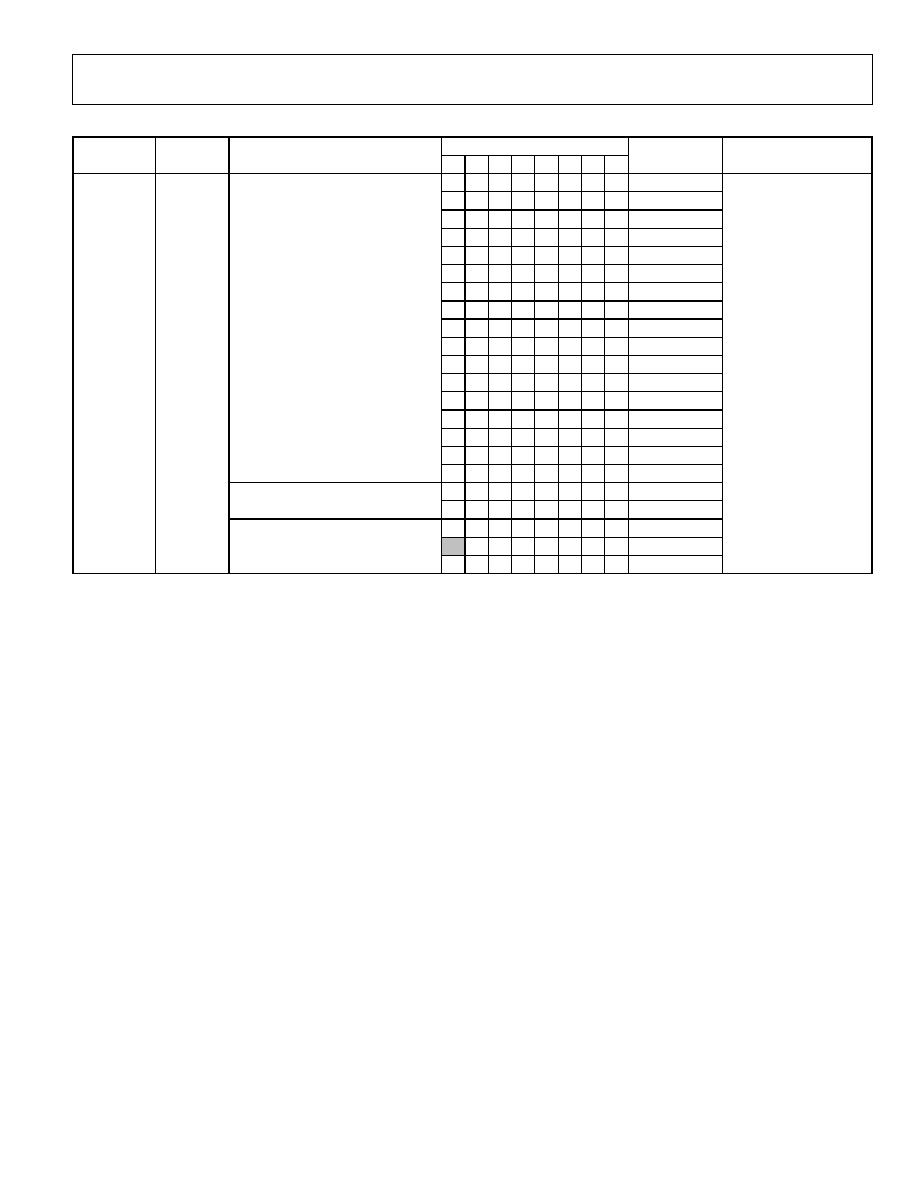
ADV7183A
Rev. A | Page 93 of 104
Table 204. Register 0xC4
Bit
Subaddress Register Bit
Description
7 6 5 4 3 2 1 0 Comments
Notes
0
0
0
0
No
connection
0
0
0
1
No
connection
0
0
1
0
AIN2
0
0
1
1
No
connection
0
1
0
0
No
connection
0
1
0
1
AIN5
0
1
1
0
AIN6
0
1
1
1
No
connection
1
0
0
0
No
connection
1
0
0
1
No
connection
1
0
1
0
AIN8
1
0
1
1
No
connection
1
1
0
0
No
connection
1
1
0
1
AIN11
1
1
1
0
AIN12
ADC2_SW[3:0]. Manual muxing
control for ADC2.
1
1
1
1
No
connection
Reserved
x
x
x
0
Disable
0xC4 ADC
SWITCH 2
ADC_SW_MAN_EN. Enable manual
setting of the input signal muxing.
1
Enable
SETADC_sw_man_en = 1
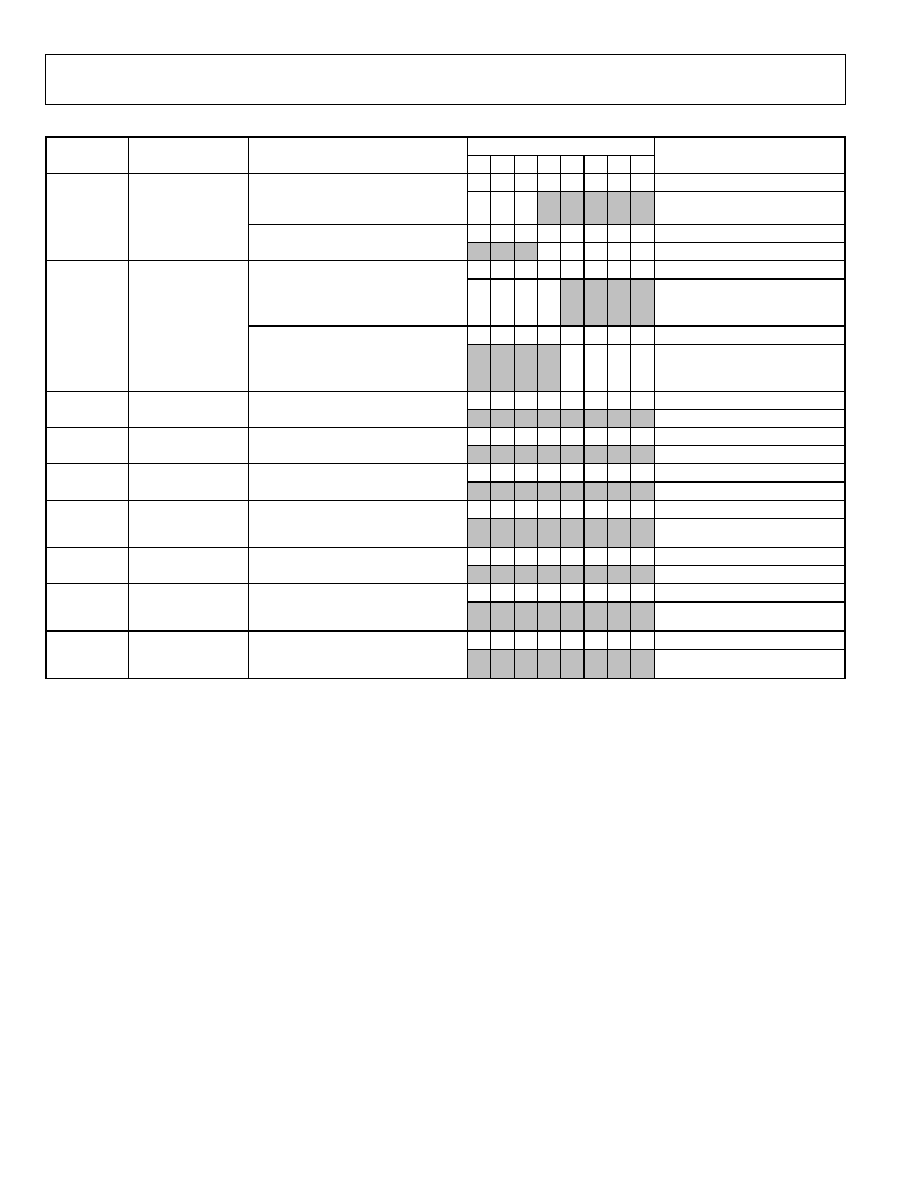
ADV7183A
Rev. A | Page 94 of 104
Table 205. Registers 0xDC to 0xE4
Bit
Subaddress Register
Bit
Description
7 6 5 4 3 2 1 0 Comments
LB_TH [4:0]. Sets the threshold value
that detects a black.
0
1
1
0
0
Default threshold for the
detection of black lines.
0xDC
Letterbox Control 1
Reserved
1
0
1
Set
as
default
LB_EL[3:0]. Programs the end line of
the activity window for LB detection
(end of field).
1
1
0
0
LB detection ends with the last
line of active video on a field.
1100: 262/525.
0xDD
Letterbox Control 2
LB_SL[3:0]. Program the start line of
the activity window for LB detection
(start of field).
0
1
0
0
Letterbox
detection
aligned
with
the start of active video,
0100: 23/286 NTSC.
0xDE
Reserved
0
0
0
0
0
0
0
0
0xDF
Reserved
0
0
0
0
0
0
0
0
0xE0
Reserved
0
0
0
1
0
1
0
0
0xE1
SD Offset Cb
SD_OFF_CB [7:0]. Adjusts the hue by
selecting the offset for the Cb
channel.
1
0
0
0
0
0
0
0
0xE2
SD Offset Cr
SD_OFF_CR [7:0]. Adjusts the hue by
selecting the offset for the Cr channel.
1
0
0
0
0
0
0
0
0xE3
SD Saturation Cb
SD_SAT_CB [7:0]. Adjusts the
saturation of the picture by affecting
gain on the Cb channel.
1
0
0
0
0
0
0
0
Chroma gain = 0 dB
0xE4
SD Saturation Cr
SD_SAT_CR [7:0]. Adjusts the
saturation of the picture by affecting
gain on the Cr channel.
1
0
0
0
0
0
0
0
Chroma gain = 0 dB
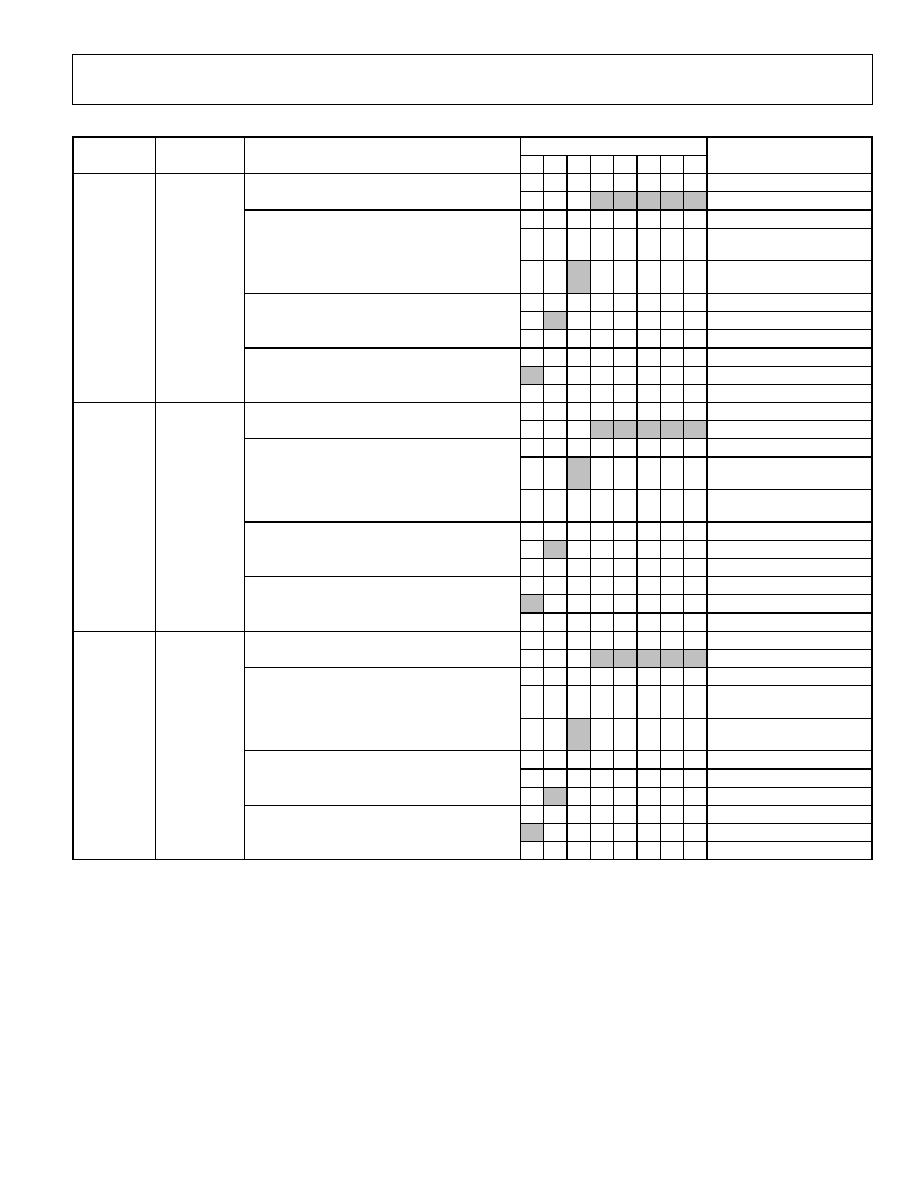
ADV7183A
Rev. A | Page 95 of 104
Table 206. Registers 0xE5 to 0xE7
Bit
Subaddress Register
Bit
Description
7 6 5 4 3 2 1 0 Comments
NVBEG[4:0]. How many lines after l
COUNT
rollover
to set V high.
0
0
1
0
1 NTSC
Default(BT.656)
0
Set
to
low
when
manual
programming
NVBEGSIGN
1
Not
suitable
for
user
programming
0
No delay
NVBEGDELE. Delay V bit going high by one line
relative to NVBEG (even field).
1
Additional delay by 1 line
0
No delay
0xE5
NTSC V Bit
Begin
NVBEGDELO. Delay V bit going high by one line
relative to NVBEG (odd field).
1
Additional delay by 1 line
NVEND[4:0]. How many lines after l
COUNT
rollover
to set V low.
0
0
1
0
0
NTSC Default (BT.656)
0
Set
to
low
when
manual
programming
NVENDSIGN
1
Not suitable for user
programming
0
No delay
NVENDDELE. Delay V bit going low by one line
relative to NVEND (even field).
1
Additional delay by 1 line
0
No delay
0xE6
NTSC V Bit
End
NVENDDELO. Delay V bit going low by one line
relative to NVEND (odd field).
1
Additional delay by 1 line
NFTOG[4:0]. How many lines after l
COUNT
rollover
to toggle F signal.
0
0
0
1
1 NTSC
Default
0
Set
to
low
when
manual
programming
NFTOGSIGN
1
Not
suitable
for
user
programming
0
No delay
NFTOGDELE. Delay F transition by one line
relative to NFTOG (even field).
1
Additional delay by 1 line
0
No delay
0xE7
NTSC F Bit
Toggle
NFTOGDELO. Delay F transition by one line
relative to NFTOG (odd field).
1
Additional delay by 1 line
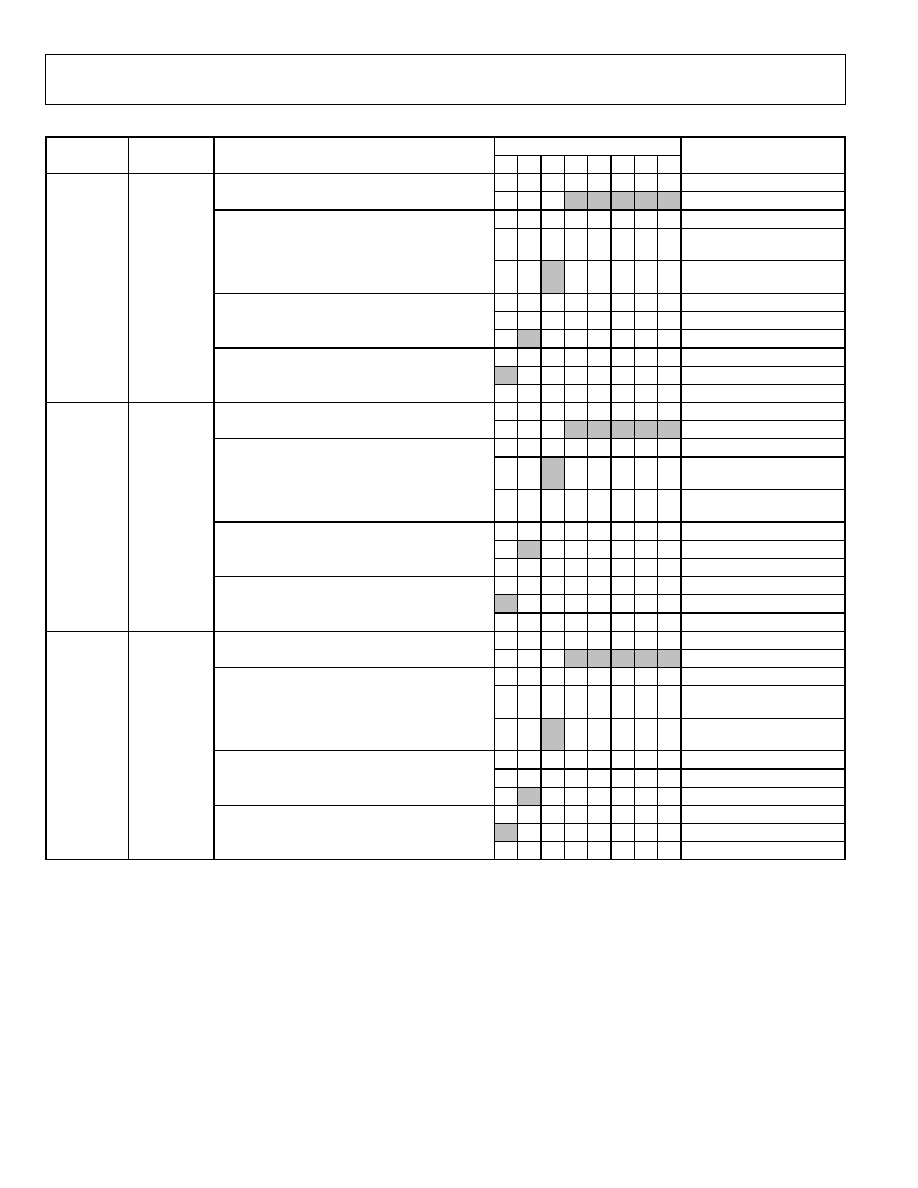
ADV7183A
Rev. A | Page 96 of 104
Table 207. Registers 0xE8 to 0xEA
Bit
Subaddress Register
Bit
Description
7 6 5 4 3 2 1 0 Comments
PVBEG[4:0]. How many lines after l
COUNT
rollover
to set V high.
0
0
1
0
1 PAL
Default
(BT.656)
0
Set
to
low
when
manual
programming
PVBEGSIGN
1
Not
suitable
for
user
programming
0
No delay
PVBEGDELE. Delay V bit going high by one line
relative to PVBEG (even field).
1
Additional delay by 1 line
0
No delay
0xE8
PAL V Bit
Begin
PVBEGDELO. Delay V bit going high by one line
relative to PVBEG (odd field).
1
Additional delay by 1 line
PVEND[4:0]. How many lines after l
COUNT
rollover
to set V low.
1
0
1
0
0 PAL
Default
(BT.656)
0
Set
to
low
when
manual
programming
PVENDSIGN
1
Not suitable for user
programming
0
No delay
PVENDDELE. Delay V bit going low by one line
relative to PVEND (even field).
1
Additional delay by 1 line
0
No delay
0xE9
PAL V Bit
End
PVENDDELO. Delay V bit going low by one line
relative to PVEND (odd field).
1
Additional delay by 1 line
PFTOG[4:0]. How many lines after l
COUNT
rollover
to toggle F signal.
0
0
0
1
1 PAL
Default
(BT.656)
0
Set
to
low
when
manual
programming
PFTOGSIGN.
1
Not
suitable
for
user
programming
0
No delay
PFTOGDELE. Delay F transition by one line
relative to PFTOG (even field).
1
Additional delay by 1 line
0
No delay
0xEA
PAL F Bit
Toggle
PFTOGDELO. Delay F transition by one line
relative to PFTOG (odd field).
1
Additional delay by 1 line

ADV7183A
Rev. A | Page 97 of 104
APPENDIX A
I
2
C PROGRAMMING EXAMPLES
Mode 1 CVBS Input (Composite Video on AIN5)
All standards are supported through autodetect, 8-bit, 4:2:2, ITU-R BT.656 output on P15P8.
Table 208. Mode 1 CVBS Input
Register Address
Register Value
Notes
0x00
0x04
CVBS input on AIN5.
0x01
0x88
Turn off HSYNC processor (SECAM only
13
).
0x17
0x41
Set CSFM to SH1.
0x2B 0xE2
AGC
tweak
0x3A
0x16
Power down ADC 1 and ADC 2.
0x51
0x24
Turn off FSC detect for IN LOCK status.
0xD2 0x01
AGC
tweak.
0xD3 0x01
AGC
tweak.
0xDB 0x9B
AGC
tweak.
0x0E 0x85
ADI recommended programming sequence. This sequence must be followed exactly when
setting up the decoder.
0x89 0x0D
Recommended
setting.
0x8D 0x9B
Recommended
setting.
0x8F 0x48
Recommended
setting.
0xB5 0x8B
Recommended
setting.
0xD4 0xFB
Recommended
setting.
0xD6 0x6D
Recommended
setting.
0xE2 0xAF
Recommended
setting.
0xE3 0x00
Recommended
setting.
0xE4 0xB5
Recommended
setting.
0xE8 0xF3
Recommended
setting.
0x0E 0x05
Recommended
setting.
13
For all SECAM modes of operation, HSYNC PROCESSOR must be turned off.

ADV7183A
Rev. A | Page 98 of 104
Mode 2 S-Video Input (Y on AIN1 and C on AIN4)
All standards are supported through autodetect, 8-bit, ITU-R BT.656 output on P15P8.
Table 209. Mode 2 S-Video Input
Register Address
Register Value
Notes
0x00
0x06
Y1 = AIN1, C1 = AIN4.
0x01
0x88
Turn off HSYNC processor (SECAM only).
0x2B 0xE2
AGC
tweak.
0x3A
0x12
Power down ADC 2.
0x51
0x24
Turn off FSC detect for IN LOCK status.
0xD2 0x01
AGC
tweak.
0xD3 0x01
AGC
tweak.
0xDB 0x9B
AGC
tweak.
0x0E 0x85
ADI recommended programming sequence. This sequence must be followed exactly when
setting up the decoder.
0xB5 0x8B
Recommended
setting.
0xD4 0xFB
Recommended
setting.
0xD6 0x6D
Recommended
setting.
0xE2 0xAF
Recommended
setting.
0xE3 0x00
Recommended
setting.
0xE4 0xB5
Recommended
setting.
0xE8 0xF3
Recommended
setting.
0x0E 0x05
Recommended
setting.
Mode 3 525i/625i YPrPb Input (Y on AIN2, Pr on AIN3, and Pb on AIN6)
All standards are supported through autodetect, 8-bit, ITU-R BT.656 output on P15P8.
Table 210. Mode 3 YPrPb Input 525i/625i
Register Address
Register Value
Notes
0x00
0x0A
Y2 = AIN2, Pr2 = AIN3, Pb2 = AIN6.
0x01
0x88
Disable HSync PLL.
0x2B 0xE2
AGC
tweak.
0x3A
0x10
Set latch clock.
0x51
0x24
Turn off FSC detect for IN LOCK status.
0xD2 0x01
AGC
tweak.
0xD3 0x01
AGC
tweak.
0xDB 0x9B
AGC
tweak.
0x0E 0x85
ADI recommended programming sequence. This sequence must be followed exactly when setting
up the decoder.
0xD6 0x6D
Recommended
setting.
0xE8 0xF3
Recommended
setting.
0x0E 0x05
Recommended
setting.

ADV7183A
Rev. A | Page 99 of 104
Mode 4 CVBS Tuner Input PAL Only on AIN4
8-bit, ITU-R BT.656 output on P15P8.
Table 211. Mode 4 Tuner Input CVBS PAL Only
Register Address
Register Value
Notes
0x00
0x83
CVBS AIN4 Force PAL only mode.
0x07
0x01
Enable PAL autodetection only.
0x17
0x41
Set CSFM to SH1.
0x19
0xFA
Stronger dot crawl reduction.
0x2B 0xE2
AGC
tweak.
0x3A
0x16
Power down ADC 1 and ADC 2.
0x50
0x0A
Set higher DNR threshold.
0x51
0x24
Turn off FSC detect for IN LOCK status.
0xD2 0x01
AGC
tweak.
0xD3 0x01
AGC
tweak.
0xDB 0x9B
AGC
tweak.
0x0E 0x85
ADI recommended programming sequence. This sequence must be followed exactly when
setting up the decoder.
0x89 0x0D
Recommended
setting.
0x8D 0x9B
Recommended
setting.
0x8F 0x48
Recommended
setting.
0xB5 0x8B
Recommended
setting.
0xD4 0xFB
Recommended
setting.
0xD6 0x6D
Recommended
setting.
0xE2 0xAF
Recommended
setting.
0xE3 0x00
Recommended
setting.
0xE4 0xB5
Recommended
setting.
0xE8 0xF3
Recommended
setting.
0x0E 0x05
Recommended
setting.

ADV7183A
Rev. A | Page 100 of 104
APPENDIX B
PCB LAYOUT RECOMMENDATIONS
The ADV7183A is a high precision, high speed mixed-signal
device. To achieve the maximum performance from the part, it
is important to have a well laid-out PCB board. The following is
a guide for designing a board using the ADV7183A.
Analog Interface Inputs
The inputs should receive care when being routed on the PCB.
Track lengths should be kept to a minimum, and 75 trace
impedances should be used when possible. Trace impedances
other than 75 also increase the chance of reflections.
Power Supply Decoupling
It is recommended to decouple each power supply pin with
0.1 µF and 10 nF capacitors. The fundamental idea is to have a
decoupling capacitor within about 0.5 cm of each power pin.
Also, avoid placing the capacitor on the opposite side of the PC
board from the ADV7183A, as doing so interposes resistive vias
in the path. The decoupling capacitors should be located
between the power plane and the power pin. Current should
flow from the power plane to the capacitor to the power pin. Do
not make the power connection between the capacitor and the
power pin. Placing a via underneath the 100 nF capacitor pads,
down to the power plane, is generally the best approach (see
Figure 38).
04819-0-038
VDD
GND
10nF
100nF
VIA TO SUPPLY
VIA TO GND
Figure 38. Recommend Power Supply Decoupling
It is particularly important to maintain low noise and good
stability of PVDD. Careful attention must be paid to regulation,
filtering, and decoupling. It is highly desirable to provide
separate regulated supplies for each of the analog circuitry
groups (AVDD, DVDD, DVDDIO, and PVDD).
Some graphic controllers use substantially different levels of
power when active (during active picture time) and when idle
(during horizontal and vertical sync periods). This can result in
a measurable change in the voltage supplied to the analog
supply regulator, which can, in turn, produce changes in the
regulated analog supply voltage. This can be mitigated by
regulating the analog supply, or at least PVDD, from a different,
cleaner, power source (for example, from a 12 V supply).
It is also recommend to use a single ground plane for the entire
board. This ground plane should have a spacing gap between
the analog and digital sections of the PCB (see Figure 39).
04819-0-039
ANALOG
SECTION
DIGITAL
SECTION
ADV7183A
Figure 39. PCB Ground Layout
Experience has repeatedly shown that the noise performance is
the same or better with a single ground plane. Using multiple
ground planes can be detrimental because each separate ground
plane is smaller, and long ground loops can result.
In some cases, using separate ground planes is unavoidable. For
those cases, it is recommended to at least place a single ground
plane under the ADV7183A. The location of the split should be
under the ADV7183A. For this case, it is even more important
to place components wisely because the current loops will be
much longer (current takes the path of least resistance). An
example of a current loop: power plane to ADV7183A to digital
output trace to digital data receiver to digital ground plane to
analog ground plane.
PLL
Place the PLL loop filter components as close to the ELPF pin as
possible. Do not place any digital or other high frequency traces
near these components. Use the values suggested in the data
sheet with tolerances of 10% or less.
Digital Outputs (Both Data and Clocks)
Try to minimize the trace length that the digital outputs have to
drive. Longer traces have higher capacitance, which requires
more current, which causes more internal digital noise. Shorter
traces reduce the possibility of reflections.
Adding a series resistor of a value between 30 and 50 can
suppress reflections, reduce EMI, and reduce the current spikes
inside the ADV7183A. If series resistors are used, place them as
close to the ADV7183A pins as possible. However, try not to
add vias or extra length to the output trace to get the resistors
closer.
If possible, limit the capacitance that each of the digital outputs
drives to less than 15 pF. This can easily be accomplished by
keeping traces short and by connecting the outputs to only one
device. Loading the outputs with excessive capacitance increases
the current transients inside the ADV7183A, creating more
digital noise on its power supplies.

ADV7183A
Rev. A | Page 101 of 104
Digital Inputs
The digital inputs on the ADV7183A were designed to work
with 3.3 V signals, and are not tolerant of 5 V signals. Extra
components are needed if 5 V logic signals are required to be
applied to the decoder.
Antialiasing Filters
For inputs from some video sources that are not bandwidth
limited, signals outside the video band can alias back into the
video band during A/D conversion and appear as noise on the
output video. The ADV7183A oversamples the analog inputs by
a factor of 4. This 54 MHz sampling frequency reduces the
requirement for an input filter; for optimal performance it is
recommended that an antialiasing filter be employed. The
recommended low cost circuit for implementing this buffer and
filter circuit for all analog input signals is shown in Figure 41.
The buffer is a simple emitter-follower using a single npn
transistor. The antialiasing filter is implemented using passive
components. The passive filter is a third-order Butterworth
filter with a -3dB point of 9MHz. The frequency response of the
passive filter is shown in Figure 40. The flat pass band up to
6 MHz is essential. The attenuation of the signal at the output of
the filter due to the voltage divider of R24 and R63 is compen-
sated for in the ADV7183A part using the automatic gain
control. The ac coupling capacitor at the input to the buffer
creates a high-pass filter with the biasing resistors for the
transistor. This filter has a cut-off of
{2 × × (R39||R89) × C93}
1
= 0.62 Hz
It is essential that the cutoff of this filter be less than 1 Hz to
ensure correct operation of the internal clamps within the part.
These clamps ensure that the video stays within the 5 V range of
the op amp used.
0
20
40
60
80
100
120
100kHz
30MHz
10MHz
3MHz
1MHz
300kHz
300MHz
1GHz
100MHz
04819-0-040
FREQUENCY
Figure 40. Third-Order Butterworth Filter Response
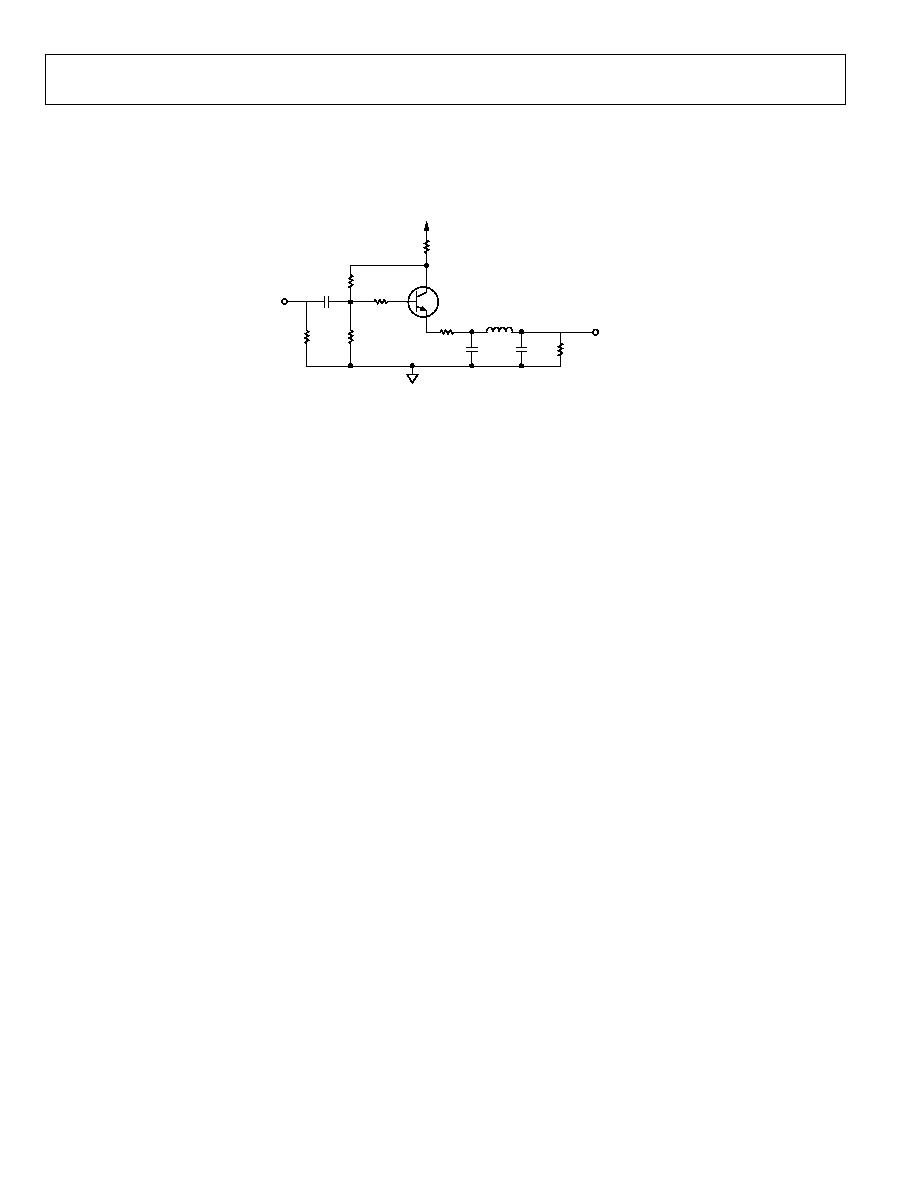
ADV7183A
Rev. A | Page 102 of 104
APPENDIX C
TYPICAL CIRCUIT CONNECTION
Examples of how to connect the ADV7183A video decoder are shown in Figure 41 and Figure 42.
04819-0-041
B
Q6
C
E
R38
75
R89
5.6k
R63
820
R43
0
R53
56
R24
470
R39
4.7k
C95
22pF
C102
10pF
C93
100
µ
F
AVDD_5V
L10
12
µ
H
FILTER
BUFFER
AGND
OUT
IN
Figure 41. ADI Recommended Antialiasing Circuit for All Input Channels

ADV7183A
Rev. A | Page 103 of 104
2k
2k
AGND
DGND
AGND
DGND
0.1
µ
F
DGND
0.01
µ
F
DGND
33
µ
F
DGND
10
µ
F
DGND
FERITE BEAD
DVDDIO
(3.3V)
POWER SUPPLY
DECOUPLING FOR
EACH POWER PIN
0.1
µ
F
AGND
0.01
µ
F
AGND
33
µ
F
AGND
10
µ
F
AGND
FERITE BEAD
PVDD
(1.8V)
POWER SUPPLY
DECOUPLING FOR
EACH POWER PIN
0.1
µ
F
AGND
0.01
µ
F
AGND
33
µ
F
AGND
10
µ
F
AGND
FERITE BEAD
AVDD
(3.3V)
POWER SUPPLY
DECOUPLING FOR
EACH POWER PIN
0.1
µ
F
DGND
0.01
µ
F
DGND
33
µ
F
DGND
10
µ
F
DGND
FERITE BEAD
DVDD
(1.8V)
POWER SUPPLY
DECOUPLING FOR
EACH POWER PIN
AGND DGND
DV
DD
AV
DD
PVD
D
DV
DDIO
AIN1
100nF
AIN7
AIN2
100nF
AIN8
AIN3
100nF
AIN9
AIN4
100nF
AIN10
AIN5
100nF
AIN11
AIN6
100nF
AIN12
AGND
AGND
75
75
75
75
75
75
S-VIDEO
Y
Pr
Pb
CBVS
+
CAP Y1
CAP Y2
AGND
1nF
0.1
µ
F
10
µ
F
0.1
µ
F
+
CAP C1
CAP C2
CML
AGND
1nF
0.1
µ
F
10
µ
F
0.1
µ
F
LLC1
27MHz OUTPUT CLOCK
LLC2
13.5MHz OUTPUT CLOCK
SFL
SFL O/P
HS
HS O/P
VS
VS O/P
FIELD
FIELD O/P
ELPF
1.7k
10nF
82nF
PVDD
DGND
DVDDIO
100nF
OE
OUTPUT ENABLE I/P
P15P8 8-BIT ITU-R BT.656 PIXEL DATA @ 27MHz
P7P0 Cb AND Cr 16-BIT ITU-R BT.656 PIXEL DATA @ 13.5MHz
P15P8 Y 16-BIT ITU-R BT.656 PIXEL DATA @ 13.5MHz
P0
P1
P2
P3
P4
P5
P6
P7
P8
P9
P10
P11
P12
P13
P14
P15
MULTI
FORMAT
PIXEL
PORT
+
10
µ
F
0.1
µ
F
REFOUT
AGND
0.1
µ
F
10
µ
F
+
XTAL
33pF
DGND
XTAL1
ALSB
33pF
DGND
27MHz
ADV7183A
DVDDIO
SELECT I
2
C
ADDRESS
DVSS
MPU INTERFACE
CONTROL LINES
SCLK
SDA
100
100
DVDDIO DVDDIO
4.7k
RESET
RESET
04821-0-042
Figure 42. Typical Connection Diagram

ADV7183A
Rev. A | Page 104 of 104
OUTLINE DIMENSIONS
1.45
1.40
1.35
0.15
0.05
61
60
1
80
20
41
21
40
TOP VIEW
(PINS DOWN)
PIN 1
SEATING
PLANE
VIEW A
1.60
MAX
0.75
0.60
0.45
0.20
0.09
0.10 MAX
COPLANARITY
VIEW A
ROTATED 90° CCW
SEATING
PLANE
10°
6°
2°
7°
3.5°
0°
14.00
BSC SQ
16.00
BSC SQ
0.65
BSC
0.38
0.32
0.22
COMPLIANT TO JEDEC STANDARDS MS-026-BEC
Figure 43. 80-Lead Low Profile Quad Flat Package [LQFP]
(ST-80-2)
Dimensions shown in millimeters
ORDERING GUIDE
Model
Temperature Range
Package Description
Package Option
ADV7183AKST
25°C to +70°C
Low Profile Quad Flat Package (LQFP)
ST-80-2
ADV7183ABST
40°C to +85°C
Low Profile Quad Flat Package (LQFP)
ST-80-2
EVAL-ADV7183AEBM
Evaluation
Board
Note: The ADV7183A is a Pb-free environmentally friendly product. It is manufactured using the most up-to-date materials and
processes. The coating on the leads of each device is 100% pure Sn electroplate. The device is suitable for Pb-free applications, and can
withstand surface-mount soldering at up to 255°C (±5°C).
In addition, it is backward-compatible with conventional SnPb soldering processes. This means the electroplated Sn coating can be
soldered with Sn/Pb solder pastes at conventional reflow temperatures of 220°C to 235°C.
Purchase of licensed I
2
C components of Analog Devices or one of its sublicensed Associated Companies conveys a license for the purchaser under the Philips I
2
C Patent
Rights to use these components in an I
2
C system, provided that the system conforms to the I
2
C Standard Specification as defined by Philips.
© 2004 Analog Devices, Inc. All rights reserved. Trademarks and
registered trademarks are the property of their respective owners.
D0482106/04(A)
Document Outline







































































































